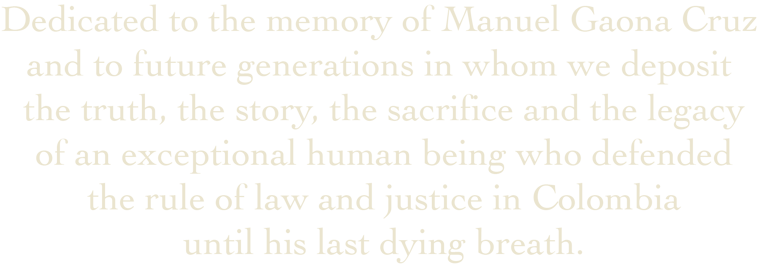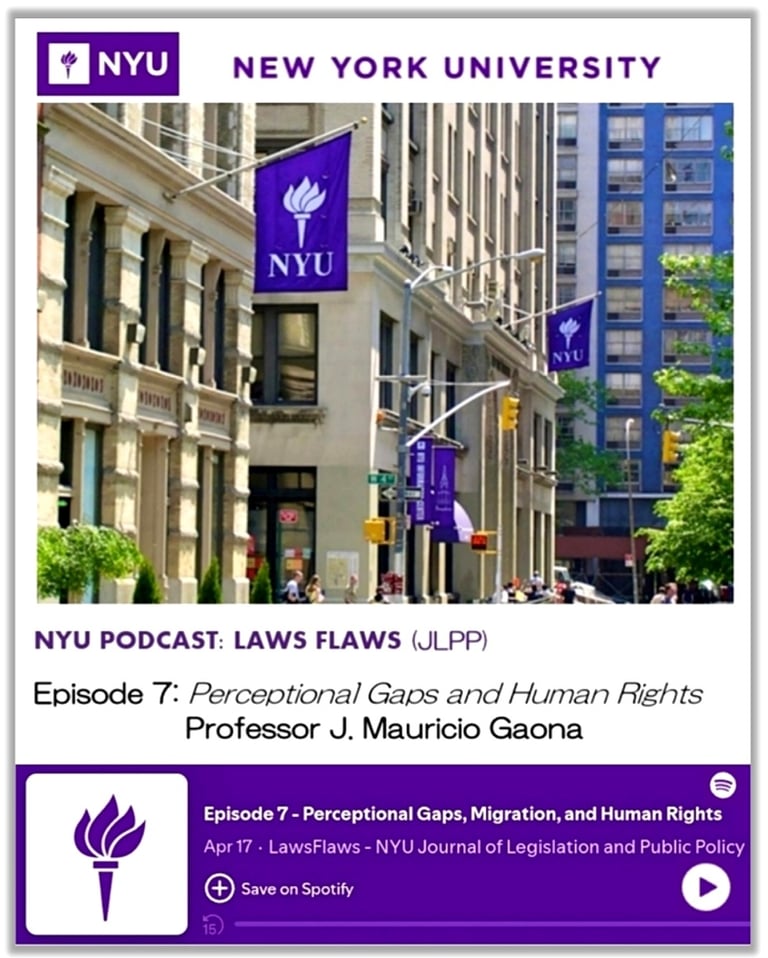

BIOGRAPHY
Upon his return to Colombia, the young jurist dedicated himself to teaching and public service. In the words of Colombian Professor Fernando Hinestrosa Forero, Manuel Gaona Cruz's career "was dazzling, swift, as if a premonition were driving him..." (Estudios Constitucionales Manuel Gaona Cruz, MINISTERIO DE JUSTICIA DE COLOMBIA 1988, Tomo II, page 608). Manuel Gaona Cruz served as Assistant Procurator, Advisory Attorney to the Chief of the Public Ministry, Secretary General of the Public Ministry, Constitutional Law Professor at Rosario, Externado and Boyacá Universities and at the General Santander Military School, Director of the Department of Public Law at Externado University, President of Bogota's District University, President of the National Commission for drafting the Police Code, Under Secretary of Justice of Colombia, Supreme Court Justice and Chief Justice of the Constitutional Chamber of the Supreme Court of Colombia. Both his landmark opinions on extradition and international law delivered as Chief Justice and his work on international judicial cooperation as Under Secretary of Justice both in Colombia and in Washington D.C. have been deemed influential in the development of the travaux préparatoires that led to the United Nations Convention Against Illicit Traffic in Narcotic Drugs and Psychotropic Substances of 1988.
Justice Gaona was taken hostage by the M-19 guerrillas upon hearing the guerilleros calling his name and looking form him everywhere and, more particularly, after the Justices of the Constitucionalista Chamber were forced to interrupt their session and hide in nearby offices, right after Justice Gaona was, in fact, delivering the opinion of the Court on the constitutionality of the Extradition Treaty between Colombia and the United States (see MGC Death - The Kidnapping of Justice Manuel Gaona Cruz). Manuel Gaona Cruz was the first hostage that the guerrilleros sought upon entering the Court. He was assassinated by the M-19 guerrillas during the seizure of the Palace of Justice in Colombia on Thursday, November 7, 1985, after refusing to enter the crossfire and serving as a human shield for the guerrillas who were aiming at his head and back (see MGC Death - Forensic Reconstruction of the Crime Scene). More than half a dozen witnesses who were with the Justice (holding hands, behind, beside, beneath) witnessed his execution at the hands of the guerrillas and described, under oath and before the Colombian authorities who investigated his crime, the details of his kidnapping, murder, last words, and fatal wounds (see MGC Death - Testimonial Evidence; see also the Supreme Court's Truth Commission Final Report, Id., Informe Final: Comisión de la Verdad, pages 164-166).
In 1989, the Congress of the Republic of Colombia approved a pardon law in favor of the M-19 guerrilla group (Law 77 of 1989). Despite the efforts of the government at the time to guarantee the impunity of the M-19 for the crimes committed in the Palace of Justice in order to facilitating the demobilization of the terrorist group, in January 31st of that year, the 30th Criminal Investigation Judge of Bogota, Uriel Alberto Amaya Olaya, filed charges against the military leadership of the M-19 for the crimes of rebellion, homicide, kidnapping and falsification of public documents as well as for human rights violations and the atrocious crimes committed by the guerrillas that, according to the Judge, were not covered by the political crime of rebellion (see Declaration of Judge Amaya in “El Juez Que Ordenó Enjuiciar al M-19” [The Judge Who Ordered the Prosecution of the M-19], NOTICIAS CARACOL, November 2019). The Judge also requested the Supreme Court of Justice to open an investigation against former President Belisario Betancur Cuartas, given the power vacuum that existed during the seizure and recapture of the Palace of Justice, and against Defense Minister Miguel Vega Uribe for human rights violations committed by the military forces that participated in the recapture.
In 1990, in a letter signed and fingerprinted by Pablo Escobar, and addressed to the Commander of the National Directorate of Judicial and Investigative Police of Colombia (DIJIN), Colonel Oscar Peláez Carmona, Escobar acknowledged his relationship with the M-19 leaders, which he described as very close, stating that: "I have always been a good friend of almost all the M-19 leaders... In times of greatest tension and difficulty, I hid Álvaro Fayad and Iván Marino Ospina in my refuge" (Statement by Pablo Escobar Gaviria in 1990, see Letter from Pablo Escobar to the media and to the Commander of the Judicial and Investigative Police Directorate (DIJIN) in "Yo Protegi al M-19: Escobar" [I Protected the M-19: Escobar], EL TIEMPO, May 1, 1990, pages 1A and 1B; see also “El Jefe del Cartel de Medellin Niega Haber Ordenado Matar a Pizarro" [Medellin Cartel Chief Denies Ordering Pizarro's Killing,"LA OPINIÓN, May 1, 1990, page 8 {full letter in MGC Death – Documentary Evidence}). In an interview with Noticias Caracol, former M-19 commander and (current) Colombian president Gustavo Petro Urrego stated: "Álvaro Fayad was the one who planned the takeover of the Palace of Justice" (see Interview {video} in MGC Death - Documentary Evidence - Pablo Escobar and the M-19).
In 1991, the Democratic Alliance M-19 party, through its leader and former M-19 commander, Antonio Navarro Wolff, introduced a constitutional amendment proposal to prohibit the extradition of Colombian drug traffickers. With 45 votes in favor and 5 against, the M-19 successfully obtained a ban on extradition in Colombia. Pablo Escobar surrendered to Colombian authorities along with 100 other Extraditables on the same day the constitutional reform was passed. His surrender was subject to two conditions: first, that the recently passed constitutional reform be guaranteed, and second, that his trusted men be able to build the prison for him and the Extraditables, which he called "the Cathedral." In an interview with the international press, former constituent and former M-19 commander Navarro Wolff acknowledged the drug trafficking lobbying that helped pass the reform and stated: "We talk to anyone, I won't deny that" (see interview in MGC Death - Documentary Evidence).
In 1992, Public Order Judge Clemencia García de Useche issued an arrest warrant without the benefit of release for the crimes of terrorism, rioting, and arson against the M-19 military leadership, including former M-19 commander and current president of Colombia Gustavo Francisco Petro Urrego and former M-19 commander Antonio Navarro Wolff. In her ruling, the Judge established a criminal conspiracy between drug traffickers and the M-19 guerrillas to attack the Palace of Justice, and formally accused the M-19 of committing acts of terrorism and rioting after burning the extradition files against drug cartels housed in the Palace of Justice's library. Incidentally, the front page of The New York Times, published on November 6, 1985, reads: "Rebels Burn Records." Shortly thereafter, the Colombian Congress approved a reform to the pardon law (Law 7 of 1992) extending the pardon to all crimes committed by this guerrilla group; thus, guaranteeing impunity for the atrocities committed by the terrorist group during the 1985 takeover of the Palace of Justice.
Giraldo Mesa, La Sencillez de la Genialidad [The Simplicity of Genius], AMBITO JURIDICO LEGIS, No. 189, 2005). His works on Latin American presidentialism and constitutional control, his fight against drug trafficking, and his most cited opinions remain in the memory of the thousands of students he educated and in the annals of the courts and institutions that nowadays preserve his legacy. The family, the Foundation, and the Manuel Gaona Cruz International Association are especially grateful for the contributions of the Government of the Republic of France, the Sorbonne University of Paris 1, Harvard University, the University of Los Andes, the University of Rosario, the University of Boyacá, the Francisco Jose de Caldas District University of Bogota, and the Supreme Court of Colombia, as well as for the acknowledgments of former Presidents of the Sorbonne University, François Luchair and Pierre-Yves Hénin. We extend our most sincere gratitude to the Judges and Justices of the Supreme Court of Colombia who, over the years, helped dispel rumors vis-a-vis the events that shed light on the assassination of the professor and Supreme Court Justice, Manuel Gaona Cruz. Our thanks also go to the researchers, journalists, experts, professors and academics, and to all those who helped us in Colombia, the United States, and France. We would like to extend our special thanks to Carmel Media Lab in the United States, as well as to Manuel Gaona Cruz's friends and students from all universities for sharing their messages, stories, and heartfelt recollections (see Investigation - Special Thanks).
In 2001, following public pressure from dozens of family members seeking to know the fate of their loved ones who disappeared during the takeover of the Palace of Justice, the Attorney General's Office opened a formal investigation to determine the criminal responsibility of the military personnel who participated in the retaking of the Palace of Justice.
In 2005, the Colombian Supreme Court instituted a Truth Commission composed of three former Chief Justices to investigate and establish the truth on what happened at the Palace of Justice considering all parties involved, that is: the government of former President Belisario Betancourt Cuartas, the Army, the M-19 guerrillas, and the Medellin drug Cartel.
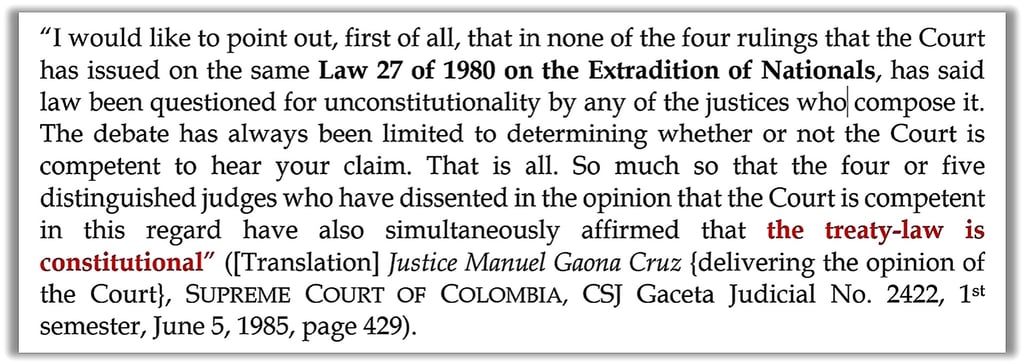

In June 1985 and following landmark decisions of the Constitutional Chamber of the Supreme Court on the Extradition Treaty, Pablo Escobar, the members of the Medellín Cartel, M-19 guerrilla commander Carlos Pizarro, lawyer Guido Parra Montoya, and the brothers Fidel and Carlos Castaño met at the Hacienda Nápoles near the city of Medellin to discuss how to halt extradition proceedings before the Constitutional Chamber. At the meeting, it was agreed to attack the Palace of Justice, burn the extradition files, and assassinate all the Justices of the Constitutional Court. In Escobar's words: "We are obligated to do something to save ourselves. There are very serious legal proceedings against us in the Palace of Justice. We must erase them and leave no trace before the law. They will have to start from scratch, and once we gain power, no one will dare to denounce us" (Statement by Carlos Castaño on Pablo Escobar and the meeting with the M-19 in Mauricio Aranguren Molina, Mi Confesión: Carlos Castaño Revela Sus Secretos, Ed. Oveja Negra 2002, pages 24 and 41). At the meeting, Pablo Escobar andthe Castaño brothers agreed on providing both the financing of the takeover and the provision of weapons, including handguns (see Testimony of Pablo Escobar's lieutenant John Jairo Velazques before the Supreme Court's Truth Commission in Informe Final: Comisión de la Verdad Sobre los Hechos del Palacio de Justicia, CORTE SUPREMA DE JUSTICIA DE COLOMBIA, Ed. Universidad del Rosario 2010, page 313; see also Escobar's full statement and letters in MGC Death - Documentary Evidence). Attorney Nule provided the M-19 guerrillas specific details regarding the location of the files against the Cartel as well as the exact location of the Constitutional Court deliberation room. Escobar gave the guerrillas precise instructions on what to do in the event of a recapture of the Palace of Justice by the army: "kill as many judges as possible and burn the files" (id., My Confession, page 41; Testimony of John Jairo Velazques).
On November 2, 1985, Justice Manuel Gaona Cruz filed a criminal complaint before the 71st Criminal Investigation Court of Bogota, asking the judge to investigate the threats against him issued by "los Extraditables" (see Manuel Gaona Cruz's Criminal Complaint against Los Extraditables in MGC Death – Documentary Evidence). On Sunday, November 3, the last envelope from Pablo Escobar and "los Extraditables" arrived at Justice Gaona's home. Inside the envelope was a blank sheet of paper and a ballot. It was a long holiday weekend in Colombia and Manuel Gaona Cruz dedicated himself, almost nonstop, to writing his opinion on the law approving the Extradition Treaty. That Sunday, however, the justice paused to explain his decision and what was about to happen to his sons and wife. The premonition of his final hours was palpable. Defying the instructions of his bodyguards, the justice asked to be taken for a few minutes to the house where he grew up and met his wife Marina, to the Camilo Torres school where he studied, and to the gardens of the Universidad Externado where he had taught. The best lessons they received from their father, his sons recall, occurred when they went for walks, something the family could no longer do. Upon returning, the justice met with his children and wife in his home study. He hugged his wife and his 10-month-old baby, and told his 11 and 13-year-old sons that he would likely not see them grow up. "They want to prevent me from doing what I have to do. They want to force me to make a decision that goes against my principles, and I will never do that. Under no circumstances," he said. When his sons asked who Pablo Escobar was and why was he threatening them so much, the justice told them in a few words that Escobar was a criminal who wanted to take over the country. Justice Gaona told his sons that he hoped they would understand one day. "If something happens to me, I want you to know that I will miss you very much," he replied. All of them embraced in silence. Manuel Gaona Cruz asked his older children that when his daughter grew up, they would take her to Paris to walk on the bridges of the Seine River, visit her favorite bookstores, and read his thesis at the Sorbonne as he would have liked to do. He asked his wife Marina to travel with their children to France the next day and stay at their friends Simon and Noé's house. Marina refused, telling him: "We'll all leave after you present your report and sign the sentence. We'll wait for you, we'll all leave. We won't be separated. We'll always be together." On Tuesday, November 5, Manuel returned home early to fine-tune the details of his report. That night, he told his wife Marina, "I have a terrible feeling something bad is going to happen tomorrow. Call me at 11:30 AM. Tell Lyda [his secretary] to pass the call on to me even if I'm in court. I need to know you're okay." His typewriter clicked until dawn. On Wednesday, November 6, after saying goodbye with a kiss on the forehead, his children and wife watched the judge depart for the Palace of Justice for the last time at 8:00 AM. Manuel Gaona Cruz was carrying the opinion of the Court under his arm.
In 2010, the Truth Commission established by the Colombian Supreme Court of Justice concluded in its final report that Justice Manuel Gaona Cruz was murdered by the M-19 guerrillas, right after he refused to lead a group of hostages out of a bathroom and into the crossfire to be used as a human shield for the guerrillas who were pointing their guns at his head and back. The Commission’s final report, which has been also considered by the Inter-American Court of Human Rights (ICHR), concluded that the M-19 guerrillas committed crimes against humanity and flagrant violations of International Humanitarian Law (IHL) during the takeover of the Colombian Palace of Justice, an inhumane armed action that —according to the Commission— cannot be justified as a political action. Among the crimes attributed to the M-19 guerrillas by the Truth Commission, yet not prosecuted (due to amnesty laws) are: kidnapping and hostage-taking, the use of human shields, cruel and inhuman treatment, violations of human dignity and liberty of hostages, and the homicide of Manuel Gaona Cruz (Justice of the Constitutional Chamber), Luz Stella Bernal Marin (Assistant Lawyer to the Council of State), Luis Humberto Garcia (Driver), Placido Barrera Rincon (Driver for Justice Manuel Gaona Cruz), Jorge Tadeo Mayo Castro (Administrator of the Palace of Justice), Eulogio Blanco (Security Guard), and Edgar Gerardo Diaz Arbelaez (Security Guard), in addition to other drivers and bodyguards who tried to resist the guerrillas’ entry through the Palace of Justice garage (see Truth Commission's Final Report in Comisión de la Verdad, pages 163 and 322-330). The Commission further concluded that the takeover of the Colombian Palace of Justice was financed by Pablo Escobar to destroy all files and records against the Medellín Cartel and to prevent the Constitutional Chamber of the Court from declaring the law approving the Extradition Treaty between Colombia and the United States as constitutional. The criminal relationship between drug trafficking and the M-19 guerrillas was extensively documented by the Commission in its final report (Id., pages 311-319). The Commission further concluded that Pablo Escobar, the Medellín Cartel, and the M-19 guerrillas acted in concert. Similarly, the Commission attributed an historical and institutional responsibility to the government of former president Belisario Betancur Cuartas for the existing constitutional power vacuum, press censorship, and the lack of interest in preserving the lives of the hostages (Id., pages 331-352). The Commission also established that the public forces in charge of the military operation during the recapture of the Palace of Justice committed crimes and violations against International Humanitarian Law (IHL) related to the violation of the international principle of Distinction between civilians and military targets, the excessive use of force, the Principle of Proportionality, Necessity and humanity, and the forced disappearance of several cafeteria employees and Palace officials, as well as the alteration of evidence (Id., pages 353-408).
In 2007, a meeting was held at the Attorney General's office between National Deputy Comptroller and Justice Manuel Gaona Cruz' son, J. Mauricio Gaona, Deputy Prosecutor Angela Maria Buitrago and the Attorney General of Colombia Mario Iguaran Arana, to clarify whether after six years of investigation, there was evidence of Justice Gaona's execution by the Army after leaving the Palace of Justice, or whether the credibility of the witnesses who saw his execution by the M-19 inside the palace of Justice had been impeached. The prosecutors' response was unmistakable: "no evidence showed Justice Gaona left the Palace alive, nor had any witness confirmed that, although the departure of other individuals was nonetheless established." Despite Mauricio Gaona's insistence that the M-19 should be investigated for crimes against humanity, the Prosecutor explained that her investigation was mainly focused on the Army's actions and the disappeared persons, noting further that a congressional pardon prevented a deeper investigation into the guerrillas. The following year, Prosecutor Buitrago charged former military officers, including Alfonso Plazas Vega and Jesus Armando Arias Cabrales, with the forced disappearance of 11 people who survived the siege, leading to prison sentences for the military. The convictions were reviewed by higher courts, with colonel (r) Alfonso Plazas Vega being acquitted in 2015, while general (r) Jesús Armando Arias Cabrales had his 25-year sentence confirmed in 2019. In 2023, the Supreme Court confirmed 40-year sentences against general (r) Edilberto Sanchez Rubiano and Captain Oscar William Vasquez Rodriguez, and in 2024, the Superior Court of Bogotá confirmed 31-year sentences for General (r) Iván Ramirez Quintero and Colonel (r) Fernando Blanco Gómez for the same crime.
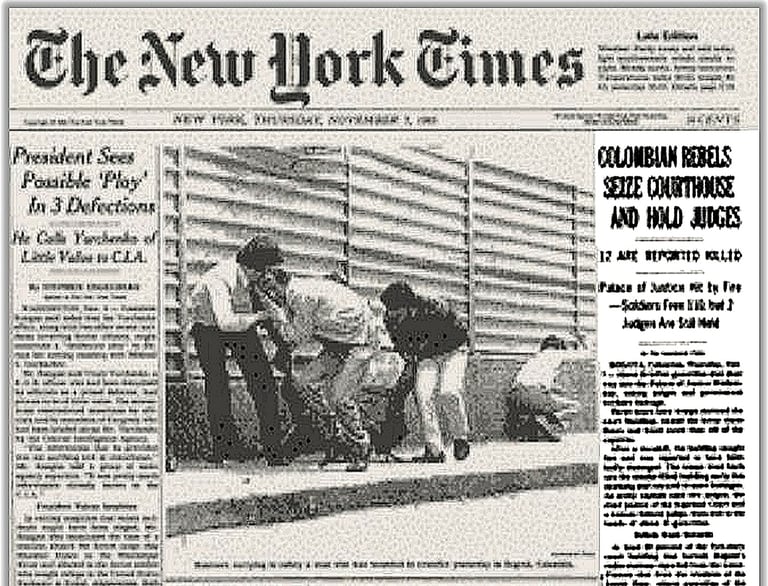

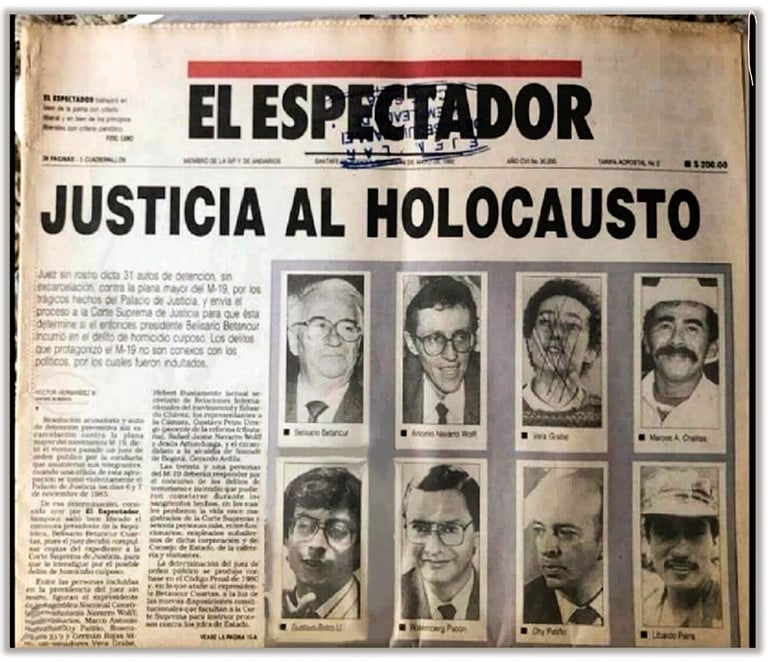

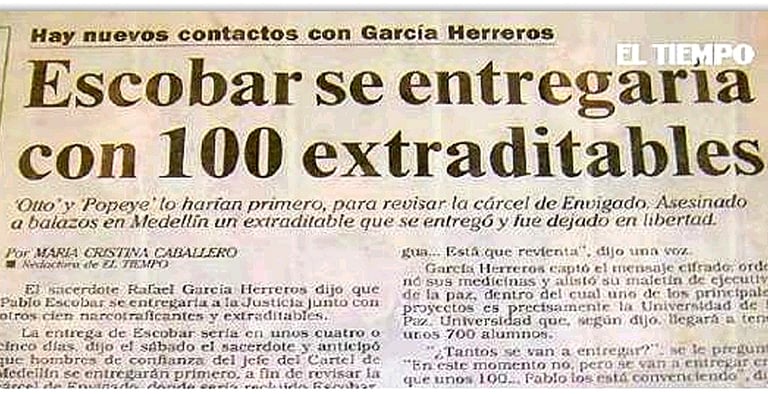

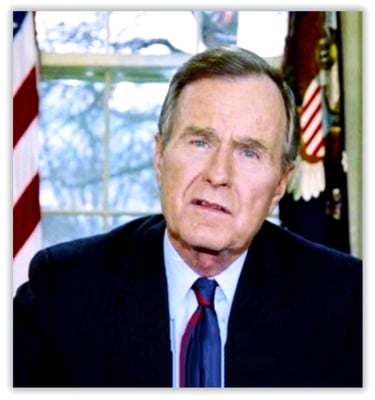

Supreme Court of Justice of Colombia November 7, 1985
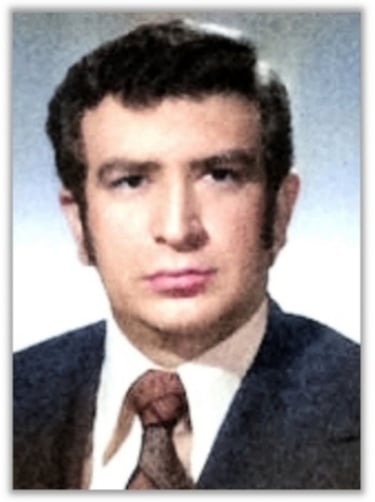

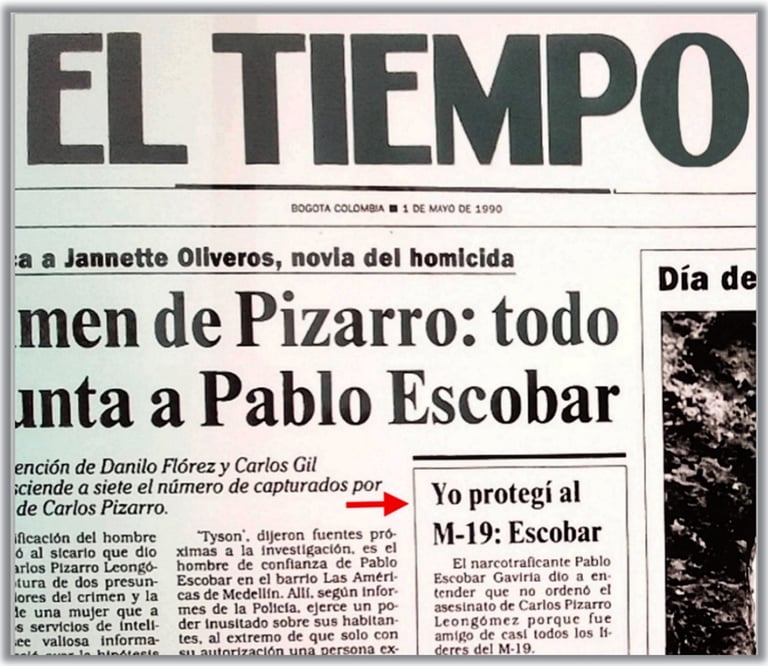

The Truth Commission established by the Supreme Court of Colombia described the human rights violations and crimes against humanity suffered by Justice Manuel Gaona Cruz at the hands of the M-19 guerrillas as "outrages against the dignity of Justice Gaona" (see Preliminary Report of the Truth Commission by Chief Justice, Hon. Jorge Anibal Gomez Gallego in Presentación del Informe Preliminar de la Comisión de la Verdad por el Magistrado y Ex Presidente de la Corte, Jorge Aníbal Gómez Gallego, CORTE SUPREMA DE JUSTICIA 2006; see video in MGC Death - Evidence).
On June 5, 1985, Pablo Escobar's Attorney, Julio Martin Uribe Restrepo, filed a complaint before the Supreme Court of Colombia challenging the constitutionality of the law approving the Extradition Treaty between Colombia and the United States of America (Law 27 of 1980). On June 28, 1985, the complaint arrived at the chambers of Justice Manuel Gaona Cruz. On Monday, August 5, Manuel Gaona Cruz received the first letter from the Extraditables (i.e., Pablo Escobar and the Medellín Drug Cartel), which transcribed:
Despite the security measures arranged to protect Justice Gaona and his family, the telephone interceptions at his residence continued throughout September. To discuss the report from the National Security Council regarding the risks and threats posed by the group "los Extraditables" led by Pablo Escobar against the Justices of the Constitutional Chamber and the Chief Justice, a meeting was held on Monday, September 30, 1985, at the Military Club. Those in attendance were the Justices of the Constitutional Chamber Manuel Gaona Cruz and Carlos Medellín Forero, the Chief Justice Alfonso Reyes Echandía, the Secretary of Interior Jaime Castro, the Secretary of Justice Enrique Parejo Gonzáles, the Director of the Administrative Department of Security (DAS) General Miguel Maza Márquez, and the Director of the National Police General Víctor Delgado Mallarino. The following day, on Tuesday, October 1, 1985, the Supreme Court of Justice of Colombia issued a press release informing the public about the threats from drug cartels related to the motion of unconstitutionality against the law approving the Extradition Treaty between Colombia and the United States, which was being considered by the Court. The constitutional review of the law was assigned to Justice Manuel Gaona Cruz.
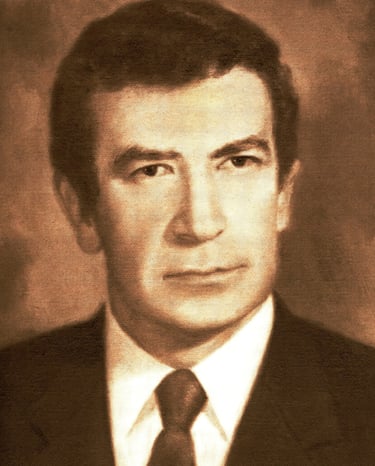

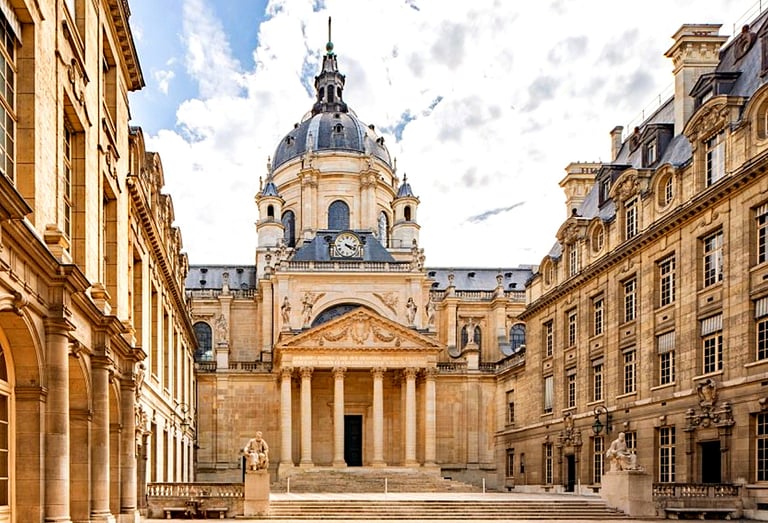

His doctoral dissertation on Colombian and Latin American Presidentialism was lauded by the Sorbonne University of Paris 1 with its highest academic honor, Summa Cum Laude. Manuel Gaona Cruz is one of the very few foreigners and the sole Colombian to appear on the list of the Sorbonne’s most illustrious alumni, having received distinctions from both the Government of the Republic of France (with a Diplôme d'État) and the Sorbonne University (with the highest honorable mention Très Bien). This esteemed list also includes figures such as Thomas Aquinas, Maximilien Robespierre, Honoré de Balzac, Alexis Henri Tocqueville, Marie Curie, Pierre Curie, Louis Pasteur, Michel Foucault, and Alfred Binet. Beside the year 1970, the reference, "Manuel Gaona Cruz, Colombia", is etched in stone.
In addition to the human rights atrocities, the violations of the most basic principles of International Humanitarian Law, and the crimes against humanity committed against Justice Manuel Gaona Cruz during his kidnapping and assassination at the hands of the M-19 guerrillas, with his passing, the nation lost one of his most brilliant jurists, who for many, was the greatest expert on Constitutional Law in Colombia (see Diana
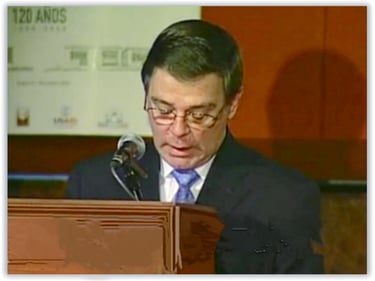

In 2022, Externado University held a ceremony to celebrate the victory of the former leader of the M-19 guerrilla Gustavo Petro Urrego in the presidential elections. At the event, the President of Externado University, Mr. Hernando Parra Nieto addressed the honoree before hundreds of students, saying: "Doctor Gustavo Petro, you are an illustrious son of Externado" (See complete speech and full ceremony at https://www.youtube.com/watch?v=loj6_r89rmU).
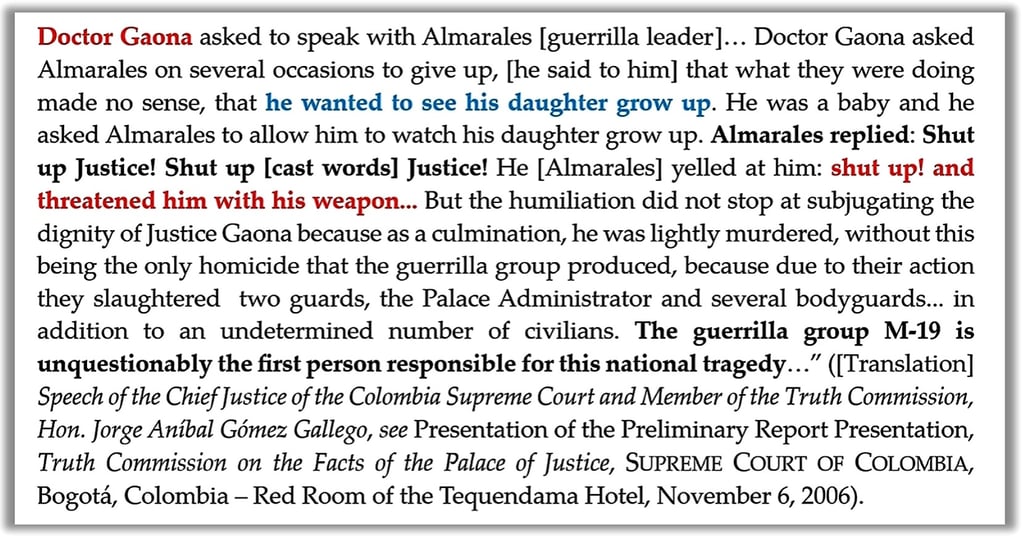

Manuel Gaona Cruz was the Chief Justice of the Constitutional Chamber (1984) and Justice of the Supreme Court of Colombia (1980-1985). He is recognized as one of the most brilliant and influential constitutionalists in the history of the country. His jurisprudence has transcended constitutional doctrine in Colombia and other countries in the region. His work as constitutional lawyer and his scholarly contributions as constitutional law professor were pivotal in the history and development of the Colombian constitutional system. The depth of his thought, the humbleness of his character, and the devotion to his academic work both as professor and as university president are remembered with profound appreciation by the thousands of students he educated from various universities and generations. His work as Under Secretary of Justice of Colombia and his fight against drug cartels in Colombia have also been recognized by judges, attorneys generals prosecutors, and international organizations. In 1996, the President of Colombia awarded Manuel Gaona Cruz the nation's highest civilian honor, the Order of Boyacá (Grand Cross, in memoriam) for his merits and his service to his country.
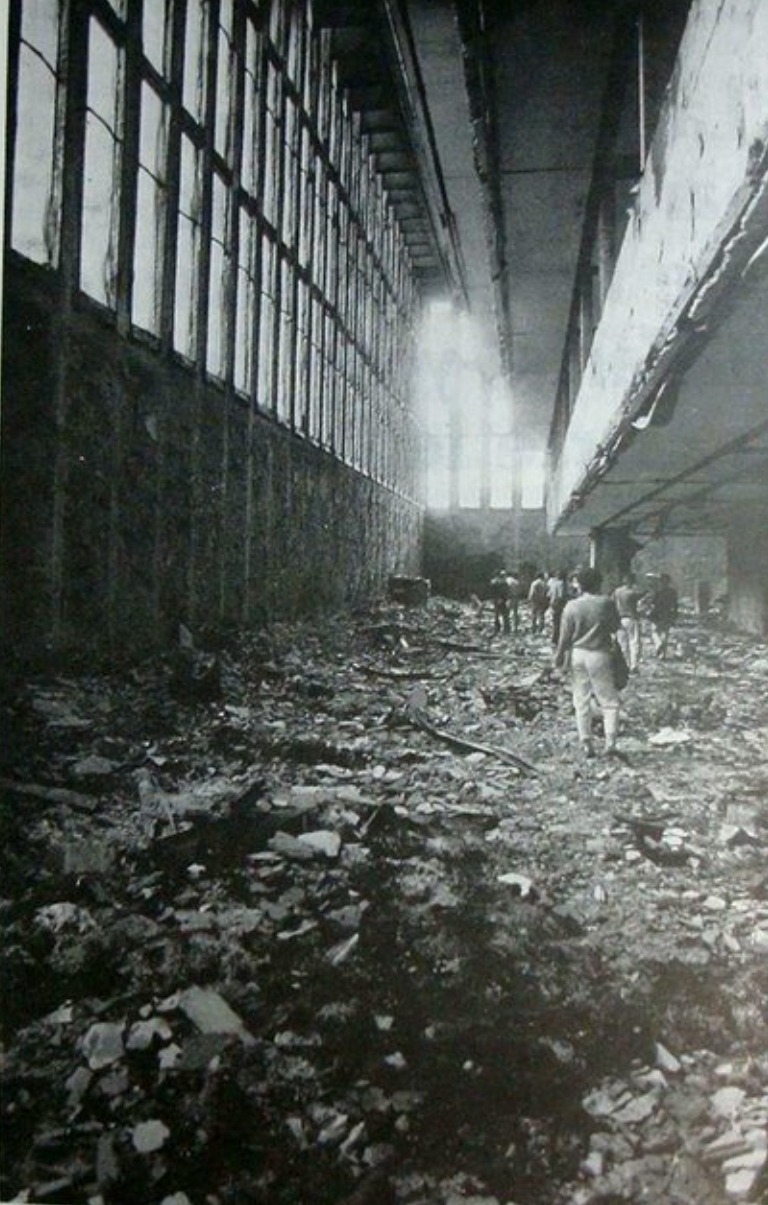

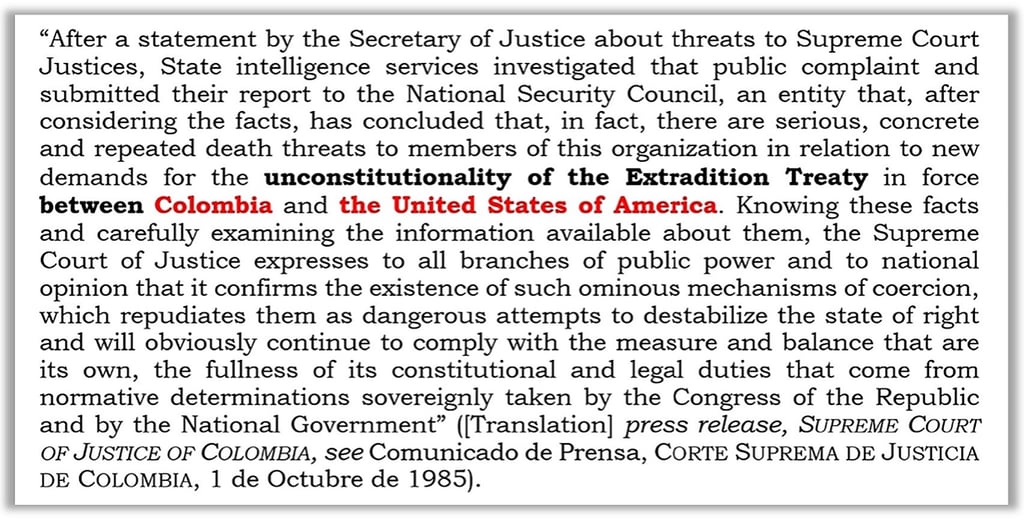



Following multiple bomb threats to his residence, surveillance of his family, phone calls, and audio cassettes with intercepted conversations of his children, on Sunday, September 1, 1985 and, while having breakfast with his wife and children, Justice Manuel Gaona Cruz received a second letter from Pablo Escobar signed by the group "los Extraditables" [The Extraditables]. In the letter, the Extraditables warned him not to defend his thesis on the constitutionality (the intermediate thesis) of the law approving the Extradition Treaty (see Pablo Escobar's and the Medellín Cartel's Second Letter to Justice Manuel Gaona Cruz in MGC Death – Documentary Evidence: Threats to Justice Manuel Gaona Cruz; see also the letter in Informe Final: Comisión de la Verdad Sobre los Hechos del Palacio de Justicia, CORTE SUPREMA DE JUSTICIA DE COLOMBIA, Ed. Universidad del Rosario 2010, page 315).
Manuel and his wife Marina Paris 1967


In addition to the notable influence of his constitutional and public law professors, Georges Vedel, Maurice Duverger and Georges Burdeau, Manuel and his wife experienced the protests of May 68 in Paris, along with the cultural transformation of French society following the emerging ideological debate between structuralists and existentialists in the 1960s.
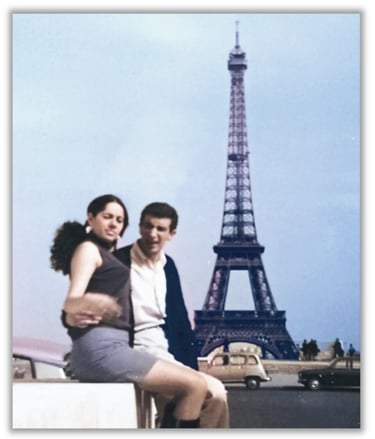

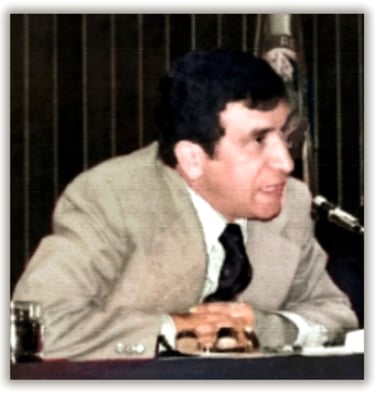

Sorbonne University - Paris 1
Letter from Pablo Escobar and the Medellín Drug Cartel to Justice Manuel Gaona Cruz (see full letter in MGC Death – Documentary Evidence – First Letter from the Extraditables; see also letter published in the Supreme Court's Truth Commission Final Report, id., Informe Final: Comisión de la Verdad, page 315).
After the assassination of all the justices who comprised the Constitutional Chamber of the Court (Manuel Gaona Cruz, Carlos Medellín Forero, Ricardo Medina Moyano, Alfon Patiño Rosselli), the attack on the Palace of Justice in 1985, and subsequently, on Justice Hernando Baquero Borda in 1986, Pablo Escobar finally succeeded in getting the new Supreme Court of Justice, under intimidation, to declare the Extradition Treaty between Colombia and the United States unconstitutional eleven months after the guerrilla takeover in December 1986 (see Supreme Court's Truth Commission Final Report, Id., Informe Final: Comisión de la Verdad, pages 163 and 319; see also Fabio Castillo, Los Jinetes de la Cocaína [The Cocaine Riders], EIE 1987, pp. 48 and 70-73; Full Statement of the U.S. Ambassador to Colombia, Charles Anthony Gillespie Jr. in MGC Death - Crime Motive: Pablo Escobar, the Extraditables, and the M-19 guerrillas).


Last words of Supreme Court Justice Manuel Gaona Cruz to guerrilla leader Andres Alamarales Manga, on Thursday, November 7, 1985, before being executed by M-19 guerrillas inside the Palace of Justice (see MGC Death – Testimonial Evidence; see also Statement of Jose Gabriel Salom Beltran before the Deputy's Public Ministry Office for Judicial Police in Declaración de José Gabriel Salom Beltrán rendida el 12 de marzo de 1986, PROCURADURÍA DELEGADA PARA LA POLICÍA JUDICIAL; see also Informe, TRIBUNAL ESPECIAL DE INSTRUCCIÓN CRIMINAL, Diario Oficial No. 37509, Cuaderno Original de Anexos de Instrucción No. 24, folios 1, 8 y 10, 1986; Informe Final: Comisión de la Verdad Sobre los Hechos del Palacio de Justicia, CORTE SUPREMA DE JUSTICIA DE COLOMBIA, Ed. Universidad del Rosario 2010, page 166; Ramiro Castellanos A., Asalto Final del Ejército : Los Guerrilleros Se Volvieron Como Locos [The Army's Final Assault: The Guerrillas Went Crazy], EL TIEMPO, June 22, 1986 {page 6-B}.

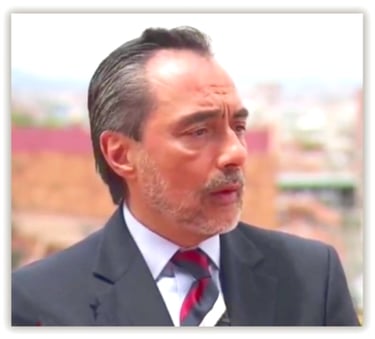
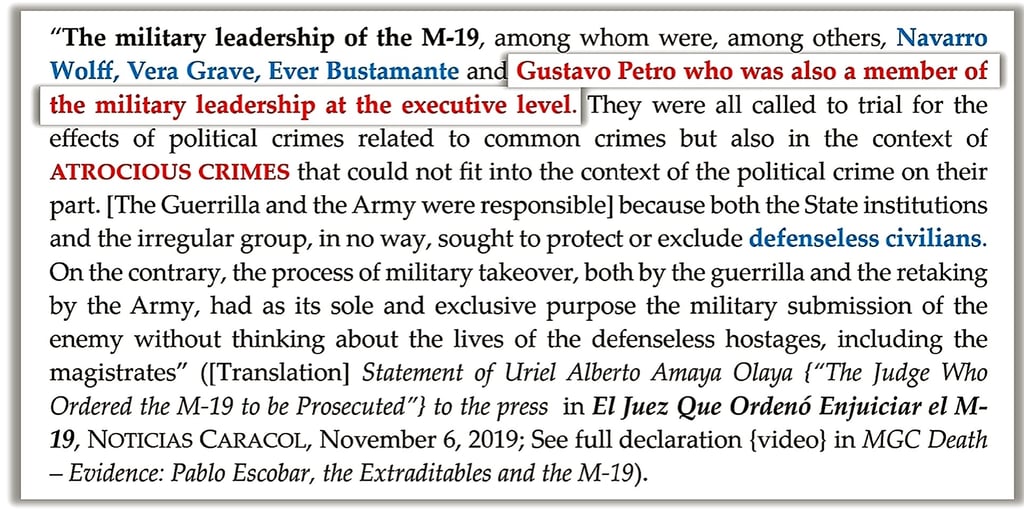

Uriel Alberto Amaya Olaya 30th Criminal Investigation Judge of Bogota (1989)
Charles Anthony Gillespie Jr. (Right) U.S. Ambassador to Colombia 1985-1988
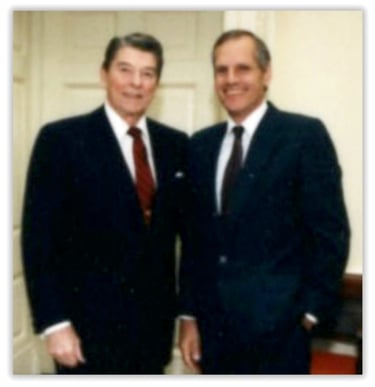

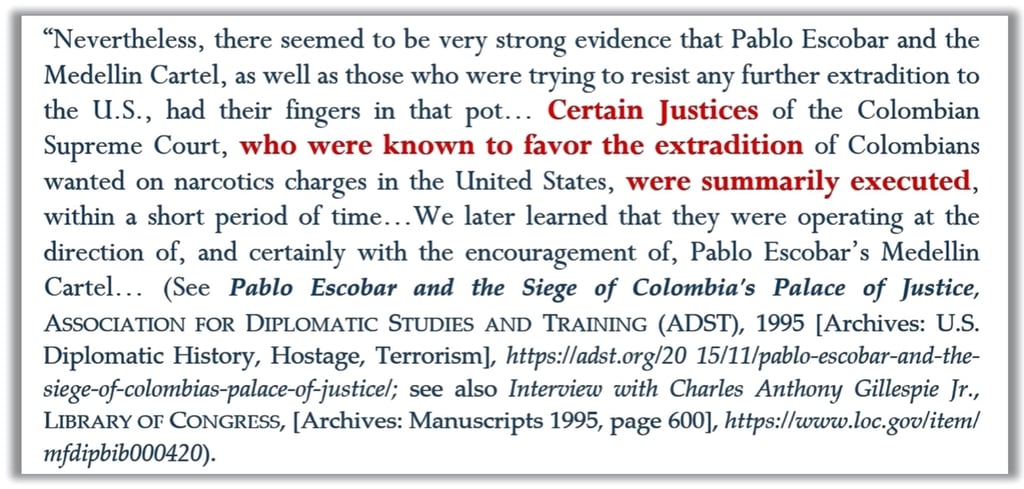

For his part, the President and then Vice President of the United States, George H. W. Bush, stated:
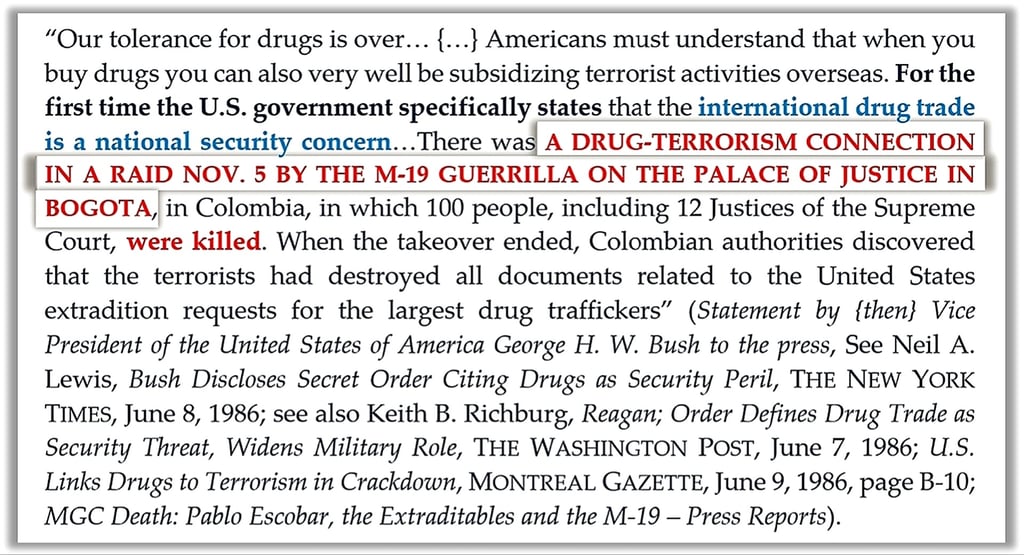

George H. W. Bush United States President 1989 -1993 Vice President 1981 - 1989


Jorge Anibal Gomez Gallego Chief Justice Colombia Supreme Court 2003-2004 Member of the Truth Commission 2006 - 2010
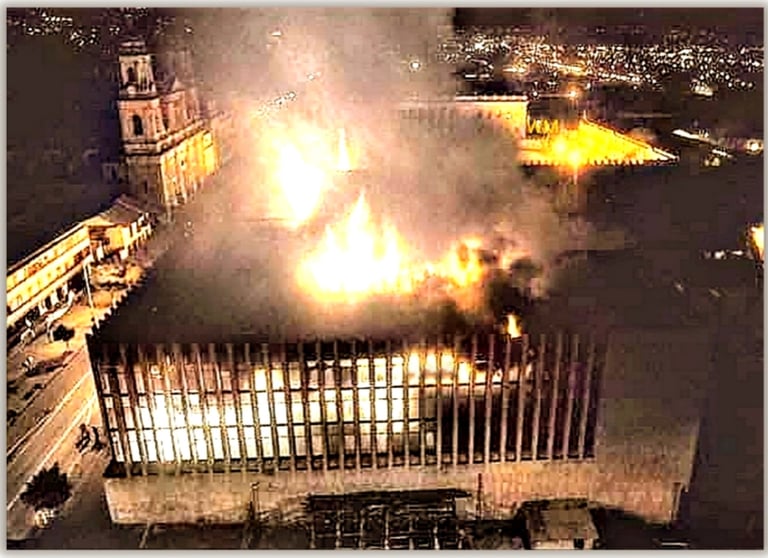

Supreme Court of Justice of Colombia November 6, 1985
Externado University of Colombia Hernando Parra Nieto (Left, University's President) and Gustavo Petro (Right, Former Leader of the M-19 Guerrilla and president-elect), July 26, 2022.
Despite the gesture and the welcome he received at the university where five of the eleven assassinated justices worked as law professors, the former guerrilla leader of the M-19 never acknowledged the terrorist group's responsibility for the crimes committed in the attack on the Palace of Justice, nor for the crime against Justice Manuel Gaona Cruz. In 2024, in fact, the guerrilla leader and (now) president of Colombia, Gustavo Petro Urrego, decorated his M-19 guerrilla comrades during the anniversary of the Palace of Justice takeover, calling them "examples of peace" (see Frank Saavedra, "El Presidente Petro Condecoró a Exguerrilleros del M-19 Junto a Miembros de las Fuerzas Armadas: 'Es un ejemplo de paz'," INFOBAE, November 5, 2024).

Voice and Teachings of Justice Manuel Gaona Cruz
Manuel Gaona Cruz led the group of lawyers who filed a lawsuit before the Supreme Court of Justice of Colombia against Legislative Act No. 1 of '79, a decision which led to the Fall of the 1979 Constitution (see Manuel Gaona Cruz & Antonio José Cancino, La Caída de la Reforma Constitucional de 1979, Ed. TEMIS 1981). His defense of the principles of Separation of Powers and the Independence of the Judiciary that caused it transcended not only as constitutional doctrine in Colombia, but as a reference in Comparative Constitutional Law in other countries (see Marisol Peña Torres, "La Caída de la Reforma Constitucional de 1979", REVISTA CHILENA DE DERECHO, Pontificia Universidad Católica de Chile, Vol. 10, 1983, pages 231-242). The influence of his legal opinions as Supreme Court Justice has been studied and highlighted by several generations of Colombian jurists. Among his most cited opinions are the doctrine of preliminary constitutional review, which was later adopted in the 1991 Constitution of Colombia (Article 241, Paragraph 10, "Jurisdiction of the Constitutional Court," POLITICAL CONSTITUTION OF 1991), granting the thereby created Constitutional Court the power to review international treaties and laws approving them before their ratification, as well as his intermediate doctrine (based on Public International Law, Comparative Constitutional Law, and Colombian Constitutional Law) which prevented the declaration of unconstitutionality of the law approving the Extradition Treaty between Colombia and the United States of America between 1982 and 1985. His most famous legal writings include, among others, the respect for freedom of the press and its sources, the respect for individual liberties and human rights in Colombia, the independence of the judiciary, the constitutional limitations on police power, the immutability of judicial rulings, the review and reform of the Constitution, the scope of the public action of unconstitutionality, the constitutionality of economic emergency decrees, and the constitutional limits on the state of siege and other states of exception in times of peace. At an international level, his doctrines on Latin American presidentialism and comprehensive and parallel constitutional review in Colombia—which Professor Gaona categorized as "the most complete in the West and, therefore, in the world" (Manuel Gaona Cruz, Control y Reforma de la Constitución en Colombia, MINISTERIO DE JUSTICIA DE COLOMBIA 1988, Tomo II, page 72)—became references in Comparative Constitutional Law (see Julio Cesar Ortiz, "El Control Constitucional en Colombia", BOLETÍN MEXICANO DE DERECHO COMPARADO, Universidad Autónoma de México UNAM, No. 71, 1991, pages 481-516; Allan R. Brewer-Carias, "El Sistema Mixto o Integral de Control de Constitucionalidad en Colombia y Venezuela", REVISTA TACHIRENSE DE DERECHO, Universidad Católica del Tachira, No. 5-6, 1994, pages 111-164; Jorge Alejandro Amaya, EL CONTROL DE CONSTITUCIONALIDAD, Astrea Argentina, 2015).
In response to his service as Director of the Department of Public Law and as a distinguished professor of Constitutional Law and the Theory of State, on the one hand, and in consideration to the request made by the students of School of Law and by the then President Fernando Hinestrosa to the Justice's widow, the body of Manuel Gaona Cruz was held for two days in the main auditorium of Externado University on November 8 and 9 of 1985.
This work has been published in Spanish, English, and French and it is the result of several decades of research. This research was directed by Professor and son of Justice Manuel Gaona Cruz, J. Mauricio Gaona. Our work was supported by historians, anthropologists, pathologists, criminologists, ballistics experts, forensic technicians, lawyers, architects, IT professionals, and field researchers in Colombia, the United States, and France. This website and the following research are dedicated to the loving memory of Manuel Gaona Cruz and to the young people in whom we entrust the truth, the history, the sacrifice and the legacy of a truly remarkable jurist and human being. We present this work to the youth in search of the truth with a message beyond our time. The life and death of Manuel Gaona Cruz are prologues. Both the perpetrators of the unjustifiable and the people and organizations that benefited from the impunity of his crime and the manipulation of the truth forgot an indelible premise of history that is present in all crimes against humanity: victims do remember.
All rights reserved © J. Mauricio Gaona - Foundation Manuel Gaona Cruz - 2025.
Justice Manuel Gaona Cruz 1985
Before leaving for France, Manuel proposed to his neighbor, Marina, whom he had known since childhood. Manuel Gaona Cruz departed from the port of Cartagena de Indias for Europe in late June 1966. The sea voyage lasted a little over a month, and he was accompanied by his legal theory professor, Luis Fernando Gómez Duque, who used to jokingly recall his first exchange with his student on the boat: "I remember I told him, 'Hey Manuel! You've been standing there for more than an hour now. You're going to catch a cold, and it's drizzling out there. Don't tell me it's the first time you've seen the sea.'" Marveling, wet, and with a slight smile, Manuel looked at him and replied: "It's my first time for everything." Upon arriving at the port of Cannes in August, Manuel and his professor went their separate ways. One went to Paris, while the other went to Germany. Before saying goodbye with a heartfelt hug, the professor told his student: "This is my train, and that one over there is yours. That train takes you to Paris, which is your final destination. Although, knowing you as I do, something tells me you will go farther. Take care, and say hello to Robespierre for me." After learning he was admitted to the Sorbonne's Doctoral School, Manuel and Marina met a few months later in Paris, where they lived for five years. From then on, they were together and started a family with their children, Gabriel, Mauricio, Manuel, and Juliana.
Despite rumors from alleged hearsay witnesses regarding the supposed departure of Manuel Gaona Cruz from the Palace of Justice and his subsequent execution at the hands of the Army, and notwithstanding the request made by Justice Gaona Cruz' sons to investigate human rights violations committed by both the M-19 guerrillas and the Army—including said rumors—the Prosecutor's Office could not confirm such rumors, for which it refrained from issuing a resolution of accusation regarding the alleged execution of Justice Manuel Gaona outside the Palace of Justice. In 2023, former Deputy Prosecutor Angela Buitrago was nominated for Attorney General by the president of Colombia and former leader of the M-19 guerrilla, Gustavo Petro Urrego. In 2024, she was appointed Secretary of Justice in Petro's Government. In spite of her affiliation and closeness to the government, the investigation conducted by Deputy Buitrago had an undeniable legal and historical merit in terms of human rights and, more particularly, in relation to the group of people who disappeared during the recapture of the Palace of Justice, which eventually led to the criminal responsibility of the Army's operational command.
Despite rumors promoted by people with judicial, economic, political and bureaucratic interests—aimed at distancing the M-19 guerrillas from Justice Manuel Gaona Cruz' assassination and at erasing from the collective memory of Colombians the criminal relationship between the M-19 and drug trafficking in the attack on the Palace of Justice (see MGC Muerte – Rumores Sobre el Homicidio del Magistrado Manuel Gaona Cruz)—the United States government never had any doubt about the execution of Justice Gaona Cruz at the hands of the M-19 guerrillas, nor about the criminal conspiracy that existed in the takeover of the Palace of Justice in Colombia between the Medellín Cartel, Pablo Escobar, and the M-19 guerrillas. The statement issued by the United States Ambassador to Colombia in 1985, Charles Anthony Gillespie Jr., which is kept in the Library of Congress and in the historical archive of the U.S. Department of State, is part of that nation's public and diplomatic record. On this matter, the U.S. Ambassador to Colombia declared:
Ongoing efforts to erase from Colombia's collective memory the crimes against humanity and the human rights violations committed during the 1985 Palace of Justice attack continue. The 2025 propaganda film November, produced by television commercial director Tomas Corredor, brazenly promotes the image of M-19 guerrillas as victims of the siege, completely sanitizing the atrocious crime committed against Manuel Gaona Cruz while twisting the Justice's own words to portray him as an ally of his assassins. Cynically cashing in on one of the greatest tragedies in Colombian history and the memory of one of its most well-known victims, the film fundamentally distorts Manuel Gaona Cruz’s words and actions, misrepresenting his personality, moral integrity, and the character known to thousands of his students and colleagues. To edit out human rights violations and rewrite the words of victims is an assault on the history of this holocaust. Today, some television producers are working at full speed to rewrite Colombia’s collective memory through a blockbuster aimed at glorifying the most barbaric actions, enticing the youth to follow their path, and erasing the crimes against humanity that were committed there.


LIFE
FIRST YEARS
Manuel Gaona Cruz was born on May 15, 1941, in the city of Tunja, in the Department of Boyaca, Colombia. His family was of humble origins, with his parents, Virginia Cruz and Manuel Gaona, working in textile production. As the oldest of ten siblings, Manuel was given the responsibility from a very young age to study and work simultaneously to help support his family. As a child, Manuel would often accompany his father on his trips through the towns of Boyaca, selling textiles used to make sacks, blankets, and ruanas (similar to ponchos). His father, Don Manuel, used to recount that at the end of their route, his son would sit on the hood of his truck to observe the people passing through the main squares of the towns they visited. This more than once led his father to recall a memorable response from his son when he asked: "What are you doing sitting there, son? What are you looking at so intently?" Smiling, his son answered: "I was looking at the difference between the people with ruana and those with ironed ruana. It's a good thing Tunja is cold, because without a ruana, we wouldn't be able to tell them apart."
Manuel did his primary studies at the Public School of Tunja and his high school studies at the Camilo Torres School in Bogotá, after his father decided to move the family to the capital. Yet, when Manuel announced that he wanted to study law, his father, who disliked lawyers, vehemently opposed the idea, which eventually led to Manuel leaving home to pursue his dream of becoming a lawyer.
Among the books that most fascinated Manuel were: The Wall by Jean Paul Sartre, On the Genealogy of Morality by Friedrich Nietzsche and the 1953 classic, awarded by the French Academy of Language, French Language and Civilization Course, by Gaston Mauger. With this last book, Manuel taught himself French.
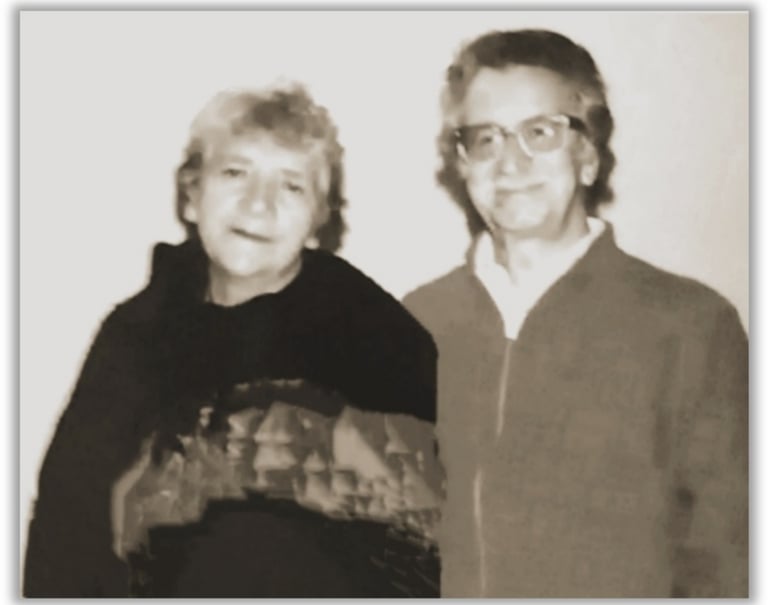

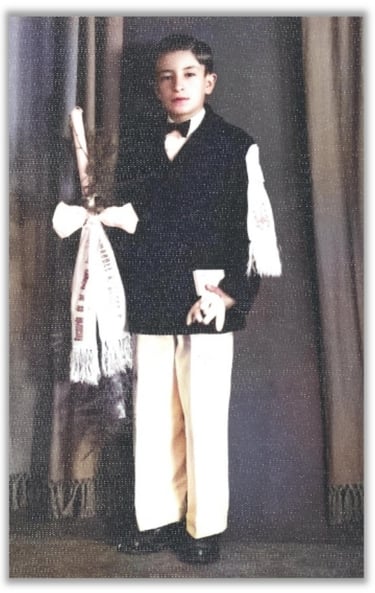

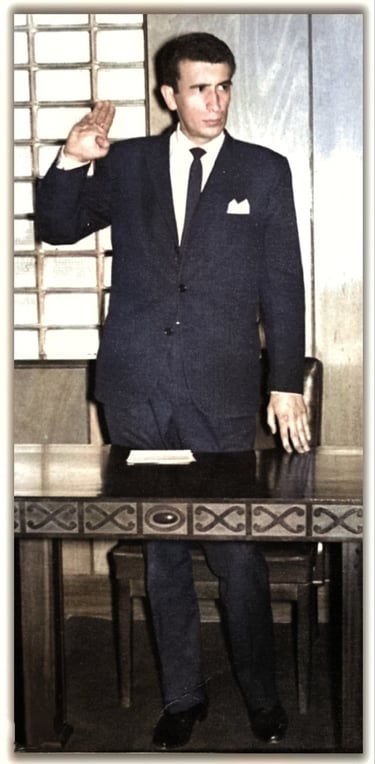

Virginia Cruz and Manuel Gaona Manuel Gaona Cruz' parents
Manuel Gaona Cruz First Communion 1949
Manuel Gaona Cruz Law degree graduation and swearing-in ceremony 1965
Years later, upon learning that his son was about to graduate with the highest honors from Externado University, father and son reconnected. A few months later, moreover, upon learning that the Government of France had granted his son an honorary scholarship to complete a Ph.D. in law at the Sorbonne University in Paris, Don Manuel organized a memorable party to celebrate his son's graduation, scholarship, and upcoming trip to France. Among the guests was his neighbor Marina, whom his son hadn't seen in several years. When Manuel saw Marina, he was captivated. They talked and danced for hours. That night, and without a formal courtship, Manuel proposed marriage to Marina and asked her to meet him a few months later in Paris. From that night on and until the end, Manuel and Marina were together.
Education and Life in Paris
Manuel Gaona Cruz graduated with honors and a law degree from Externado University in 1965. He later earned a summa cum laude (Mention d'honneur très bien) and a Ph.D. in Constitutional Law and Political Science from the Sorbonne University in Paris 1 in 1972. His doctoral thesis on Colombian and Latin American Presidentialism was lauded by the Government of the Republic of France and by the Sorbonne Doctoral School in 1970. His work was supervised by professors Georges Burdeau and Maurice Duverger.
After overcoming the distance with long love letters for six months, Manuel and Marina were married on January 6, 1967, and lived in an apartment on Rue Saint Antoine, very close to the Place de la Bastille in Paris. In their first years, the newlyweds enjoyed the splendor of the Parisian Bohème of the 60s, a scene inspired by the songs of Charles Aznavour, Yves Montand, Joe Dassin, and Jacques Brel, along with the French cinema movies of Alain Delon, Gérard Depardieu, Pierre Richard, Jean-Paul Belmondo, Brigitte Bardot, and Catherine Deneuve. They also encountered the ideological and cultural debate of the time between French existentialists and structuralists, shaped by Jean Paul Sartre, Michel Foucault, and Pierre Bourdieu.
Manuel and Marina found themselves in the heart of the May 1968 student protests in Paris (« mai 68 ») when the forces led by the government of General Charles De Gaulle entered the Latin Quarter and took over the Sorbonne University facilities. Following the increase in street violence and the closure of public transportation, banks, and postal services, food scarcity became imminent. Manuel and Marina had no other option but to take refuge in their apartment and share a cup of coffee and a baguette each day to make their food rations last. The May Revolution led to political, social, and cultural change in France. Since then, the role and power of students have transformed the French educational system. After putting his name forward to represent foreign students in France, the young Colombian lawyer was elected President of the International Association of Foreign Students CIRCUFLAK in August 1968.
Manuel Gaona Cruz defended his doctoral thesis in the fall of 1970 before a jury of five professors, including three of the most legendary professors of the Sorbonne University: Georges Vedel (Member of the French Constitutional Council and the French Academy), Maurice Duverger (Professor Emeritus of the Sorbonne University), and Georges Burdeau (Honorary Professor of the University of Paris, author of the General Theory of the State and the ten-volume Treatise of French Constitutional Law; see La mort de Georges Burdeau: Analyse d'une étonnante modernité, LE MONDE, April 27, 1988). The defense of Manuel Gaona Cruz's Ph.D. dissertation lasted three and a half hours. At the end of his presentation and, in a symbolic gesture considered truly exceptional, the professors exchanged notes, looked at each other, and rose to applaud the candidate.
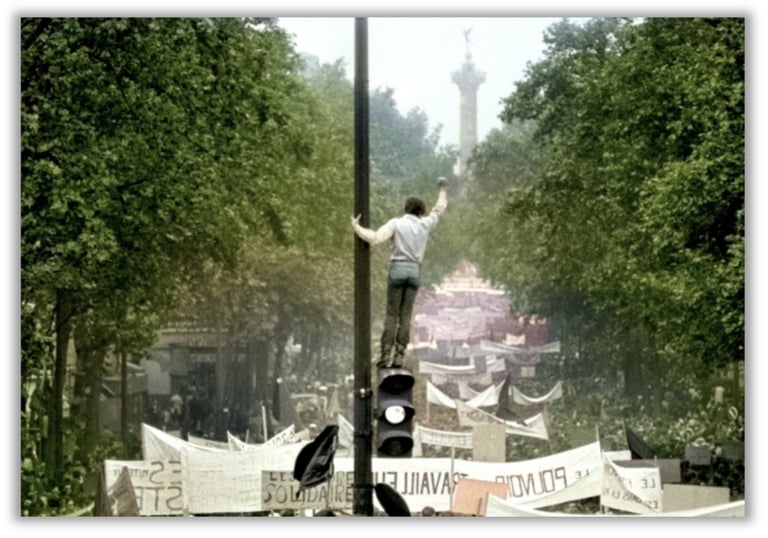

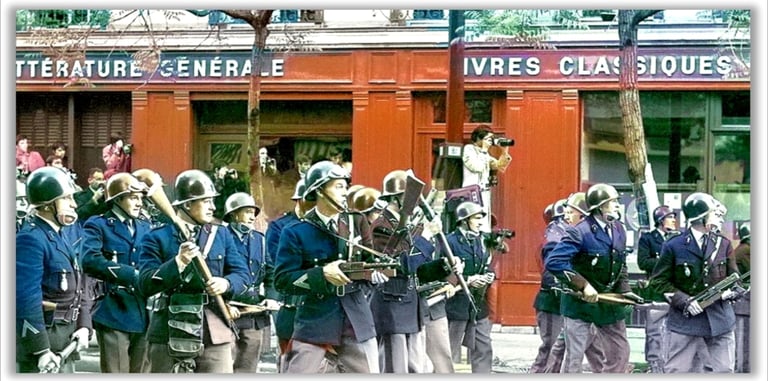

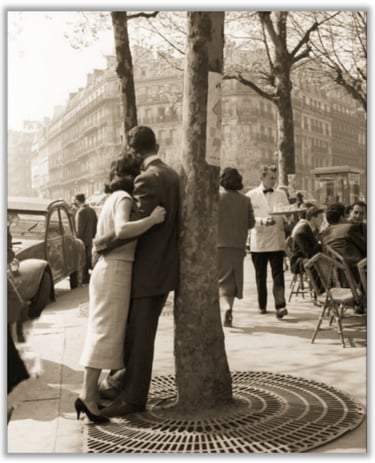

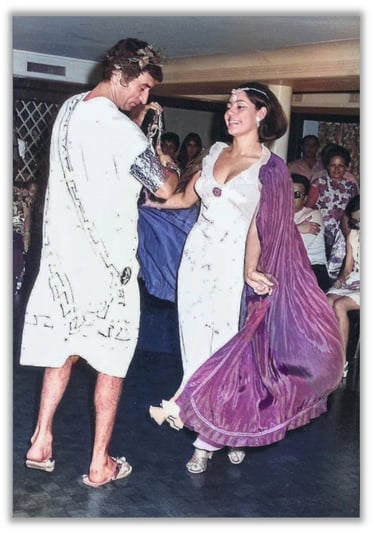



Manuel Gaona Cruz with his wife Marina in París 1966 – 1971
Student Protests at the Bastille Paris, May 1968
General De Gaulle's forces enter the Latin Quarter and capture the Sorbonne Paris, May 1968.
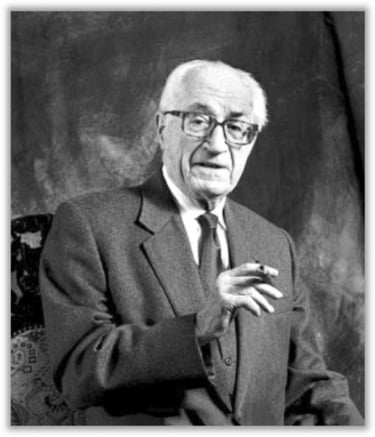

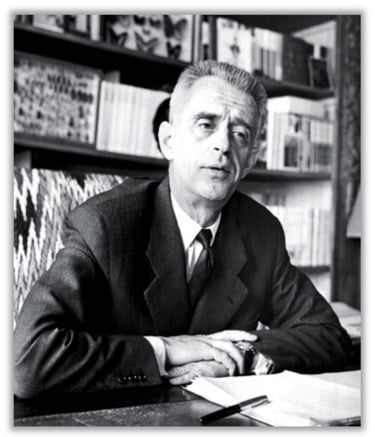

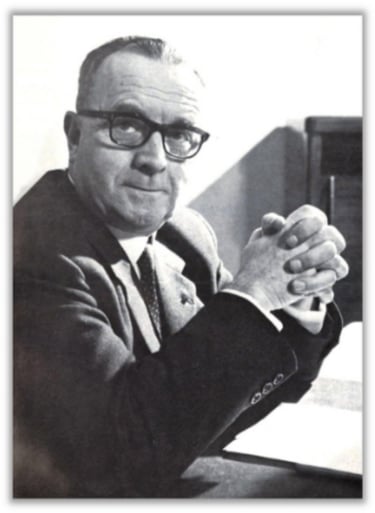

Goerges Vedel
Goerges Burdeau
Maurice Duverger
Professors of Manuel Gaona Cruz at the Sorbonne
Then, they announced their decision to award him the State Doctorate (Doctorat d'État) with the highest French academic distinction and the unanimous declaration of the thesis jury: Summa Cum Laude « Très bien, Monsieur Gaona! Très bien! » (Very good, Mr. Gaona! Very good!). Outside the professors' room, his wife Marina waited for him in her most beautiful dress with a bouquet of flowers. Upon hearing the applause, Marina stood up. When she saw her husband escorted out by his professors and heard the applause of the students who had gathered in the hallway after hearing the news, Marina, emotional and with tears in her eyes, ran to embrace her husband. According to what Manuel and Marina later told their children, that was "the best hug of our lives."
Teachings, Home and Personality
Manuel Gaona Cruz is remembered by friends and students as an exceptional, brilliant, and lively person who was deeply humble, very sociable, and pleasantly jovial. He enjoyed telling jokes and socializing with friends, colleagues, and family in his home. More than that, Manuel was an insatiable reader. His library occupied a primary place in his home and in his life. By 1985, Professor Gaona's library had more than 2,000 volumes in comparative constitutional law, history, philosophy and literature, along with a hundred vinyl records of great classical works that he used to listen to while writing. More than seventy percent of the books that made up his library were written in French and English. When his older children would ask him questions that required an extensive explanation, Manuel would hand them over two books: one with the answer and another with the grammar to understand the language in which it was written. For his older children, Manuel Gaona Cruz was always a teacher more than a father.
Manuel and Marina had four children: Juliana, Gabriel, Mauricio, and Manuel. Their daughter Juliana arrived toward the end of their lives, but she was undoubtedly their greatest joy and fascination. According to one of Manuel Gaona's dearest friends, Humberto Merchan, "Manuel's delight in having his daughter Juliana was contagious. He would go crazy with happiness every time his daughter learned or did something. Every time we saw each other, he would excitedly come into my office to tell me 'stories of the future' about the trips he wanted to take with his daughter and the things he wanted to teach her." Every night upon returning from the Court, Manuel dedicated a couple of hours to talking, playing with, and making his daughter laugh. Because of his personality and frankness, his son Gabriel was the one who made the Justice laugh the most.
De todas las caminatas que hicieron con su padre, la que sus hijos mayores más recuerdan eran las que solían hacer por el caribe Colombiano entre la ciudad de Santa Marta y un pueblo costero llamado Taganga. En una de sus últimas caminatas, Manuel le ensenó a sus hijos a caminar por la vida diciendo:
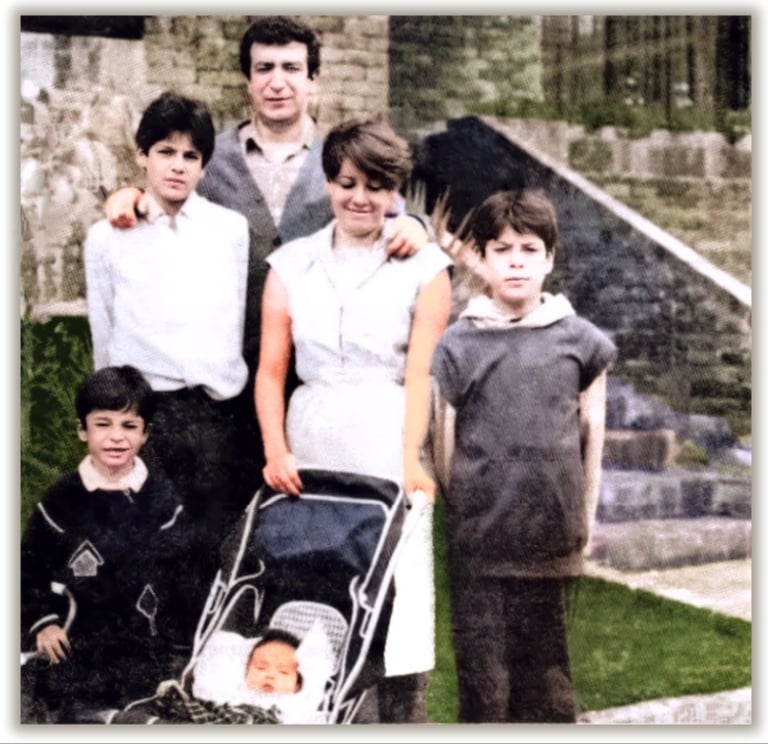

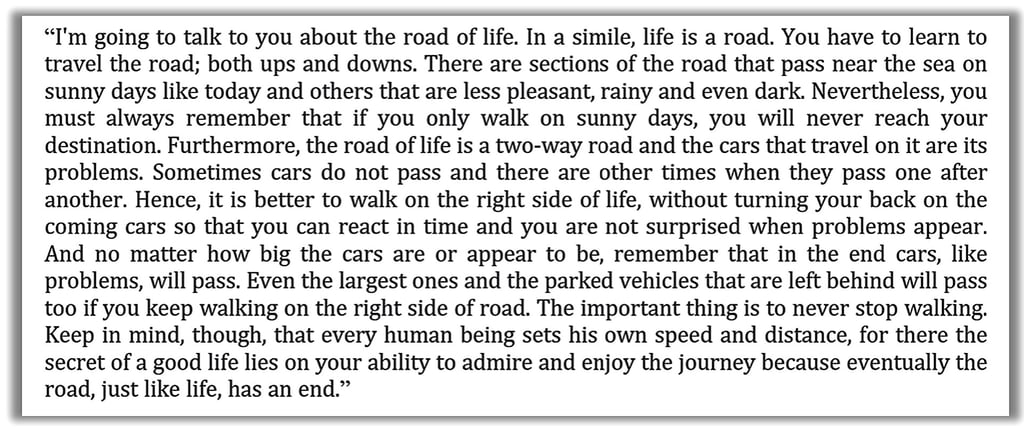

The Route of Life
Justice Manuel Gaona Cruz's Family Last photograph of Manuel Gaona Cruz with his children, his baby, and his wife, taken in front of their home three months before the siege of the Palace of Justice. Septiembre 7, 1985.
Career in Colombia
The Under-Secretary of Justice and His Fight Against Drug Trafficking
General-Secretary of Colombia's Public Ministry
Upon returning to Colombia, Manuel Gaona Cruz joined the Office of the Attorney General as an Assistant Prosecutor. Soon, word of the brilliant young prosecutor who had just returned from France reached the then-Attorney General, Jesús Bernal Pinzón, who, after an interview, decided to promote him to an advisory lawyer in his office. Dozens of Colombians who served in the Attorney General's Office during that time still fondly and emotionally remember the personality, humility, and intelligence of Manuel Gaona Cruz. Attorney General Bernal Pinzón himself recounted on more than one occasion the promotion of his young advisor to Secretary General of the Attorney General's Office after asking him: “Doctor Gaona, what should I do? I need to appoint a Secretary General because the one I had left. The problem is it will only be for two months because my term is ending. Do you have a candidate?” — “Of course! Doctor Bernal, I have the exact person for you.” — “Who?” — “Well, me.” After meeting him and receiving excellent references from his predecessor and from delegate and assistant prosecutors, the new Attorney General, Jaime Serrano Rueda, ratified Manuel Gaona Cruz as Secretary General (See Oscar Alarcón Núñez, “La Vida y Tragedia de Manuel Gaona Cruz” in Estudios Constitucionales Manuel Gaona Cruz, MINISTERIO DE JUSTICIA 1988, Volume II, page 609).
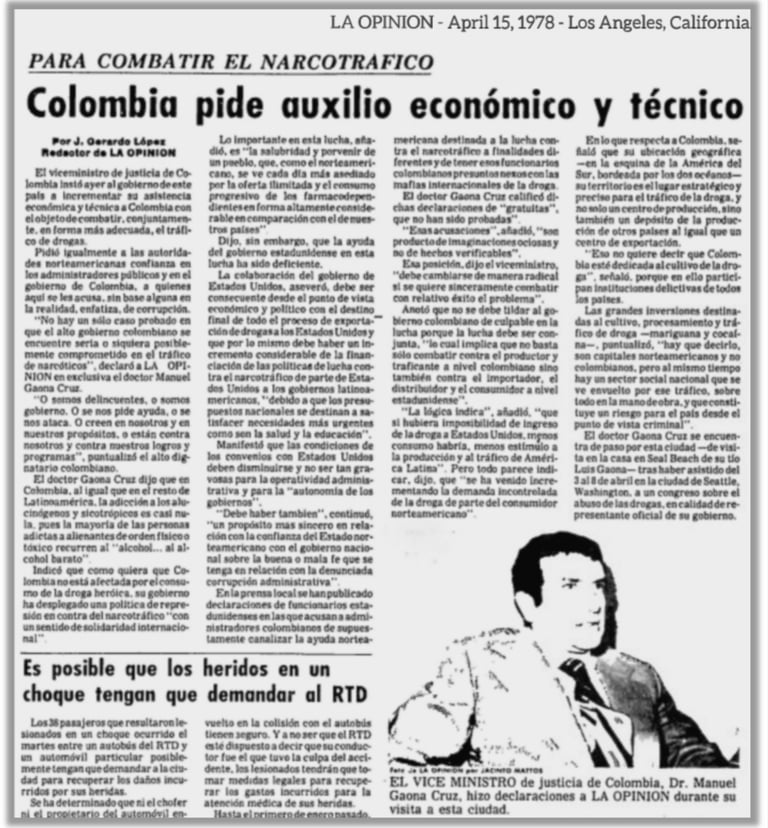

Manuel Gaona Cruz served as Under-Secretary of Justice of Colombia during the administration of President Alfonso Lopez Michelsen and Secretary Cesar Gomez Estrada. During his tenure, Manuel Gaona Cruz was credited, among other things, with the development of the Notarial Statute and the Superintendence of Notarial and Registry, as well as the development of the first state policies related to the fight against drug trafficking and the production of drugs, psychotropic substances, and narcotics in Colombia (See Estudios Constitucionales Manuel Gaona Cruz, id., pages 600-609; see also Report of the International Narcotics Control Board, INTERNATIONAL NARCOTICS CONTROL BOARD (INCB) OF THE UNITED NATIONS, 1978, E/INCB/41, New York, 1978; Bruce M. Bagley, Colombia and the War Against Drugs, FOREIGN AFFAIRS, September 1, 1988).
During the International Forum of Judges and Prosecutors held in Washington D.C. in 1978, and before officials from the United Nations and various countries, the Under-Secretary of Justice Manuel Gaona Cruz denounced the exponential growth of drug cartels in Colombia. He attributed this to the increase in drug use in Europe and North America, the lack of international mechanisms to combat drug trafficking, and the unprecedented rise of economic and political corruption in producer countries. In a subsequent visit to the United States, then Under-Secretary Gaona initiated the first process of judicial cooperation with the U.S. based on shared responsibility, while also requesting a technical and financial assistance package from American authorities to jointly fight drug trafficking as a global phenomenon. The newspapers LA Times, La Opinión, and The Herald (See To Fight Drug Trafficking Colombia Asks for Economic and Technical Aid, LA OPINION, April 15, 1978) reported on the Colombian Government's request through its Under-Secretary of Justice.

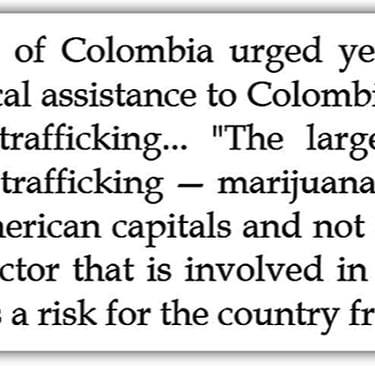
University President and Constitutional Law Professor
In 1976, the Mayor of Bogota appointed Manuel Gaona Cruz as President of the Francisco Jose de Caldas District University in Bogota, during one of the most convoluted periods in that university's history. The comprehensive restructuring that the young lawyer proposed to the Mayor was essential to save the university, reestablish order, integrate minorities, and promote a merit system for professors and students. In the words of Manuel Gaona Cruz's successor as rector of the university, Professor Jorge Rivadeneira Vargas:
One of Professor Gaona Cruz's best students and disciples, Professor Rodrigo Uprimny Yepes, describes his teacher's constitutional philosophy as a conception of law that is at once sociological and axiological. Gaona believed that law in general and constitutional institutions in particular could not be understood outside of their social context, and that the raison d'être of any State is to protect individual liberties, not to restrict them. For this reason, he indicated that the Constitution must be interpreted as a guarantor of rights, not merely in its strictly normative sense, believing that "the Court protects the Charter, not the Charter the Court." He argued that respect for the law cannot precede the respect for life or human rights, and that the Constitution is not a norm per se, but rather a "tripartite" Constitution, that is: "political, legal, and ideological Constitution" (Uprimny, Rodrigo et al. “La Filosofía Constitucional del Profesor Gaona" en Estudios Constitucionales Manuel Gaona Cruz, MINISTERIO DE JUSTICIA 1988, Tomo I). For Gaona, in short, "constitutional norms are the institutional embodiment of a specific conception of the world," and their justification is found in the "axiological or evaluative aspect that explains the Constitution's raison d'être," from which our rights and most primary liberties are derived ( See Manuel Gaona Cruz, Ponencia: Congreso Internacional de Derecho Constitucional, Sao Pablo-Brasilia, Brasil, 1976; Manuel Gaona Cruz,. “La Reforma del 36”, REVISTA 6 DE NOVIEMBRE, No. 2, junio 1986, página 50).
Chief Justice of the Constitutional Chamber and Justice of the Supreme Court of Colombia
Manuel Gaona Cruz was appointed as a Justice of the Court in July 1980 and as Chief Justice of the Constitutional Chamber of the Supreme Court of Colombia in 1984. The list of candidates nominated to replace his predecessor, the Constitutional Chamber's Justice Gonzálo Vargas Rubiano, was made of then-former Under-Secretary of Justice Manuel Gaona Cruz, former Mayor of Bogotá Bernardo Gaitán Mahecha, and Magistrate of the Council of State Humberto Mora Osejo. At 38 years of age, Manuel Gaona Cruz was victorious and was appointed by the Supreme Court of Justice.
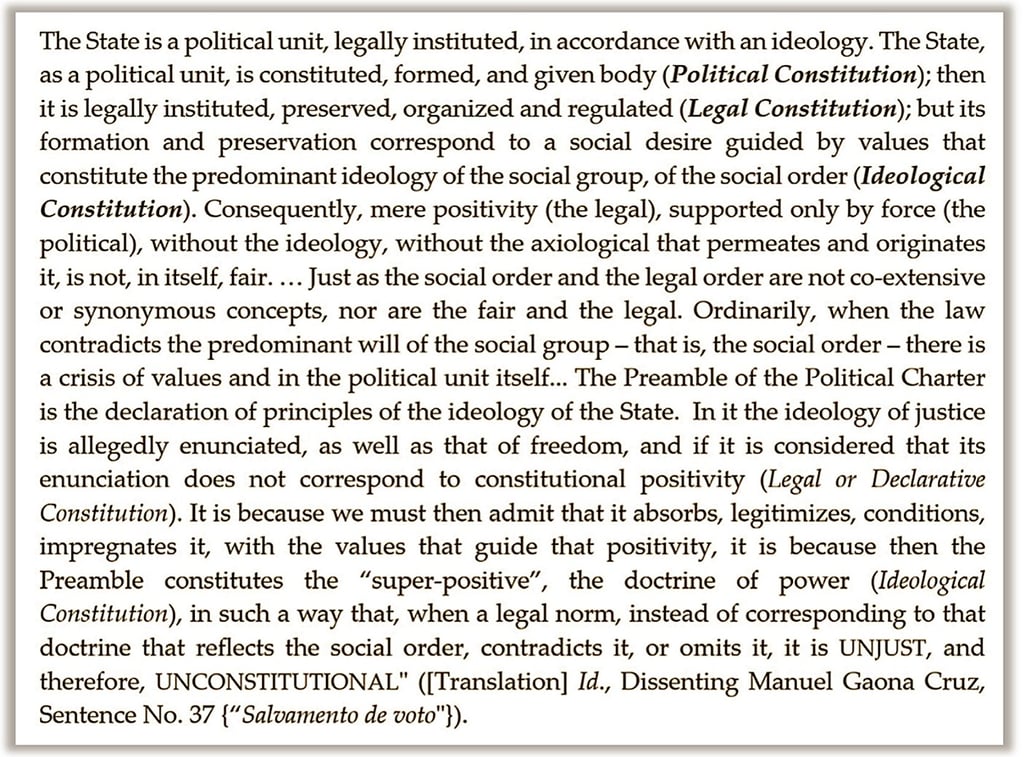

The jurisprudence of Magistrate Manuel Gaona Cruz is extensive and highly varied. His rulings, clarifications, and dissenting opinions in Public Law, Constitutional Law, and International Law established very clear jurisprudential lines on the prior constitutional review of international treaties signed by Colombia and the laws that approve them. This thesis changed a century's worth of jurisprudence from the Supreme Court of Justice, which had always been reluctant to exercise such control under the regime of the 1886 Constitution. Justice Gaona's thesis gained traction in the Court during the 1980s and was later adopted in the 1991 Constitution of Colombia (Article 241, Section 10, "Powers of the Constitutional Court," CONSTITUTION OF 1991). His most famous rulings include those on the respect for freedom of the press, the application of international treaties and human rights in Colombia, the constitutional representation and protection of minorities, the limits on police power and military criminal justice, the constitutional scope of fiscal, political, and disciplinary controls, the technique and methods of constitutional interpretation, the autonomy and independence of the judicial branch, the intermediate thesis and the constitutionality of the law approving the Extradition Treaty between Colombia and the United States of America (Law 27 of 1980), integral-type constitutional control, the constitutionality of economic emergency decrees, the state of siege and constitutional criminal law, the monetary and exchange sovereignty of the Colombian State, the constitutional regime of savings, taxes on the coffee industry, state interventionism, and economic freedoms, among others. His well-known dissenting opinion on "the Ideological Constitution," based on his study of state theory "The Doctrine of Power," has become a benchmark for methodological constitutional interpretation for Colombian and Latin American courts. It has allowed for connecting the spirit that inspires and precedes the creation of a Constitution with its normative scope, despite the distance between the time of its authors and that of its interpreters (CSJ, Dissenting Opinion of Manuel Gaona Cruz, Ruling No. 37, Case No. 868, July 6, 1981). Regarding the Ideological Constitution and the Doctrine of Power, in particular, Magistrate Manuel Gaona Cruz wrote:
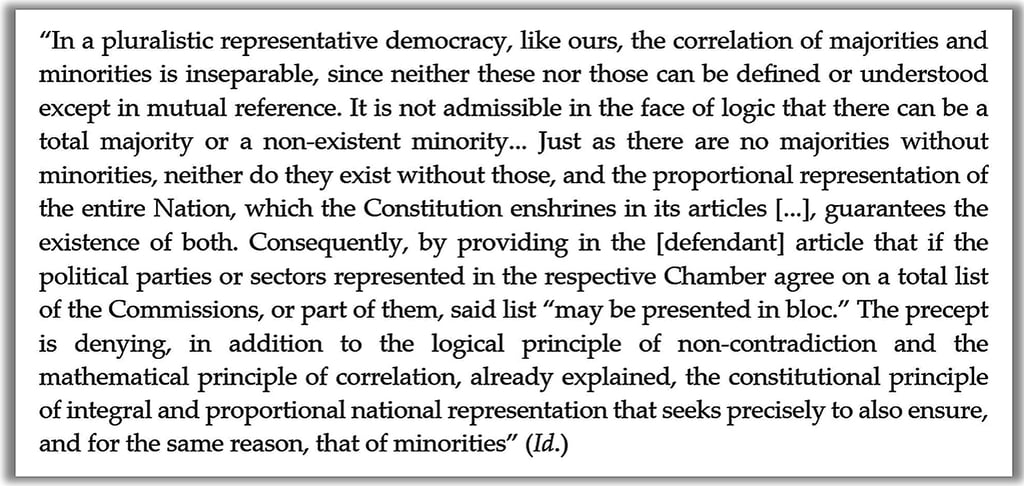

Regarding the respect for international law in Colombia and the constitutionality of the law approving the Extradition Treaty between Colombia and the United States (Law 27 of 1980), Justice Manuel Gaona Cruz wrote:

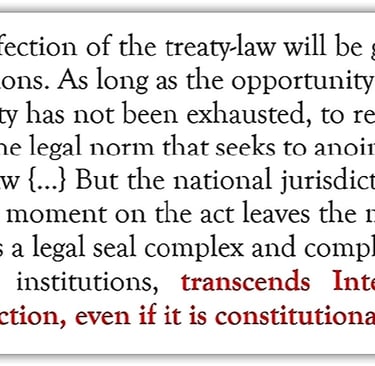
Consequently, for both the Constitutional Chamber that was deciding the fate of the law approving the Extradition Treaty between Colombia and the United States (Law 27 of 1980) and for Justice Manuel Gaona Cruz, who wrote the extradition ruling known as the "intermediate thesis," there was no doubt about the constitutionality of the treaty-law. Four months before the Palace of Justice siege, in his final intervention on the extradition of Colombian drug traffickers to the United States (CSJ, Concurring Opinion of Justice Manuel Gaona Cruz, Ruling No. 41, File No. 1275, June 5, 1985, Judicial Gazette 2422, 1st semester, page 429), thevJustice of the Constitutional Chamber of the Supreme Court of Colombia, Manuel Gaona Cruz, ruled:
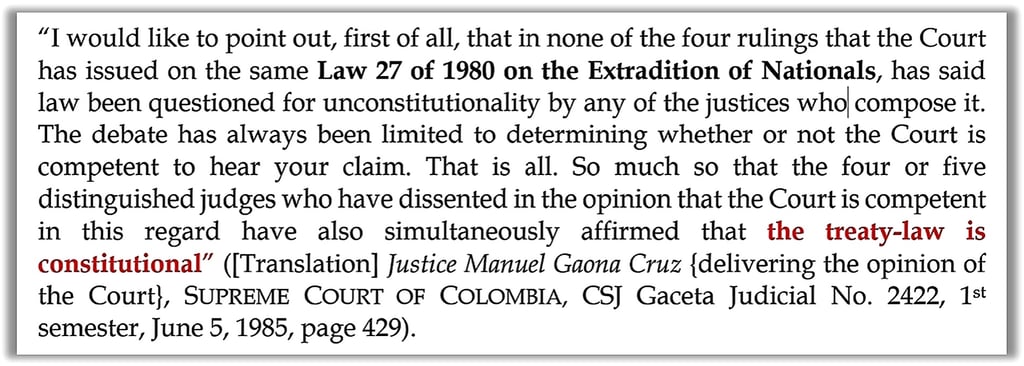

The thesis of Justice Manuel Gaona Cruz on the enforceability ("ejecutoriedad") of international treaties in Colombia—including the Extradition Treaty with the United States—was called the intermediate thesis because its legal and methodological basis was built on an interpretation of both international law (general, bilateral, and comparative) and domestic law (Colombian Constitutional Law). This thesis argued that from the perspective of General International Law (Vienna Convention of 1969, articles 5 and 11), international agreements and treaties are applicable in signatory countries from the moment the treaty is perfected through the exchange of diplomatic notes between the parties. From the perspective of Bilateral International Law (United States of America and Colombia), it also established that the exchange of notes had been carried out between the Colombian Ministry of Foreign Affairs and the U.S. Department of State. According to Magistrate Gaona's meticulous analysis, the primacy of General International Law is recognized by most of the world's constitutions, which gives treaty-laws a special character and hierarchy. From the perspective of Domestic Law (Colombian Constitution), the Supreme Court of Justice only has the power of peremptory constitutional reviewover the laws that seek to approve international treaties made by the Colombian Government. This power, Justice Gaona wrote, is lost when the treaty is “denationalized” and becomes part of International Law. According to the magistrate, the denationalization of the treaty occurs when the President of the Republic signs the approving law, that is, ratifies the treaty. Once perfected and ratified, the Court loses jurisdiction to rule on the enforceability or "ejecutoriedad" of the treaty in Colombia, as it is nothing more and nothing less than an agreement that, by virtue of its perfection and ratification, ascends to a superior legal hierarchy that makes it fully constitutional: that of a treaty-law. And being constitutional, Justice Gaona added, the Court cannot do anything other than to inhibit itself, as it cannot examine the enforceability (or decree the nullity) of a treaty-law. Eventually, Justice Gaona Cruz's thesis, discussed and carefully shaped in four previous decisions with his colleagues in the Constitutional Chamber, became the official position of the Supreme Court of Justice of Colombia concerning the extradition of drug traffickers ("Colombians and foreigners") to the United States. In his constitutional study (See CSJ, Concurring Opinion of Justice Manuel Gaona Cruz, Judgment No. 1, File No. 1075, September 1, 1983), Justice Manuel Gaona Cruz wrote:
Such a jurisprudential position turned Magistrate Manuel Gaona Cruz and the Magistrates of the Constitutional Chamber into military targets for Pablo Escobar and the members of the drug cartels in Colombia. This eventually led to a criminal alliance between the M-19 guerrilla—which publicly repudiated the Court's position—and the Medellin Cartel, which, despite knowing the Court's stance, filed a nullity action through an attorney against the law approving the treaty just a few days after the Court's last ruling had declared it fully constitutional. The purpose was to use threats to pressure the magistrates of the Constitutional Chamber and their families into declaring the law “unconstitutional,” through what the Medellin Cartel called: “our declaration of war” (See MGC Death - Documentary Evidence: Pablo Escobar's Second Letter to Justice Manuel Gaona Cruz).
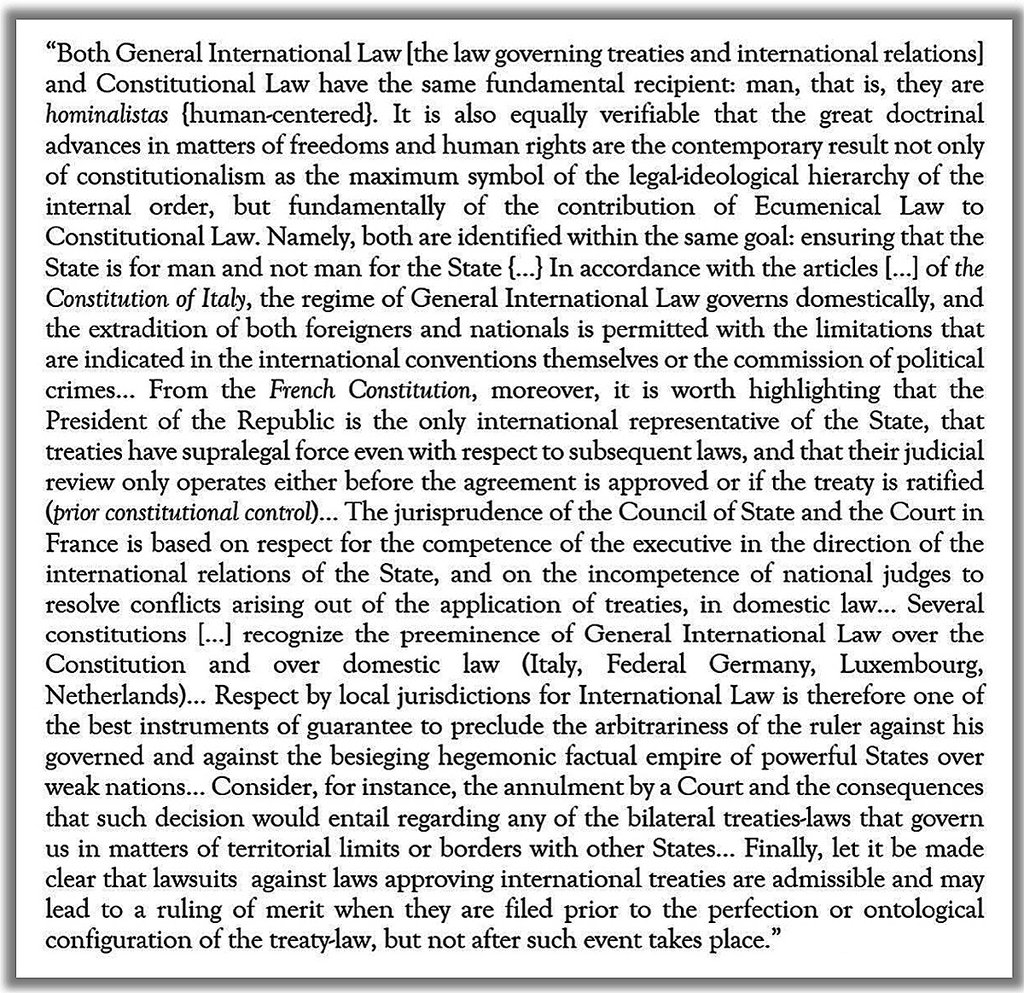

Jurisprudence
International Law in Colombia - Extradition Treaty between Colombia and the United States of America

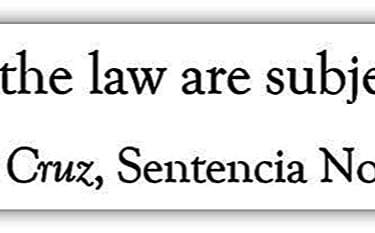

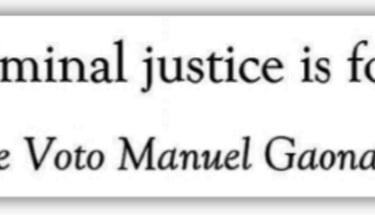

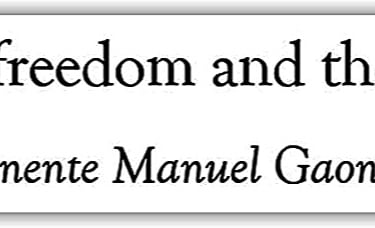

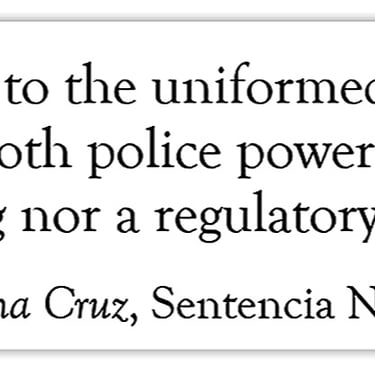

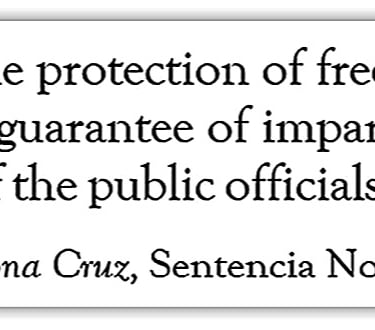

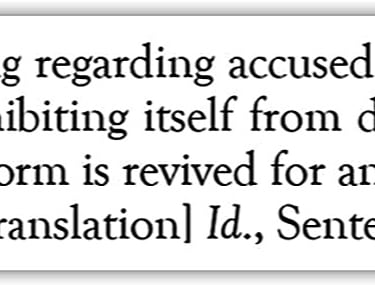

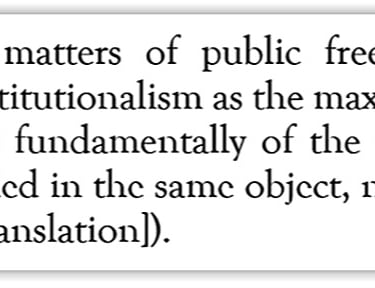
Constitucional Doctrine


The Constitutional Law Attorney and the Fall of the 1979 Constitution
As a citizen and constitutional lawyer, Manuel Gaona Cruz led the group of lawyers who filed and won the unconstitutionality lawsuit (Art. 215, Constitution of 1886) against Legislative Act No. 1 of 1979, known as "The 1979 Constitution," before the Plenary Chamber of the Supreme Court of Justice. The challenged Act sought to reform the Colombian Constitution through legislative means, using as a preliminary framework temporary modifications introduced by Act No. 1 of 1977. The legal team was composed of Manuel Gaona Cruz, Antonio José Cancino, Oscar Alarcón Núñez, J. Climaco Giraldo Gomez and Tarsicio Roldán (CSJ, M.P. Fernando Uribe Restrepo, Inexequibilidad de la Reforma Constitucional de 1979, 3 de noviembre de 1981, Expediente No. 786). The scope of the reform, the unconstitutionality lawsuit against it, the Supreme Court's decision to declare it invalid, and the Legislative Decree No. 3050 of 1979—which changed the voting system (qualified majority) of the Court's Constitutional Chamber for decisions on the unconstitutionality of Legislative Acts—led to an institutional confrontation of historical proportions among the three branches of power in Colombia, in which Manuel Gaona Cruz was one of the main protagonists, given both his position as the plaintiff's lawyer and later as a newly appointed Supreme Court Justice.

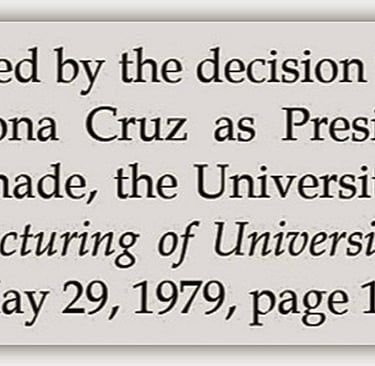
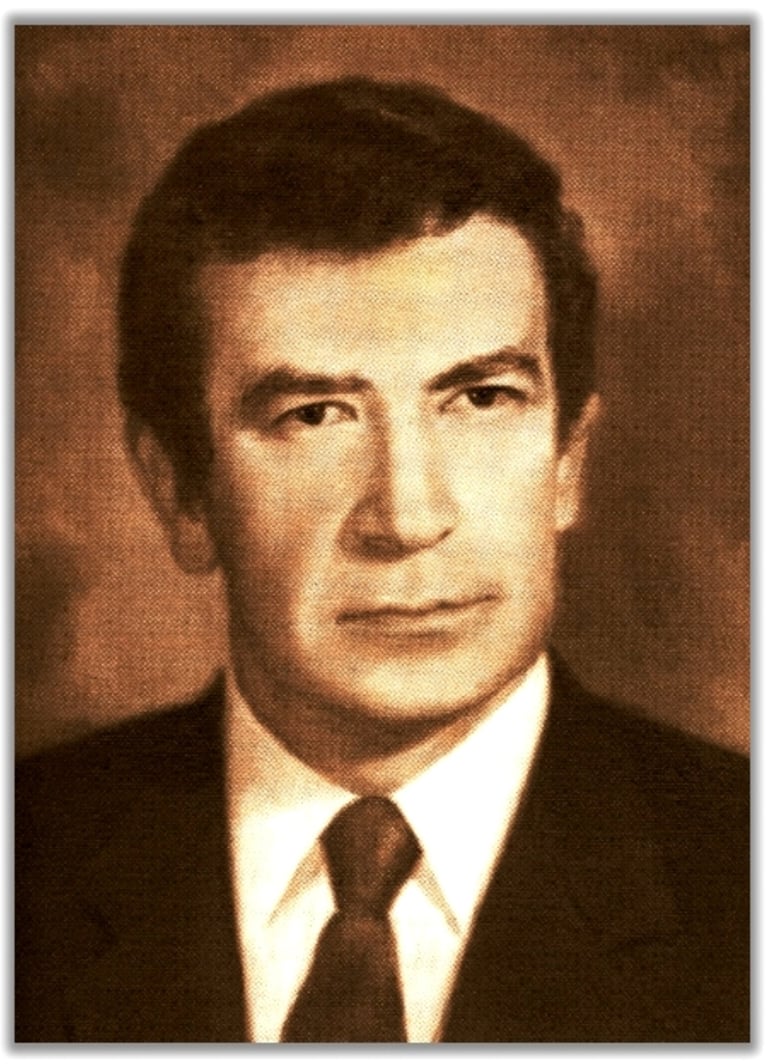

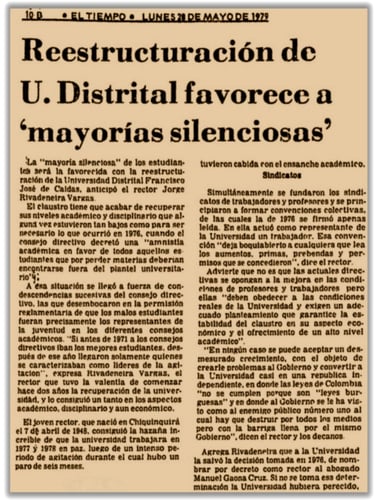



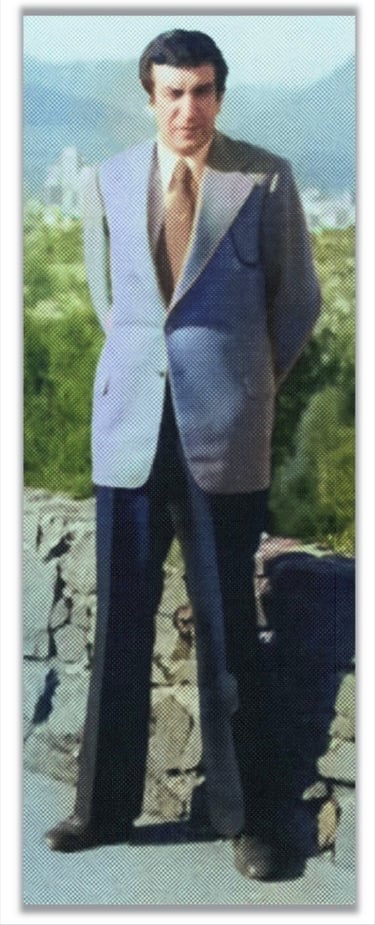

From a historical perspective, the lawsuit had three major effects on the Colombian constitutional system. First, the lawsuit served as a legal precedent and a historic opportunity for the Supreme Court of Justice to establish itself as the guarantor of the protection, integrity and supremacy of the Constitution. In such process, the Court, through its decision of unenforceability and unconstitutionality, demarcated the scope of the constitutional powers of the other two branches of public power in relation to the Court's primary function: to ensure the preservation of the Colombian constitutional system.
In the meantime, the Minister of Justice, Felio Andrade Manrique, announced the publication of Legislative Decree No. 3050 of 1979, which sought to nullify the Court's declaration of unconstitutionality and modify the voting system of the Constitutional Chamber. The reaction against the government's decree ("el decretazo") was immediate. Several constitutionalists of the time described the decree as "an attack on the rule of law" (Ismael Enrique Arenas, "Ilegal, el Decreto 3050," EL TIEMPO, November 10, 1980). The decree sparked a heated debate within the Congress of the Republic, where several congressmen spoke out to defend the Court's decision of unconstitutionality. In his speech, Senator and former Minister of Government Carlos Augusto Noriega summarized the actions of Minister of Justice Felio Andrade Manrique and the government of the time in the following terms:
In the midst of the debate, and just a few minutes after his first insinuation, Senator José Vicente Sánchez asked to speak in order to read a message from the leader of the opposition party at the time (the Conservative Party), former President Misael Pastrana Borrero. This message unambiguously refuted Minister Andrade's insinuation:
To prove the supposed lack of objectivity of Justice Manuel Gaona Cruz regarding the '79 reform and his criticisms of the government's Decree No. 3050, Secretary Andrade's son recorded a constitutional law class taught by Professor Gaona at the Universidad Externado (See Rubén Ordóñez Ortega, RODRIGO LARA: UN ACERCAMIENTO A SU VIDA, Figueroa Rojas Impresiones, 2005) páginas 140-141). In the recording, the professor, after a historical overview of the Separation of Powers and the role of the Supreme Court of Justice vis-a-vis the integrity of the rule of law, described the government's decision to reform the Constitution via decree and thereby to limit the Court's constitutional control as a disproportionate reaction alien to any democratic system. In that historical context, Professor Gaona warned, there would be no difference between President Turbay and General Landazábal. Judges must remain independent of political influence; such a guarantee is necessary to ensure the separation of public powers. “A closed Court is better than a submissive Court,” Professor Gaona affirmed. The defense of the Justice and the independence of the Supreme Court before Congress was led by Senators Jaime Vidal Perdomo, Luis Carlos Galán Sarmiento, Rodrigo Lara Bonilla, Guillermo Benavides Melo, and Rafael Caicedo Espinosa, who left their position on record in a written statement during the debate on the Fall of the '79 Reform, calling the government's attitude toward the Court an: "improper executive interference with the Court" (See "Acalorado debate en el Senado sobre la caída de la Reforma," EL TIEMPO, November 4, 1981, page 10-A).
The last of the three insinuations made by Secretary Andrade, according to which the modification introduced by the decree referred to the full Court and not to the Constitutional Chamber, was refuted a week later by the Council of State of Colombia in a ruling that declared Decree 3050 null and void. The council qualified its illegality as an administrative act that violated the National Constitution.
The lawsuit and the fall of the 1979 Constitution, along with the nullification of the administrative act that attempted to uphold it, remain in the annals of Colombian jurisprudence. The defense of the constitutional principle of Separation of Powers and Supremacy of the Constitution that led to the downfall of the 1979 Constitution transcended not only as constitutional doctrine in Colombia but also as a doctrinal and jurisprudential precedent in other countries (See Marisol Peña Torres, “La Caída de la Reforma Constitucional de 1979”, REVISTA CHILENA DE DERECHO, 1983, Vol. 10, pages 231-242).

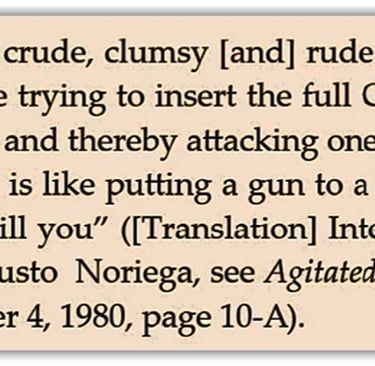

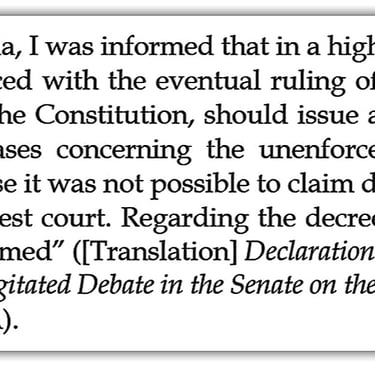

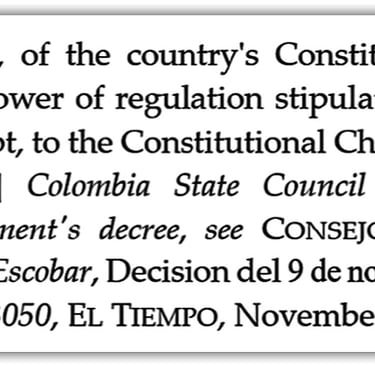
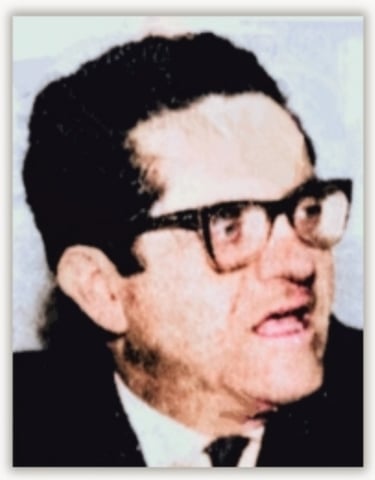

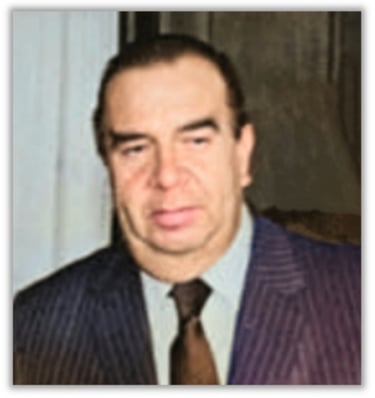

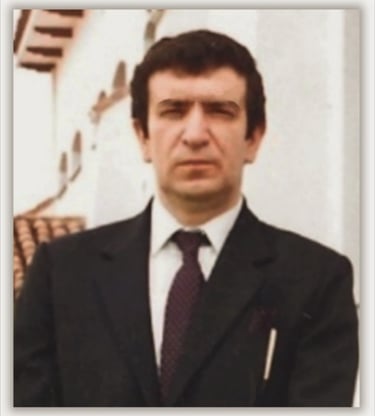

In his capacity as the plaintiff against Act No. 1 of 1979, and considering, on the one hand, that the study of the constitutionality of the 1979 Reform was the responsibility of the Constitutional Chamber of the Court, and on the other hand, that by the time the case file reached the Chamber (November 1980), Manuel Gaona Cruz was already a magistrate of the Court and a member of that Chamber, the newly elected magistrate declared himself incompetent to hear the lawsuit. The Court then appointed an ad hoc judge to replace him.
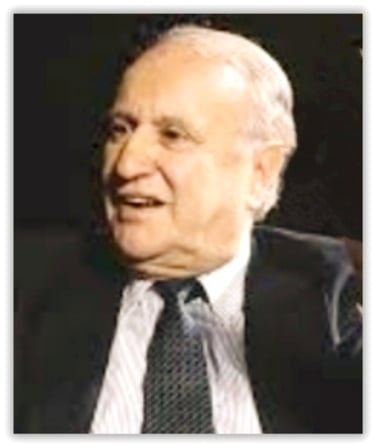

Misael Pastrana Borrero President of Colombia 1970 – 1974
Despite the fall of the 1979 Constitution and the historic defeat of his Minister of Justice and his government after the rulings of unenforceability from the Supreme Court of Justice and nullity from the Council of State, President of the Republic Julio Cesar Turbay Ayala recognized the defeat as “a triumph for democracy,” stating that:
Julio Cesar Turbay Ayala President of Colombia 1978 – 1982
Felio Andrade Manrique Secretary of Justice 1980 – 1982
Carlos Augusto Noriega Senator and former Secretary of Interior 1981

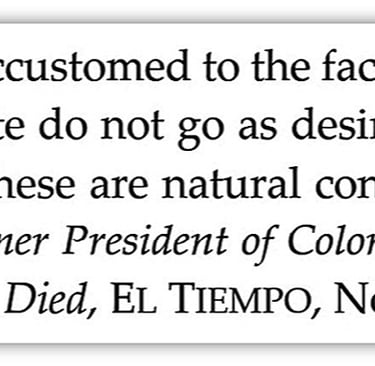
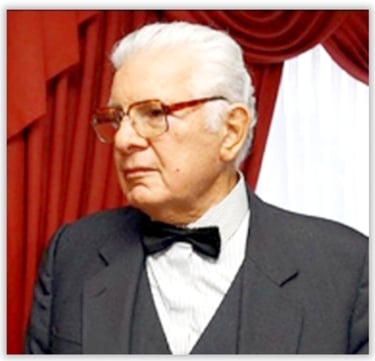

Manuel Gaona Cruz Under-Secretary of Justice
Colombia Under-Secretary of Justice's request before the U.S. Departments of State and Justice Washington, D.C., 1978.
Manuel Gaona Cruz University President and Professor
Manuel Gaona Cruz Constitutional Law Attorney
Third, given the procedural failures alleged by the plaintiffs—in particular, the approval of the reform in the first round without the participation of minorities "precisely so that it would not be criticized" (See CSJ, Unconstitutionality of the 1979 Reform, ibídem, page 13) —the fall of the 1979 Constitution has become constitutional doctrine and legal precedent to ensure, since its very occurrence, the respect for the democratic participation and representation of minorities in Colombia (See Manuel Gaona Cruz and Antonio José Cancino, La Caída de la Reforma Constitucional de 1979, Ed. TEMIS, 1981)). The parts of the complaint, reiterated by the Supreme Court in its legal review, reflect the undeniable value of its doctrinal and historical significance: “The violation of the principle of minority participation determined that the incriminated law was enacted against the Constitution” (Id., page 15; files 85 and following).
Manuel Gaona Cruz Justice of the Supreme Court of Colombia 1980 - 1985
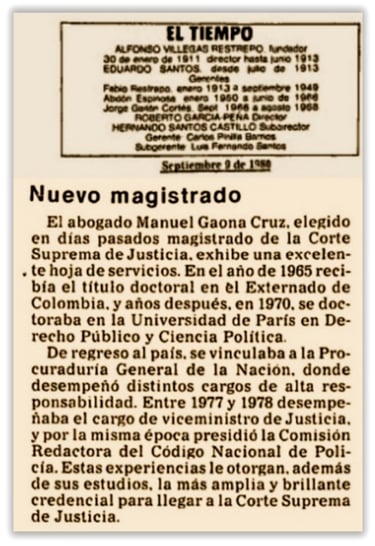

In relation to the right to the representation and constitutional protection of minorities in Colombia (CSJ, Dissenting Opinion by Justice Manuel Gaona Cruz, Judgment No. 6, File No. 993, February 10, 1983), Justice Manuel Gaona Cruz wrote:
Despite the political reactions and pressures that the fall of the 1979 Constitution produced, Manuel Gaona Cruzcontinued his work. During the half-decade he served on the Supreme Court of Justice, Manuel Gaona Cruz wrote and advanced several of the most influential judicial decisions in the Colombian legal and constitutional system.


Audio: Manuel Gaona Cruz
All rights reserved © J. Mauricio Gaona - Manuel Gaona Cruz Foundation - 2025.
The second (and most direct) effect of the trial was the downfall of the 1979 Constitution, approved by the Congress of the Republic and promoted by the Government of President Julio Cesar Turbay Ayala. This constitution contained a constitutional modification to the balance and distribution of public powers through structural changes to the powers of the legislative and judicial branches. The 74 articles that made up the 1979 Constitution sought to expand the Superior Council of the Judiciary, create the Attorney General's Office, and assign new judicial functions to the Senate, while limiting the constitutional powers of the Supreme Court in relation to the constitutional control it could exercise over government legislative decrees. The reform also modified the participation of minorities in the legislative process (composition of commissions, board of directors, voting system, etc.), the finance law, the national development plan, and the election systems for the Comptroller and the Attorney General.
In his capacity as the plaintiff against Act No. 1 of 1979, and considering, on the one hand, that the study of the constitutionality of the 1979 Reform was the responsibility of the Constitutional Chamber of the Court, and on the other hand, that by the time the case file reached the Chamber (November 1980), Manuel Gaona Cruz was already a magistrate of the Court and a member of that Chamber, the newly elected magistrate declared himself incompetent to hear the lawsuit. The Court then appointed an ad hoc judge to replace him.
To justify the government's action, Secretary of Justice Felio Andrade Manrique made three insinuations before Congress, which were quickly refuted as a prelude to the government's defeat and the declaration of nullity of Decree 3050. First, Secretary Andrade defended the decree by arguing that it was not only the result of government concerns but had also been agreed upon with the country's political leaders. Second, the Secretary suggested that the decree was necessary to counteract the attack on the legal and public order stemming from the lack of objectivity of the Justice of the Constitutional Chamber, Manuel Gaona Cruz, given his position as a plaintiff and because he had recently appeared in a Constitutional Law class to criticize the decree. And third, Secretary Andrade argued, the decree did not refer to the Court or the Constitutional Chamber but to the Supreme Court of Justice as a whole.
Secretary Andrade's attempt to get rid of Magistrate Gaona failed dramatically in a matter of hours. The next morning, after clarifying that Justice had Gaona recused himself from deciding on the lawsuit long ago, both Professor's and the Justice's voices converged in a masterful Constitutional Law lesson on the importance of the separation of public powers in modern democracies and the ethical and legal precedents supporting the distinction between the professor and the Justice. The interview ended with a resounding silence from the inquisitorial side and with the public support of the Chief Justice. After the interview and upon arriving at Externado University to teach as usual his Constitutional Law course, Professor Gaona found hundreds of students waiting for him on the stairs. Manuel Gaona Cruz couldn't even reach the classroom when, upon seeing him, a crowd of students lifted him onto their shoulders while chanting his name down the hallway of the law school to the main auditorium of the Externado University, where professors, officials, and hundreds of students were waiting to show their support. The surprise and emotion were overwhelming for Professor Gaona, who could barely express, his voice choked up, again and again: “Thank you very much, thank you all.” To commemorate the event and their professor's teachings, the graduates of the law school of Externado University of 1980 adopted the name “Class of Manuel Gaona Cruz.”
In addition to his academic background and prestige, the election of Manuel Gaona Cruz as a Justice of the Constitutional Chamber was due, in part, to his unwavering public defense of preserving the separation of powers and protecting the independence of the judicial branch. It was also due to his commitment to ensuring the constitutional representation of minorities in the legislative process and to keeping the guardianship and integrity of the Constitution in the hands of the Supreme Court of Justice.
Internationally, his theses on Latin American presidentialism and comprehensive and parallel constitutional controlin Colombia—which Professor Gaona categorized as "the most complete in the West and, therefore, in the world"(Manuel Gaona Cruz, Control y Reforma de la Constitución en Colombia, MINISTERIO DE JUSTICIA 1988, Volume II, page 72)—became doctrinal references in Comparative Constitutional Law (See Julio Cesar Ortiz, "El Control Constitucional en Colombia," BOLETÍN MEXICANO DE DERECHO COMPARADO, Universidad Autónoma de México UNAM, No. 71, 1991, pages 481-516). In Colombia, several of Manuel Gaona Cruz's rulings and theses were adopted into the 1991 Political Constitution and have transcended over time as constitutional doctrine applicable in dozens of conflicts and circumstances. The legal devotion of his work denotes his social vocation and the rigor of his constitutional judgment. Among these provisions, the following remain as judicial maxims of his legacy:

DEATH
THE ASSASSINATION OF JUSTICE MANUEL GAONA CRUZ: A CRIME AGAINST HUMANITY
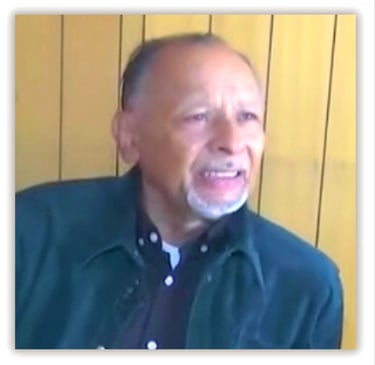

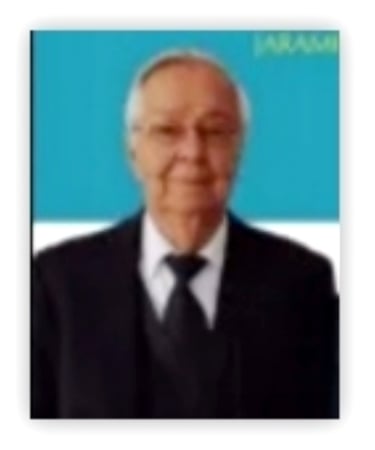

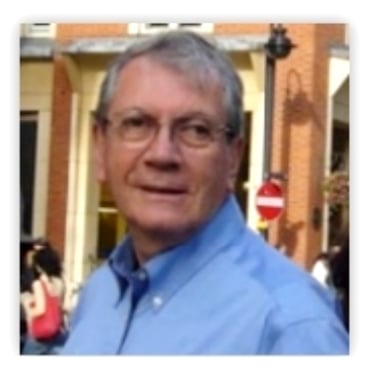

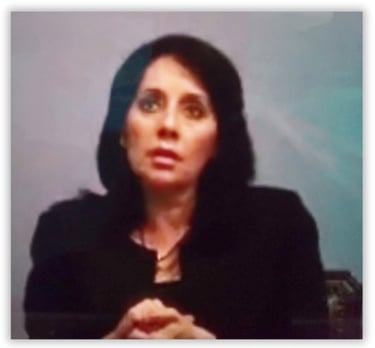

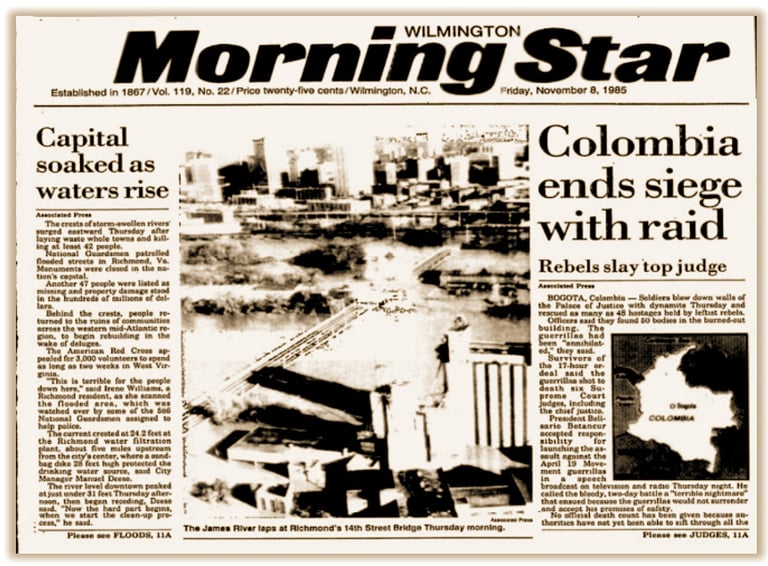

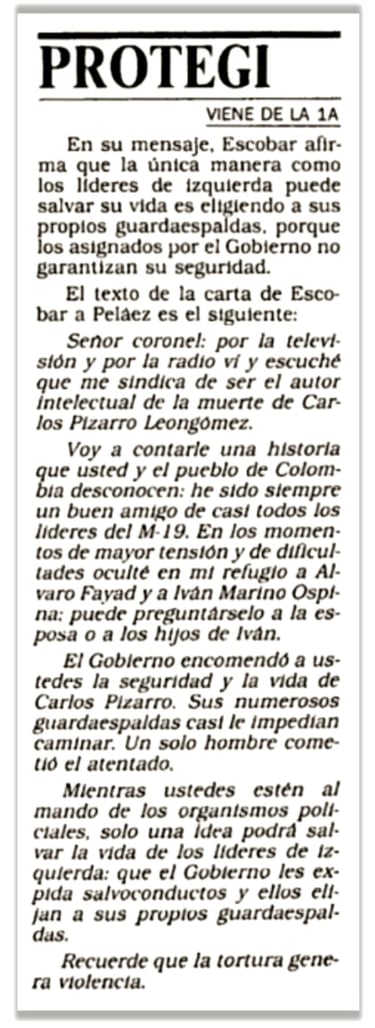

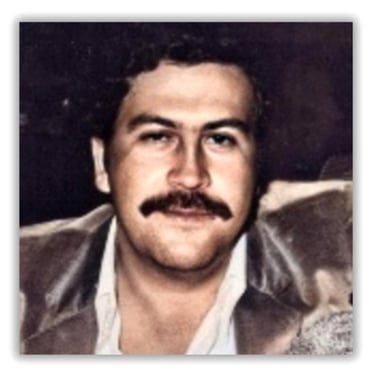

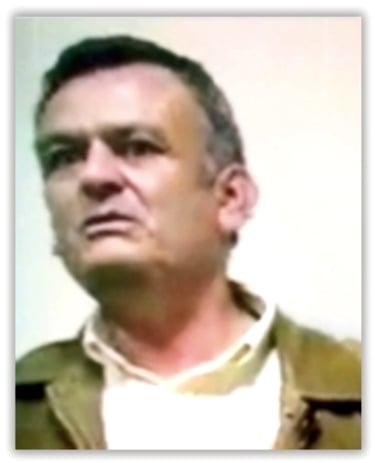

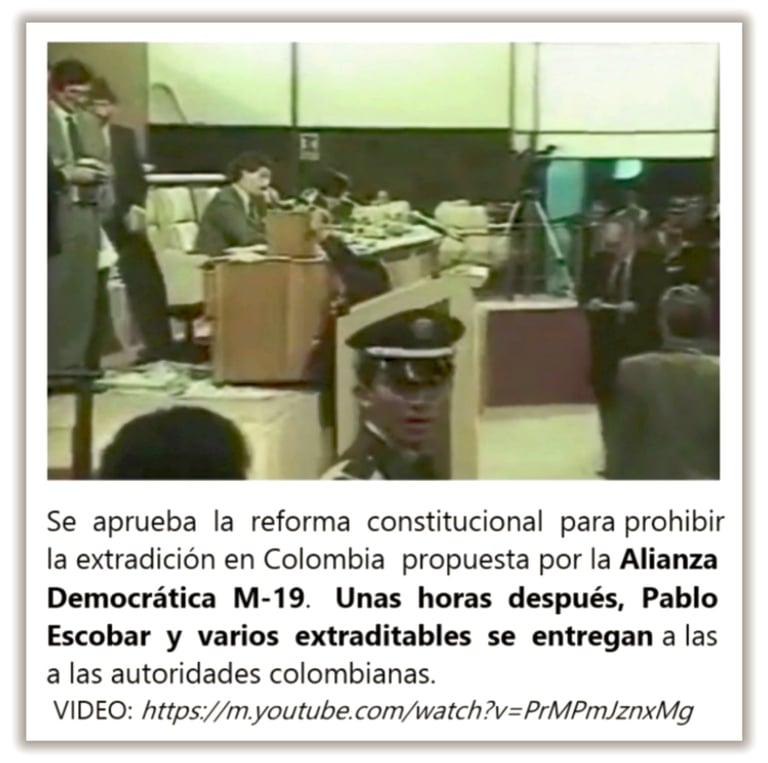

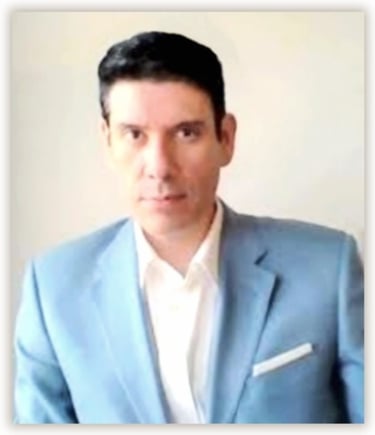


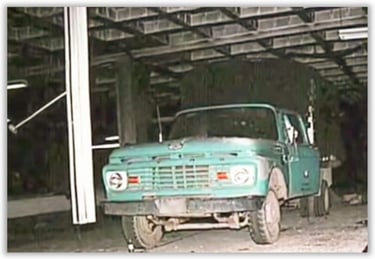

I. ATTACK ON THE PALACE OF JUSTICE

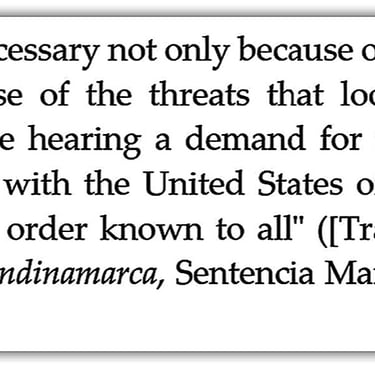
II. SECURITY FAILURES AND CIVIL RESISTANCE TO THE ATTACK
State Council, Third Division, Upholding Sentence against the State for Egregious Security Failures Sentences No. 9276 (August, 19, 1994), 9459 (April 3, 1995), 11798 (December 2, 1996).
III. THE KIDNAPPING OF JUSTICE MANUEL GAONA CRUZ
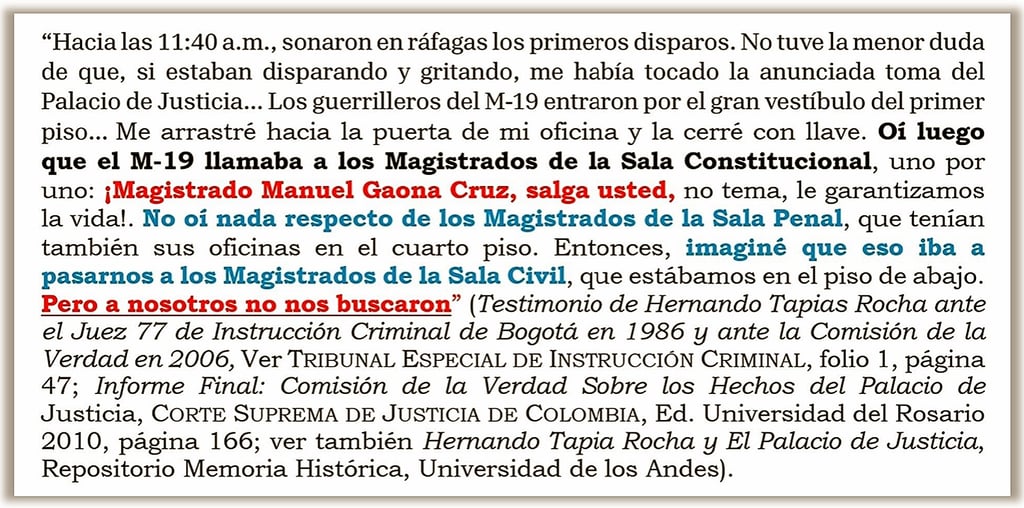

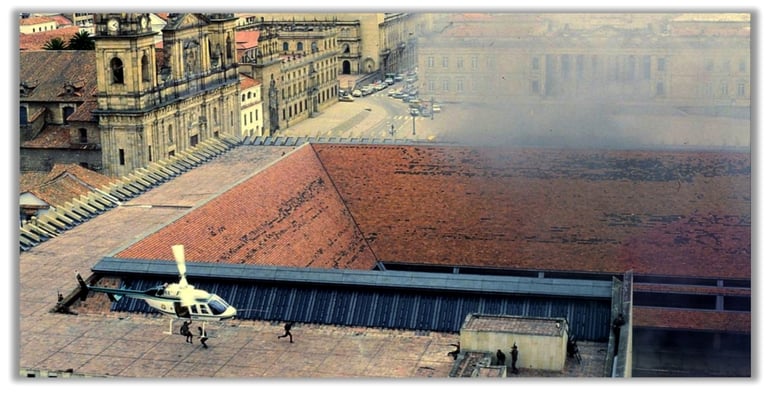

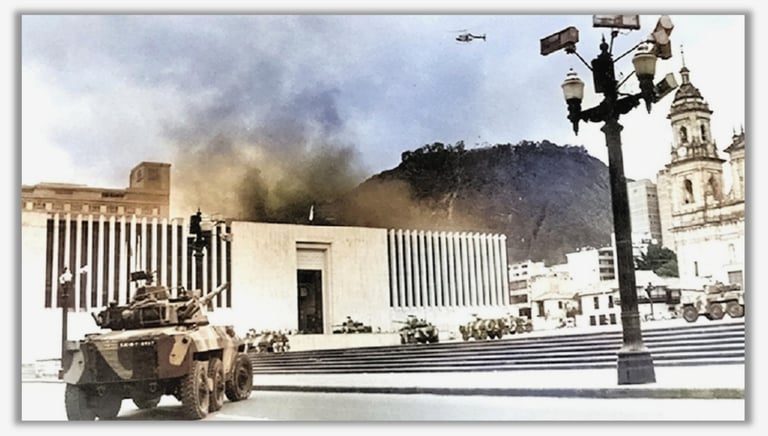

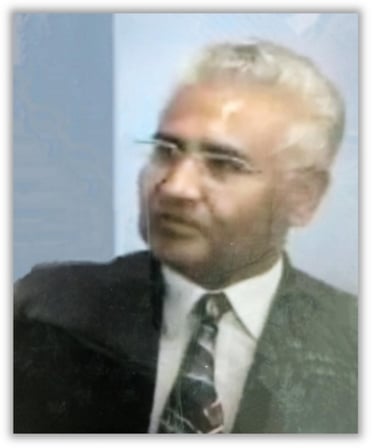

Considering, on one hand, the institutional position he held (former Chief Justice of the Constitutional Chamber and Supreme Court Justice), the legal position he supported (Justice delivering the opinion of the Court and author of the intermediate thesis that prevented the declaration of unconstitutionality of the law approving the Extradition Treaty), the circumstances that preceded his kidnapping (Justice was presenting his opinion in the day and hour of the attack), the human rights violations and the crimes against humanity he was subjected to (See MGC Death – Investigations and Responsibilities), as well as the cowardly, inhumane, atrocious, and cruel manner in which the M-19 guerrilla assassinated him (shot in the back with shots to the head after he refused to go out into the crossfire and serve as a human shield for the guerrillas who were shouting at him and pointing while Magistrate Gaona in his last words replied, “!No! We are not leaving like this. I'm not moving from here”), only to then toss his body out for the Army to see (See MGC Death – Forensic Reconstruction of the Crime Scene) and considering, on the other hand, the Army's indifference to Magistrate Gaona's request for a ceasefire and the constitutional and moral abandonment by the Government of President Belisario Betancur Cuartas, coupled with the terror instigated by Pablo Escobar in those who dared to investigate him and the need of the Government of President Barco to demobilize the M-19 guerrilla whose interests were strategically aligned with those of drug trafficking regarding extradition (See MGC Death – Documentary Evidence – Motive and Planning of the Crime: Pablo Escobar, the Extraditables and the M-19), the assassination of Justice Manuel Gaona Cruz at the hands of the M-19 became one of the most inconvenient crimes in Colombian history.
To begin with, the crime of Justice Manuel Gaona Cruz proved highly inconvenient for the Supreme Court of Justice of 1986, which, intimidated and threatened, finally acceded to the demands of Pablo Escobar and the Extraditables by declaring the law approving the Extradition Treaty between Colombia and the United States unconstitutional due to procedural defects, thereby reversing the jurisprudence, legal position, and work of the Constitutional Chamber Magistrates who had been murdered only twelve months earlier while defending that very position on the day and time of the M-19 guerrilla attack on the Palace of Justice (See Fabio Castillo, Los Jinetes de la Cocaína, EDP 1987, page 71; see also CSJ, Presiding Magistrate Jairo E. Duque, Judgment No. 111, December 12, 1986; Declaration of the United States Ambassador to Colombia Charles Anthony Gillespie Jr. on Pablo Escobar and the siege of the Palace of Justice in Pablo Escobar and the Siege of Colombia's Palace of Justice, ASSOCIATION FOR DIPLOMATIC STUDIES AND TRAINING (ADST), 1995 [File: Diplomatic History of the United States - Kidnapping and Terrorism], LIBRARY OF CONGRESS OF THE UNITED STATES OF AMERICA, page 600, https://www.loc.gov/item/mfdipbib000420). Secondly, the public memory of the crime of Manuel Gaona Cruz was especially inconvenient for the Governments of Virgilio Barco Vargas and Cesar Gaviria Trujillo, who faced a very difficult public order situation due to the need to demobilize the M-19 guerrilla and stop the murders of thousands of police officers, judges, magistrates, prosecutors, journalists, ministers, and presidential candidates at the hands of Pablo Escobar and the Extraditables. After all, the reports from the national and international press detailing the circumstances of Magistrate Gaona's crime at the hands of the M-19 guerrilla (See MGC Death – Documentary Evidence: National and International Press Reports) were followed by several eyewitnesses (José Gabriel Salom Beltrán, Hernando Tapias Rocha, Jorge Antonio Reina Orejuela, Carmen Elisa Mora, Nemesio Camacho Rodríguez, Helena Gutiérrez Romero, Betty Quintero González, José William Ortiz).
Given the physical, technical and legal impossibility of even recreating the execution of Justice Manuel Gaona Cruz by the Army inside the bathroom where he was held hostage by the M-19 guerrillas ("the magic bullet hypothesis"), the only remaining option to deny the crime of Manuel Gaona Cruz at the hands of the M-19 was to place Justice Gaona alive outside the Palace of Justice at all costs. Indeed, following the gradual ascent to power in Colombia of ex-commanders and ex-leaders of the M-19 guerrillas, rumors about the supposed exit alive and subsequent execution of Justice Gaona by the Army began to take shape. Placing the final hours of Manuel Gaona Cruz outside the Palace of Justice has been a primary objective for those who have benefited from the impunity of Manuel Gaona Cruz's crime, as well as for those who have tried by all means to erase from the nation's collective memory the criminal association between the M-19 guerrillas, Los Extraditables, and Pablo Escobar in the kidnapping and assassination of Justice Manuel Gaona Cruz.
(1) Hearsay Witnesses Never Appeared or Testified: There are no eyewitnesses who have declared before judicial authorities, meaning under oath, to having seen Manuel Gaona Cruz alive outside the Palace of Justice, as the eyewitnesses to the crime did. In the four decades that have passed since the Palace of Justice takeover, no witness has appeared or been identified who has declared before any authority—again, under oath and therefore subject to the criminal liability that derives from the crime of perjury—to having seen Manuel Gaona Cruz alive outside the Palace of Justice.
Among the eyewitnesses to the crime of Justice Manuel Gaona Cruz at the hands of the M-19 guerrillas were justices of the Supreme Court of Justice, auxiliary justices of the Court and the Council of State, drivers, secretaries, legal assistants, and administrative assistants. The following are the statements of the eyewitnesses, whose assertions were made under oath before judicial authorities—and therefore subject to the crime of perjury—and later repeated twenty years after the fact before the Truth Commission of the Supreme Court of Justice of Colombia (bold and colored text added). The credibility of the witnesses was never discredited by any national or foreign authority in the four decades that have passed since the crime. Their voices remain beyond their time.
RUMOR 2: The Hypothesis of Exiting the Palace of Justice Alive - The rumor suggests that Justice Gaona left the Palace of Justice alive, was then executed by the Army, and subsequently his body was returned to the building.
(3) The Results of the Investigations Conducted Do Not Support the Rumor: No investigation that has established as a proven and categorical fact (judicial rulings or resolutions) the exit of Justice Manuel Gaona Cruz from the Palace of Justice. In none of the six official investigations carried out regarding the Palace of Justice takeover (Truth Commission of the Supreme Court of Justice 2010, National Prosecutor General's Office 2008, Public Order Judge 1992, 30th Criminal Investigating Judge of Bogotá 1989, Special Tribunal for Criminal Investigation 1986, Attorney General's Office 1986, see MGC Deaths – Investigations) were rulings issued or was it established that Manuel Gaona Cruz had left the Palace of Justice alive.
The assassination of Manuel Gaona Cruz by the M-19 guerrilla group proved particularly inconvenient for the group's members and leaders, as well as for those closely associated with the organization whose judicial, political, economic, and bureaucratic interests strategically aligned with the rise to power of its members. The urgent and inseparable necessity to reconfigure the narratives and erase from the public memory of voters and new generations the accounts of the witnesses who, in 1985 and 1986, narrated to the media and authorities the atrocious execution of Supreme Court Justice Manuel Gaona Cruz at the hands of the M-19, along with the guerrilla group's ties to drug trafficking, became the primary objective for those who benefited most from narratives that served their interests and promoted impunity for the crime despite the witnesses and investigations (See MGC Death – Testimonial Evidence; see also MGC Death – Investigations). Eventually, given the grave human rights violations and the crime against humanity committed, various interests and causes converged to erase the atrocious crime of Manuel Gaona Cruz by the M-19 guerrilla and at the behest of Pablo Escobar from the historical memory of Colombians; these reasons included: (i) cleaning up the image of M-19 members, who today present themselves as victims of the Palace of Justice incident, thus justifying bureaucratic and political connections ("the guerrilla was a victim of an ambush by the State," see John Bernal, Petro Dio Su Versión Sobre Toma del Palacio de Justicia, INFOBAE, November 5, 2024), (ii) placing Constitutional Chamber Justice Manuel Gaona Cruz in a situation similar to that of the disappeared to gain public exposure in certain cases and promote judicial interests, (iii) distancing the M-19 and its members from Pablo Escobar and drug trafficking, and (iv) promoting political, bureaucratic, and economic interests by enabling the ascent to power of the members of the terrorist organization, who achieved the highest offices in the State.
(5) Details of Justice Gaona's Assassination Were Widely Known to the Public and Reported by National and International Press: The crime of Justice Manuel Gaona Cruz at the hands of the M-19 guerrilla was the first to be known and reported in Colombia and the world. Just one hour after the 1985 Palace of Justice takeover ended, the details of Justice Gaona's crime were reported in the national and international press by eyewitnesses to the crime, while they were still in a state of shock. Unlike the supposed hearsay witnesses whose sworn statements never appeared, the half-dozen eyewitnesses to Justice Gaona's homicide provided specific details regarding the circumstances of the manner, time, and place (See MGC Muerte – Pruebas Documentales: Reportes de Prensa Nacional e Internacional).
A. TESTIMONIAL EVIDENCE
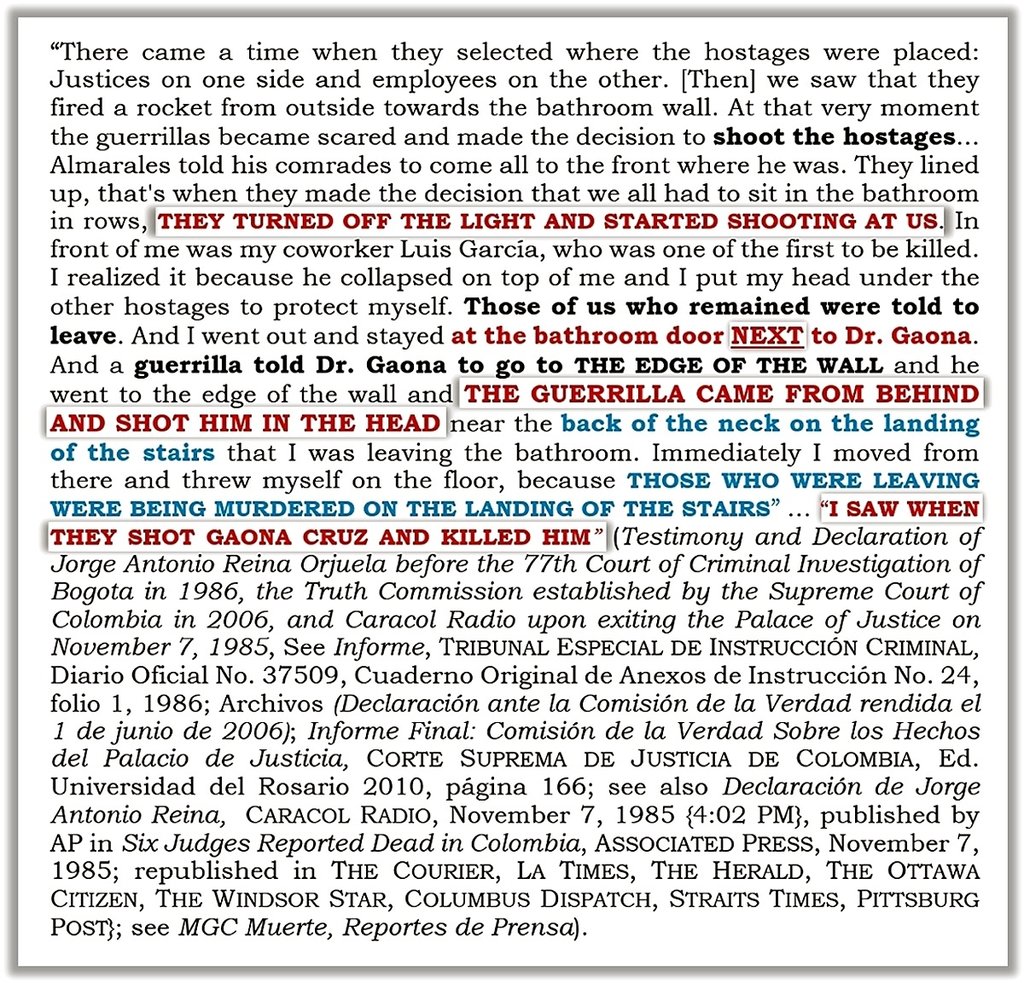

José Gabriel Salom Beltrán Auxiliary Magistrate State Council of Colombia
2. JUSTICE MANUEL GAONA CRUZ'S OPINIONS ON THE CONSTITUTIONALITY OF THE EXTRADITION TREATY
Nemesio Camacho Rodríguez Justice of the Labor Chamber Supreme Court of Colombia
Jorge Antonio Reina Orjuela Official Driver Supreme Court of Justice
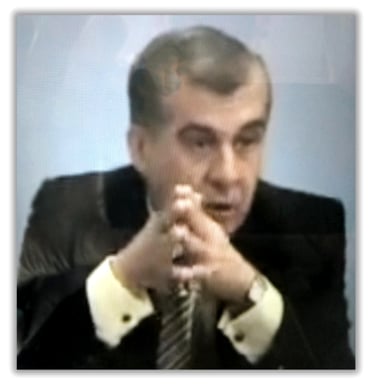

Beatriz Quintero González
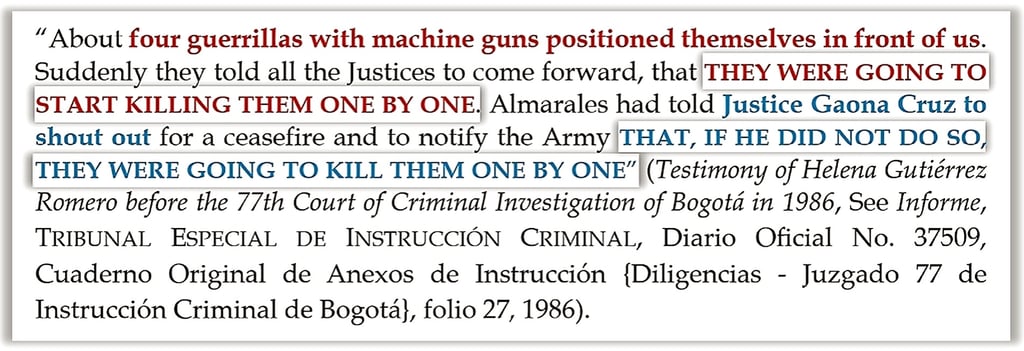

Helena Gutiérrez Romero
IV. THE ASSASSINATION OF JUSTICE MANUEL GAONA CRUZ
(4) The Credibility of Eyewitnesses to the Homicide of Manuel Gaona Cruz Was Never Discredited by Any National or Foreign Authority: The credibility of the eyewitnesses who testified about the kidnapping, mistreatment, execution, and subsequent murder of Justice Manuel Gaona Cruz inside the Palace of Justice at the hands of the M-19 guerrilla has not been discredited by any national or foreign authority; in fact, several witnesses ratified their statements 20 years later before the Truth Commission created by the Supreme Court of Justice of Colombia, and the eyewitnesses to Justice Gaona's crime include people of different sex, age, and position (See MGC Death – Testimonial Evidence), including Supreme Court Justices Hernando Tapias Rocha, Nemesio Camacho Rodríguez, and Humberto Murcia Ballén, Auxiliary Magistrate of the Council of State José Gabriel Salom Beltrán, Civil Chamber driver Jorge Antonio Reina Orjuela, and secretary Amanda Leal de Gallego, along with confirming witnesses (Justice Nemesio Camacho Rodríguez's secretary, Lucía Bermúdez de Sánchez), and those who testified about the mistreatment and death threats from guerrilla leader Almarales against Justice Gaona Cruz minutes before his execution (Carmen Elisa Mora Nieto, José William Ortiz, Helena Gutiérrez Romero); it must be mentioned, however, that a critique outside judicial venues of the credibility of the eyewitnesses to Justice Manuel Gaona Cruz's crime was made by renowned columnist and professor at the Universidad Externado de Colombia, Ramiro Bejarano Guzmán, who, in a column titled ¿Quién Asesinó a Manuel Gaona? (Who Killed Manuel Gaona?), wrote: "The version that Gaona was riddled with bullets by a guerrilla, suggested without firmness by some testimonies, loses more strength every day. Ignored evidence suggests he did leave alive, but was ultimately killed by a coup de grâce to the forehead, and his corpse returned to the ruins of the Palace" (See Ramiro Bejarano Guzmán, ¿Quién Asesinó a Manuel Gaona?, EL ESPECTADOR, November 14, 2009); the professor also indicated in his column that guerrilla leader Almarales had also supposedly left the Palace of Justice alive: "of whom it is also said he left the Palace alive." Nevertheless, after four decades, the evidence supports the accounts of the crime's eyewitnesses, given that: (i) Manuel Gaona Cruz did not receive a "coup de grâce," but three shots, (ii) none of the three shots that ended the Justice's life was to the forehead, as the entry wounds are located on the right nape, left temple, and right shoulder (See Protocolo de Necropsia de Manuel Gaona Cruz No. 3778/85, DIRECCIÓN GENERAL DE MEDICINA LEGAL, Internal Ballistic Registration No. 974-85-DC-FLB; see also Ballistic Trajectory Study No. X-1-2025 and X-2-2025 in MGC Death – Experts Evidence), (iii) there is no evidence regarding the circumstances of the manner, time and place of Justice Manuel Gaona Cruz's alleged exit, execution by the Army, and return of his corpse to the Palace of Justice, especially when, among the five witnesses who saw his execution, one of them was holding Justice Manuel Gaona Cruz's hand at the moment the guerrillas shot them and was under the Justice's lifeless body for about an hour on the bathroom staircase landing—and when, additionally, three witnesses saw the lifeless body and described the fatal wounds of Justice Gaona in detail before they left the Palace of Justice (See MGC Death – Forensic Reconstruction of the Crime Scene; see also Testimonial Evidence), (iv) Justice Manuel Gaona Cruz had filed a criminal complaint against Los Extraditables for death threats three days before the takeover, (v) his wife, children, and home were surrounded 24 hours a day by DAS escorts and members of the National Police, (vi) Justice Gaona had told his children and wife two days before the takeover that Pablo Escobar wanted to assassinate him, (vii) Manuel Gaona Cruz was the author of the intermediate thesis that prevented the declaration of unconstitutionality of the Law Approving the Extradition Treaty between Colombia and the United States between 1982 and 1985 or, in the words of the Medellín Drug Cartel, "the brain of extradition," which motivated the death threats and the declaration of war that Manuel Gaona Cruz received from Los Extraditables, (viii) Manuel Gaona Cruz was presenting and reading his extradition report when the M-19 guerrilla attacked the Palace of Justice and was the reporting Justice on the day and time when the fate of Pablo Escobar, the drug cartels in Colombia, and the future of the world's most profitable criminal organization was being decided on November 6, 1985, (ix) guerrilla leader Almarales threatened Justice Manuel Gaona Cruz with his weapon several times and in front of several witnesses (See MGC Death – Documental Evidence; see also Testimonial Evidence), (x) Auxiliary Magistrate of the Council of State Nicolás Pájaro Peñaranda, cited by some columnists as "the key witness," was not a key witness in any of the investigations related to Justice Manuel Gaona Cruz's crime, since Magistrate Pájaro could not testify to what he could not see and never saw, as he was not even close to the place where Manuel Gaona Cruz was at the moment of his execution by the M-19 guerrilla (See MGC Death – Forensic Reconstruction of the Crime Scene; see also MGC Muerte – Investigaciones), and (xi) the corpse removal procedure for Justice Manuel Gaona Cruz does not state that it was carried out at two in the morning, but at "2:00," meaning without specifying whether it was a.m. or p.m., because although it is true that the corpse removal procedure for Manuel Gaona Cruz took place on the first floor of the Palace of Justice—that is, in a different place from where he was executed (the staircase landing between the second and third floors)—it is also true that Manuel Gaona Cruz was not the only body that appeared on the first floor of the Palace of Justice and that the clothing described in the removal report matches in detail what the Justice wore when he left his house on Wednesday, November 6, which, incidentally, was removed after the corpse removal procedure and before the body was sent to Legal Medicine for the autopsy, and the inhumanity, indolence, and clumsiness with which the Army and the National Police acted at the time regarding the handling of the crime scene and the victims' remains were extensively documented by the Truth Commission in its Final Report of 2010 (See Diligencia de Levantamiento de Manuel Gaona Cruz, DIRECCIÓN GENERAL DE MEDICINA LEGAL, Record No. 1141, November 7, 1985; see also MGC Death – Experts Evidence and Investigations).
VII. RUMORS AND LIES ON JUSTICE GAONA'S ASSASSINATION
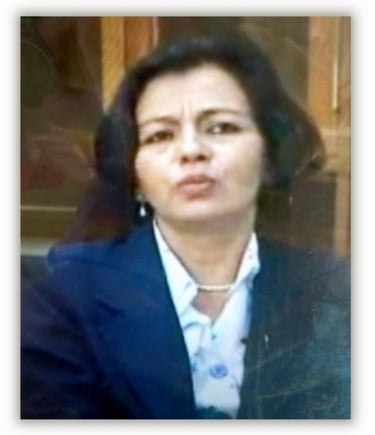

Carmen Elisa Mora Nieto Supreme Court of Justice
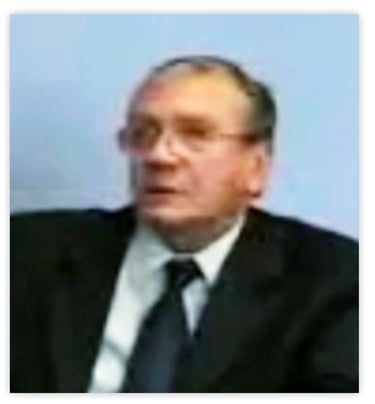

Hernando Tapias Rocha Justice of the Civil Chamber Supreme Court of Colombia

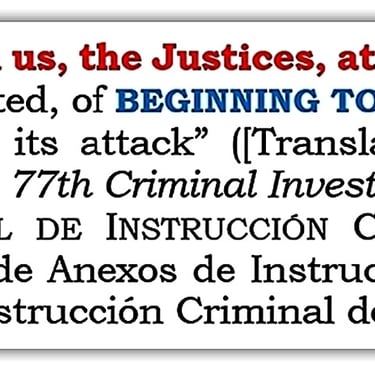
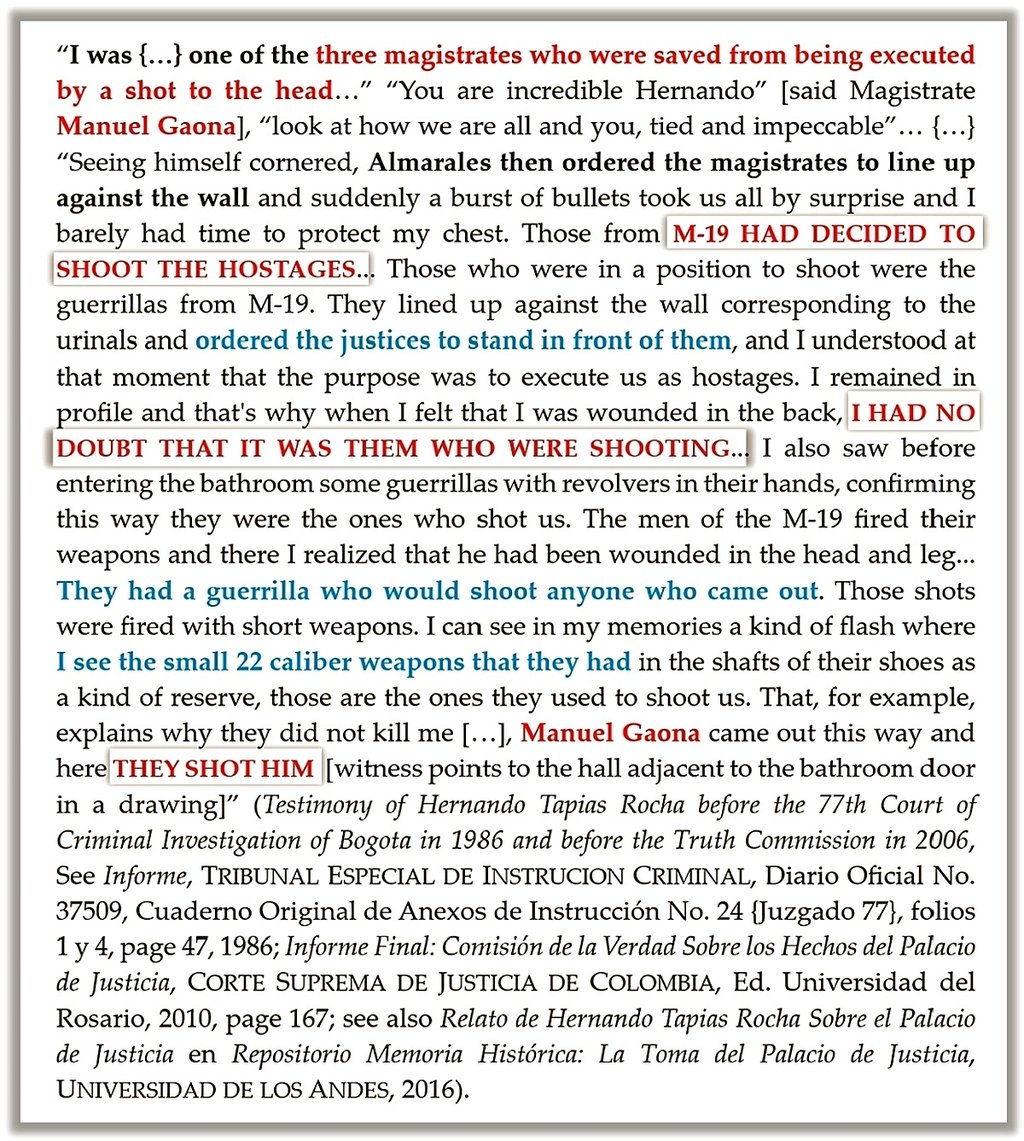

Samuel Buitrago Hurtado Magistrate State Council of Colombia
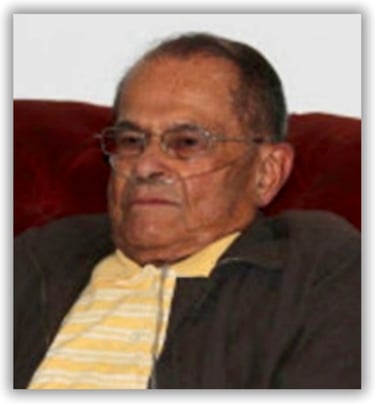

José William Ortiz Official Driver Supreme Court of Justice
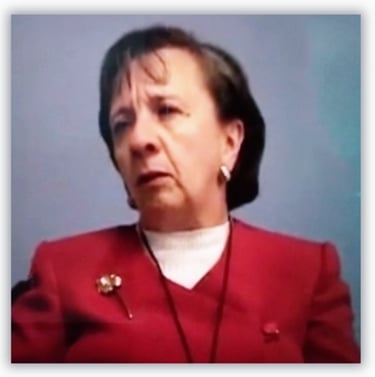

Amanda Leal de Gallego Secretary Supreme Court of Justice
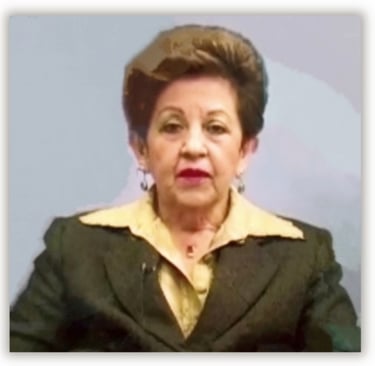

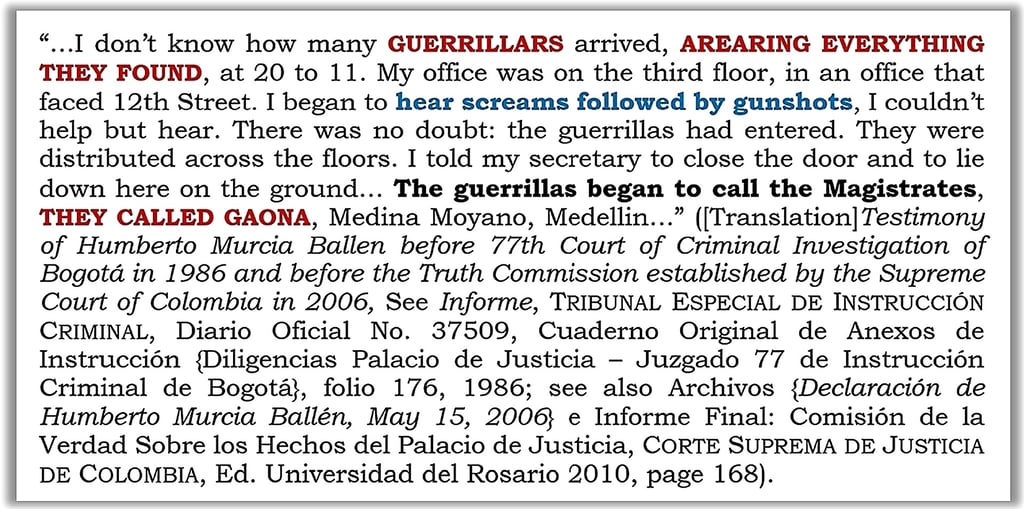

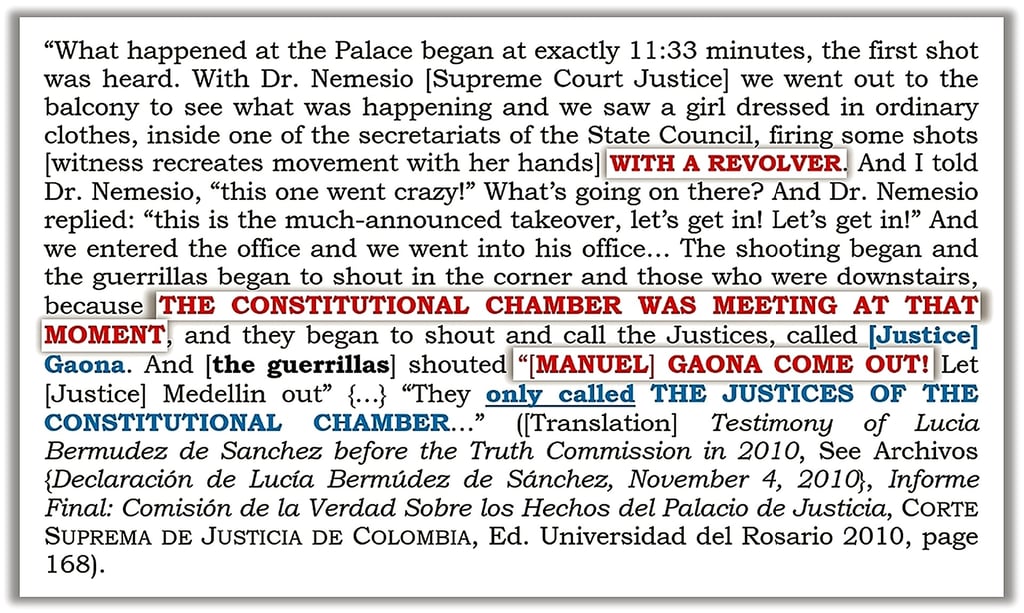

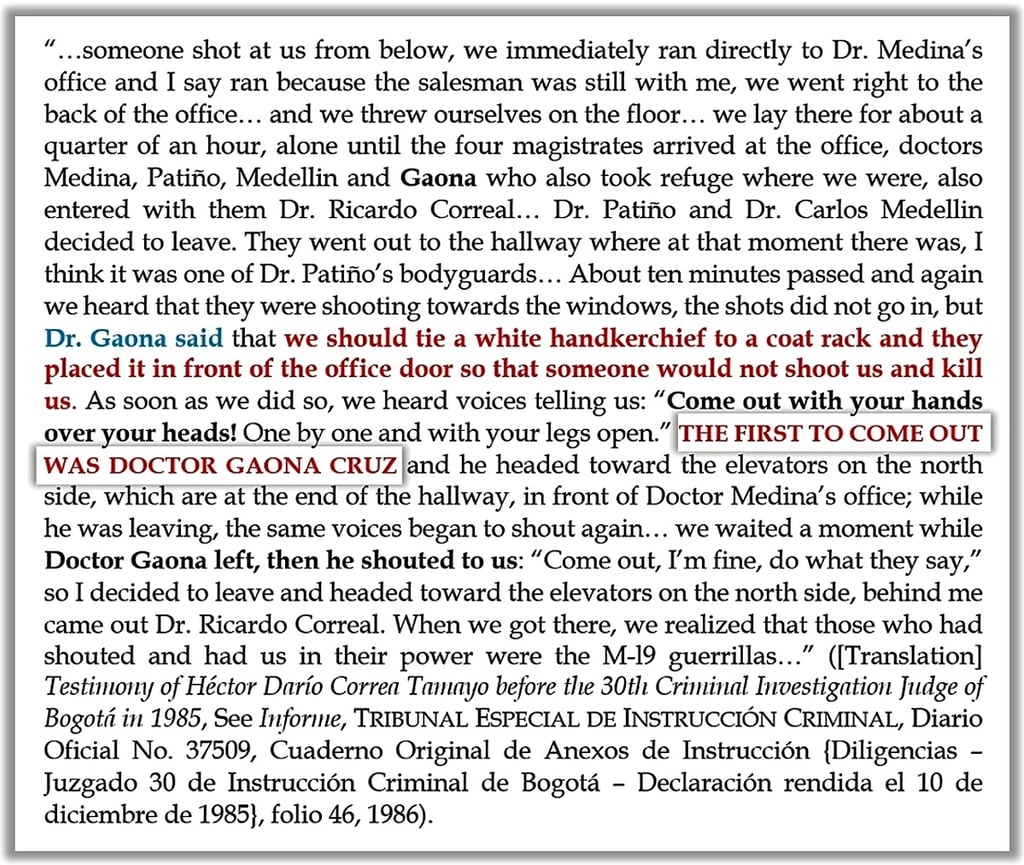

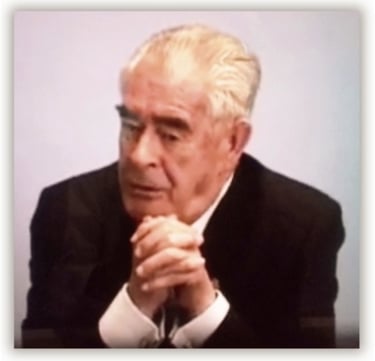

Humberto Murcia Ballén Justice of the Civil Chamber Supreme Court of Colombia
Ricardo Correal Morillo Clerk Constitutional Chamber Supreme Court of Colombia
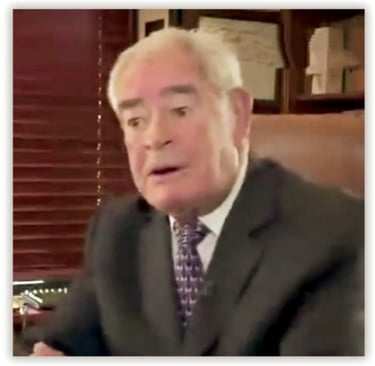



Marina de Gaona Justice Gaona's wife


Yamid Amat Journalist and News Director Caracol Radio 1985
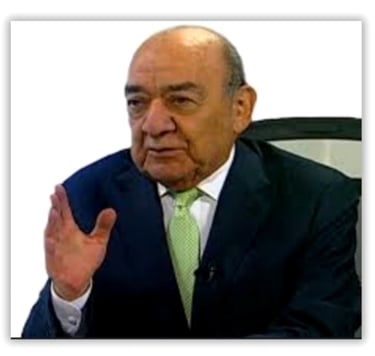

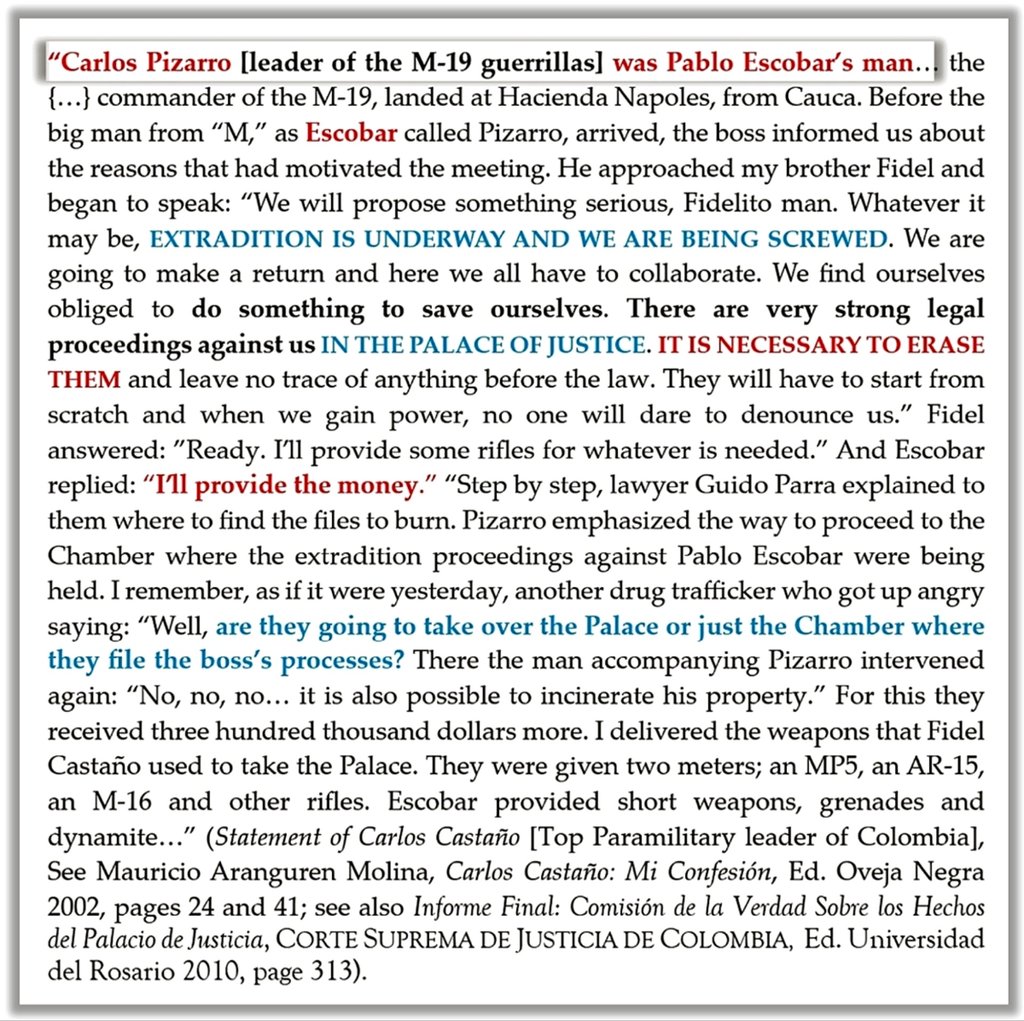

Carlos Castaño Leader Paramilitary Groups of Colombia (AUC)
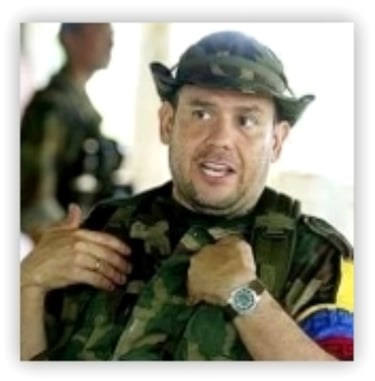

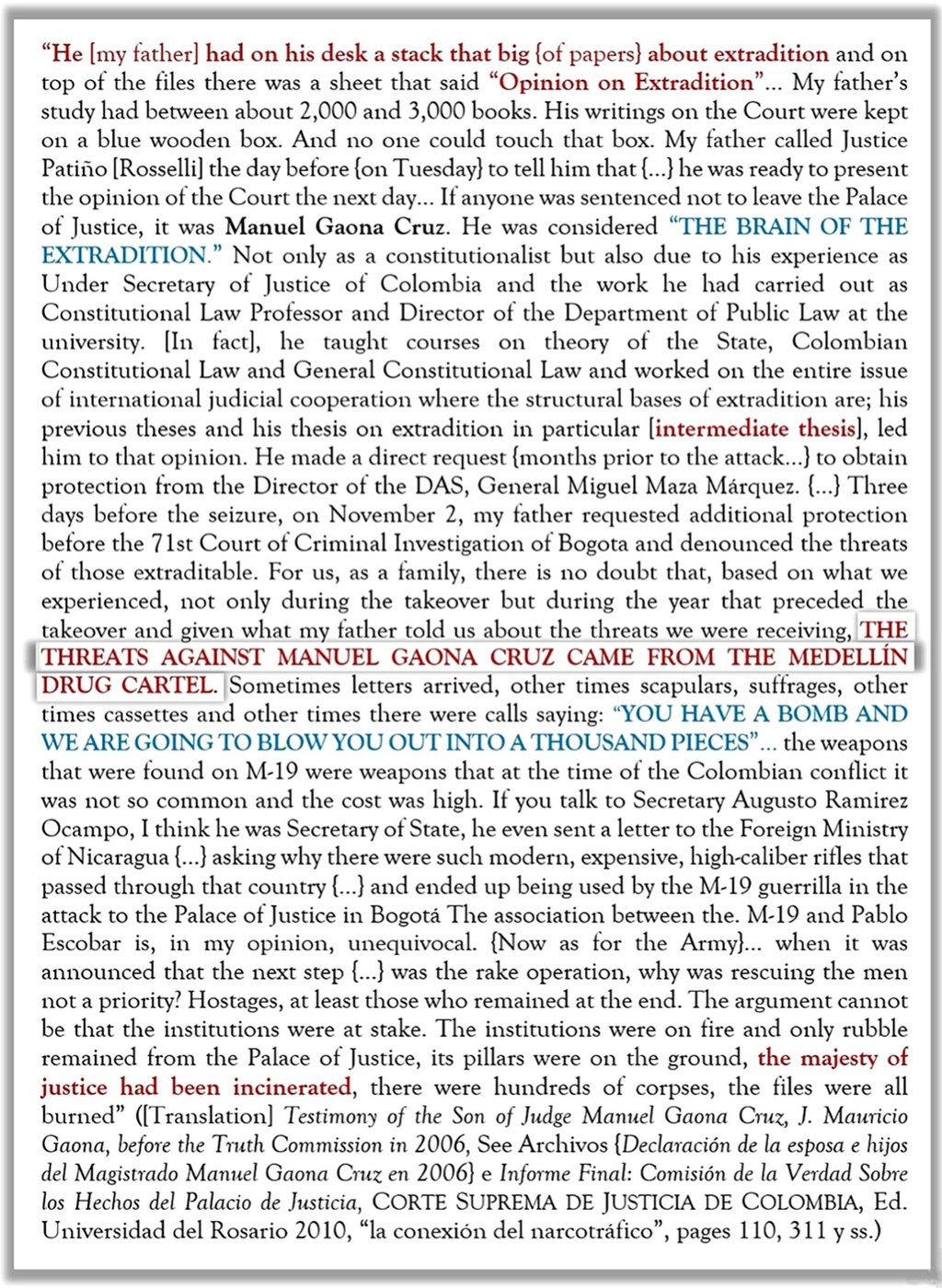

Fabio Castillo Writer and Journalist of El Espectador 1987
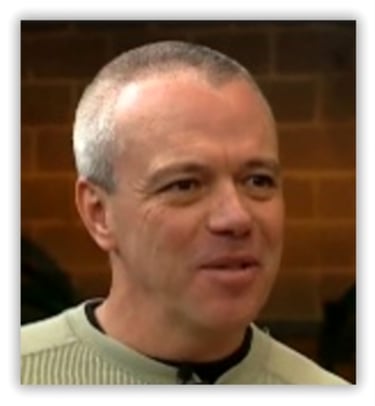


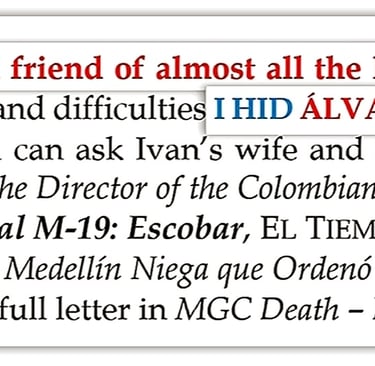
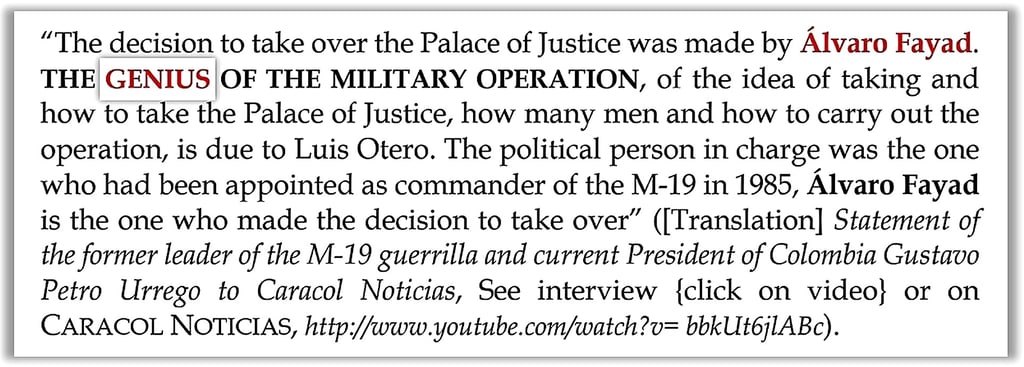

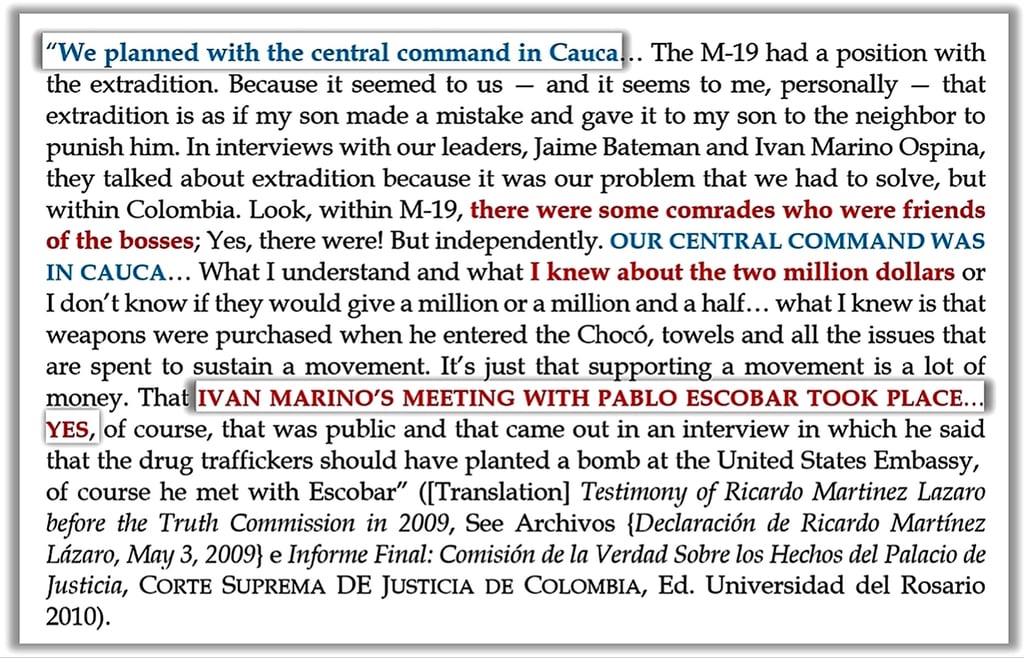

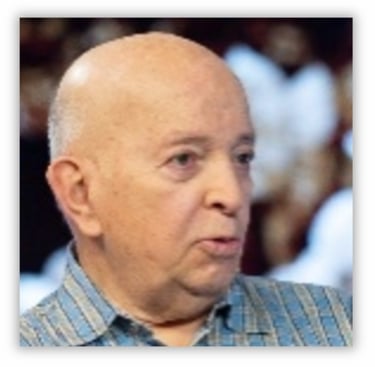


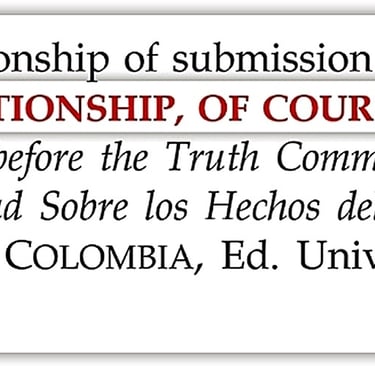
Pablo Escobar Gaviria Leader of the Medellin Drug Cartel and the Group the Extraditables
Gustavo Petro Urrego Former M-19 guerrilla leader and President de Colombia
Ricardo Martín Lázaro M-19 guerrilla
José Otty Patiño Hormaza Founding member of the M-19


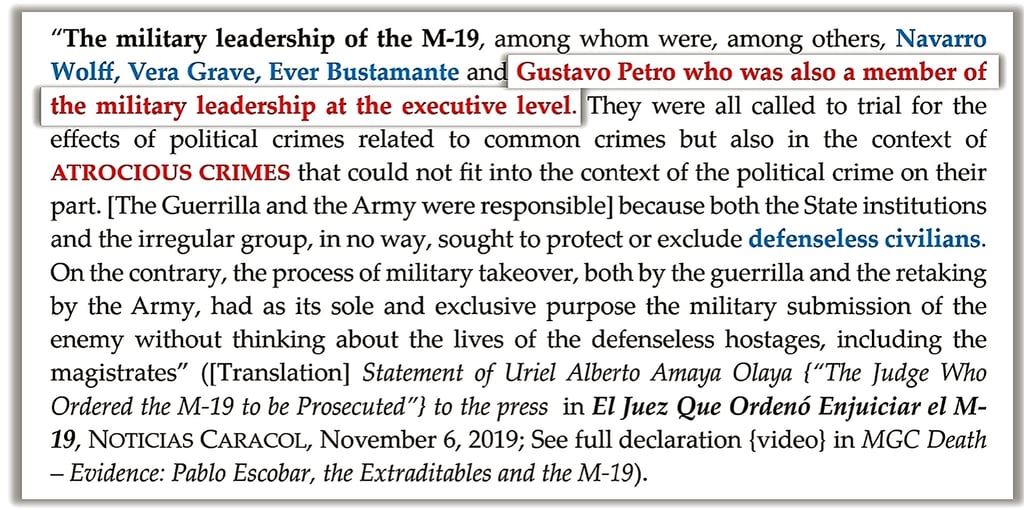

Uriel Alberto Amaya Olaya Judge 30th Criminal Instruction Court of Bogotá
Clemencia García de Useche Public Order Judge 1992
At 11:30 in the morning on Wednesday, November 6, 1985, a commando of 35 M-19 guerrillas entered the Supreme Court of Justice in a van and a truck loaded with weapons, ammunition, and explosives through the garage of the Palace of Justice in the city of Bogotá.
Due to threats from Pablo Escobar and the Medellín Cartel against the magistrates of the Constitutional Chamber of the Court, the Administrative Department of Security (DAS), in coordination with the National Police, had arranged a security detail for the magistrates and their families, which operated at their residences, during their commutes, and at the Palace of Justice. Both for his defense of the intermediate thesis (holding the extradition treaty approval law "constitutional") and for his role delivering the opinion of the Court with regard to the extradition treaty on the day and time of the siege and, more particularly, given that Pablo Escobar, acting through the "Extraditables" criminal syndicate, had made Manuel Gaona Cruz his "number one target" in his declaration of war (See Letter from Pablo Escobar and the Extraditables to Justice Gaona in MGC Death – Documentary Evidence), the then-Director of the National Security Department, General Miguel Maza Márquez, had arranged, in addition to the police officers who remained at the Justice's residence, between 5 and 7 bodyguards (which number varied depending on the shift and day of the week) to protect Justice Manuel Gaona Cruz and his family.
Despite rumors aimed at erasing the murder of Justice Manuel Gaona Cruz at the hands of the M-19 guerrillas from the public memory of the Palace of Justice (See MGC Death – Rumors About the Homicide of Manuel Gaona Cruz), the crime of Manuel Gaona Cruz is the most documented crime of the siege of the Palace of Justice in Colombia. In fact, the dozen pieces of evidence regarding the execution of Justice Gaona (eyewitnesses, documentary evidence, public statements, expert ballistics and necropsy reports, judicial inspections, forensic reconstruction of the crime scene, the victim's last words before his execution) not only describe the circumstances of his crime—its manner, time, and place—but also reveal incontestably the motive of the crime. The following sections describe, one by one, the evidence of the crime. The inconvenience of its truth is, however, a sociopolitical, not a legal, phenomenon.
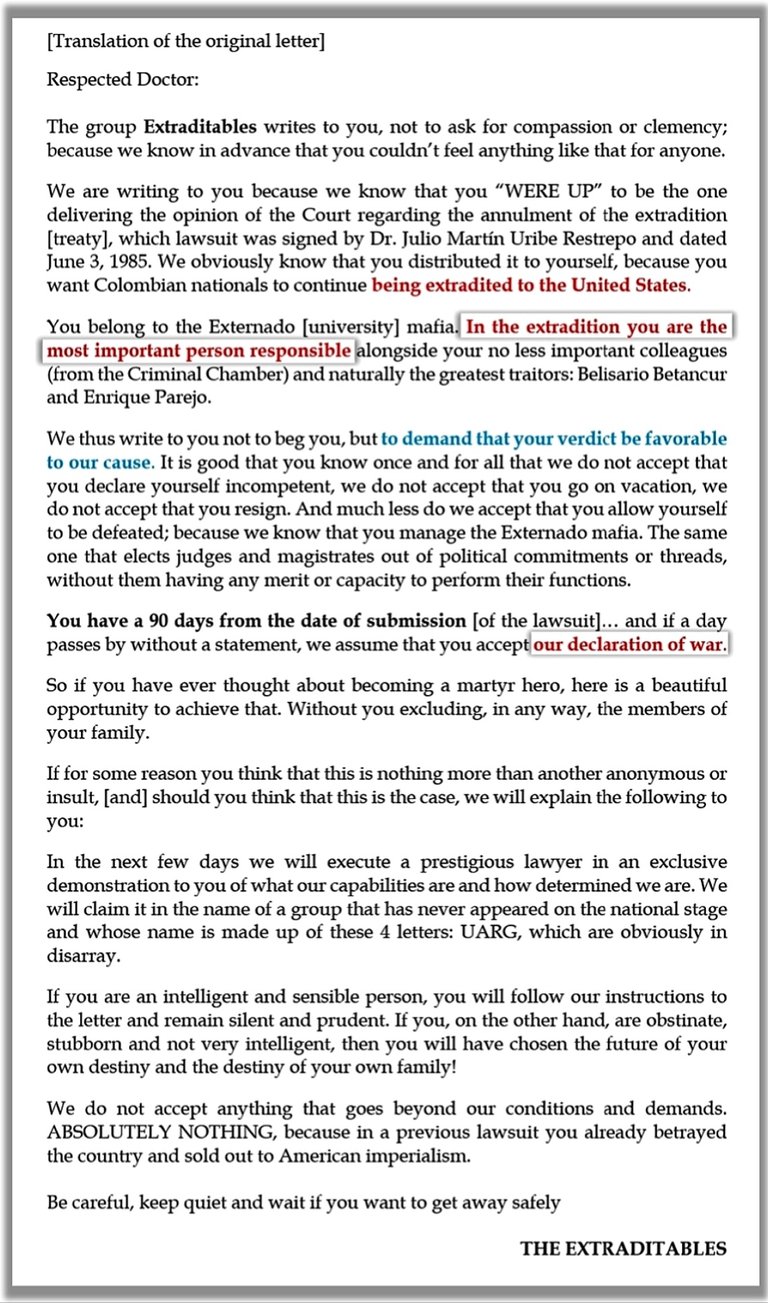

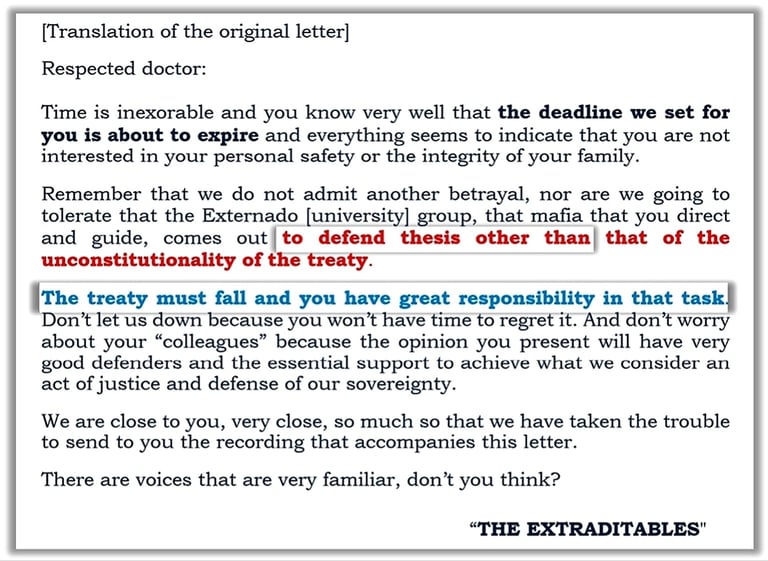

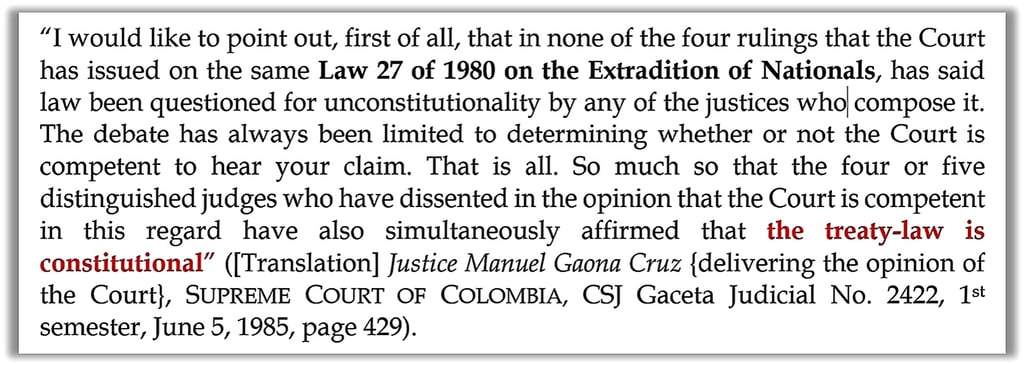

Justice Manuel Gaona Cruz led the so-called "intermediate thesis" in the Constitutional Chamber, which eventually became the official position of the Supreme Court of Justice regarding the constitutionality of the law approving the Extradition Treaty between Colombia and the United States (Law 27 of 1980 or "treaty-law"). This occurred in the four decisions that preceded the lawsuit for unconstitutionality (action for annulment) filed by Pablo Escobar's lawyer on June 3, 1985, whose constitutional review was assigned to Justice Manuel Gaona Cruz. At the exact day and time the attack on the Palace of Justice began—November 6, 1985, at 11:30 a.m.—Manuel Gaona Cruz was presenting his constitutional opinion on the lawsuit for unconstitutionality filed by Pablo Escobar and other extraditables through their legal representative, Julio Martín Uribe Restrepo. The last two rulings that declared the constitutionality of the extradition treaty-law were issued, the first with Justice Gaona's opinion in March and the second, with a clarification of vote by Justice Manuel Gaona Cruz on June 5, 1985.
(CSJ, Justice Manuel Gaona Cruz, Sentence No. 19, File No. 1252, March 21, 1985).
The group known as "THE EXTRADITABLES" was led by Pablo Escobar and the bosses of the Medellín drug Cartel (See Court Reveals Extraditables' Maneuvers, EL TIEMPO, September 24, 1983, page 13-C). The first letter and threat to Justice Manuel Gaona Cruz, his wife, and his children arrived on August 5, 1985. The second letter arrived on September 1, 1985. During the months of September and October, Manuel Gaona and his family received several envelopes containing audio cassettes, scapulars, and death notices. The last envelope arrived at Justice Gaona's house late in the afternoon on Sunday, November 3, 1985. The envelope contained a blue death notice and a blank letter with only the logo of the Extraditables. Copies of the letters that the Extraditables sent to Manuel Gaona Cruz are shown below. At the request of former Chief Justices Nilson Pinilla Pinilla, José Roberto Herrera Vergara, and Jorge Aníbal Gómez Gállego, the original letters were delivered directly and personally to the members of the Supreme Court's Truth Commission in 2006. The text of the letters is also published in its final report (See Final Report: Truth Commission Final Report in Informe Final: Comisión de la Verdad Sobre los Hechos del Palacio de Justicia, CORTE SUPREMA DE JUSTICIA DE COLOMBIA, Ed. Universidad del Rosario 2010, page 315).
(CSJ, Justice Manuel Gaona Cruz, Sentence No. 41, File No. 1275, June 5, 1985, Judicial Gazette 2422, 1er semester, page 429 {concurring}).
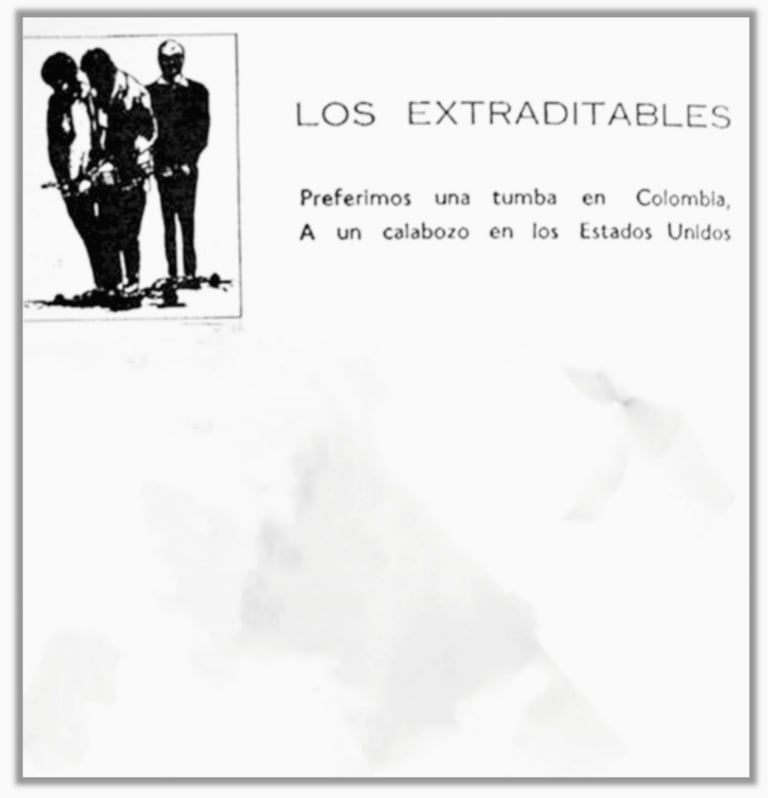


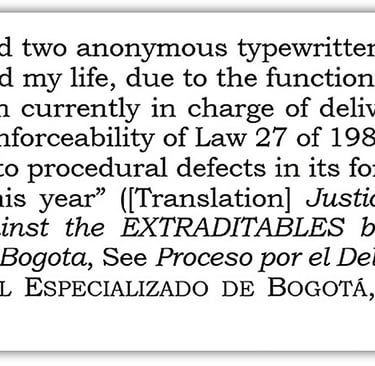
Justice Manuel Gaona Cruz filed a criminal complaint for extortion against the Extraditables before the 71st CRIMINAL INSTRUCTION COURT OF BOGOTÁ three days before the attack (See complaint, 71ST CRIMINAL INSTRUCTION COURT OF BOGOTÁ, folio 319, November 2, 1985).
Adicionalmente, el Magistrado Gaona advirtió que algunos mensajes aparecían membretados con el logo de “LOS EXTRADITABLES”, particularmente los mensajes de audio (casetes) recibidos que contenían interceptaciones telefónicas a sus hijos, así como los sufragios que el magistrado recibió tanto en su casa como en su despacho de la Corte Suprema (Oficina 409). La última amenaza del Cártel de Medellín y Pablo Escobar —esto es, un sufragio con una hoja en blanco— llegó a casa del magistrado en la tarde del domingo 3 de noviembre; dos días antes del asalto al Palacio de Justicia por parte de la guerrilla del M-19.
Following the Holocaust of the Palace of Justice and, in particular, based on the complaint and evidence provided by Justice Manuel Gaona Cruz himself before the 71st Criminal Investigation Court, investigations carried out by the DIJIN led to the determination that Luis Alfredo Beltrán Moreno was the person who carried out the telephone wiretaps on both Justice Manuel Gaona Cruz's home and that of Secretary of Justice Rodrigo Lara Bonilla, who was murdered by order of Pablo Escobar on April 30, 1984. According to investigations conducted by the National Directorate of the Judicial and Investigation Police (See Special Report on the Security of the Palace of Justice, DIJIN, 1985, folio 1, 143, c. 3) and in accordance with the rulings of the respective criminal investigation judges, Luis Alfredo Beltrán Moreno was declared criminally responsible for having intercepted the phones of the justices of the Court and Minister of Justice Rodrigo Lara Bonilla (See File "violence against a public employee", 89TH CRIMINAL INVESTIGATION COURT OF BOGOTÁ, Folio 349, C. No. 1). However, it is worth noting that Beltrán Moreno was acquitted by the 71st Criminal Investigation Court of Bogotá of the crime of extortion, inasmuch as—according to the 71st Judge's ruling (1986)—"neither the group known as the 'Extraditables' nor the defendant intended to directly obtain an economic benefit with their coercion of the justices."
The M-19 guerrilla group has maintained that the reason for attacking the Palace of Justice was related to the non-compliance with the Peace Accords by President Belisario Betancur. Yet, the Peace Accords signed between the Betancur Government and the M-19 in August 1984 did not include any reference to the Extradition Treaty between Colombia and the United States. In fact, there was no point in the Peace Accords that on extradition, as the Extradition Treaty signed on September 14, 1979, between Colombia and the United States was exclusively related to the crime of drug trafficking, not to crimes of rebellion or terrorism. Neither the Colombian Penal Code of 1980 nor the penal codes and international treaties of other countries that use the extradition mechanism typically include the crime of rebellion. Upon entering the Palace, however, the M-19 included among its main demands the declaration of unconstitutionality of the Extradition Treaty, a request that coincides with the purpose and threats of Pablo Escobar toward Justice Manuel Gaona Cruz, the presiding justice of the Law Approving Extradition ("treaty-law") just days before the takeover, who was the central architect of the intermediate thesis that prevented the declaration of unconstitutionality of the treaty-law. on Wednesday, November 6, 1985; that is, the day the constitutionality of the Extradition Treaty was being decided and, with it, the fate of Pablo Escobar, the Medellín drug Cartel, and the most profitable criminal organization in the world in 1985 (See The Rise of the Medellin Drug Cartel: 1980–1985, U.S. DRUG ENFORCEMENT ADMINISTRATION (DEA) [DEA History: Archives & Reports]), the M-19 guerrilla group presented among its main petitions, a demand and a proclamation against the Extradition Treaty in the following terms:
With a vote of 45 to prohibit and 5 to deny Extradition, and with the notable dissenting vote of Senator Antonio Galán Sarmiento, the National Constituent Assembly approved the proposition presented by the then-current Democratic Alliance M-19, which was led by the former M-19 guerrilla commander Antonio Navarro Wolff. Pablo Escobar surrendered to authorities on the very day the reform was approved, along with the "hundreds of compatriots" whose situation was a concern of the M-19 (See video). Pablo Escobar demanded to the government that his jail, known as "La Catedral," had to be built by his men of confidence, a condition which the Colombian Government accepted.
3. LETTERS AND THREATS FROM PABLO ESCOBAR AND LOS EXTRADITABLES TO JUSTICE MANUEL GAONA CRUZ IN 1985
4. CRIMINAL COMPLAINT AGAINST THE EXTRADITABLES FILED BY JUSTICE MANUEL GAONA CRUZ BEFORE THE 71ST CRIMINAL INSTRUCTION COURT OF BOGOTÁ ON NOVEMBER 2, 1985
5. DEMANDS AND PROCLAMATIONS REGARDING THE EXTRADITION TREATY FROM THE M-19 GUERRILLA GROUP UPON ENTERING THE PALACE OF JUSTICE ON NOVEMBER 6, 1985
6. PROPOSAL FROM THE M-19 DEMOCRATIC ALLIANCE TO PROHIBIT THE EXTRADITION IN COLOMBIA BEFORE THE NATIONAL CONSTITUENT ASSEMBLY AND STATEMENTS BY THE M-19 AND PABLO ESCOBAR IN 1990
7. LETTER FROM PABLO ESCOBAR TO THE DIRECTOR OF THE NATIONAL POLICE FOR JUDICIAL INVESTIGATION (DIJIN) IN 1990


7. PRESS REPORTS ON THE ASSASSINATION OF JUSTICE MANUEL GAONA CRUZ AT THE HANDS OF THE M-19 GUERRILLA GROUP PUBLISHED BETWEEN 1985 AND 1986
D. DOCUMENTARY EVIDENCE: THE MOTIF AND THE PLANNING OF THE CRIME | PABLO ESCOBAR, THE EXTRADITABLES AND THE M-19 GUERRILLAS
The relationship between Pablo Escobar and the M-19 guerrilla group (before and after the Palace of Justice attack) was extensively documented in the Final Report by the Truth Commission established by the Supreme Court of Justice of Colombia (See "The Drug Trafficking Connection" in Final Report: Truth Commission on the Events of the Palace of Justice, Informe Final: Comisión de la Verdad Sobre los Hechos del Palacio de Justicia, CORTE SUPREMA DE JUSTICIA DE COLOMBIA, Editorial Universidad del Rosario 2010, pages 311 ff.). Pablo Escobar was the primary beneficiary of the Palace of Justice takeover, as he became the most powerful man in Colombia after the murder of all the Justices who made up the Constitutional Chamber of the Supreme Court of Justice, including Justice Manuel Gaona Cruz, whose intermediate thesis had for years prevented the declaration of unconstitutionality of the law approving the Extradition Treaty between Colombia and the United States of America (Law 27 of 1980). Between 1985 and 1988, Escobar ordered the murder of more than 1,000 police officers (See James Mollison, Rise and Fall of the Cocaine King, THE GUARDIAN, September 28, 2007). The last person to oppose Pablo Escobar and to call for the application of the Extradition Treaty—which he described as "the tool to defeat the mafia"—was presidential candidate Luis Carlos Galán Sarmiento, who was murdered by order of Pablo Escobar on August 18, 1989 (See Pilar Lozano, The Weapon of Extradition, EL PAÍS, August 21, 1989). Transcribed below are the testimonies and declarations that provide incontrovertible evidence of the criminal relationship between Pablo Escobar and the M-19 guerrilla group, as well as the threats, planning, and motive behind the takeover and the assassination of Justice Manuel Gaona Cruz and the Justices of the Constitutional Chamber: Carlos Medellín Forero, Alfonso Patiño Rosselli, and Ricardo Medina Moyano.

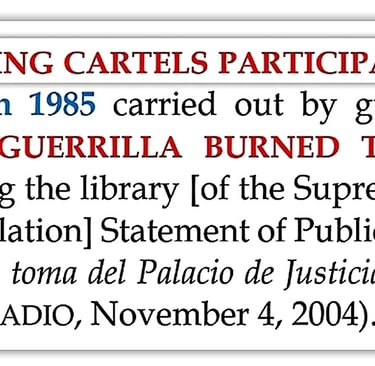
Following the constitutional prohibition of the extradition of Colombian drug traffickers, which was promoted by the M-19 and approved by the National Constituent Assembly in 1991, the criminal and terrorist organization known as LOS EXTRADITABLES, commanded by Pablo Escobar from 1981 to 1991, was immediately dismantled on July 3rd. In Escobar's own words, "given the position of the National Constituent Assembly that put an end to the extradition of Colombians" (See Extraditables: Fin del Terror, EL TIEMPO, June 4, 1991). The constitutional reform that sought to completely eliminate the possibility of extraditing Colombian drug traffickers to the United States was proposed and promoted by the Democratic Alliance M-19, led by the former M-19 guerrilla commander and former constituent Antonio Navarro Wolff. Eventually, Pablo Escobar subdued the Colombian State by achieving three fundamental objectives that guaranteed him total immunity in Colombia: these were (i) the long-awaited declaration of unconstitutionality by the new Supreme Court one year after the December 12, 1986 takeover, (ii) the constitutional reform promoted by the Democratic Alliance M-19 in 1991 which prohibited the extradition of drug traffickers in Colombia, and (iii) the construction of a club-like prison where he voluntarily confined himself under the care of his trusted men (See video {right}, La Fuga de la Catedral, EL TIEMPO, Así se fugó Pablo Escobar de la cárcel La Catedral | El Tiempo, https://youtu.be/6E96-X0x04s?si=TRNO5kHAZn_qh9bk

Yamid Amat led the team of journalists and reporters from Noticias Caracol who broadcast live on the radio the takeover and retaking of the Palace of Justice in Bogotá for nearly 30 hours, with the exception of the press censorship imposed by Secretary of Communications, Noemí Sanín.
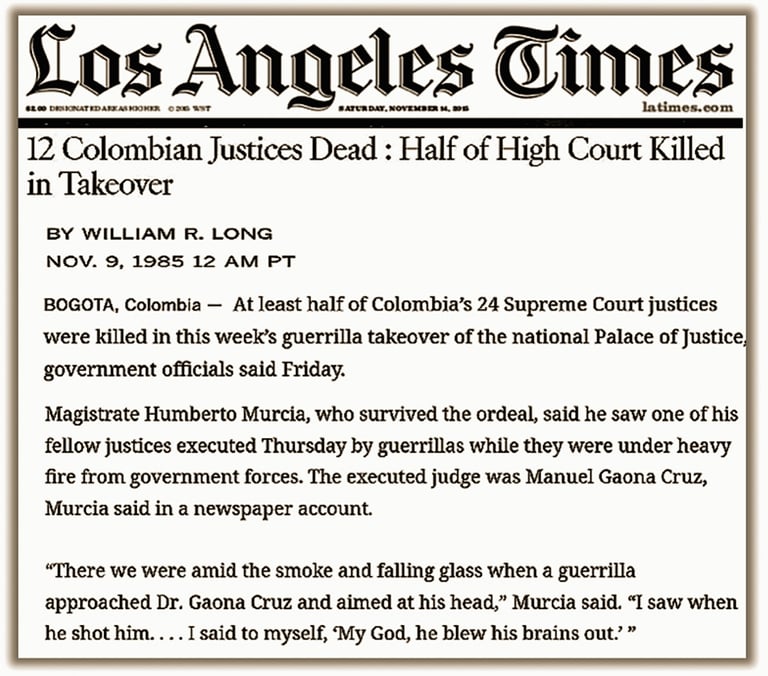

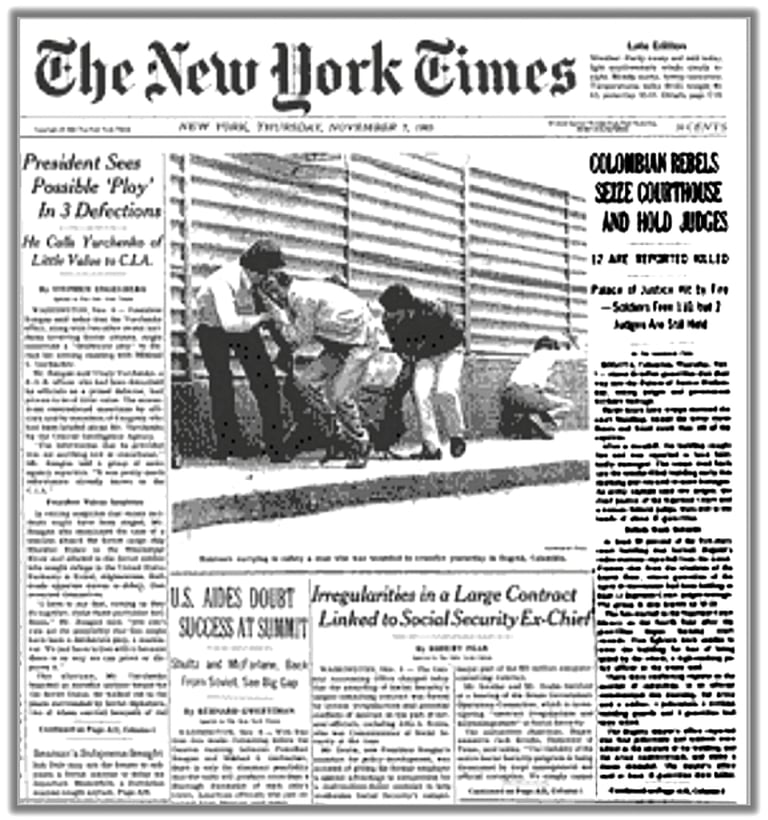

It should be noted, nonetheless, that the only "compatriots" subject to the Extradition Treaty were those dedicated to drug trafficking and sentenced for the crime of drug trafficking. The most notable name on the list of "hundreds of compatriots" known as "the Extraditables" was that of the compatriot Pablo Emilio Escobar Gaviria, followed by the compatriots of the Medellín drug Cartel, Jorge Luis Ochoa, Fabio Ochoa, and Gonzalo Rodríguez Gacha (See 'Mafia and Politics' in Fabio Castillo, Los Jinetes de la Cocaina, Ed. Documentos Periodísticos 1987, Chapter 10). Between 1980 and 1985, these said compatriots became the world's richest criminal syndicate while turning Colombia into the world's largest cocaine producer (See The Rise of the Medellin Drug Cartel: 1980–1985, id.). The defense of the interests of a criminal organization of such magnitude and its criminal execution through the kidnapping and murder of the Supreme Court justices who intended to dismantle it, cannot be classified—at least, in light of applicable international and constitutional law—as a political motive.
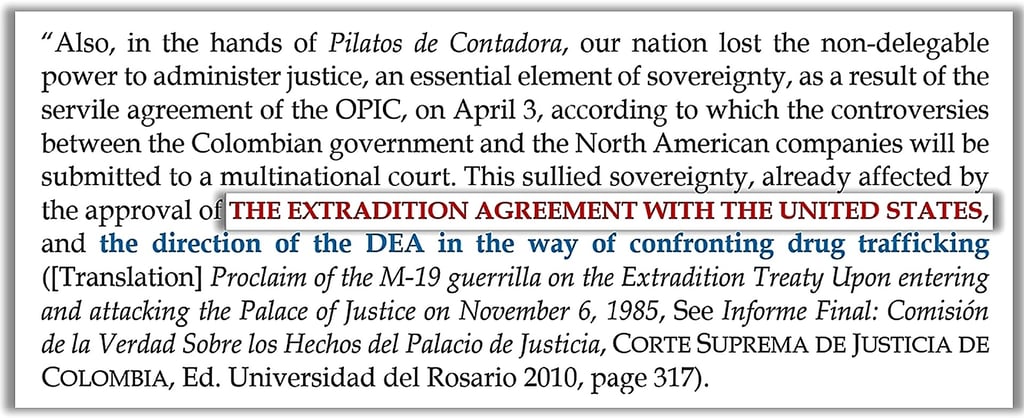


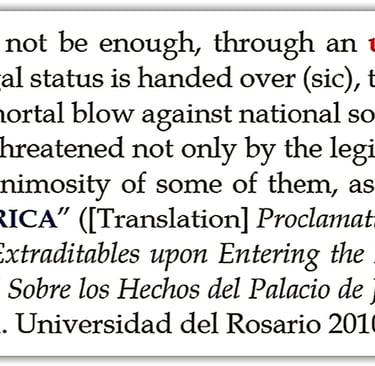
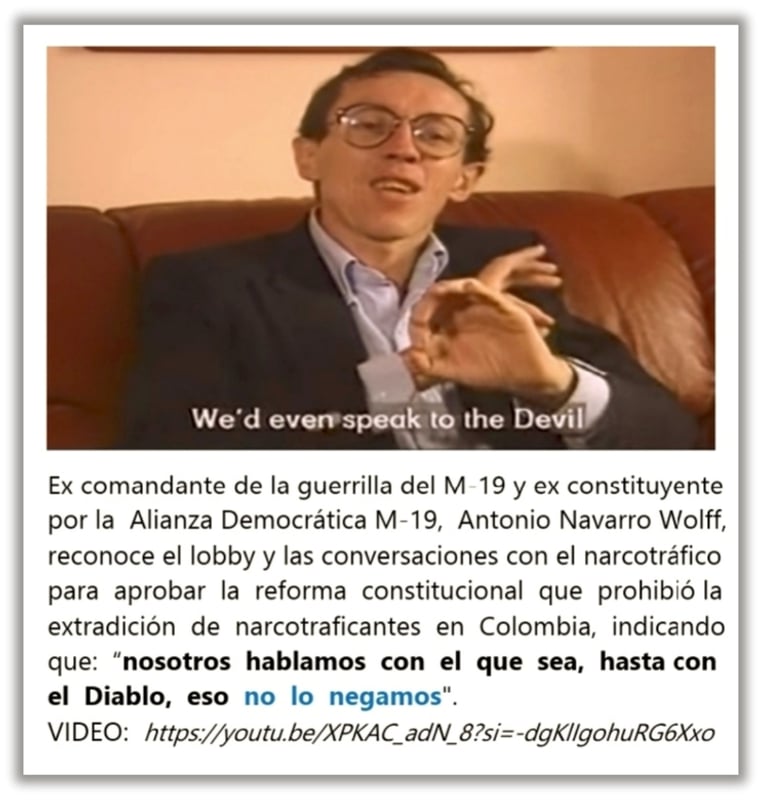

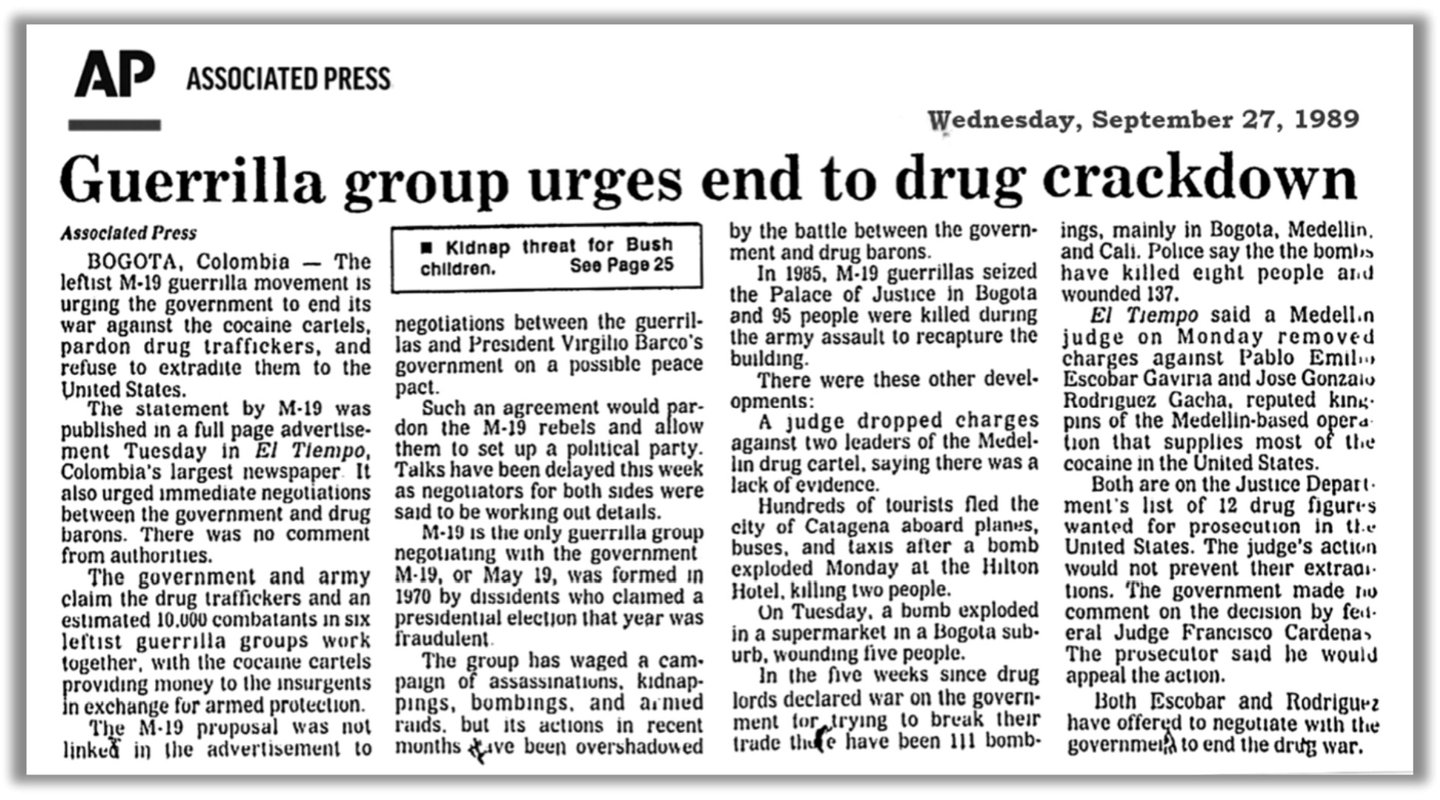

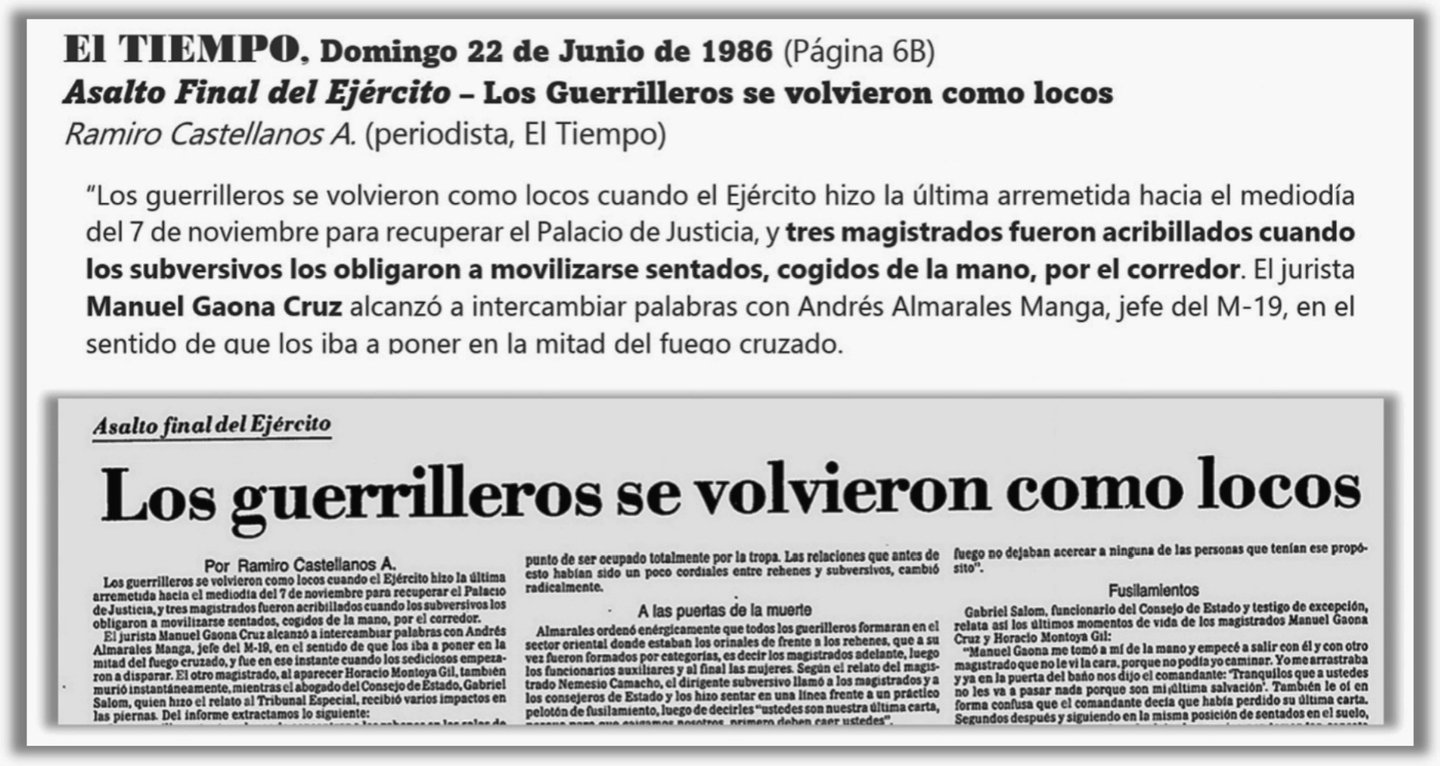

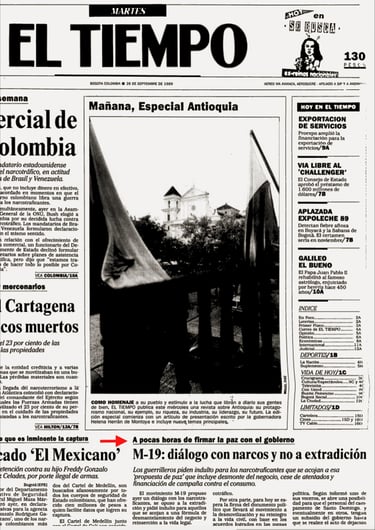

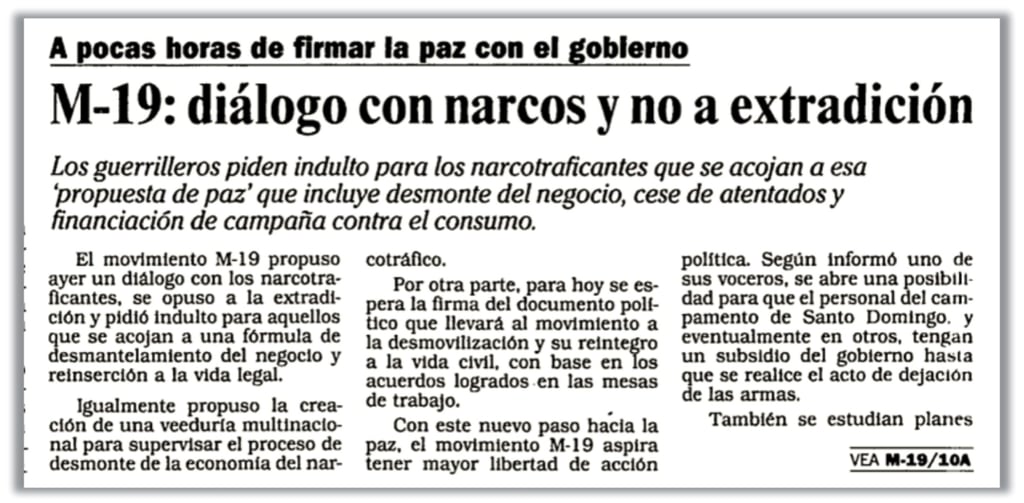

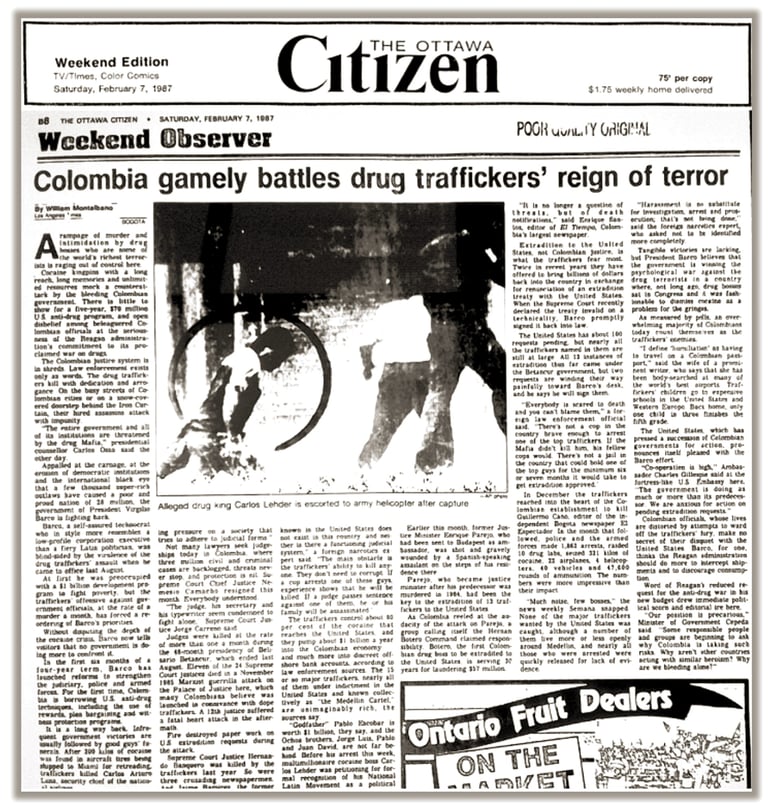

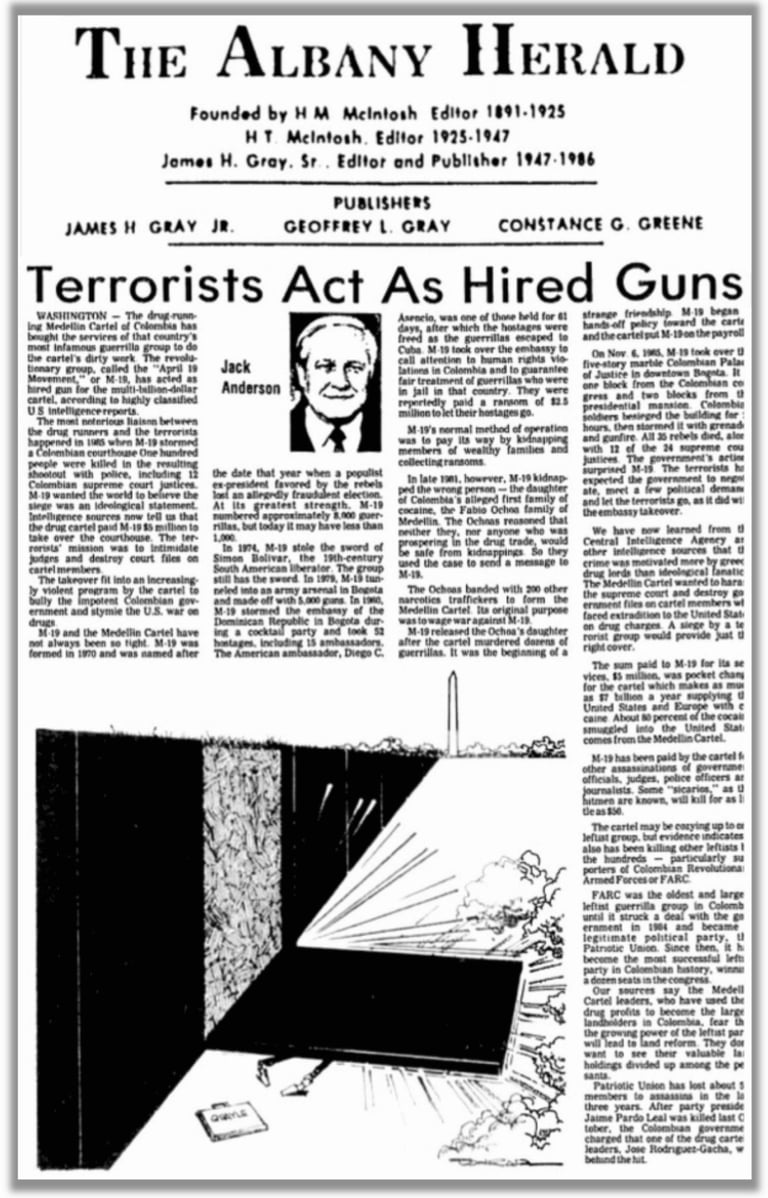

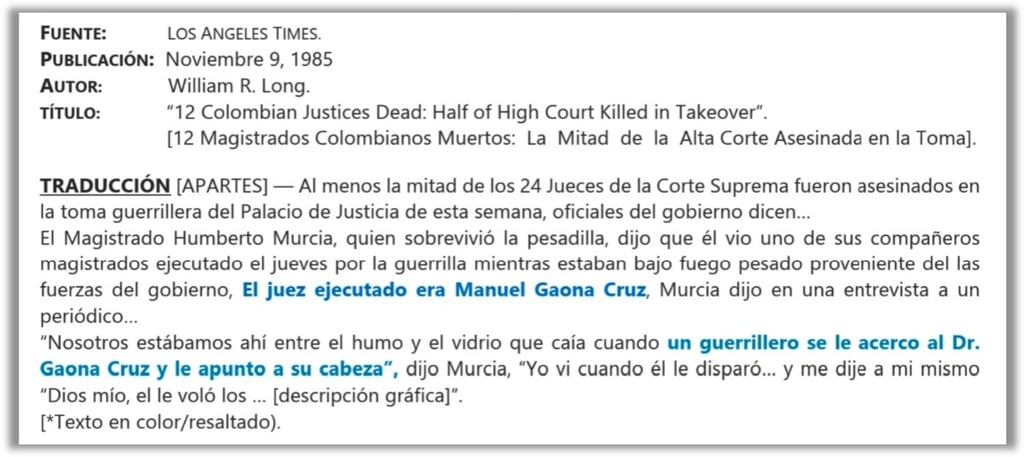

M-19 Guerrillas The first group of M-19 guerrillas enters through the garage of the Palace of Justice while shooting from this truck (11:30 a.m.)
Ejército Nacional La Brigada XIII del Ejército, la Escuela de Caballería y el Batallón Guardia Presidencial inician operaciones en el Palacio de Justicia utilizando tanques de guerra Cascabel y Urutu para disparar contra la Corte Suprema de Justicia. En el interior, se hallan 400 civiles como rehenes. 12:05 P.M.
Policía Nacional El Grupo COPES de la Policía Nacional desciende disparando sobre la azotea del Palacio de Justicia. 1:55 P.M.
Sequence of the Attack Caracol Noticias
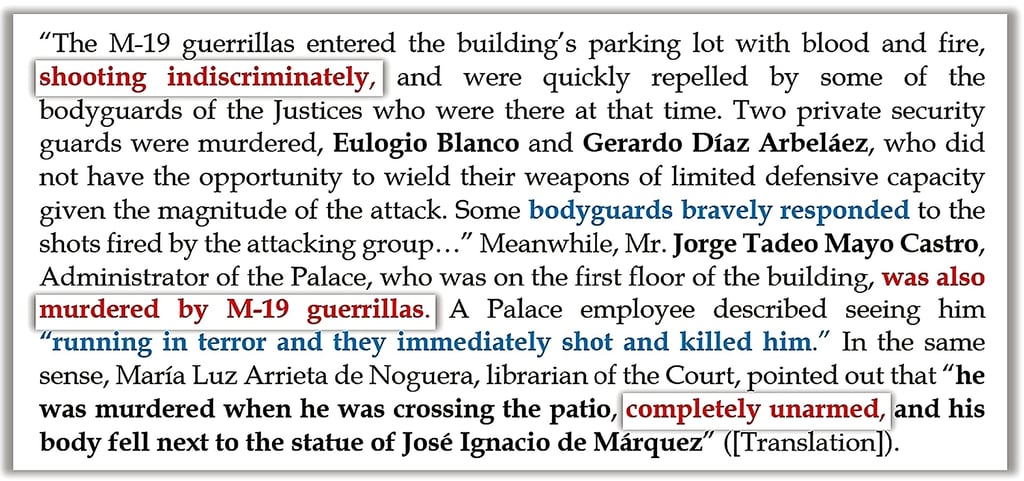

The violent entry of the M-19 guerrillas and the civil resistance to the attack were summarized by the Truth Commission established by the Colombian Supreme Court of Justice in the following terms:
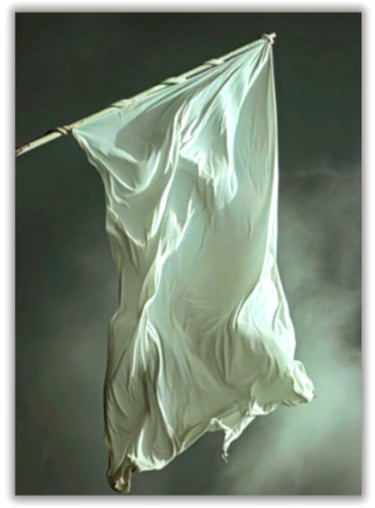

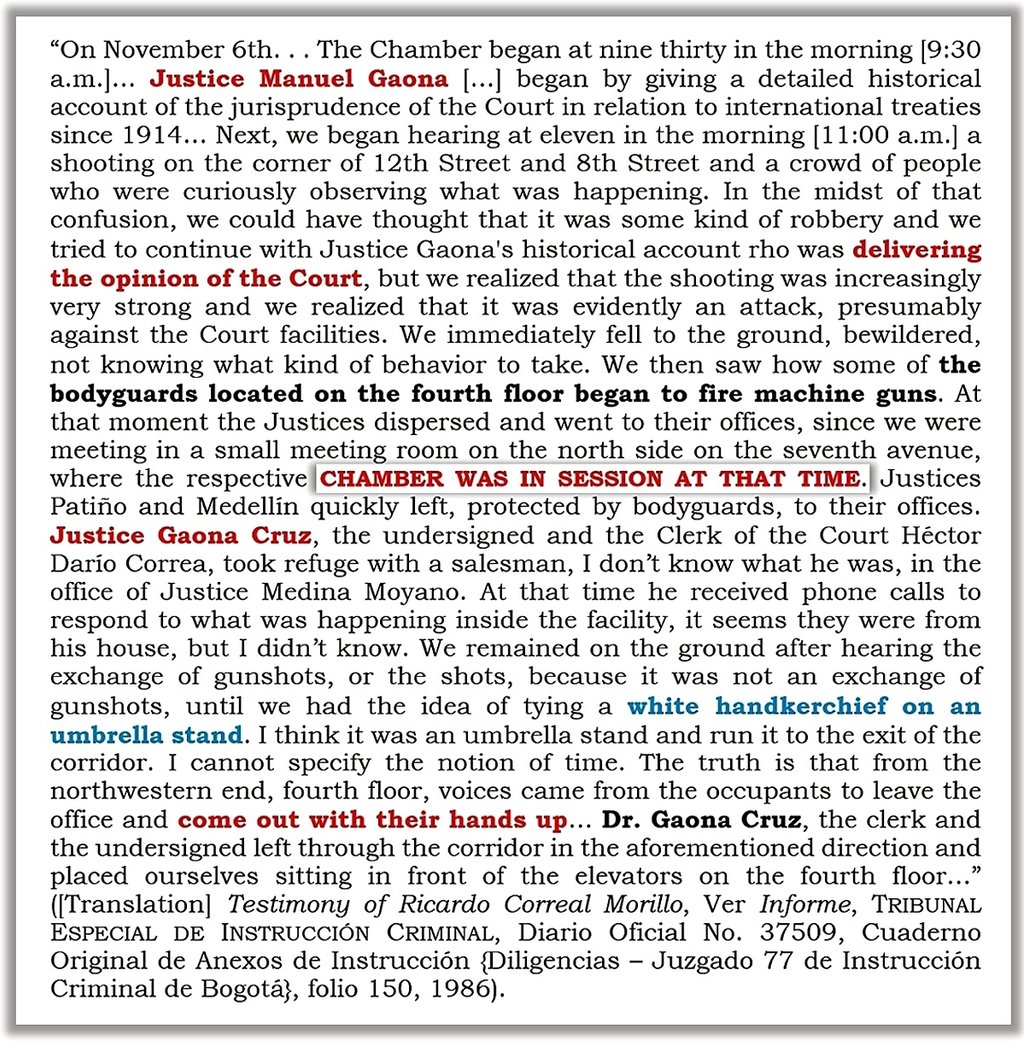

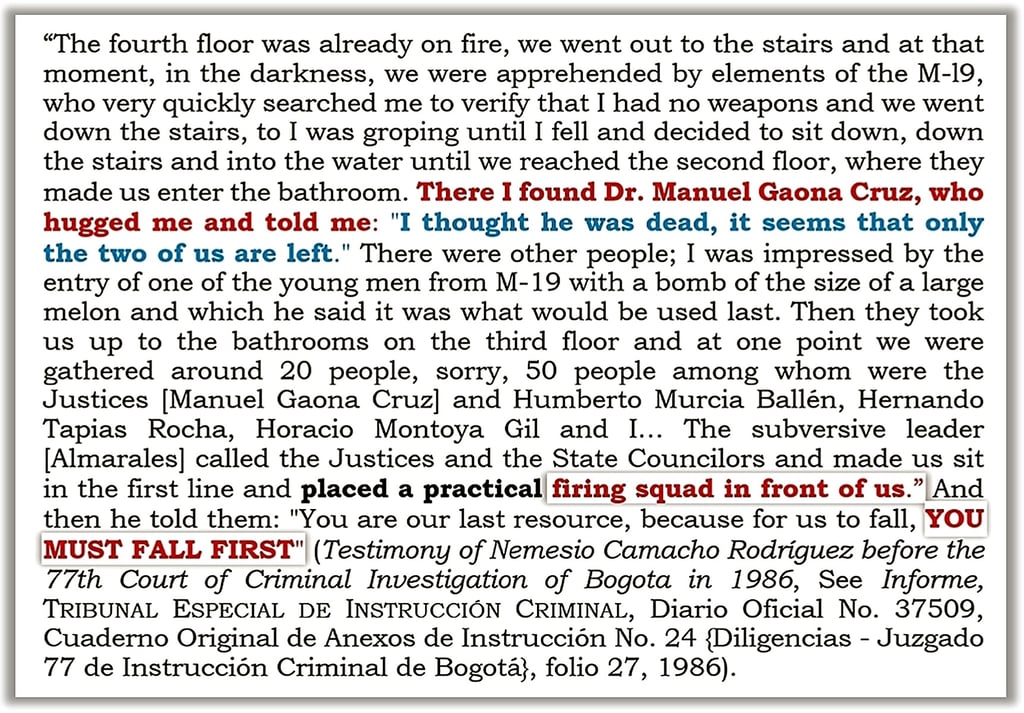

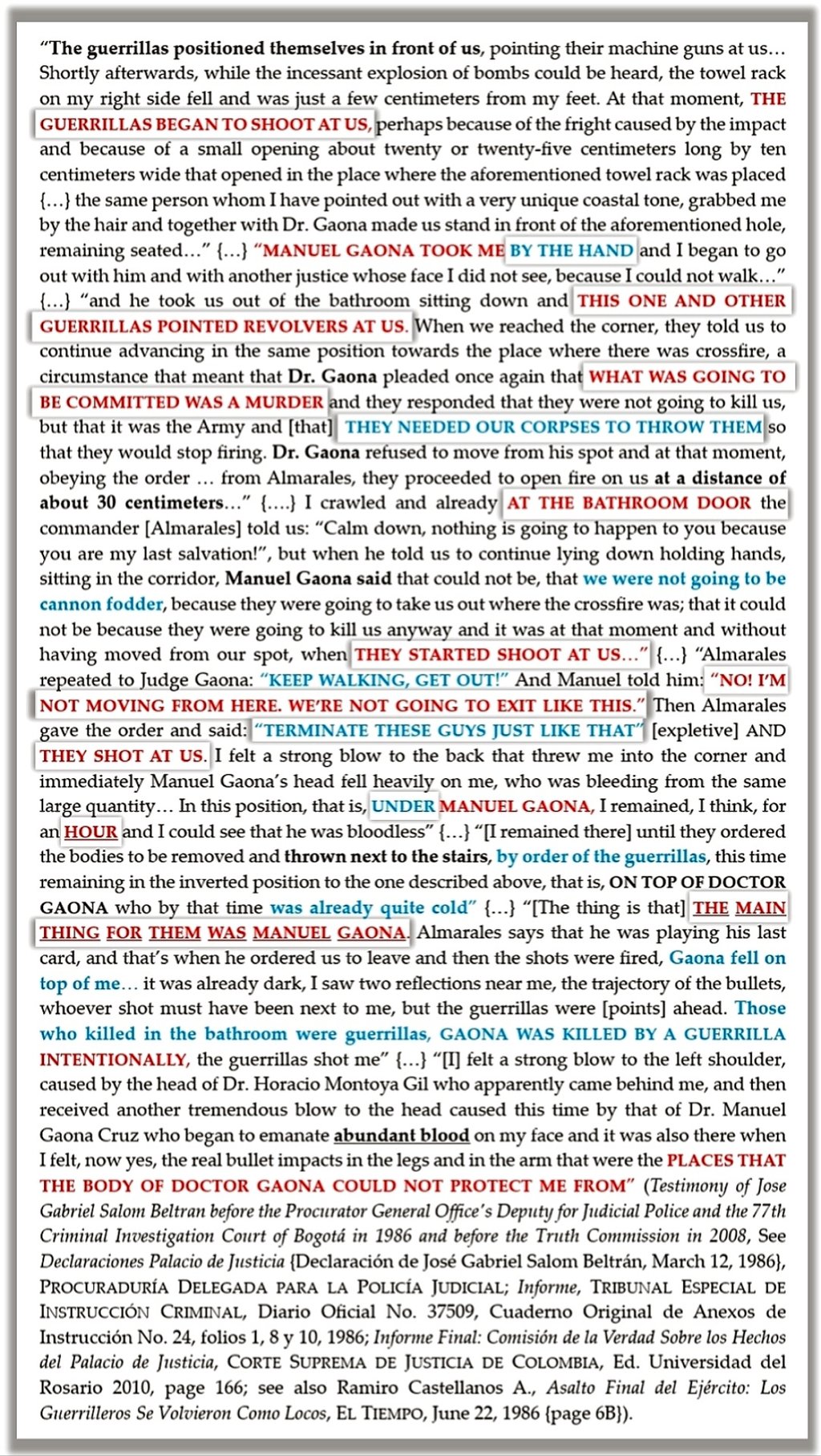


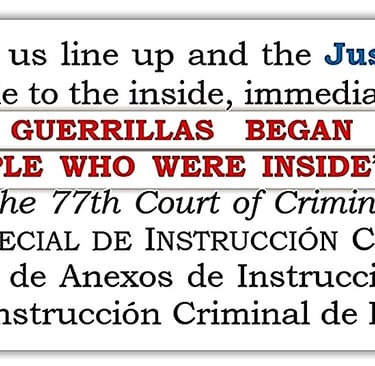

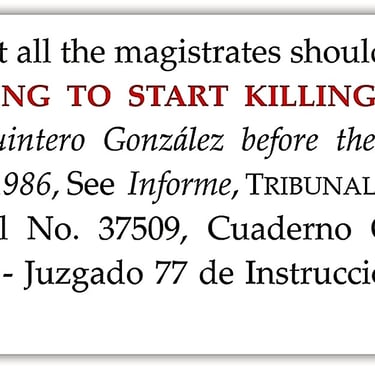
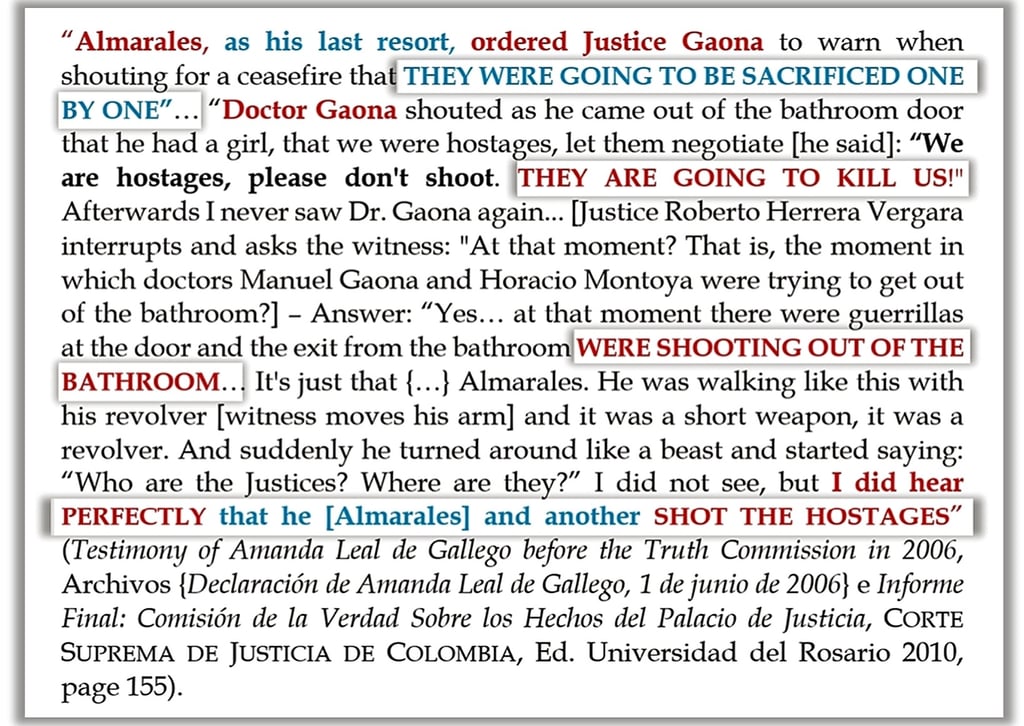

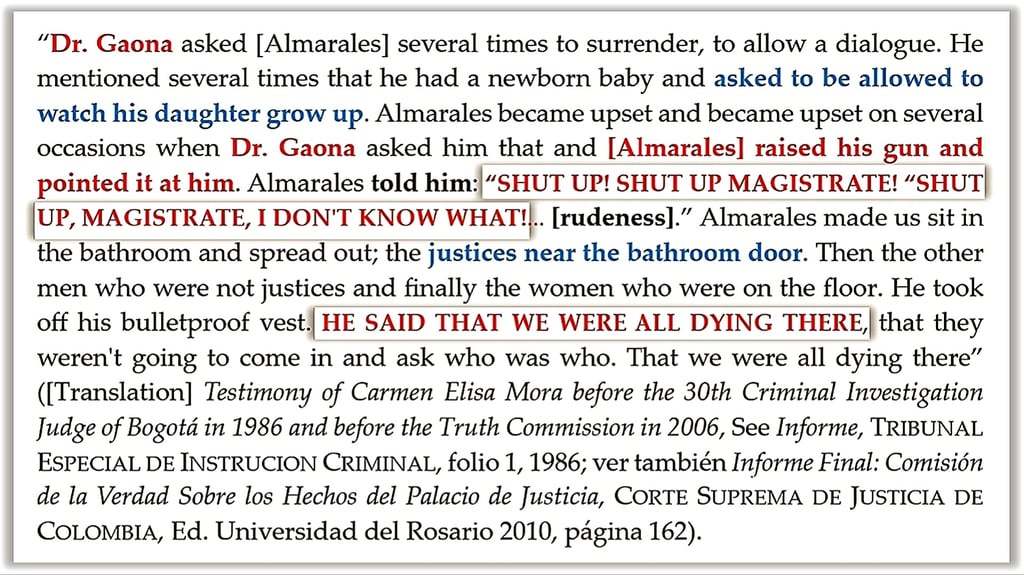

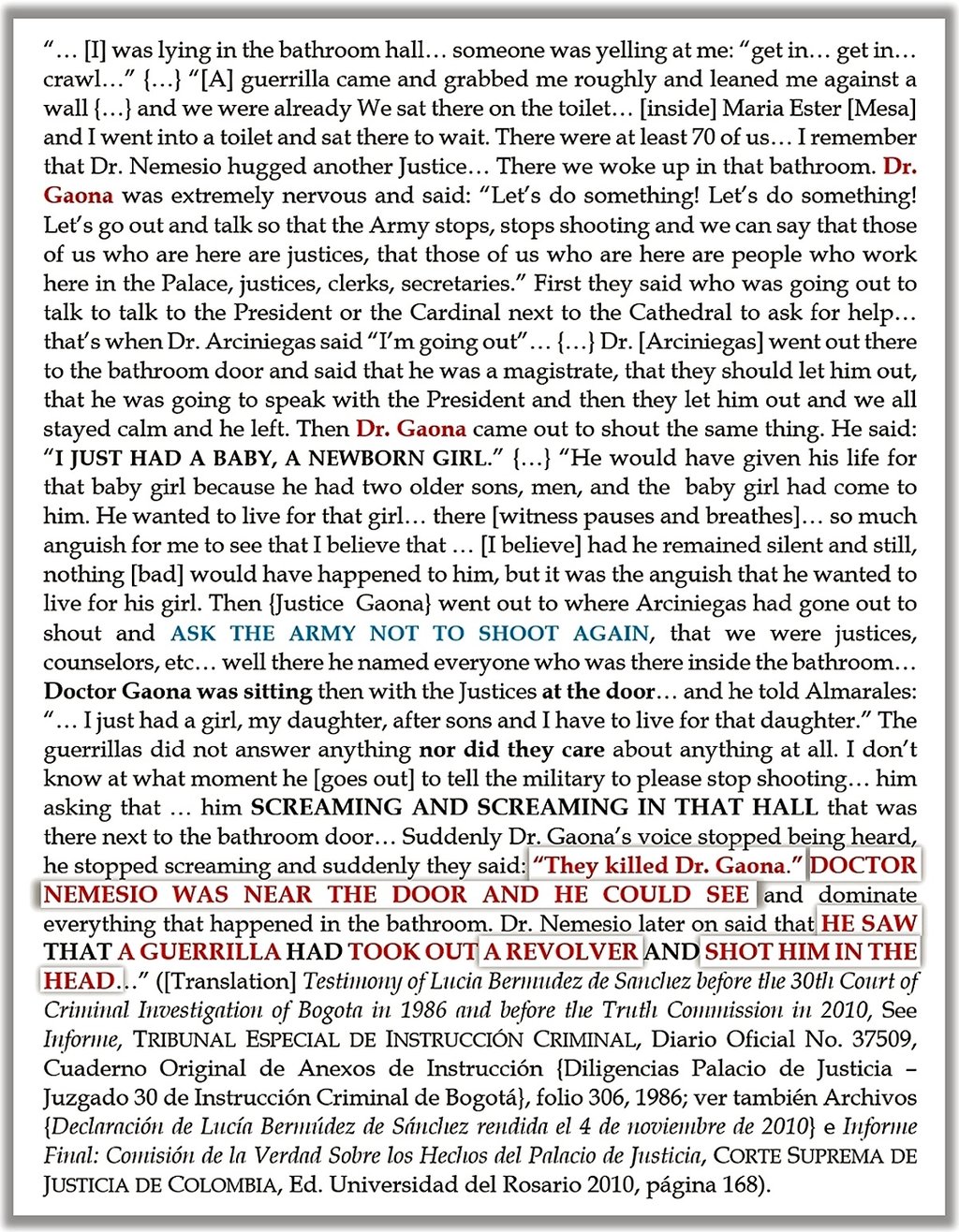

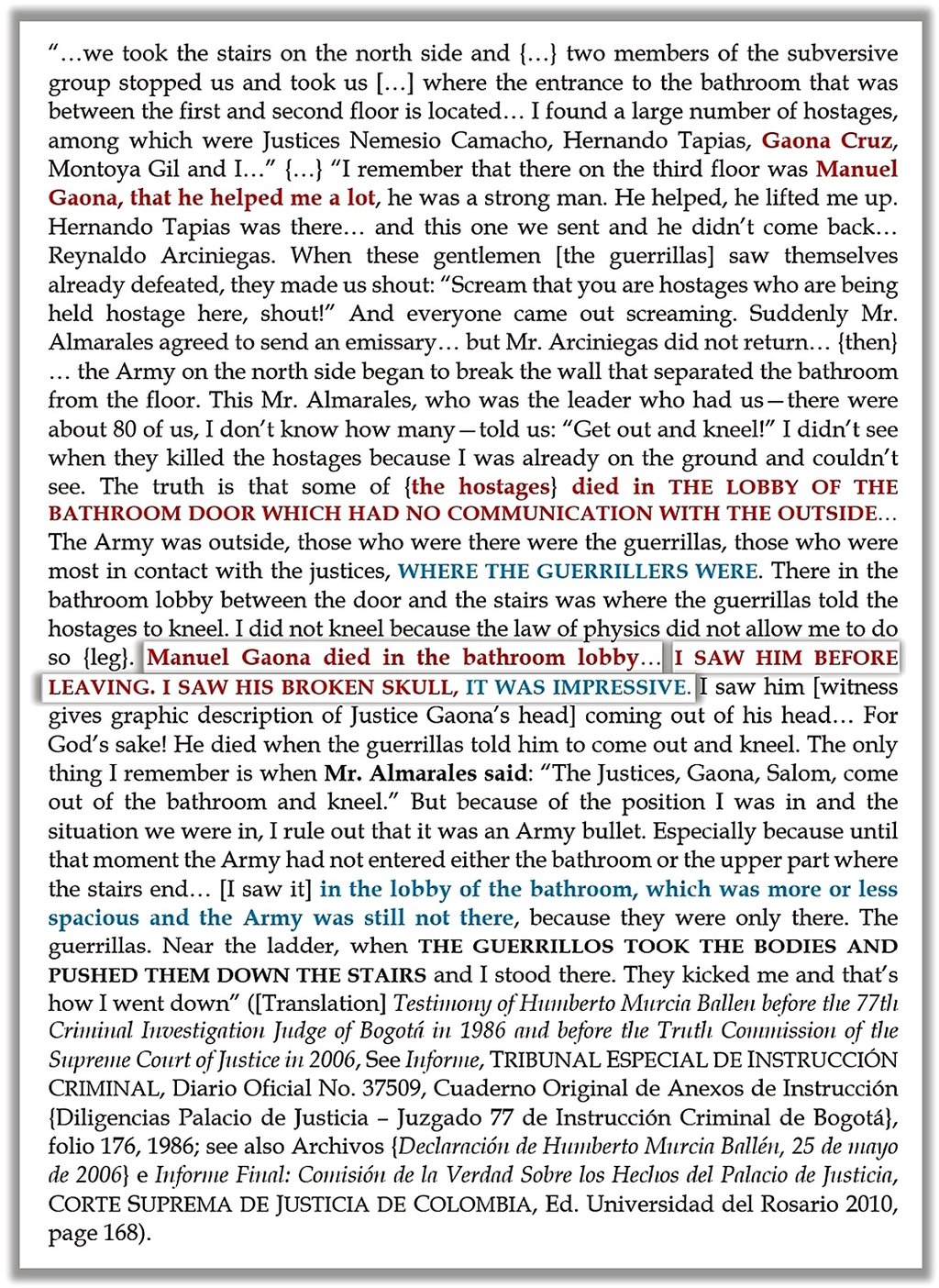

B. JUDICIAL INSPECTIONS | FORENSIC RECONSTRUCTION OF THE CRIME SCENE
Between 1986 and 1989, three judicial inspections were carried out (by the 77th and 30th Criminal Investigation Courts of Bogotá and the 14th Superior Court of Bogotá) regarding the events that took place in the bathroom on the northwestern side of the Palace of Justice, located between the second and third floors. The M-19 guerrilla group held the largest number of hostages (70 civilians) in that bathroom until the end of the takeover. The terrorist group (between 9 and 11 guerrillas, depending on the time) was led by the guerrilla member Andrés Almarales Manga. The hostages were led by Justice Manuel Gaona Cruz, who, until his last breath, tried to achieve a humanitarian resolution before being executed by the M-19 guerrillas around 1:00 p.m. on Thursday, November 7, 1985. The first and most complete inspection was conducted in March 1986 by order of the 77th Criminal Investigation Court of Bogotá. In addition to the inspection itself, a ballistics report was issued by the Ministry of Justice's Revolving Fund, a graphical forensic reconstruction with an architectural template of the bathroom, and a sequential forensic sketch illustrating and describing the hourly positions of the victims and the guerrillas. Based on the declarations of eyewitnesses to the crime (which were not discredited and were made under oath before Colombian authorities) and the public and spontaneous statements of eyewitnesses (given just minutes after the end of the takeover, while still in a state of shock, through national and international media), as well as existing documentary and expert evidence (i.e., photographs of the victim and the crime scene, a formal report of the body's removal, a necropsy, and a study of the spatial trajectory and ballistics of Manuel Gaona Cruz), all of which were analyzed by forensic experts, criminologists, engineers, architects, anthropologists, and lawyers in the United States and Colombia (See Menu – Investigation), we present the first forensic reconstruction of the crime of Supreme Court Justice Manuel Gaona Cruz at the hands of the M-19 guerrillas. The forensic reconstruction, which is the subject of our investigation and study, follows the parameters for "3D Crime Scene Reconstruction" developed by the United States Federal Bureau of Investigation (FBI) and its Evidence Response Team (ERTs). The forensic reconstruction of Manuel Gaona Cruz's crime was carried out in media laboratories using the most advanced software available in the year 2025, including artificial intelligence software for architectural approximation such as TestFit, Aino, and Conix-AI, and graphic applications for 3D models (Blender Pro and PS2025). The presentation of the 3D forensic reconstruction of the crime scene follows strict technical parameters.
C. FORENSIC EVIDENCE | CORONER'S REPORT, NECROPSY AND BALLISTIC TRAJECTORY STUDY
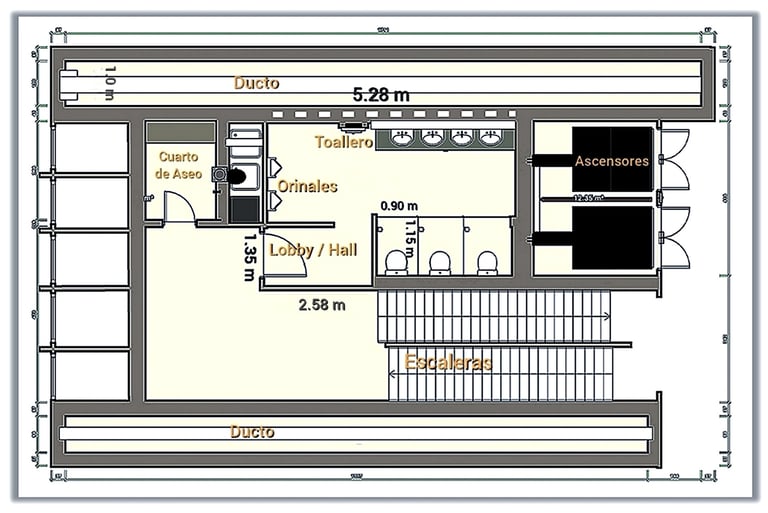

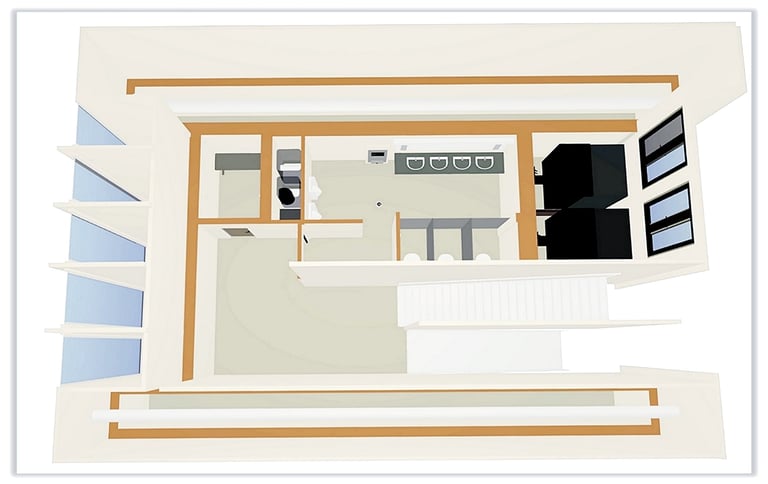

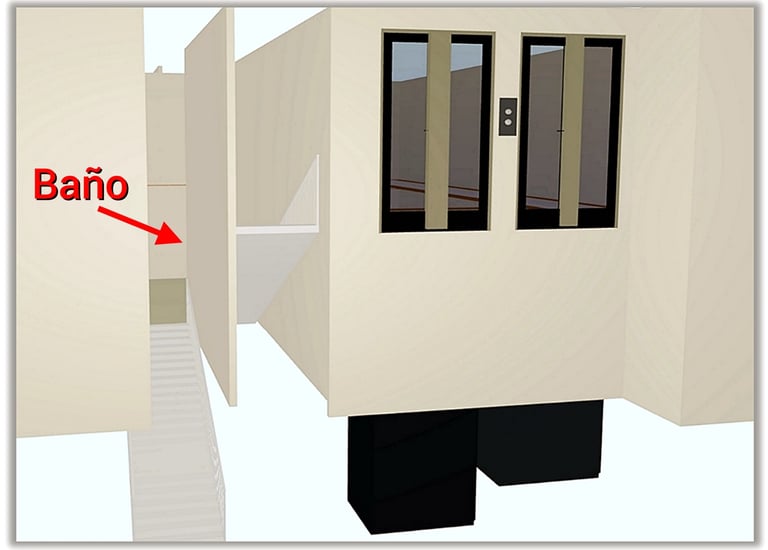

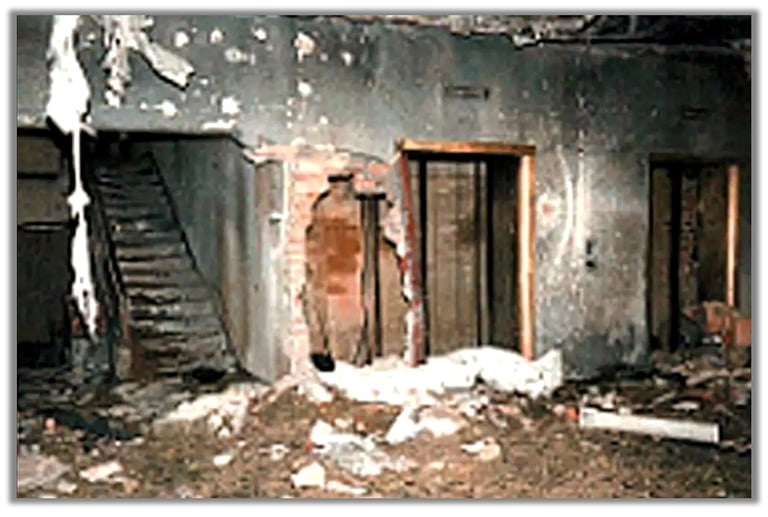

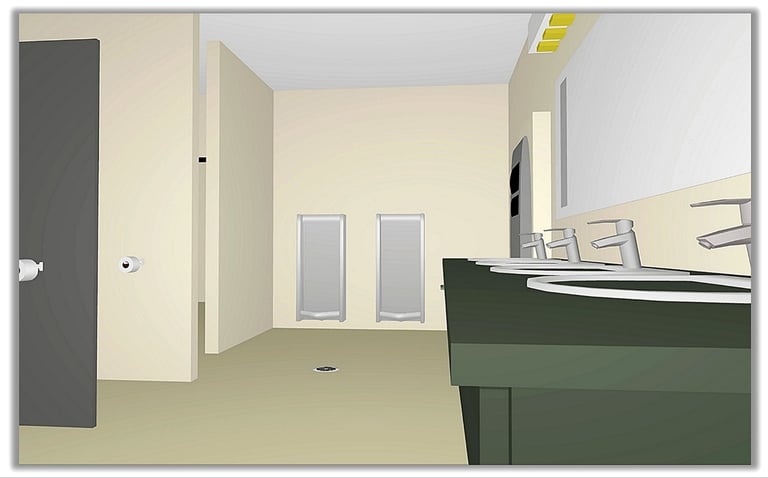

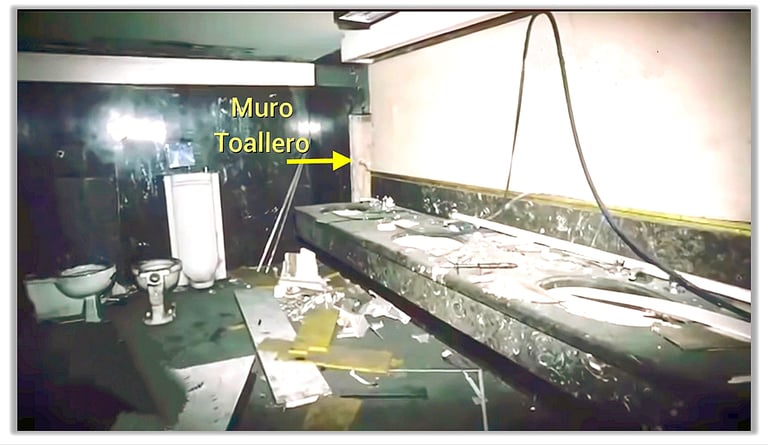

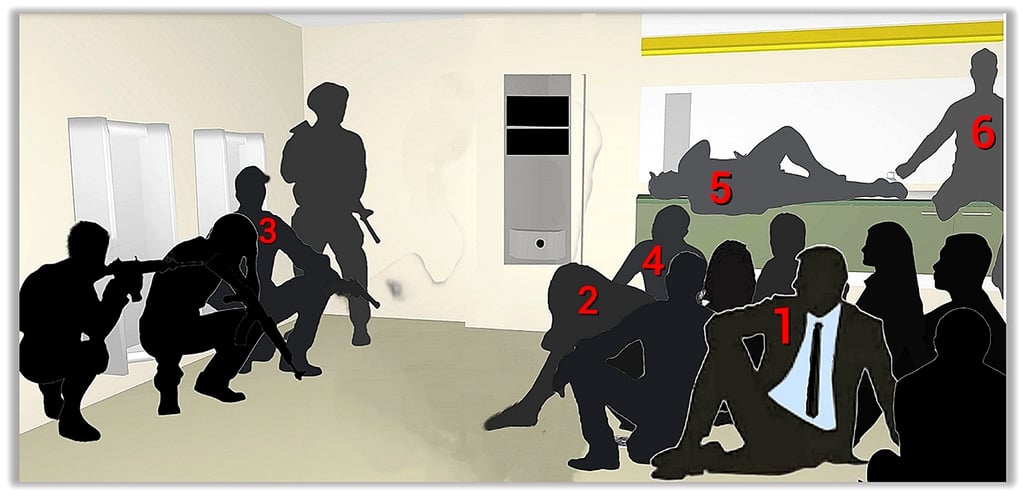

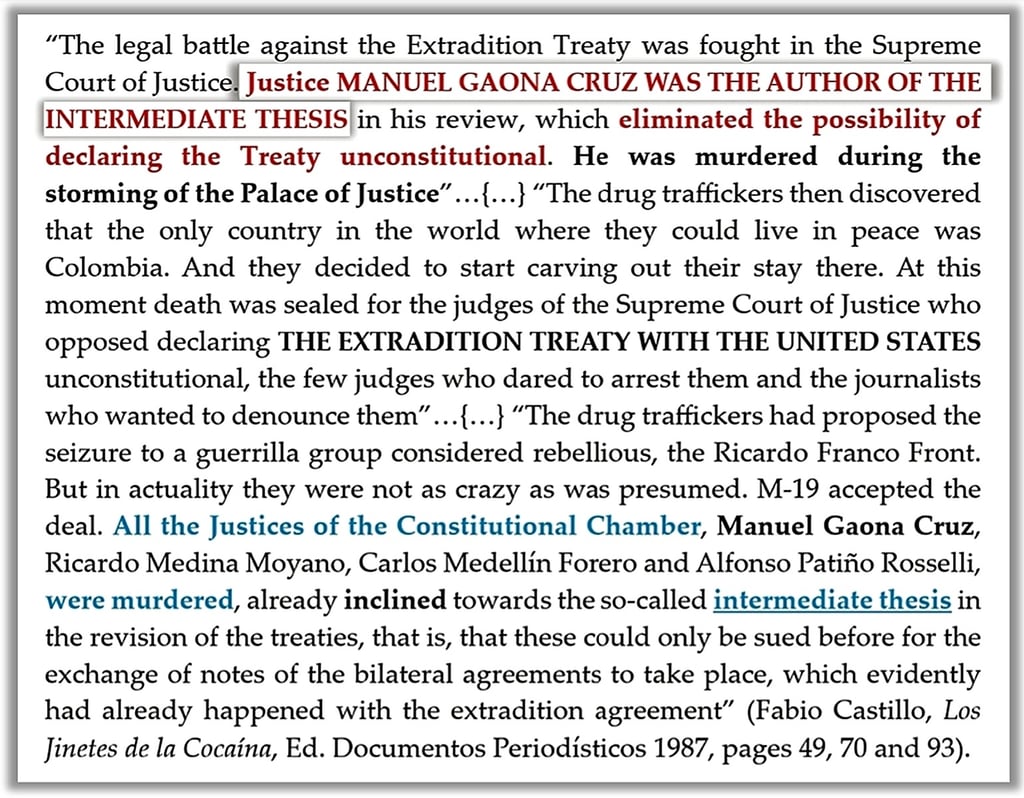

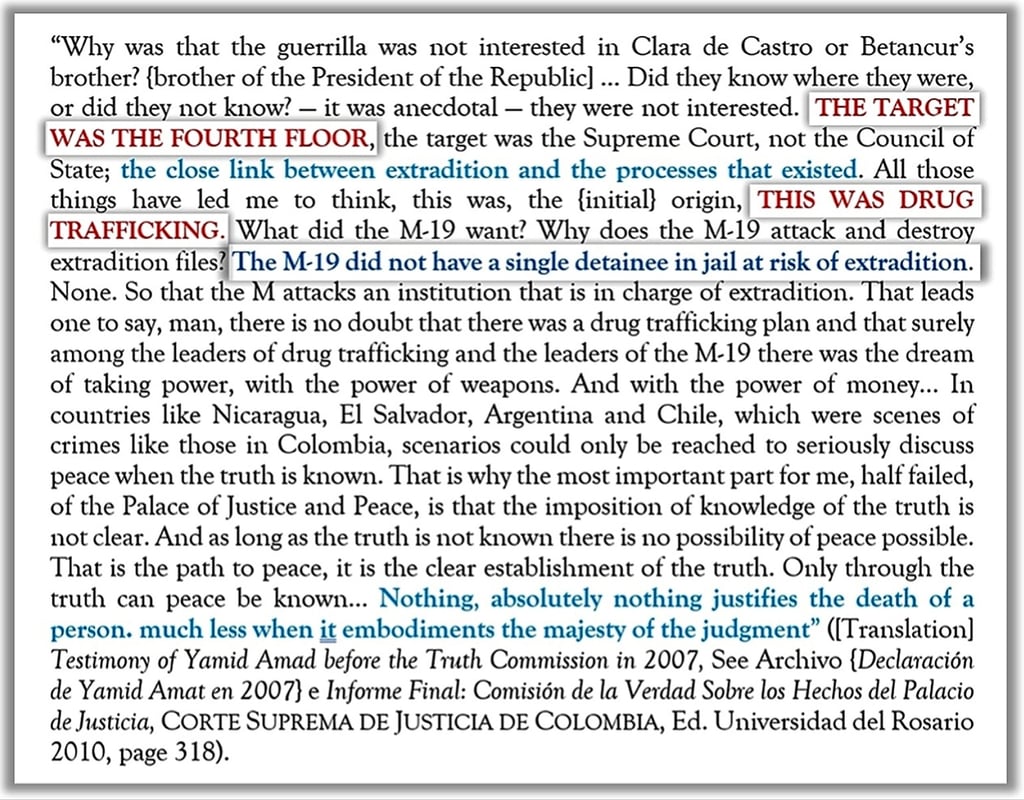

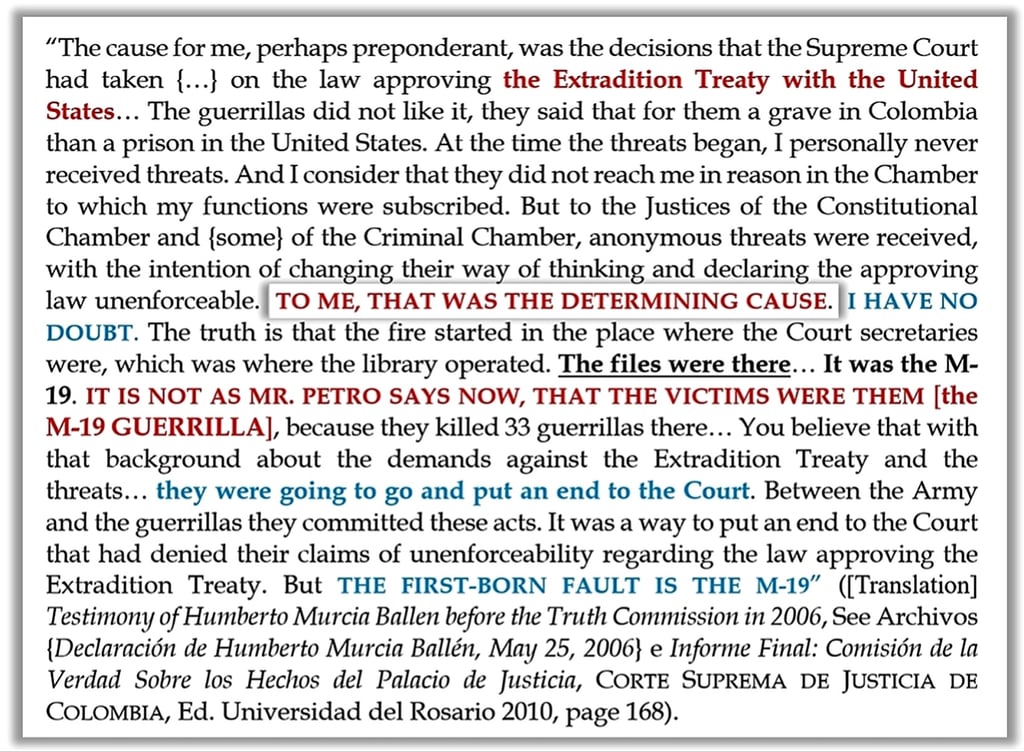

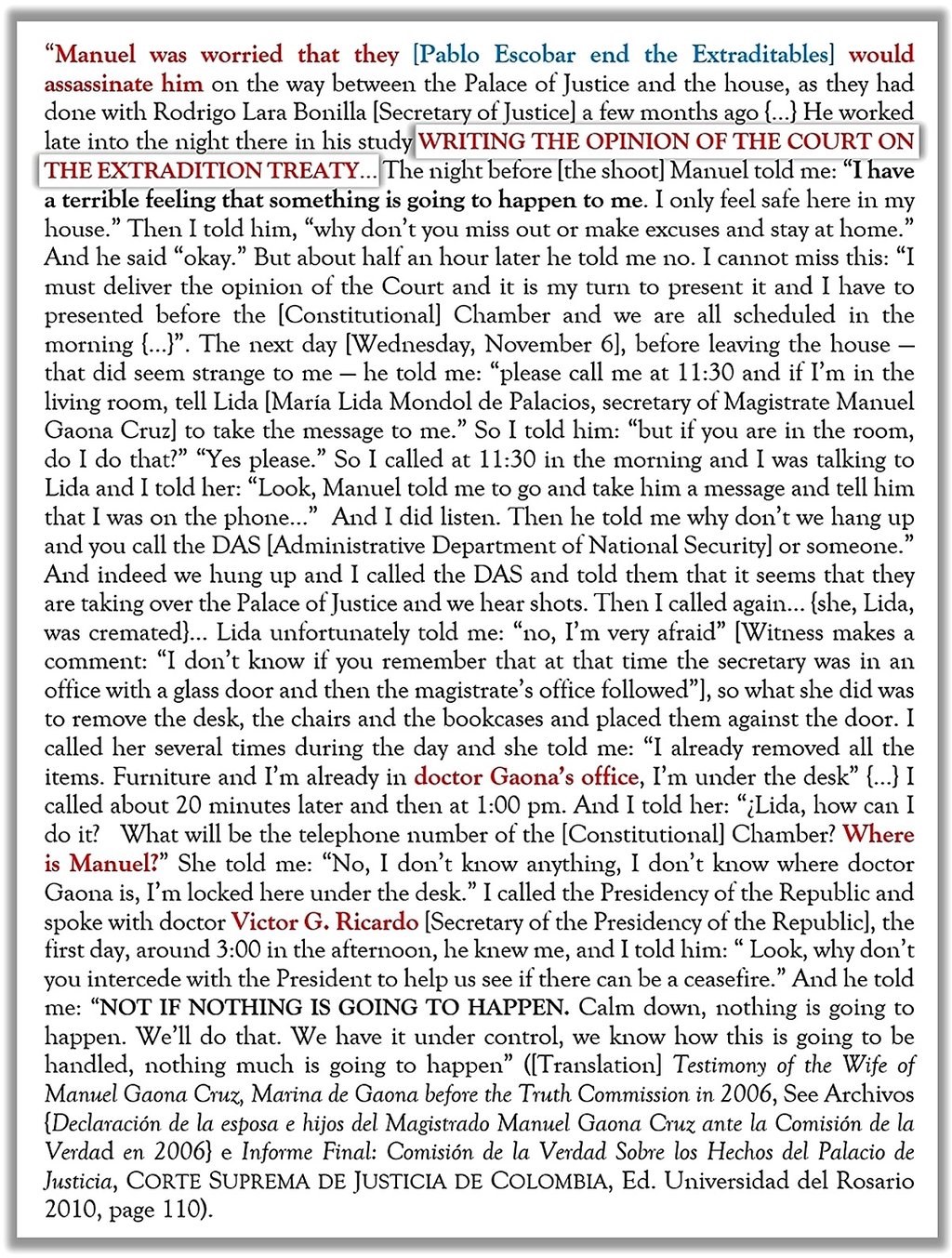

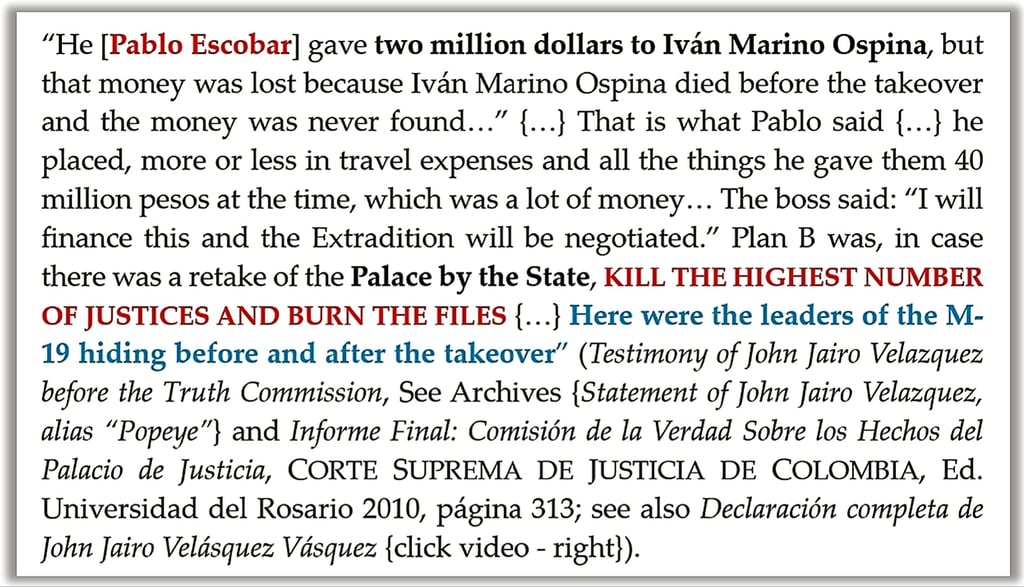

1. DECLARATIONS
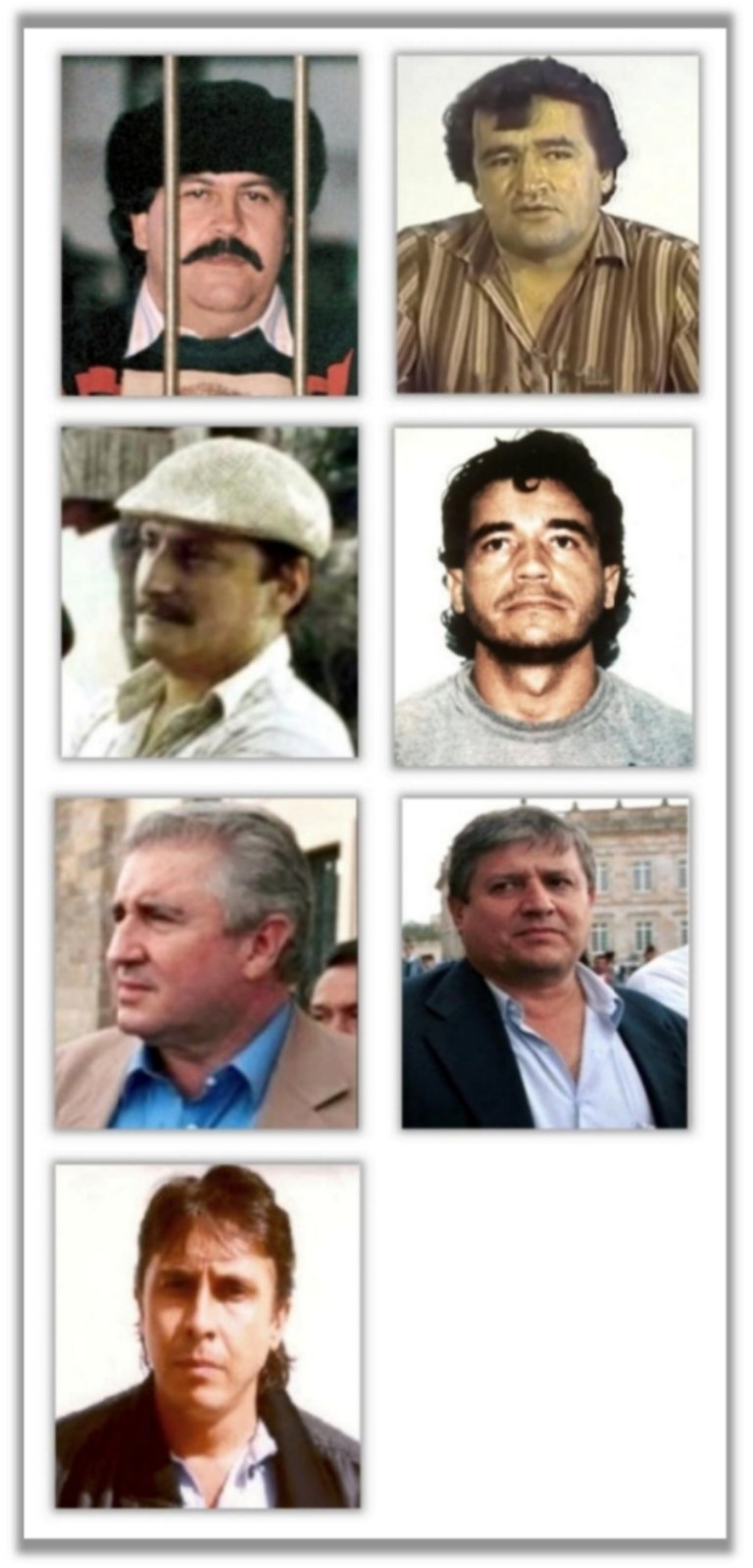

LOS EXTRADITABLES
Presented in descending order, from left to right are: Pablo Escobar Gaviria, Gonzalo Rodríguez Gacha, Gustavo Gaviria, Carlos Lehder, Jorge Ochoa, Luis Ochoa y Juan David Ochoa.
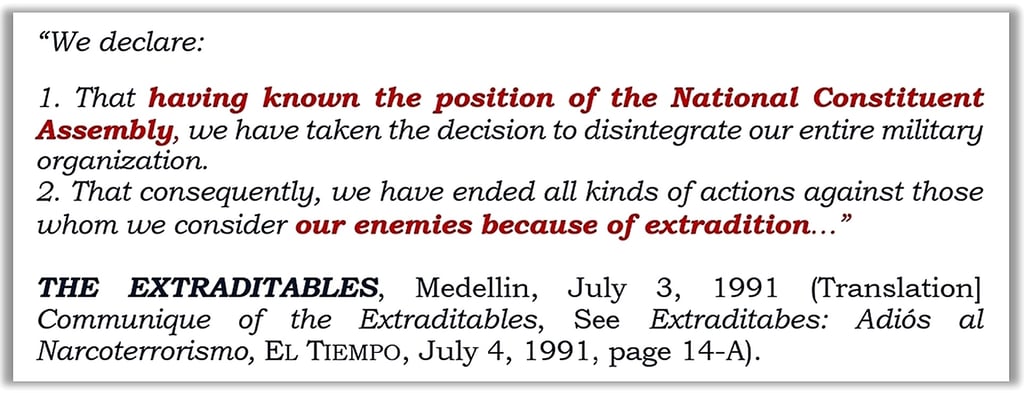



In a letter sent with his signature and fingerprint and addressed to the Commander of the National Directorate of Judicial Police and Investigation (DIJIN), Colonel Oscar Peláez Carmona, Pablo Escobar confessed and acknowledged his relationship with the leaders of the M-19, which he described as very close. The letter was published on May 1, 1990, on the front page of the Colombian newspaper, El Tiempo (See Declaración de Pablo Escobar Gaviria en 1990 y carta de Escobar a los medios de comunicación y al Comandante de la Dirección de la Policía Judicial e Investigación (DIJIN) in Yo Protegí al M-19: Escobar, EL TIEMPO, May 1, 1990, pages 1-A and 2-B; see also "Jefe del Cartel de Medellín Niega Que Ordenó Matar a Pizarro" [Medellín Cartel Boss Denies Ordering Pizarro Killed], LA OPINIÓN, May 1, 1990, page 8).
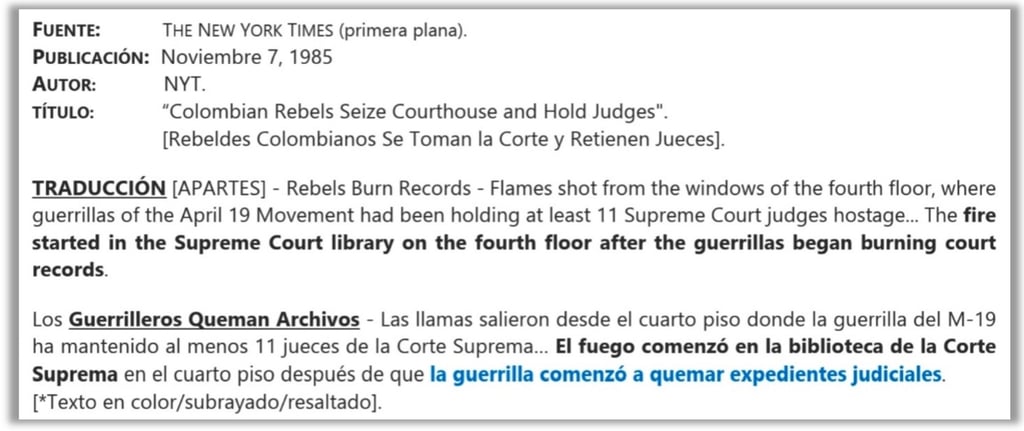

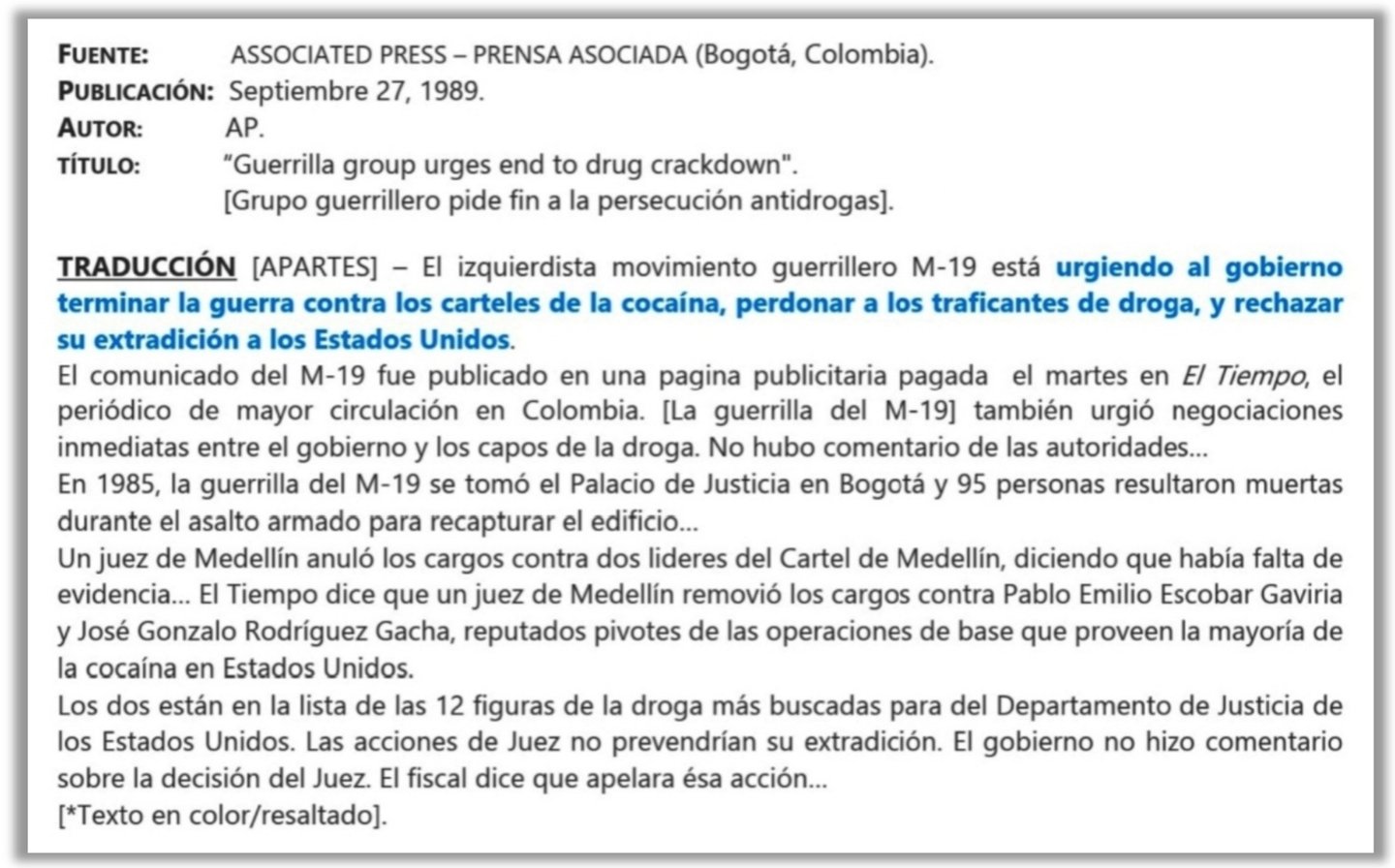

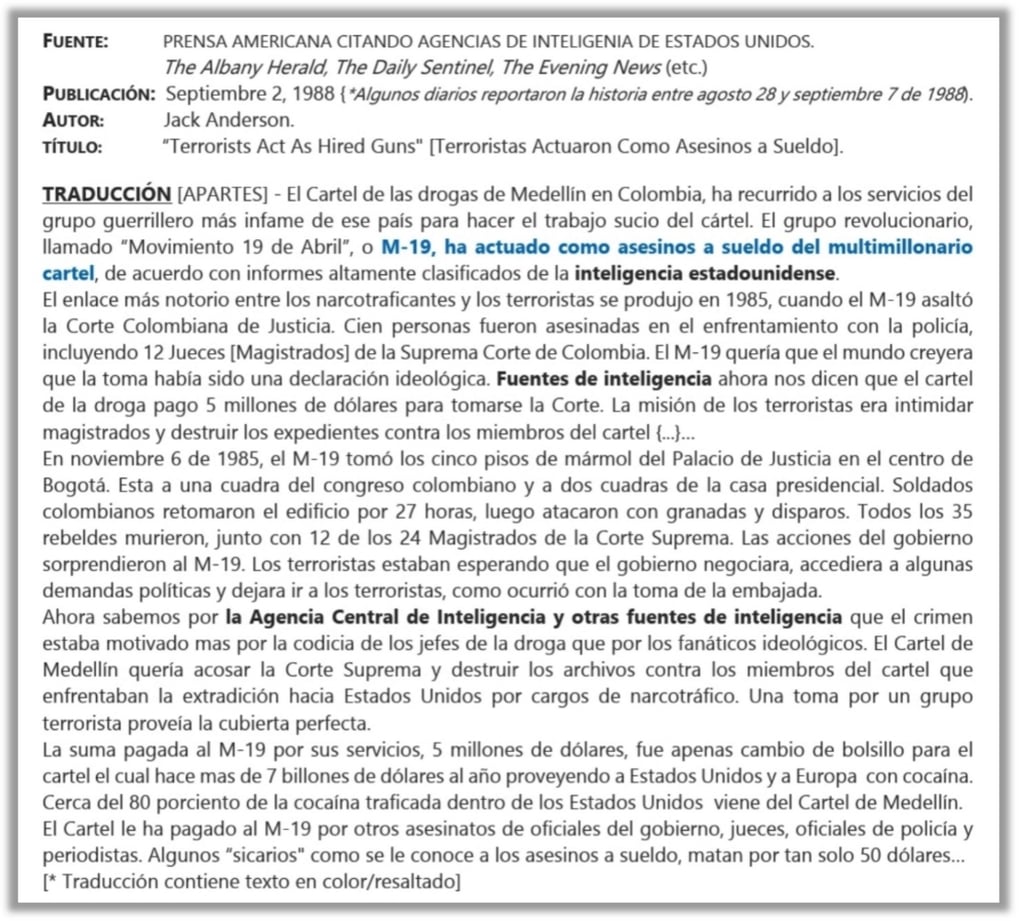

V. INVESTIGATIONS ON MANUEL GAONA CRUZ'S ASSASSINATION
VI. RESPONSIBILITY OF JUSTICE GAONA CRUZ'S ASSASSINATION
A. PUBLIC MINISTRY INVESTIGATION IN 1986
A. RESPONSABILITY OF THE M-19 GUERRILLAS
C. RESPONSIBILITY OF THE ARMY AND THE NATIONAL POLICE
B. RESPONSIBILITY OF PABLO ESCOBAR AND THE EXTRADITABLES
D. RESPONSIBILITY OF THE GOVERNMENT OF PRESIDENT BELISARIO BETANCUR
B. INVESTIGATION OF THE SPECIAL TRIBUNAL FOR CRIMINAL INVESTIGATION IN 1986
C. INVESTIGATION OF THE 77th COURT OF CRIMINAL INSTRUCTION OF BOGOTÁ 1986
D. INVESTIGATION OF COURT 30th OF CRIMINAL INSTRUCTION OF BOGOTÁ BETWEEN 1986 AND 1989
E. INVESTIGATION OF THE JUDGE OF PUBLIC ORDER IN 1992
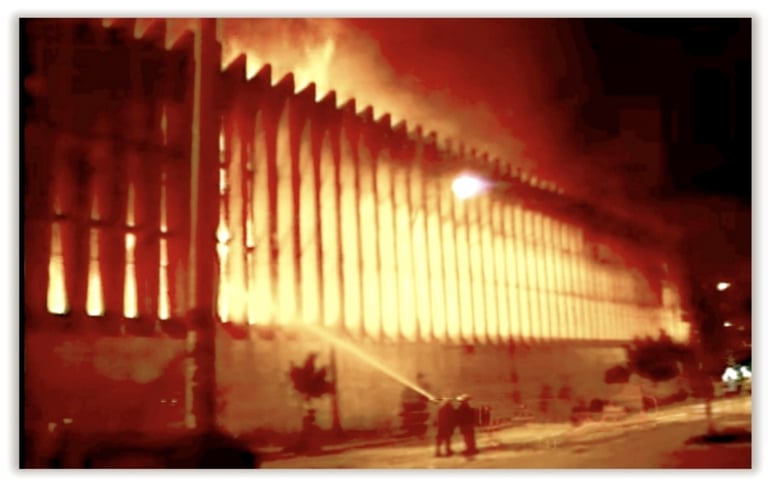

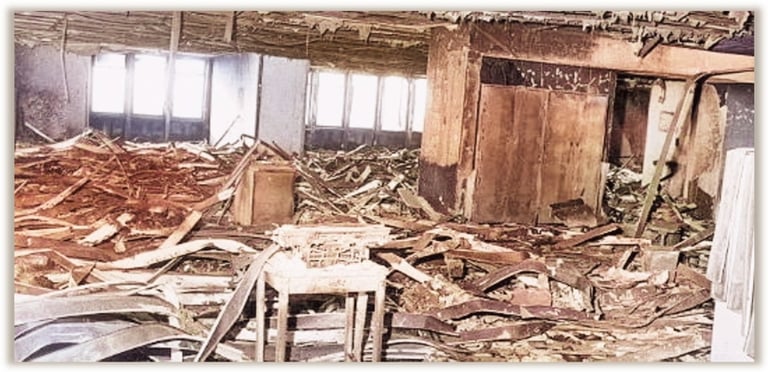

Supreme Court of Justice Library – Archive of Files where the evidence and judicial proceedings against Pablo Emilio Escobar Gaviria, the Medellín Cartel, and the Extraditables were stored.
Photos: International News Agency / Associated Press AP – November 6 {left} and 7 {right}, 1985.
Supreme Court of Justice (East Side) November 6, 1985.
Manuel Gaona Cruz was the first Supreme Court Justice the M-19 guerrilla group sought out and took hostage upon entering the Palace of Justice (See MGC Kidnapping – Testimonial Evidence), and he is the most widely known victim of the M-19 guerrilla. Details of his assassination became known and were disseminated by the national and international press within minutes of the ending of the retaking of the Palace of Justice on the afternoon of Thursday, November 7, 1985. The dozen eyewitnesses who, under oath, declared to Colombian authorities the cruel, inhuman, and cowardly manner of his assassination at the hands of the M-19 guerrilla, as well as the description several of them gave regarding the state of Justice Manuel Gaona Cruz's lifeless body at the site where the guerrillas executed him, are part of the collective memory of the Palace of Justice siege.
The Special Tribunal for Criminal Investigation (Tribunal Especial de Instrucción Criminal) was formed via Decree 3300 on November 13, 1985. Its report was published on June 17, 1986 (See Informe Final, TRIBUNAL ESPECIAL DE INSTRUCCIÓN CRIMINAL, Decreto 1917 de 1986, D.O. CXXII, No. 37509, June 17, 1986). In its report, the Tribunal presented a detailed account of the kidnapping and assassination of Justice Manuel Gaona Cruz by the M-19 guerrilla, indicating that: "Following the apprehension of Justice Gaona, and after overcoming all resistance from the bodyguards, the guerrillas were able to gather nine Justices as hostages in one place, submitting them, as previously stated, to the will of Commander Otero. Doctor Reyes Echandía himself {Chief Justice} confirmed this in his telephone conversation with General Delgado Mallarino when he informed him 'that he was in the company of eight Justices,' without naming them. With him were Justices Fabio Calderón Botero, Pedro Elías Serrano Abadía, and Darío Velázquez Gaviria of the Criminal Chamber; Carlos Medellín Forero, Ricardo Medina Moyano, and Alfonso Patiño Rosselli of the Constitutional Chamber; and José Eduardo Gnecco Correa and Fanny González Franco of the Labor Chamber. It should be noted that this number did not change, as Justice Nemesio Camacho Rodríguez, who was also on the fourth floor, was not discovered by the guerrillas, so, pressured by the fire, he descended the stairs and joined the group of hostages dominated by Commander Almarales." In its conclusions, the Tribunal further indicated that:
In 1989, the 30th Criminal Investigation Court of Bogotá (Juzgado 30 de Instrucción Criminal de Bogotá) issued an indictment resolution, naming as perpetrators of the crime of rebellion and co-perpetrators of the crimes of homicide, attempted homicide, and kidnapping the M-19 guerrillas Irma Franco Pineda and Clara Helena Enciso Hernández; the M-19 Central Command: Carlos Pizarro Leongómez and Antonio José Navarro Wolff; the members of the M-19 Superior Command: Germán Rojas Niño, Marco Antonio Chalita Valenzuela, José Otty Patiño Hormaza, Vera Grabe Loewenherz, Libardo Parra Vargas, Israel Santamaría Rendón, and Rosemberg Pabón Pabón; and the members of the M-19 National Directorate: Gustavo Francisco Petro Urrego, Jesús Arjaid Artunduaga Rodríguez, Evert Bustamante García, Rafael Arteaga Giraldo, José Yamel Riaño, Afranio Parra Guzmán, Remberto Artunduaga Palomares, Gerardo Ardila Serrano, Rafael Ernesto Vergara Navarro, Carlos Augusto Erazo Murcia, Eduardo Chávez López, Jaime Bermeo Cruz, Alix María Salazar Salazar, and María Rosalba Vásquez Martínez. Likewise, the 30th Court sent copies to the ordinary criminal jurisdiction so that an investigation could be carried out into the alleged responsibility of the armed forces (See Resolución de Acusación, JUZGADO 30 DE INSTRUCCIÓN CRIMINAL DE BOGOTÁ, decision of January 31, 1989, folio 2429).
The 77th Court of Criminal Investigation of Bogotá (Juzgado 77 de Instrucción Criminal de Bogotá) collected the most extensive body of evidence regarding the events at the Palace of Justice, with its archives containing all victim necropsies, ballistic studies, expert evidence on position and distance, documentary evidence (blueprints, photographs, reports, statements, official letters), and hundreds of testimonies. The judicial inspection ordered and carried out by the 77th Court focused primarily on the events in the bathroom where Justice Manuel Gaona Cruz was held and assassinated. According to this judicial inspection, Manuel Gaona Cruz was murdered by the M-19 guerrillas at the bathroom's exit; the technical ruling and graphic representation of the sequence of events indicate that the bodies of Auxiliary Magistrate of the Council of State José Gabriel Salom Beltrán and Supreme Court of Justice Manuel Gaona Cruz fell in front of the cleaning room door located at the exit of the bathroom lobby/hall on the stair landing between the second and third floors (See Inspección Judicial del Baño on the second and third floor, Northwest Side, of the Palace of Justice, JUZGADO 77 DE INSTRUCCIÓN CRIMINAL DE BOGOTÁ, Esc. 150, Folio 4, March 21, 1986).
In its decision, the 30th Court summoned the M-19 military leadership to trial for atrocious crimes and human rights violations that did not fit within the political crime of rebellion, and specifically accused the members of the M-19 guerrilla's national directorate, which included the former guerrilla leader and (today) President of Colombia, Gustavo Francisco Petro Urrego (See Decisión, ibídem; see also {video}, El Juez Que Ordenó Enjuiciar al M-19 [The Judge Who Ordered the Prosecution of the M-19], NOTICIAS CARACOL, November 2019, https://m.youtube.com/watch?v=pKLaaSicqYg; Comisión de la Verdad: Informe Final Sobre los Hechos del Palacio de Justicia [Truth Commission: Final Report on the Events of the Palace of Justice], CORTE SUPREMA DE JUSTICIA DE COLOMBIA, Ed. Universidad del Rosario 2010, pages 279 and 280).
In light of the official investigations conducted in Colombia, and particularly based on the testimonial and documentary evidence gathered over the last four decades, the kidnapping, cruel and inhuman treatment, and the assassination of Magistrate Manuel Gaona Cruz at the hands of the M-19 guerrilla group form the incontestable standard for a Crime Against Humanity (CAH). This crime is codified in Spanish and in the international treaties signed by Colombia as a delito de lesa humanidad (Article 7, literals {a}{h} of the Rome Statute of the International Criminal Court of 1998, which Colombia ratified on January 6, 2002). Its occurrence is also proscribed by the Principles of Distinction and Humanity that precede and inform International Humanitarian Law (IHL) (Article 3 "common to the four Geneva Conventions," 32, 33, and 34 of the 1949 Geneva Convention Relative to the Protection of Civilian Persons in Time of War, all ratified by Colombia on November 8, 1961, along with Geneva Protocol II of 1977 Relative to the Protection of Victims of Non-International Armed Conflicts, which Colombia ratified on August 14, 1995), as well as by the most basic human rights protections inherent to life, liberty, personal security, and the international prohibition against cruel and inhuman treatment (Articles 3 and 5 of the 1948 UN Universal Declaration of Human Rights). According to Article 7 of the Rome Statute, crimes against humanity are those
The Public Ministry of Colombia (Procuraduría General de la Nación), through its Delegated Office for Judicial Police (Procuraduría Delegada para la Policía Judicial), produced the first official report on the events that occurred during the Palace of Justice siege and the assassination of Justice Manuel Gaona Cruz at the hands of the M-19 guerrilla group. The report was presented on Friday, April 11, 1986. The report questioned the manner in which the Army and public forces managed the crime scene, preventing the judicial reconstruction of the events by moving all the bodies to the first floor of the Palace of Justice. The report concluded that it was not true that the Chief Justice had ordered the withdrawal of public forces two days before the siege. In relation to the homicide of JusticeManuel Gaona Cruz, the Public Ministry concluded that:

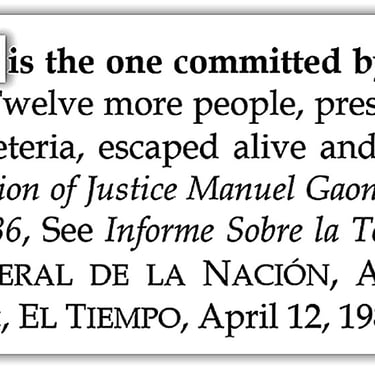
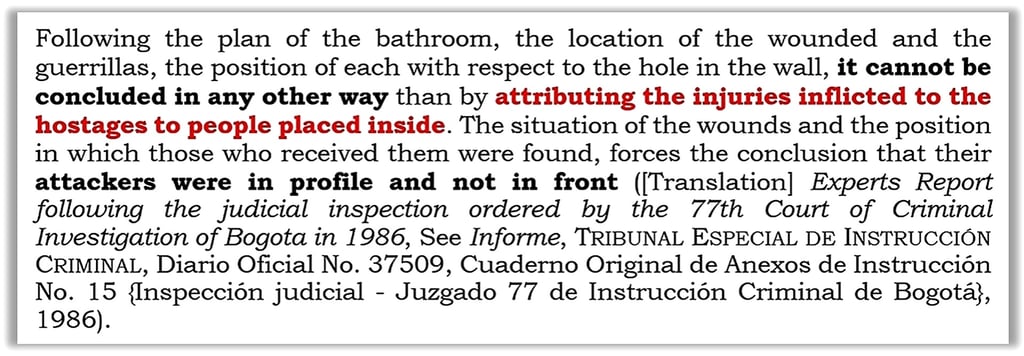

In relation to the homicide of Justice Manuel Gaona Cruz, the Tribunal concluded that:
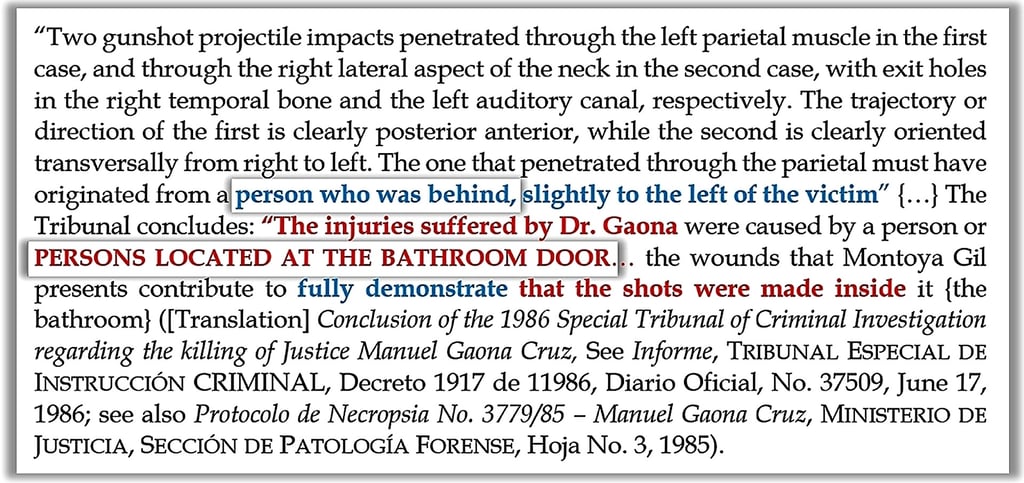


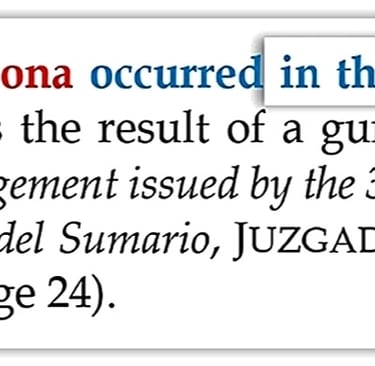
It should be noted, however, that neither the Truth Commission (Comisión de la Verdad) nor the Office of the Attorney General of the Nation (Fiscalía General de la Nación) shared the conclusions of the Special Tribunal regarding the disappeared individuals from the Palace of Justice and the lack of responsibility on the part of the government and the armed forces (Final Report – CSJ 2010, ibidem, page 266).

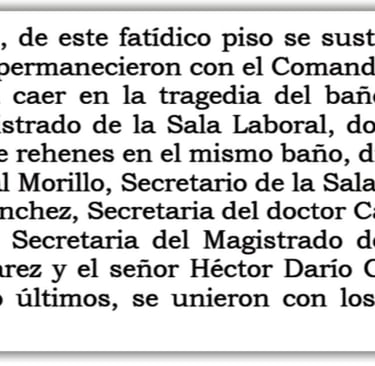
On May 15, 1992, Public Order Judge Clemencia García de Useche issued an indictment (medida de aseguramiento) against members of the M-19 guerrilla group for the crimes of "terrorism and arson." The Judge considered that these crimes were not subsumed under the crime of rebellion and could not be covered by the pardon granted by the government through Law 77 of 1989. The Judge issued an indictment against the M-19 leadership (Antonio José Navarro Wolff, Gustavo Francisco Petro Urrego, Germán Rojas Niño, Marco Antonio Chalita, Otty Patiño, Vera Grave, Libardo Parra Vargas, Rosemberg Pabón Pabón, Jesús Arjaid Artunduaga, Evert Bustamante, Rafael Arteaga, José Yamel Riaño, Roberto Artunduaga, Gerardo Ardila, Rafael Ernesto Vergara, Carlos Augusto Erazo, Eduardo Chávez, Jaime Bermeo Cruz, Alex María Salazar, Clara Elena Enciso, María Rosalba Vásquez, Jaime Navarro Wolff, Ramiro Lucio, Carlos Alonso Lucio) and sent copies to the Supreme Court of Justice to open proceedings against former President Belisario Betancur Cuartas and former Minister of Defense Miguel Vega Uribefor the retaking of the Palace of Justice and for possible violations of the American Convention on Human Rights of 1978. The ruling is part of the public memory regarding the Palace of Justice siege (See Héctor Hernández H., Justicia Al Holocausto [Justice to the Holocaust], EL ESPECTADOR, May 16, 1992).
In relation to the homicide of Manuel Gaona Cruz, the 30th Court of Criminal Instruction determined that Justice Gaona was assassinated inside the Palace of Justice:
Supreme Court of Colombia Wednesday 6 de noviembre de 1985


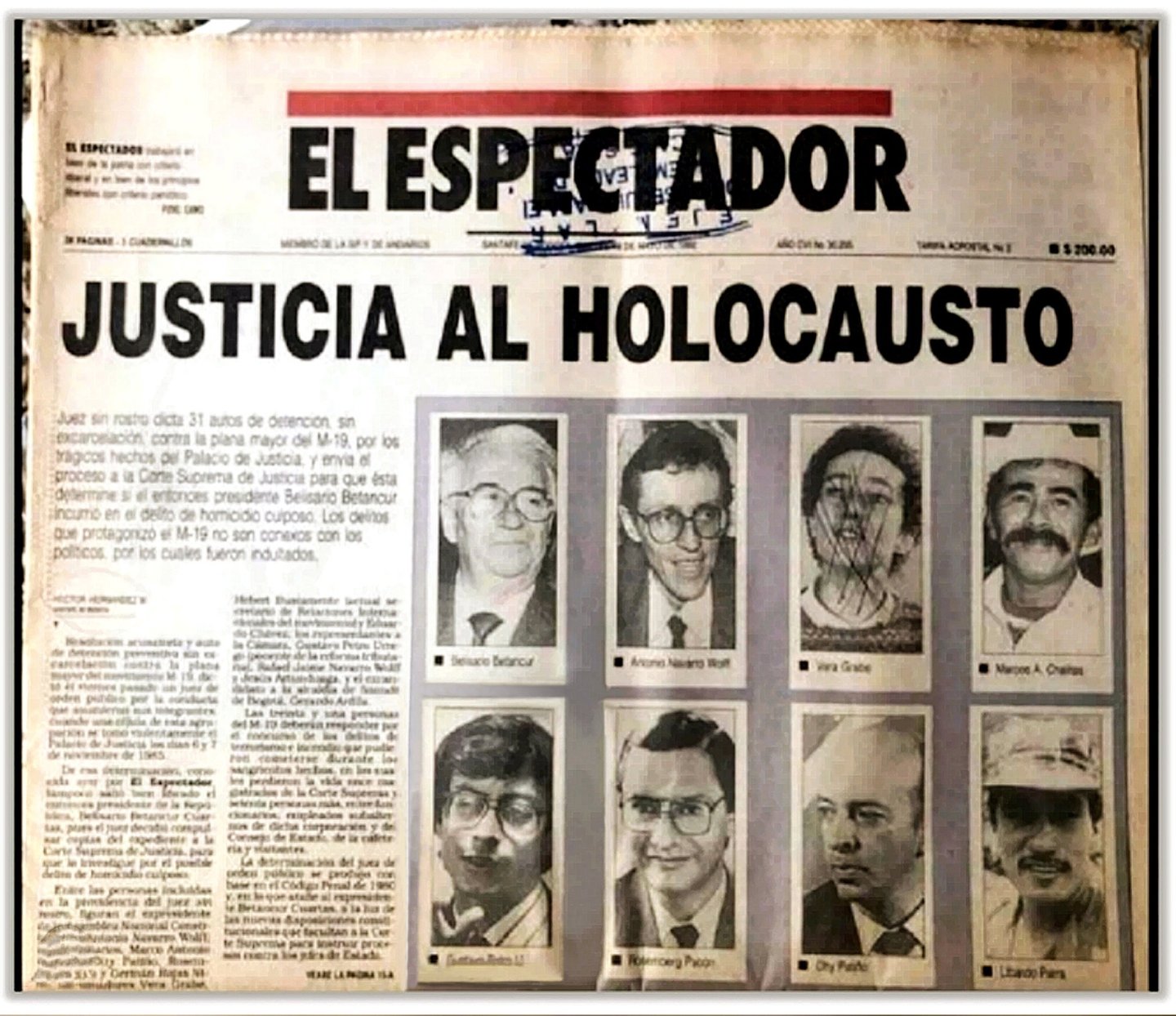

Following the political pardon granted by the Colombian Congress to the M-19 guerrilla group in 1990 (Law 77 of 1989), the Second Criminal Circuit Specialized Court of Bogotá (Juzgado Segundo Penal del Circuito Especializado de Bogotá) decreed the statute of limitations (prescripción penal) in favor of the M-19 members on November 19, 2009.

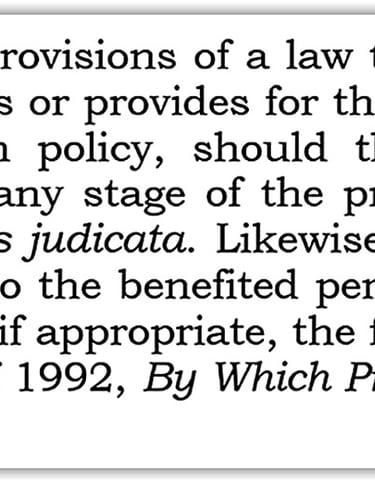
In 2010, the Criminal Chamber of the Superior Tribunal of Bogotá (Sala Penal del Tribunal Superior de Bogotá) issued a ruling partially revoking the statute of limitations (prescripción penal) that had been decreed by the Second Criminal Court of Bogotá (Juzgado Segundo Penal de Bogotá) in relation to the crimes of homicide and attempted homicide. The Chamber ruled that the crimes committed by the M-19 guerrilla group during the Palace of Justice siege constituted crimes against humanity and should be investigated as such, thus ordering the proceedings to be returned to the court of origin (See Sentencia del 8 de septiembre de 2010, SALA PENAL TRIBUNAL SUPERIOR DE BOGOTÁ, Expediente de prueba, folios 1749, 1758, 1760 and 1765).
F. RULING OF THE CRIMINAL CHAMBER OF THE SUPERIOR TRIBUNAL OF BOGOTÁ 2010
G. INVESTIGATION OF THE TRUTH COMMISSION ESTABLISHED BY THE SUPREME COURT OF COLOMBIA BETWEEN 2005 AND 2010
In 2010, following a rigorous and detailed analysis of the circumstances that preceded the kidnapping and assassination of Justice Manuel Gaona Cruz, the Truth Commission established by the Supreme Court of Justice of Colombia concluded that Manuel Gaona Cruz was executed with a shot to the head by the M-19 guerrillas toward the end of the siege, after refusing to serve as a human shield for the guerrillas who were pointing at him from the side and the back. In addition to considering the testimonies and statements of the hostages who were with Justice Gaona during the final moments (behind, beside, holding hands, underneath; testimonies of Hernando Tapias Rocha, Nemesio Camacho Rodríguez, Helena Gutiérrez Romero, Jorge Antonio Reina Orjuela, José Gabriel Salom Beltrán) and those who saw him lifeless after his execution before the siege ended and they exited the Palace of Justice (Humberto Murcia Ballén, Alba Inés Rodríguez, Jorge Antonio Reina Orjuela, Amanda Leal de Gallego, Hernando Tapias Rocha, José Gabriel Salom Beltrán), the Truth Commission collated the witnesses' versions with Justice Gaona's necropsy and the judicial inspection performed at the time by the Criminal Investigation Courts regarding the location of the hostages and the guerrillas, as well as the structure of the bathroom where they were held captive. The Truth Commission's conclusion regarding the crime of Justice Manuel Gaona Cruz is indubitable:

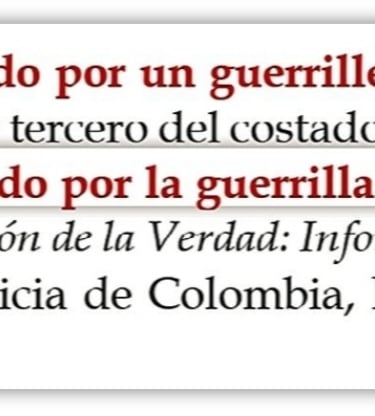
In its conclusions regarding the homicide of Magistrate Manuel Gaona Cruz, the Truth Commission (Comisión de la Verdad) also compared the factual sequence described by the eyewitnesses to the crime—José Gabriel Salom, Jorge Antonio Reina, Hernando Tapias Rocha, Nemesio Camacho Rodríguez, Lucía Bermúdez de Sánchez, and Humberto Murcia Ballén—against the necropsy performed by forensic medicine (medicina legal) on November 7, 1987. On this matter, the Commission stated in its Final Report:
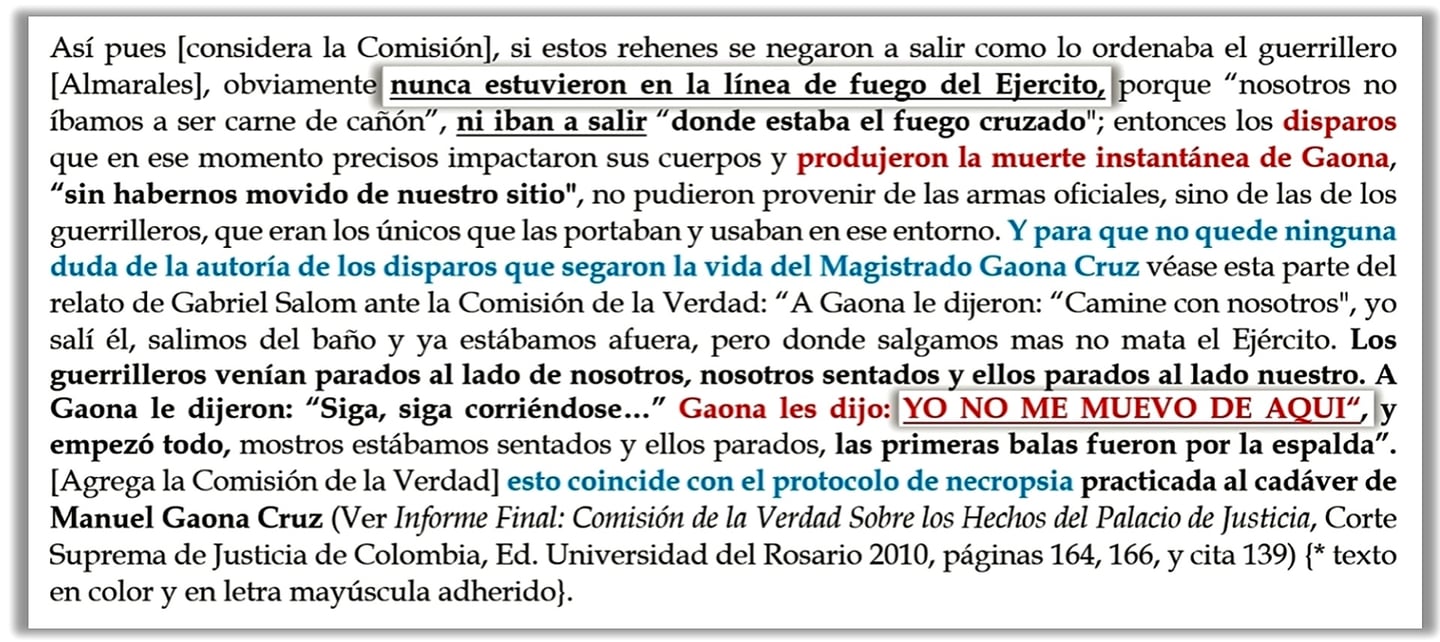


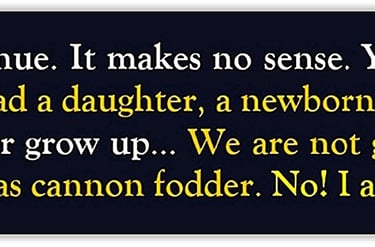
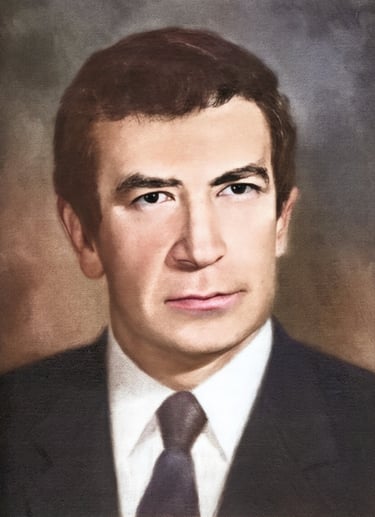

In 2013, the Office of the Attorney General of Colombia consolidated the investigations being carried out by the Second Criminal Court of Bogotá (Juzgado Segundo Penal de Bogotá) along with the investigations against the military operational command in charge of retaking the Palace of Justice. Although the Plenary Chamber of the Superior Tribunal of Bogotá qualified the homicides committed by the M-19 guerrilla group as crimes against humanity and ordered that the criminal investigations continue, the Office of the Attorney General of Colombia never produced a single indictment against the members of the M-19. Its investigations focused primarily and exclusively on the actions and omissions of the military commanders and the armed forces.

Official investigations point to the M-19 guerrilla group led by Andrés Almarales Manga as the material perpetrator of Manuel Gaona Cruz's assassination, while the evidence presented, along with the Final Report of the Truth Commission, reveal the incontestable participation of Pablo Escobar and the Extraditables as the intellectual authors of the crime. However, by action and omission, it should be noted that the responsibility for the crime against humanity of Justice Manuel Gaona Cruz, in light of applicable international law, is four-sided, placing the M-19 guerrilla group and the Extraditables as the direct perpetrators, and the armed forces that intervened in the retaking of the Palace of Justice and the Government of President Belisario Betancur Cuartas as the indirect perpetrators.
International jurisprudence developing the doctrinal and normative provisions of the Rome Statute of the International Criminal Court and the Geneva Convention on Crimes Against Humanity (CAH) requires that, in addition to the commission of criminal acts during the attack on the civilian population, the attack must be widespread or systematic to merit the CAH classification. However, it should be noted that the widespread nature (generalización) of the attack is not inferred from a minimum number of victims, but from the plurality of civilian victims previously selected as the objective of the armed action and regardless of its political-military justification (Timor Blaškić, INTERNATIONAL CRIMINAL TRIBUNAL—FORMER YUGOSLAVIA, Case No. IT-95-14-A, AJ Appeal, July 29, 2004). Unlike systematic attacks against the civilian population, widespread attacks do not need to be recurrent (Radoslav Brdan, INTERNATIONAL CRIMINAL TRIBUNAL—FORMER YUGOSLAVIA, Case No. IT-99-36-T, TJ Decision of September 1, 2004). For an attack to be "widespread"—and thus qualified as a crime against humanity—it is sufficient for it to result in even a single crime ("one single homicide"), provided that the crime occurs during and on the occasion of the attack against the civilian population previously selected as the military or armed objective (Radoslav Brdan, ibídem). The number of victims, the position or status of the victim(s), civilian resistance to the attack, and the discriminatory selection of victims constitute legal criteria for determining the widespread or systematic nature of the attack (Blaškić, ibídem). In the case sub judice, the seizure of the Palace of Justice of Colombia resulted in a hundred victims, and Manuel Gaona Cruz was selected by the guerrilla group due to his position as a magistrate of the Supreme Court of Justice's Constitutional Chamber, to the extent that he was the first magistrate the guerrillas sought and took as a hostage, as noted in several testimonies ("They first looked for the magistrates of the Constitutional Chamber saying, Manuel Gaona Cruz, come out!"; "They didn't look for us," see MGC Muerte – Pruebas Testimoniales [Hernando Tapias Rocha, Ricardo Correal Morillo, Lucía Bermúdez de Sánchez]). The evidence presented also indicates that there was civilian resistance (guards from the Cobisec Ltda company, drivers, and escorts) aimed at repelling the M-19 guerrilla attack at the beginning of the siege. The evidence also indicates that the M-19 guerrillas entered shooting and killing anyone who resisted, meaning their first victims were part of the plan and the general scheme of the attack on the civilian population (e.g., civilians who were in the Palace of Justice and were not part of the armed conflict). Regarding this matter, and according to the Final Report of the Truth Commission:
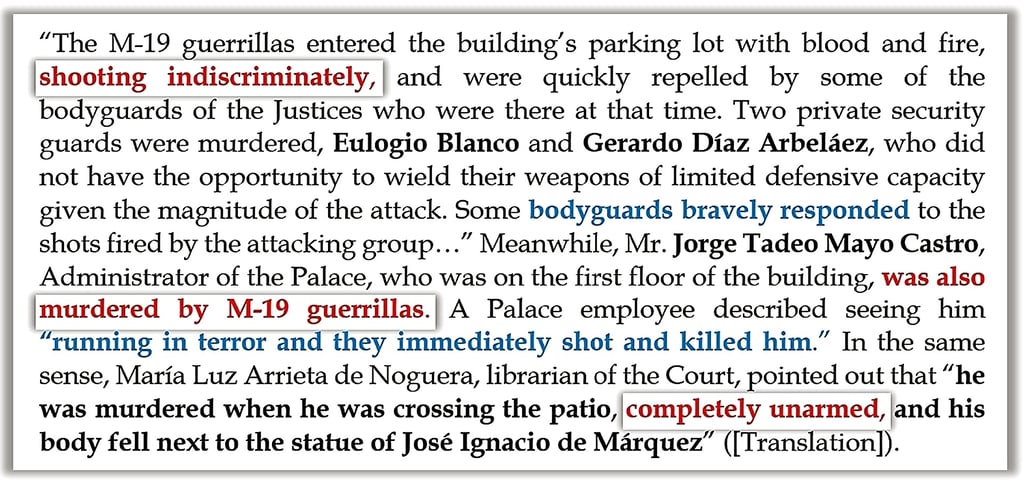

Sobre los Hechos del Palacio de Justicia, CORTE SUPREMA DE JUSTICIA DE COLOMBIA, Ed. Universidad del Rosario 2010, pages 320 y 324), and (iii) the armed group had articulated, either explicitly or implicitly, its intention to attack the selected civilian population (e.g., threats from guerrilla leader Alfonso Joaquín Guzmán against Supreme Court President Alfonso Reyes Echandía on November 6 and from guerrilla leader Andrés Almarales Manga against Justice Manuel Gaona Cruz on November 7, 1985).
The International Criminal Court (ICC) has repeatedly indicated that non-state armed actors commit crimes against humanity when they attack the civilian population (e.g., Situation in the Republic of Kenya, INTERNATIONAL CRIMINAL COURT, Case No. ICC-01/09-01/1, PT Chamber II, March 6, 2011), particularly when the armed action is intended to either promote or reject a State policy (e.g., the 1985 seizure of the Palace of Justice, "The Extradition Treaty," see Kunurac et al., id.); moreover, out of the legally established criteria for determining whether a non-state armed group ("M-19 guerrilla") can commit crimes against humanity, at least three of them apply directly to the case of the guerrilla attack on the Palace of Justice: these are, specifically: (i) the group perpetrating the attack possesses a hierarchy and follows an identifiable operative command (in the attack on the Palace of Justice, the M-19 guerrillas Álvaro Fayad, Luis Otero, and Andrés Almarales Manga), (ii) the group possesses sufficient means to carry out the widespread attack against the selected civilian population (the evidence shows that the M-19 guerrilla possessed Claymore mines, cumulative bombs, rifles, pistols, automatic weapons, explosives, and grenades, see Informe Final: Comisión de Ia Verdad

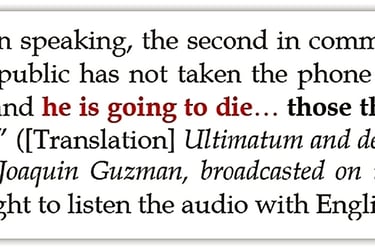
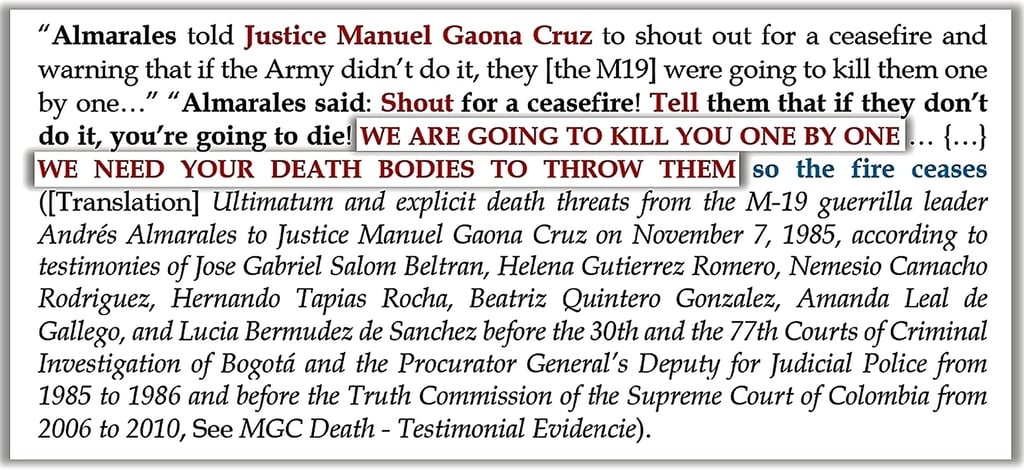

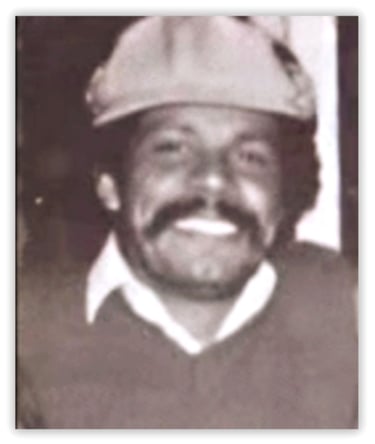

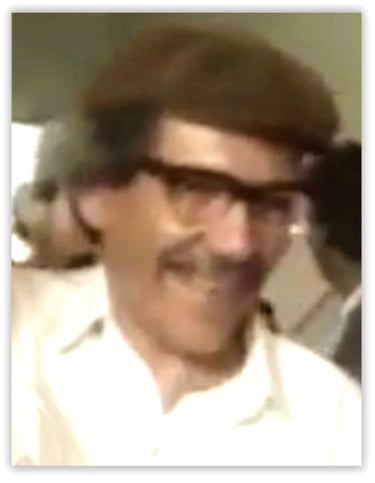

Alfonso Joaquín Guzmán M-19 guerrilla leader (second-in-command)
Andrés Almarales Manga was an M-19 guerrilla in command of the hostages on the third floor, who ordered the execution of Magistrate Manuel Gaona Cruz.

In light of the International Criminal Court's jurisprudence, there must also be a causal link between the commission of the crime, specifically the kidnapping and murder of Justice Manuel Gaona Cruz, and the widespread armed attack, which was the M-19 guerrilla attack on the Palace of Justice, a link that emerges inevitably when the nature or consequences of the crime solidify the attack’s objective (Mile Mrkšić et al., INTERNATIONAL CRIMINAL COURT, Case No. IT-95-13/1-A, Appeals Judgment, May 5, 2009); in this particular case, a clearly identifiable causal link existed between the kidnapping and murder of Manuel Gaona Cruz, who was Justice of the Constitutional Chamber of the Supreme Court of Colombia, the author of the intermediate thesis that prevented the Extradition Treaty from being declared unconstitutional, and the reporting magistrate on the day and time of the guerrilla attack, and one of the central objectives announced by the M-19 guerrilla itself upon entering the Palace of Justice, which was to obtain the declaration of unconstitutionality of the Law Approving the Extradition Treaty (see MGC Death – Documentary Evidence: Demand and Proclamation of the M-19 upon Entering the Palace of Justice). The causal link further requires that the armed group intend to perpetrate the crime, such as kidnapping and, if necessary, executing Justice Manuel Gaona Cruz, as part of the widespread attack on the selected civilian population, which consisted of the Magistrates of the Constitutional Chamber of the Supreme Court of Justice; furthermore, the evidence shows that Justice Manuel Gaona Cruz was the first justice the M-19 guerrilla sought out, and when he offered to leave the bathroom to deliver a message to the government, the response from guerrilla leader Almarales was stark and revealing: “No, you are not leaving here!" The evidence also indicates that when Justice Manuel Gaona Cruz repeatedly tried to appeal to the guerrilla leader’s humanity to let him leave alive and see his newborn daughter grow up, guerrilla leader Andrés Almarales responded mercilessly: “Almarales aimed his weapon at him and shouted: Shut up, Magistrate! Shut up, Magistrate, or you will die! Shut up, Magistrate, don’t you dare! [expletives]” (See MGC Death – Testimonial Evidence: Carmen Elisa Mora Nieto). Moreover, eyewitnesses to the M-19 guerrilla’s crime against Justice Manuel Gaona Cruz describe in detail the execution of the magistrate toward the end of the takeover, when there was no longer any option for the guerrilla group to meet any of its demands (Hernando Tapias Rocha, Nemesio Camacho Rodríguez, Helena Gutiérrez Romero, Jorge Antonio Reina, José Gabriel Salom Beltrán, id.); the evidence also demonstrates that after the murder of Justice Manuel Gaona Cruz and the Constitutional Chamber Justices who had supported him in defending the intermediate thesis before the Plenary Chamber of the Court — a thesis that prevented the law approving the Extradition Treaty from being declared unconstitutional on four occasions (Carlos Medellín Forero, Alfonso Patino Rosselli, and Ricardo Medina Moyano)—no other Magistrate of the Supreme Court of Justice of Colombia dared to oppose the demands of the M-19, Pablo Escobar, and the Medellín Cartel regarding extradition, to the point that the following year, and after assassinating the last magistrate of the Criminal Chamber who supported the intermediate thesis, Hernando Vaquero Borda, the new Supreme Court of Justice declared the law approving the Extradition Treaty non-aplicable ("inexequible"), citing defects in the form of its signature and thereby reversing the Constitutional Chamber's jurisprudence (CSJ, Plenary Chamber, M. P. Jairo E. Duque Pérez, Judgment N° 111, December 12, 1986, indicating: “Resolves: To declare unconstitutional Law 27 of November 3, 1980, by which the Extradition Treaty between the Republic of Colombia and the United States of America, signed in Washington on September 14, 1979, was approved, inasmuch as it was not constitutionally sanctioned by the President of the Republic"). Finally, the evidence incontrovertibly shows that it was precisely the M-19 who, acting under the name "Alianza Democrática M-19," promoted the constitutional reform to prohibit the extradition of Colombian drug traffickers in 1990, while publicly advocating to the government in power for a halt to the persecution of Pablo Escobar and the other drug lords (See MGC Death – Documentary Evidence: Press Reports); therefore, the causal link between the kidnapping and murder of Justice Manuel Gaona Cruz as part of the 1985 Palace of Justice takeover and the eventual declaration of the Extradition Treaty's unconstitutionality is precedent, concomitant, subsequent, consequent, conclusive, and historically irrefutable.
Furthermore, the International Criminal Court has maintained that in addition to the characteristics, nature, and consequences of the crime committed (Mrkšić et al., ibidem), the causal link emerges incontestably when there are similar crimes—such as homicides and kidnappings of other civilians—perpetrated by the armed actor within the generalized attack on the selected civilian population (e.g., the homicides of private security guards Eulogio Blanco and Gerardo Díaz Arbeláez, Palace administrator Jorge Tadeo Mayo Castro, drivers Plácido Barrera Rincón and Luis Humberto García, and several bodyguards, alongside the kidnapping of at least 400 civilians during the M-19's takeover of the Palace of Justice, see Informe Final: Comisión de la Verdad Sobre los Hechos del Palacio de Justicia, SUPREME COURT OF JUSTICE OF COLOMBIA, Ed. Universidad del Rosario 2010, pages 113 and 114). The Court has reiterated in its jurisprudence of principle (international precedent) that the intent (mens rea) to commit a particular crime (e.g., the kidnapping and eventual execution of Justice Manuel Gaona Cruz) does not need to be known or publicly exposed; rather, it is sufficient that the intent to commit the generalized attack on the selected civilian population is known (Mitar Vasiljević, INTERNATIONAL CRIMINAL COURT, Case No. IT-98-32-A, Appeals Judgment, February 25, 2004). The ICC further states in its ruling that criminal intent can be inferred from the relevant facts and the circumstances of the manner, time, and place (Vasiljevic, ibidem, para. 3, “Elements of the Crime”); the physical execution of the particular criminal act (actus reus) related to crimes against humanity arises either from a specific crime occurring during and within the generalized attack on the selected civilian population or as a result of a crime executed collectively (e.g., "Firing Squad Walls," see MGC Death – Testimonial Evidence: Justice Nemesio Camacho Rodríguez). It should be noted, however, that collective execution does not require a specific number of victims to be categorized as a crime against humanity, but rather a determined discrimination of victims whose undeniable selection subsumes the criminality of the act and its intent (Milomir Stakić, INTERNATIONAL CRIMINAL COURT, Case No. IT-97-A, Appeals Judgment, March 22, 2006). In the case of the attack on the Palace of Justice in Colombia, the decision by guerrilla leader Almarales to separate the hostages into employees and magistrates, and then order the magistrates to stand in front of the guerrilla group pointing their weapons at them like a "practical firing squad wall" (Testimony of Justice Nemesio Camacho Rodríguez, id.) before ordering their execution, constitutes irrefutable evidence of a crime against humanity and a flagrant and inexcusable violation of International Humanitarian Law (IHL), specifically the Principle of Distinction. The violation of Justice Gaona's dignity and humanity transcends International Humanitarian Law by using him as a "human shield," an unequivocal categorization that stems both from the place where Magistrate Gaona was ordered to stand—again, due to his importance as the only surviving Constitutional Chamber magistrate at the end of the takeover—and from what he was ordered to do before his execution: to exit, leading the hostages toward the Army's crossfire while the guerrillas pointed their weapons at his head and back, and the victim warned his captors that they were about to commit a murder (See MGC Death – Testimonial Evidence: Testimony of José Gabriel Salom Beltrán).
In the words of Justice Manuel Gaona Cruz:
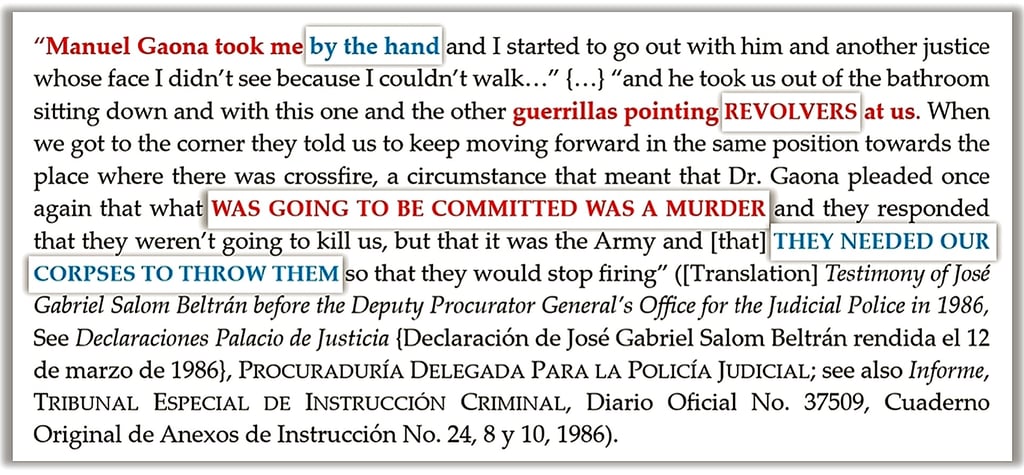

In its final report, the Truth Commission established by the Supreme Court of Justice of Colombia stated:
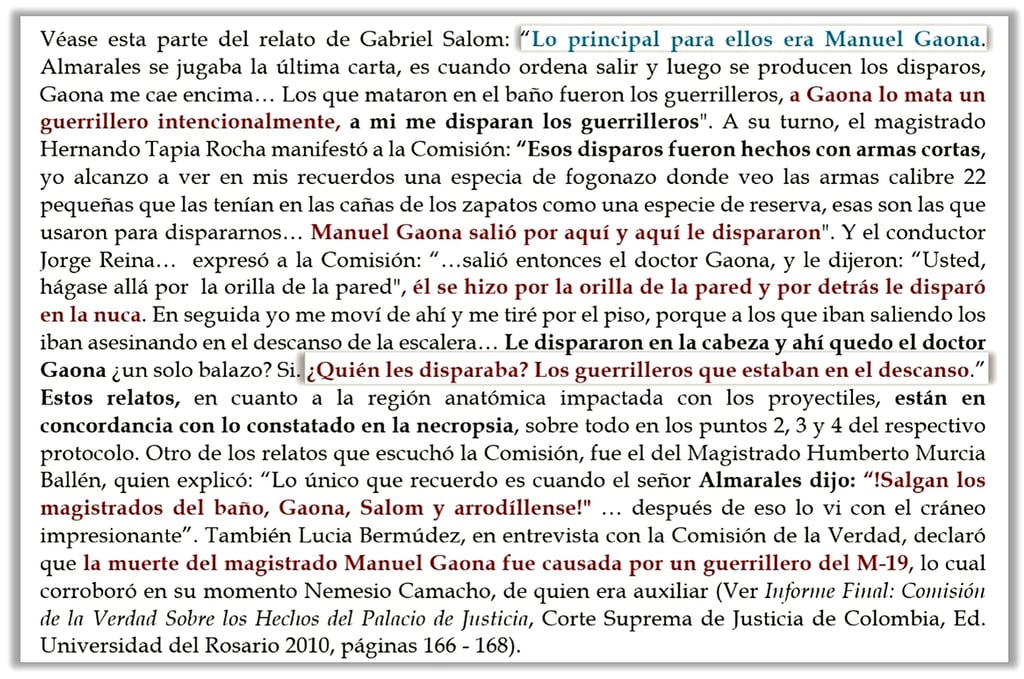

Regarding the violations of International Humanitarian Law (IHL) committed by the M-19 guerrilla in the Palace of Justice takeover, the use of innocent civilians and the seizure of civilian installations—including courts of justice which are considered, by both Customary and International Humanitarian Law, as civilian and not military institutions—to execute operations of a military nature (hostage-taking, riots, homicides, or use of military-grade weapons) constitute a violation of the governing principle of IHL known as the Principle of Distinction, which imposes on armed actors in a conflict the inexcusable obligation to differentiate between civilians and combatants during the planning and execution of their armed action; this international prohibition extends to the use of civilians to achieve the military or political objectives of the parties in conflict, and by virtue of this principle, "homicide, torture... [or] any other cruel treatment..." are specifically prohibited (Article 32 of the 1949 Geneva Convention Relative to the Protection of Civilian Persons in Internal Armed Conflicts). Consequently, even if the purported political motive of trying a democratically elected president in a state of law existed, it loses its legal nature and entity as a political act when its planning and execution involve the collective kidnapping and homicide of innocent civilians extraneous to the conflict it provokes, as well as the use of violence to forcefully seize a civil institution where neither the cause of the conflict (the M-19 peace process or its non-compliance) originated, nor was the alleged political-military objective present (the president the M-19 supposedly wanted to try), nor did it possess the institutional power to settle or resolve such a conflict, especially considering that under the 1886 Colombian Constitution (applicable at the time), the Supreme Court of Justice had no jurisdiction to try the president of the Republic for political crimes or to grant pardons to armed groups, as these powers were constitutionally reserved to Congress. To be considered a political act, the action must exhibit, at the very least, a causal relationship between the conflict and the "political" aim sought; the moral integrity of the magistrates is not even circumstantial to the conflict that supposedly motivated the 'political' takeover of the Palace of Justice, nor is the moral integrity and character of the Supreme Court Justices related to the political conflict between the Betancur Government and the M-19 guerrilla group, and the moral integrity and impartiality that the magistrates of the time might have offered (as a justification put forth by the M-19 for choosing the Palace of Justice) do not justify the kidnapping or murder of the justices, nor the kidnapping and death of the hundreds of innocent civilians that the planning and execution of the takeover eventually and directly affected. The foregoing analysis is, of course, presented in light of International Humanitarian Law (IHL), which, according to the International Criminal Court and the International Court of Justice in The Hague, applies in civilized nations; from the perspective of Public International Law, and particularly considering the selection of a civilian installation as the target of the armed action, the guerrilla attack on the Palace of Justice was not and cannot be categorized as a political act, as its planning, execution, and result exhibit it in history as a crime against humanity and a flagrant violation of International Humanitarian Law (IHL). It is also necessary to recall that the jurisprudential reception of the internal law of the Colombian State considers acts against the civilian population that cause severe physical harm, dismemberment, or chronic trauma, as well as attacks on the mental and physical health of persons, to be crimes against humanity (CONSTITUTIONAL COURT OF COLOMBIA, Sentence C 379-13, August 28, 2013). On Thursday, November 7, 1985, the then-Congressman Héctor Horacio Vargas entered the Palace of Justice an hour after the takeover ended and declared to the press and judicial authorities (Criminal Investigation Judges, Public Order Judge, and Special Criminal Investigation Tribunal) that: "The scenes were Dantean... We saw many bodies, completely charred. Only the spinal column, or the bones of the legs or the pelvic region, were barely distinguishable." In its essence and circumstance, the Principle of Humanity that structures the fundamental reason and premise of IHL was also violated, namely: to protect the humanity of civilian victims who are not involved in the hostilities of the armed action.
According to International Humanitarian Law (IHL), in the context of an internal armed conflict, the parties in conflict are obligated to respect the most fundamental rules of distinction, humanity, proportionality, and necessity, the first of which unambiguously prohibits the taking of hostages: "The taking of hostages is prohibited" (Article 34 of the 1949 Geneva Convention Relative to the Protection of Civilian Persons in Internal Armed Conflicts). International law likewise prohibits intimidation, terrorism, and reprisals against civilian victims in internal armed conflicts, establishing the inescapable predicate that: "Collective punishments, as well as all measures of intimidation or of terrorism... are prohibited... Measures of reprisal against protected persons are prohibited..." (Article 33 of the 1949 Geneva Convention Relative to the Protection of Civilian Persons in Internal Armed Conflicts). Similarly, Customary International Law stipulates that, by virtue of the Principle of Distinction between combatants and civilians, attacks may only be directed against combatants, and "civilians must not be attacked" (Legality of the Threat..., INTERNATIONAL COURT OF JUSTICE, Advisory Opinion ICJ, Reports 1996, para. 79). As noted, on May 15, 1992, Public Order Judge Clemencia García de Useche determined that the members of the M-19 guerrilla group incurred the crimes of "terrorism and arson." The Judge further considered that these crimes were not covered by the pardon granted by the government through Law 77 of 1989, and therefore issued 31 detention orders without the benefit of release against the M-19 leadership, including the current President of Colombia and former M-19 guerrilla leader, Gustavo Francisco Petro Urrego (See MGC Death – Documentary Evidence: Press Reports {"El Espectador," "W Radio"}).
Finally, the Principle of Humanity was violated in the 1985 attack on the Palace of Justice; this principle has been recognized as an unalterable pillar in the legal architecture of International Humanitarian Law (IHL) since its insertion in the Nuremberg Tribunal Trials of 1945 and 1946, which led to the principles that govern the United Nations Charter today (See Principles of International Law Recognized in the Charter of the Nuremberg Tribunal of 1950 adopted by the International Law Commission of the United Nations in its second session of 1950, YEARBOOK OF THE INTERNATIONAL LAW COMMISSION 1950, vol. II, para. 97 Principle VI, (a) "Crimes Against Peace," (c) "Crimes Against Humanity"). Thus, the human rights violations and atrocities committed by the M-19 guerrilla in the Palace of Justice takeover in Colombia are incontestable, as they involve outright violations of the governing norms of the Geneva Conventions upon which International Humanitarian Law (IHL) is structured (Article 3, numeral 1, literals a, b, c, "Common" to all the Geneva Conventions of 1949), the ontological provision of which establishes, as a minimum, among others, the international prohibition against: "... not including persons taking no direct part in the hostilities." In this regard, the norm states, "the following acts are and shall remain prohibited at any time and in any place..." [The original text cuts off here, but this is the translation of the provided portion].
(a) Attacks on life and physical integrity, especially homicide in all its forms, mutilation, cruel treatment, torture, and torment.
(b) The taking of hostages.
(c) Outrages upon personal dignity, especially humiliating and degrading treatment.
Beyond standing as inseparable evidence of a crime against humanity, the 40 years of evidence preceding this analysis, which describe in detail the cruel and inhumane treatment suffered by Justice Manuel Gaona Cruz at the hands of his captors, as well as his kidnapping and murder by the M-19 guerrilla, are an ineluctable proof of the history of the Palace of Justice takeover and the undeserved end of the master and magistrate. In the year 2025, the history of the Palace of Justice, which several are trying to rewrite, edit, and erase today, shows that Manuel Gaona Cruz was kidnapped and held hostage by the M-19 guerrilla on Wednesday, November 6, 1985, around 11:55 in the morning and, as the evidence expresses, he was the first Justice the M-19 guerrilla sought and kidnapped in the Palace of Justice takeover. The torments and the cruel and inhumane treatment suffered by Magistrate Gaona Cruz were described by the half-dozen witnesses who observed his crime at the hands of the M-19, and the testimonies of the survivors of the barbarity are part of the nation's public memory, with their voices being the echo of history that cannot be rewritten. In the ductile effect of time, it is also observed that, in fact, the crimes against humanity and the violations of international humanitarian law, not the political act, are everywhere; specifically, the M-19 guerrilla group:
(a) From the planning of the Palace of Justice takeover, it selected civilians who were not related to the hostilities of the conflict and who were explicitly discriminated against in the armed attack on the Palace of Justice of Colombia, such as Supreme Court Justices, and along with them, adjacent to the premeditated selection of civilian victims, hundreds of judicial branch officials who worked there;
(b) It assassinated drivers, bodyguards, security guards, the building administrator, and magistrates of the Supreme Court of Colombia, among whose victims were, among others, Eulogio Blanco, Édgar Gerardo Díaz Arbeláez, Jorge Tadeo Mayo Castro, Luis Humberto García, Placido Barrera Rincón, Luz Stella Bernal Marín, and Manuel Gaona Cruz.
(c) It shot and executed hostages and innocent civilians.
(d) It used hostages as human shields and subjected them to cruel and inhuman treatment and torments that violate the most basic legal references regarding human integrity and dignity, as well as the international treaties on human rights ratified by the Colombian State.

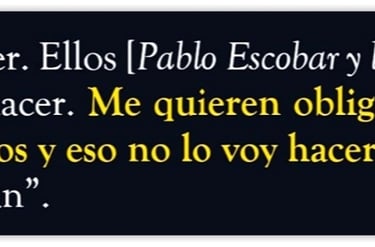


Pablo Escobar and The Extraditables were the intellectual authors of the homicide of Justice Manuel Gaona Cruz. The evidence indicates that they not only declared Manuel Gaona Cruz a military target ("we take it as a given that you accept our declaration of war," see Cartas y Amenazas de Pablo Escobar y los Extraditables a Manuel Gaona Cruz{first letter} in MGC Death – Documentary Evidence), but also promised to assassinate him if he did not change his well-known position on Extradition ("we do not accept... [that] you go out to defend a thesis other than the unconstitutionality of the treaty... The treaty must fall, and you have great responsibility in that task," id {second letter}). This was because the intermediate thesis represented by the magistrate's legal position prevented—and, in fact, did so for several years—the declaration of unconstitutionality of the law approving the Extradition Treaty (See Ponencias del Magistrado Manuel Gaona Cruz Que Impidieron la Declaratoria de Inconstitucionalidad in MGC Death – Documentary Evidence Motive and Planning of the Crime; see also Fabio Castillo, Los Jinetes de la Cocaína, EDP 1987, page 93). The order to murder Justice Gaona Cruz was given by Pablo Escobar himself during the meeting where the attack on the Supreme Court of Justice was planned: "kill the greatest number of magistrates and burn the files," the manifest intention of which was confirmed by two eyewitnesses who belonged to different criminal groups (See Declaraciones sobre la plantación del crimen in MGC Death – Documentary Evidence: Declarations; see also Declaración de Carlos Castaño in Mauricio Aranguren Molina, Mi Confesión: Carlos Castaño Revela Sus Secretos, Ed. Oveja Negra 2002, pages 24 and 41; Declaración de John Jairo Velásquez before the Truth Commission in Informe Final: Comisión de la Verdad Sobre los Hechos del Palacio de Justicia, SUPREME COURT OF JUSTICE OF COLOMBIA, Ed. Universidad del Rosario 2010, page 313; Extractos de la Declaración de John Jairo Velásquez Vásquez {video - right}).

Criminal Alliance between the M-19 guerrilla and The Extraditables in the 1985 Palace of Justice takeover.
John Jairo Velásquez Vásquez Chief of Security and Lieutenant of Pablo Escobar.
John Jairo Velásquez Vásquez Pablo Escobar's Chief of Security and Lieutenant
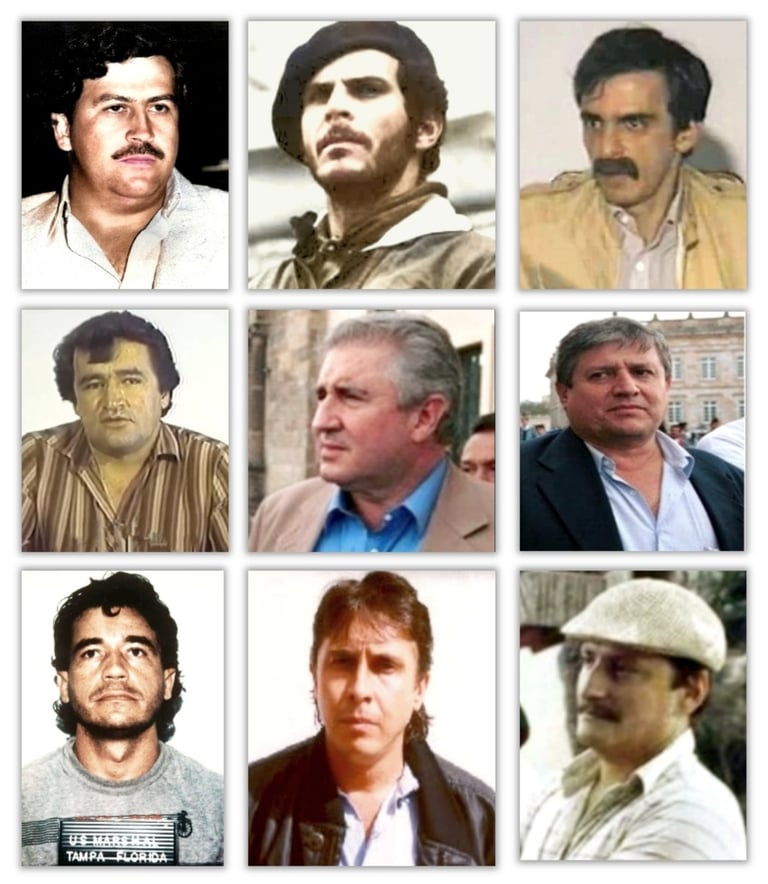

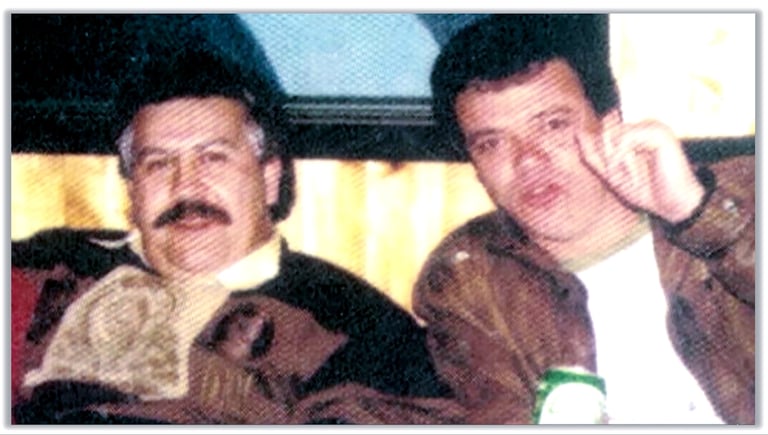

Pablo Escobar Gaviria and John Jairo Velásquez
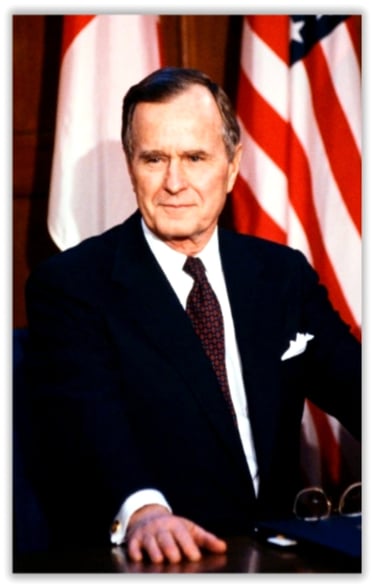

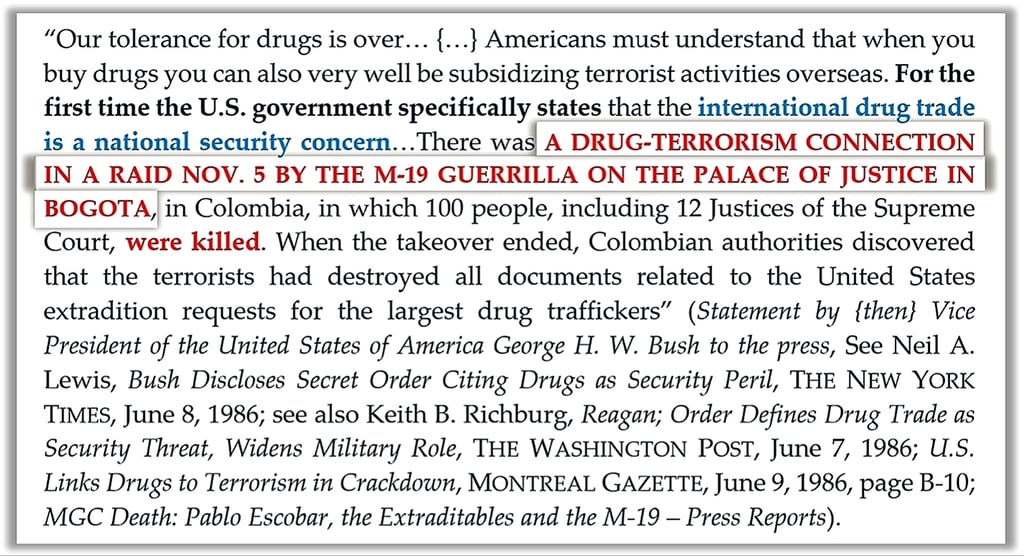

George H. W. Bush U.S. President 1989 -1993 Vicepresident 1981 - 1989
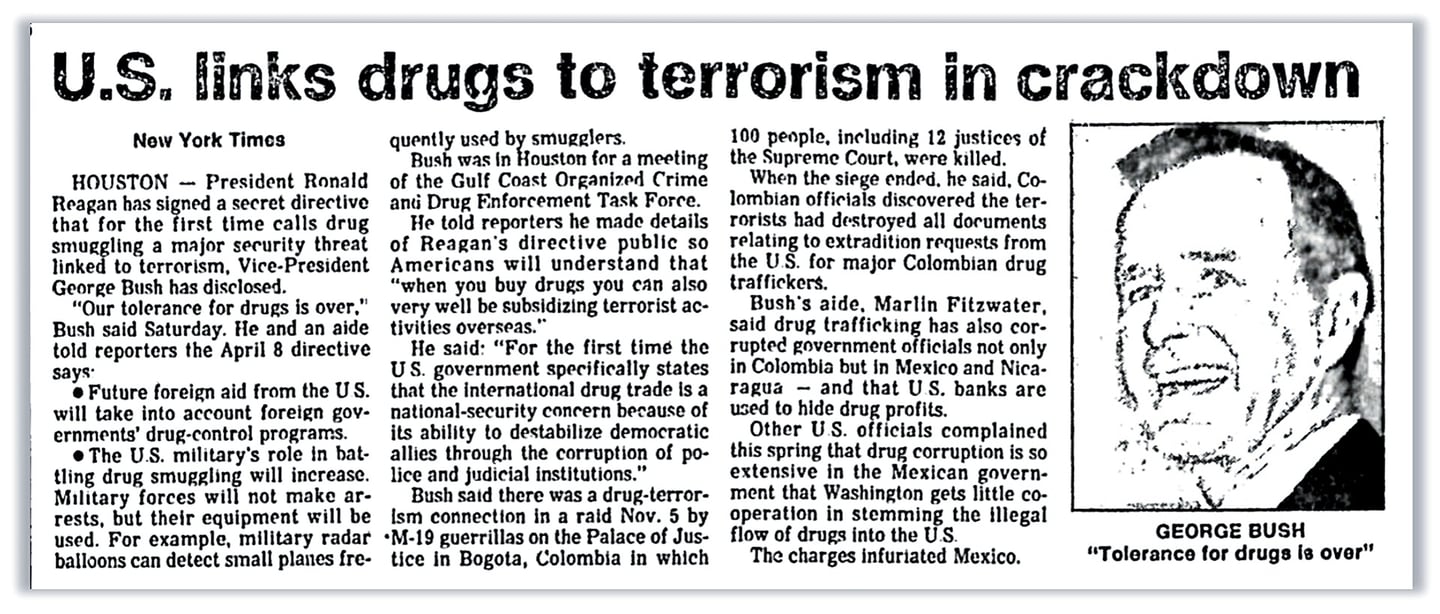

Appearing in descending order, from left to right, are Pablo Escobar Gaviria (Leader of the Extraditables), Carlos Pizarro and Álvaro Fayad (Leaders of the M-19 guerrilla), and Gonzalo Rodríguez Gacha, Jorge Luis Ochoa, Juan David Ochoa, Carlos Lehder, Fabio Ochoa, and Gustavo Gaviria (Members of the Medellín Cartel).
Words of Pablo Escobar to M-19 guerrilla commander Carlos Pizarro and paramilitary leader Fidel Castaño at the Hacienda Nápoles meeting in June 1985, in which the armed attack on the Palace of Justice was agreed upon, including the destruction of evidence and files against The Extraditables, and the assassination of the Magistrates of the Constitutional Chamber of the Supreme Court of Justice, specifically including the magistrate who authored the intermediate thesis that prevented the declaration of unconstitutionality of the law approving the Extradition Treaty between Colombia and the United States—who was directly threatened by Pablo Escobar and The Extraditables and to whom that organization had declared war (See Declaration of Carlos Castaño about the meeting in Mauricio Aranguren, Mi Confesión (My Confession), Ed. Oveja Negra 2002, pages 24 and 41).
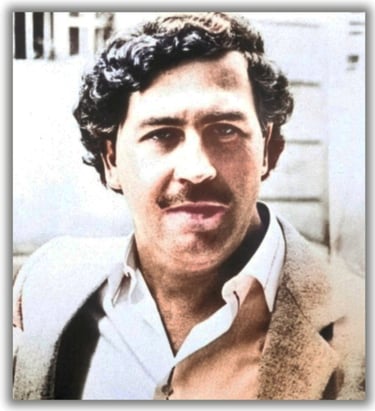

Pablo Escobar Leader of the Medellin Drug Cartel and the Extraditables.
Words of the President and (at that time) Vice President of the United States, George H. W. Bush, in Neil A. Lewis, Bush Discloses Secret Order Citing Drugs as Security Peril, THE NEW YORK TIMES, June 8, 1986 {front page}; see also Keith B. Richburg, Reagan Order Defines Drug Trade as Security Threat, Widens Military Role, THE WASHINGTON POST, June 7, 1986; U.S. Links Drugs to Terrorism in Crackdown, MONTREAL GAZETTE, June 9, 1986, page B-10.

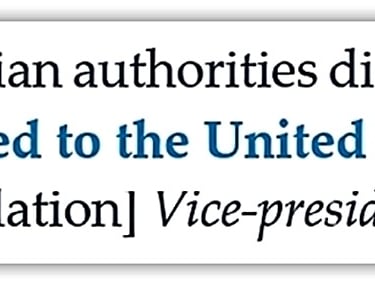


George H. W. Bush U.S. President 1989 -1993 Vicepresident 1981 - 1989
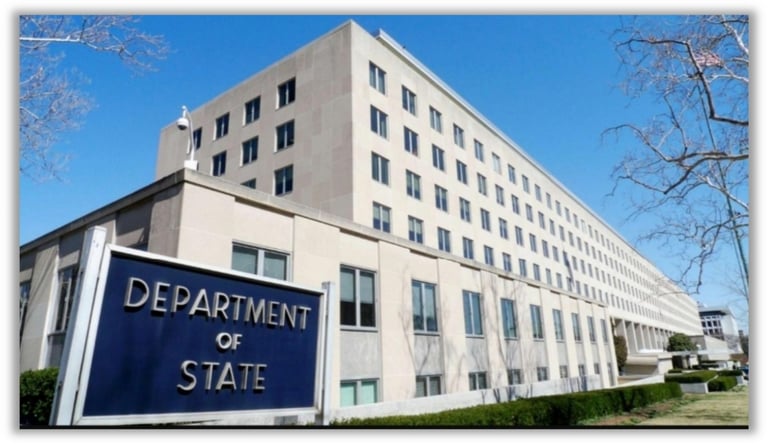

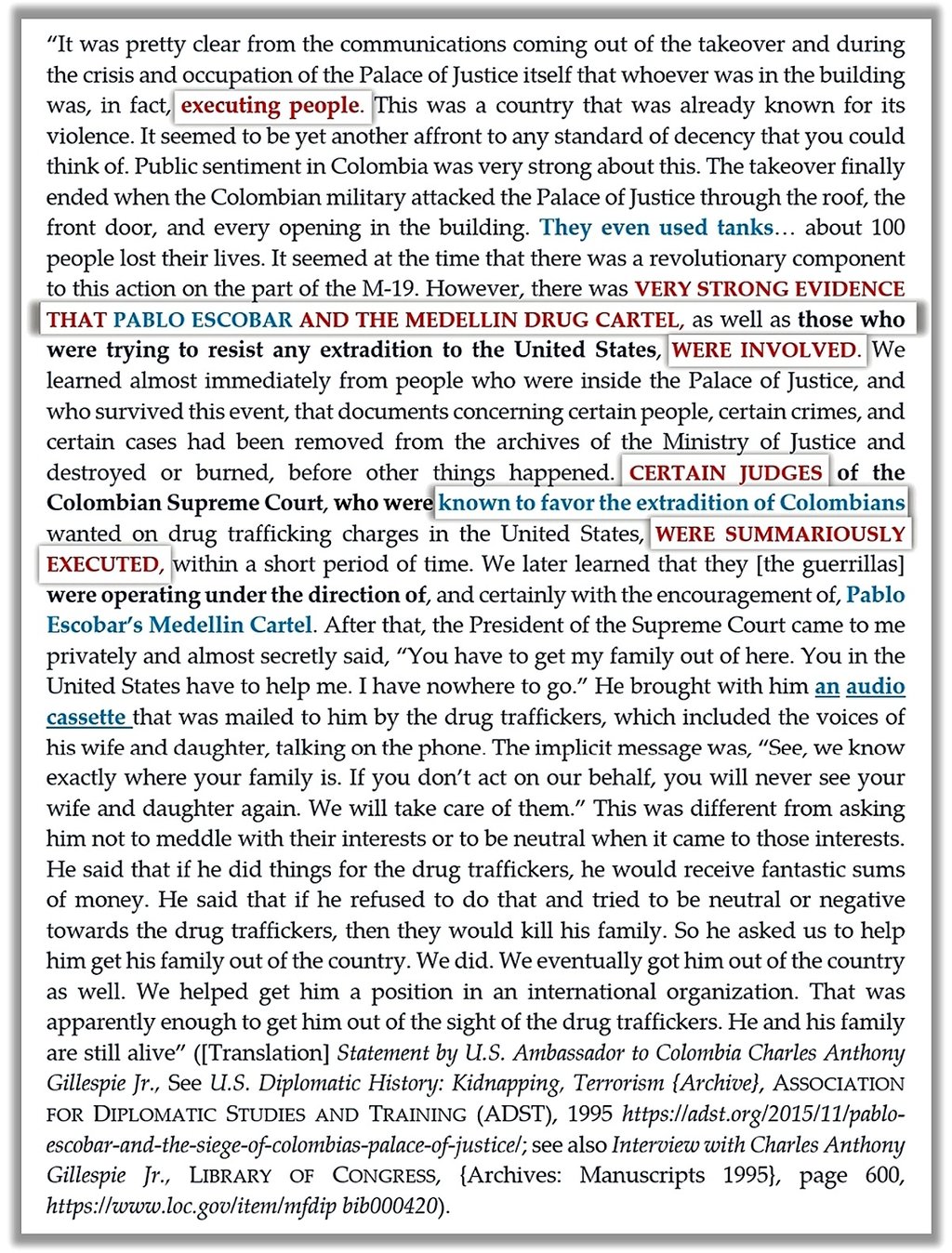

With the notable exceptions of the Truth Commission (2005 – 2010) and the Public Order Judge (1992), no other institution or judicial authority in Colombia dared to investigate or inquire about the criminal relationship between the M-19 guerrilla and Pablo Escobar. The capo's obsession with bending the rule of law in Colombia and his fight to eradicate extradition led him to assassinate anyone who opposed him; in those years, Colombia lost those who tried to change its destiny. However, both the M-19 guerrilla and Pablo Escobar and The Extraditables achieved special agreements with the government, which guaranteed them total impunity for the atrocities committed in the 1985 Palace of Justice takeover. Both the criminal alliance of the M-19 guerrilla, The Extraditables, and the Medellín Cartel, as well as the responsibility and participation of drug trafficking in the Palace of Justice takeover, are part of the central conclusions of the Final Report of the Truth Commission established by the Supreme Court of Justice of Colombia.
Following the assassination of Justice Manuel Gaona Cruz and the Magistrates of the Constitutional Chamber of the Supreme Court of Justice, no magistrate or authority in Colombia ever again opposed the aims of Pablo Escobar, the M-19, and The Extraditables regarding Extradition. Their history and the fate of the Extradition Treaty are written. The conclusion of the Truth Commission regarding the criminal alliance between the M-19 guerrilla and the Medellín Cartel in the attack on the Palace of Justice is undeniable:
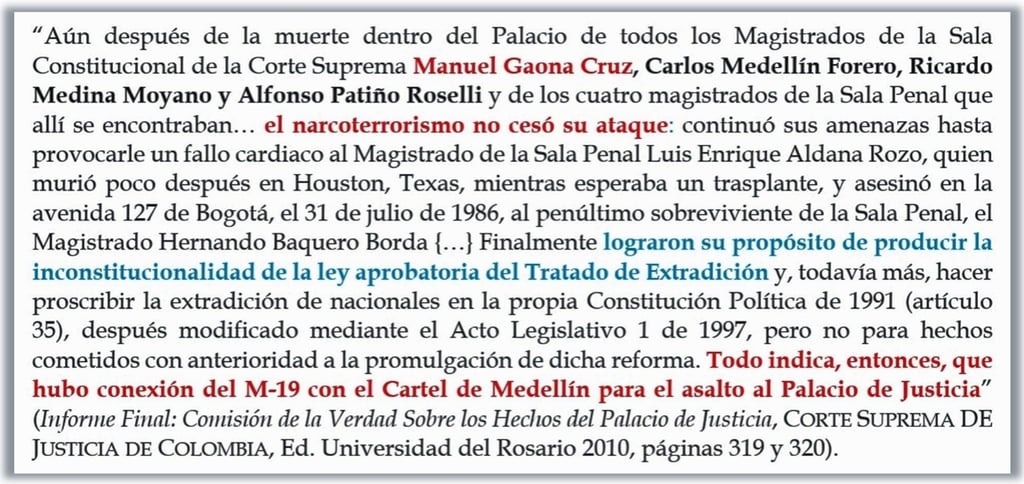

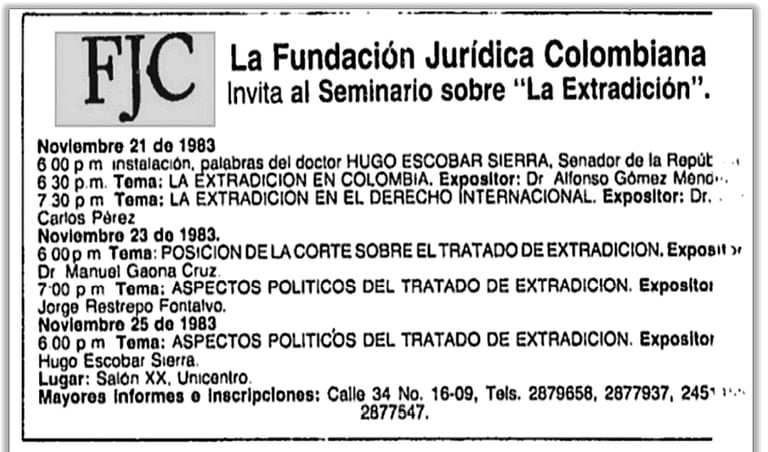

Classified ad published in EL TIEMPO, between November 5 and 2, 1983.

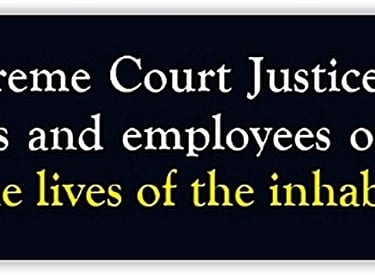
Words of the Supreme Court Justice of Colombia and President of the Drafting Commission of the National Police Code, Manuel Gaona Cruz, to the Army and the Police, on Wednesday, November 6, 1985 (See Truth Commission: Final Report on the Events of the Palace of Justice, SUPREME COURT OF JUSTICE OF COLOMBIA, Ed. Universidad del Rosario 2010, page 154).


International Law in general and Human Rights in particular are inherent to democracy and form part of the block of constitutionality in the majority of rule of law states in the world, including the Colombian State; in this regard, the Supreme Court of Justice of Colombia ruled some time ago:

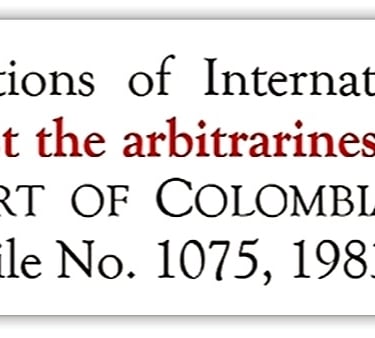
In this context, the jurisprudence of the courts of justice of the most civilized nations establishes respect for the human rights of victims as an inherent limit to state action in confronting terrorism. In this regard, the Supreme Court of Canada indicated:
The flagrant violations of International Humanitarian Law (IHL) were portrayed in time through the systematic disregard and total non-observance of the principles of distinction, proportionality, humanity, and military necessity. From its customary insertion to its legal codification at the international level (Articles 48 and 52 of Protocol I of 1977 Additional to the 1949 Geneva Conventions), the Principle of Distinction establishes an inherent obligation in every armed confrontation, which imposes on belligerent actors in any conflict (e.g., internal or international) the duty to distinguish between civilians and combatants in relation to the planning and execution of their military objectives and the use of force. The improvised, excessive, inhumane, and violent attack by the military forces and the national police against the structure of the Palace of Justice and the civilians found there constitutes a direct violation of the Principle of Distinction.
Exterior of the Supreme Court of Justice of Colombia 1985: The Army fires a rocket against the Supreme Court of Colombia using Cascabel and Urutu war tanks. Inside, nearly 400 civilians are being held by the M-19 guerrilla.
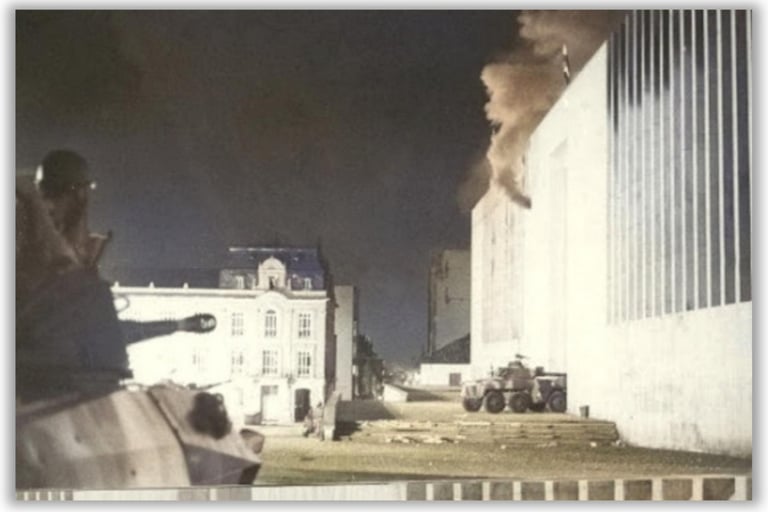

The violation of the Principle of Proportionality (Rule 14 ICRC, Customary International Law) prohibits attacks against military objectives when, considering the circumstances of the engagement, civilians are in a position of manifest defenselessness or danger which may result in incidental harm or loss of civilian lives. Consequently, firing war tanks against civilian buildings where, incidentally, civilians uninvolved in the armed conflict are being held hostage constitutes a flagrant violation of the Principle of Proportionality, particularly when those in charge of the operational command recognize that such action could cause civilian deaths. From the deployment of heavy artillery (war tanks), the 30 hours of uninterrupted shooting that followed, the indifference to the victims' pleas, the aerial attack through the roof of the Palace of Justice, up to the firing of a war tank against the external wall of the bathroom where innocent civilians were being held hostage, these all constitute irrefutable proof of the clumsiness, brutality, barbarity, and belligerent intent of the armed forces: to wipe out the enemy at any cost. The images of the military violence employed are therefore incontrovertible:
International Criminal Law (ICL) further establishes that, depending on the circumstances of the confrontation and the position of civilians during its occurrence, the use of high-powered military weapons such as war tanks against military objectives that may impact civilian installations or cause the loss of civilian lives constitutes, in addition to a manifest violation of the Principle of Proportionality, a CRIME AGAINST HUMANITY (Situation in Georgia, INTERNATIONAL CRIMINAL COURT, Case no. ICC-01/15-12-Anx1, Opinion of Judge Péter Kovàcs, January 27, 2016, paras. 26-28), particularly when the military advantage gained emerges disproportionate to the damage caused (Prosecutor v. Prlić et al., International Criminal Tribunal for the former Yugoslavia {ICTY}, Case no. IT-04-74-T, Judgment of May 29, 2013, paras. 1584 and 1587).
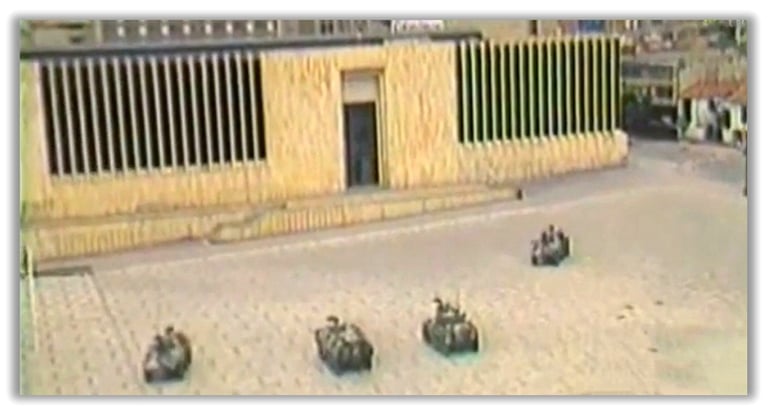



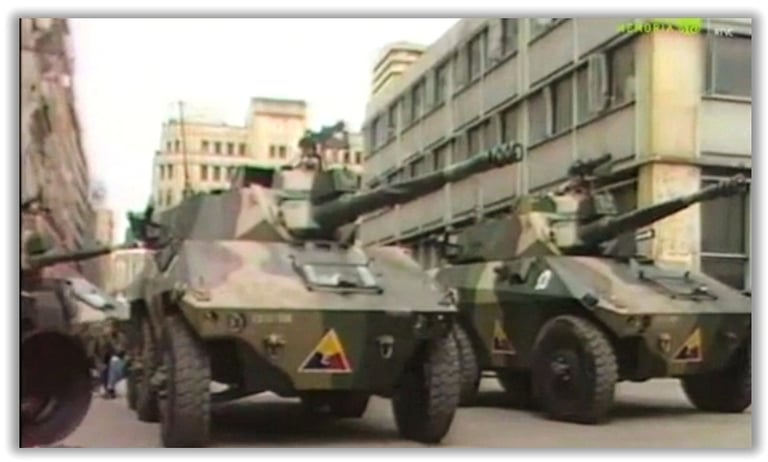

Retaking of the Palace of Justice 1985 Deployment of force 20 minutes after the takeover began.
The responsibility of the members of the armed forces who conducted the Palace of Justice retaking operations on the part of the Army is extensive and goes beyond the retaking of the Palace of Justice itself; there are rulings, investigations, and convictions against the Colombian State, the National Police, and the military forces' operative command for adjacent actions and omissions that took place before, during, and after the takeover and retaking of the Palace of Justice.
1. THE DEFENSE OF DEMOCRACY, EXCESSIVE USE OF FORCE AND MILITARY VIOLENCE IN THE RETAKING OF THE PALACE OF JUSTICE
In the face of the argument expressed by the military command of the time ("the defense of democracy") to justify the violence and barbarity of its actions, the Council of State of Colombia ruled:
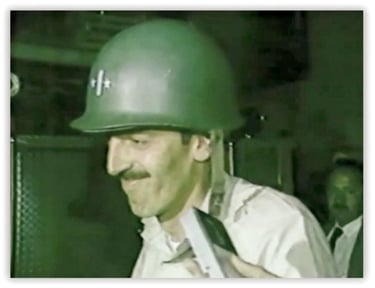

The defense of democracy does not justify the violation of human rights and the fundamental freedoms upon which it is formed. The memorable expression of the person in charge of the Palace of Justice retaking, "if they shoot at me, I shoot," may serve (in limited circumstances) to exclude or diminish individual criminal responsibility derived from the crime against life and personal integrity through the configuration of the material and legal prerequisites of self-defense, but it does not justify violations of human rights, crimes against humanity, or the complete disregard for the most fundamental principles of International Law, such as respect for life, proportionality and necessity in the use of force, distinction between civilians and combatants, or the human dignity of those who represent democratic institutions. Regarding this matter, the United Nations Human Rights Committee has ruled that:
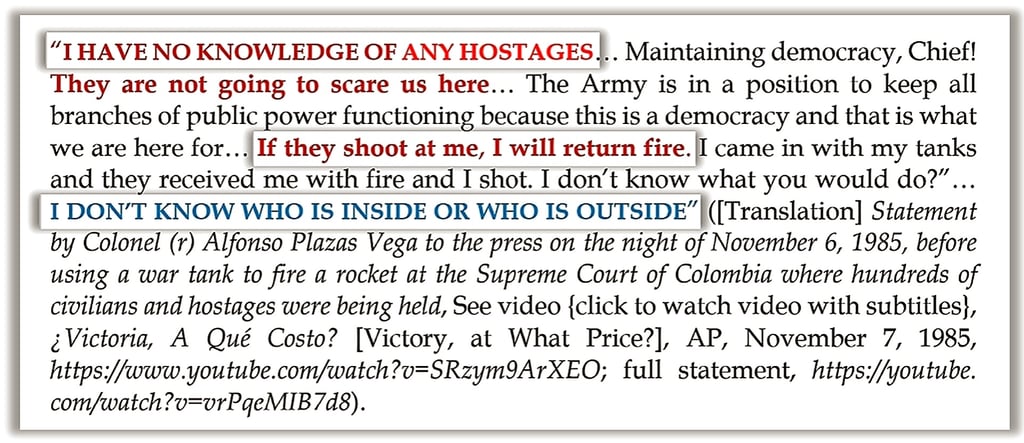

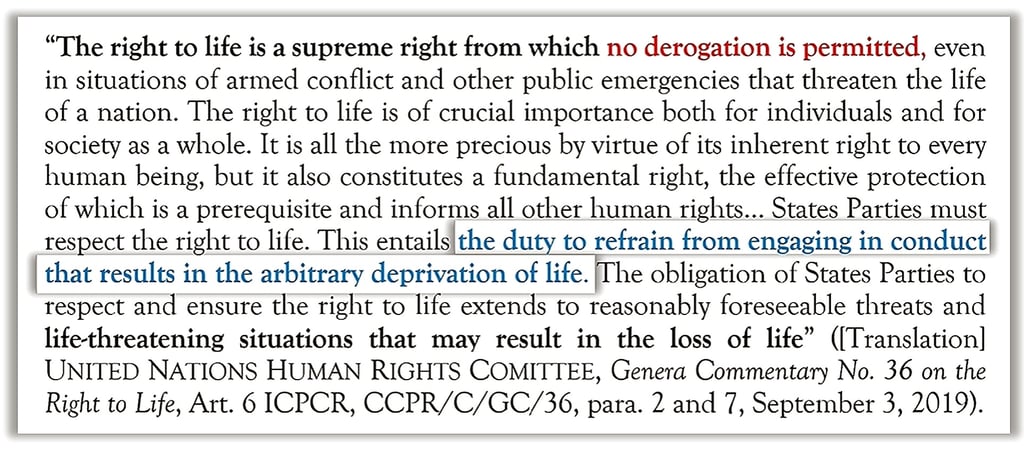

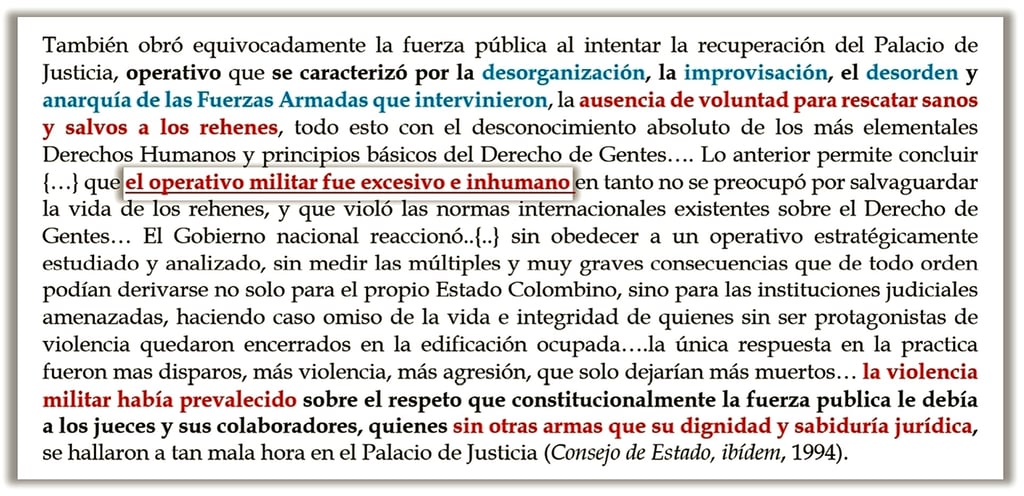

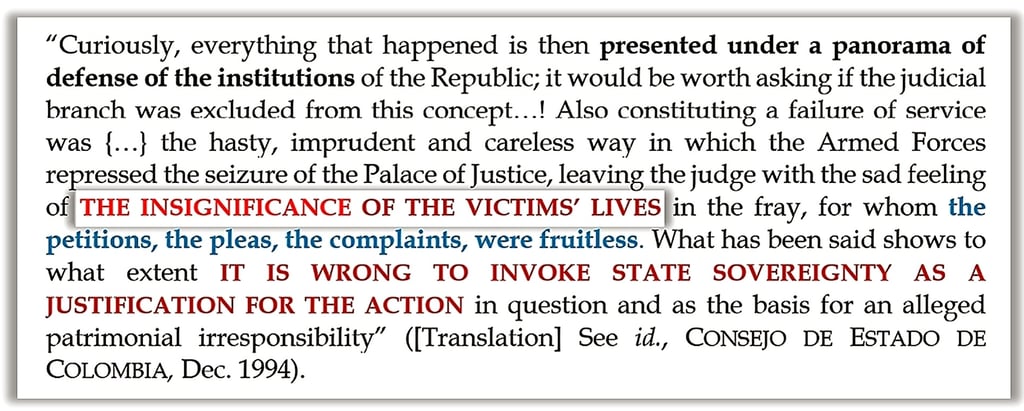

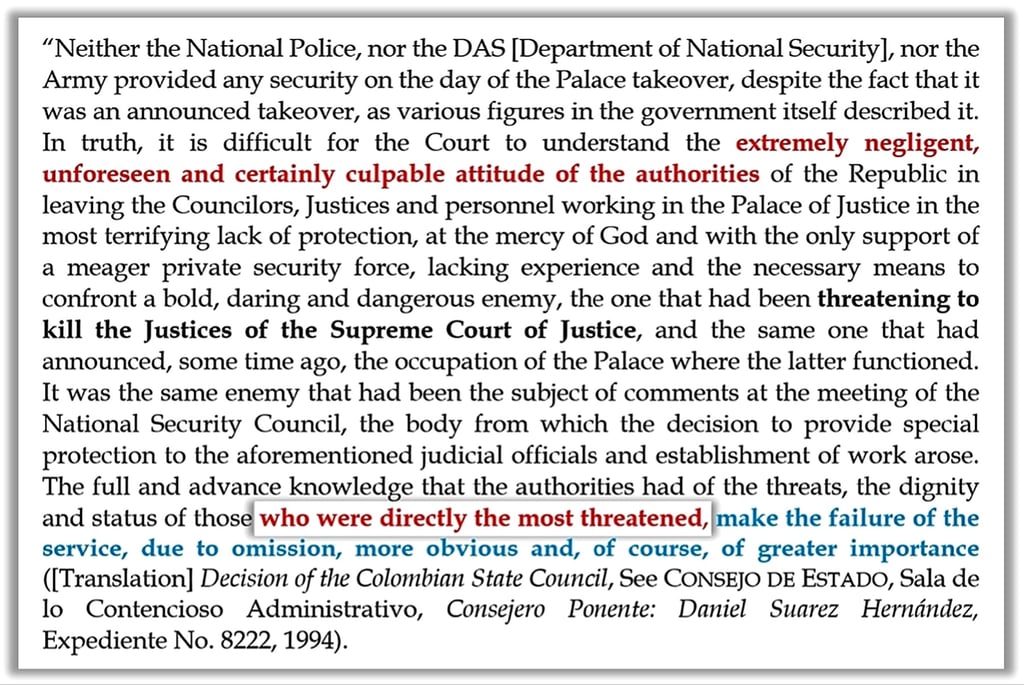

Alfonso Plazas Vega Colonel in charge of the operation to retake the Palace of Justice on November 6, 1985.
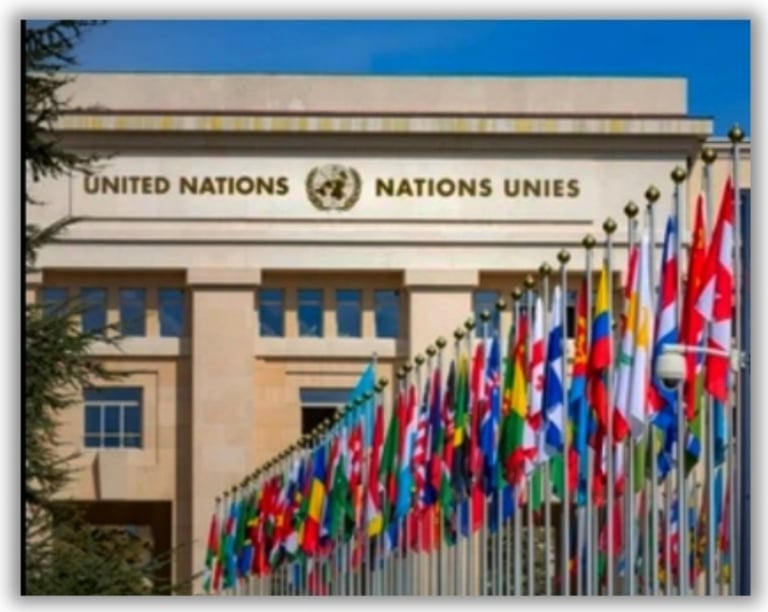

United Nations Human Rights Committee
2. ADMINISTRATIVE JUSTICE RULINGS: CONDEMNATIONS BY THE COUNCIL OF STATE AGAINST THE GOVERNMENT, THE ARMY AND THE NATIONAL POLICE
3. CRIMINAL JUSTICE RULINGS: INDICTMENTS ISSUED BY THE OFFICE OF THE ATTORNEY GENERAL OF COLOMBIA AND DECISIONS ISSUED BY THE SUPREME COURT OF COLOMBIA
4. INTERNATIONAL JUSTICE RULINGS: INTER-AMERICAN COURT OF HUMAN RIGHTS (ICHR)
The Council of State condemned the Colombian State, the Ministry of Defense, the National Police, the Armed Forces, and the Administrative Department of Security (DAS) as jointly and severally liable for the structural failures of the service and the excessive use of force in the retaking of the Palace of Justice (CONSEJO DE ESTADO, Landmark Ruling, 1994). In relation to the serious failures in the security service of the Palace of Justice and the protection of the Justices, the Council of State of Colombia ruled:
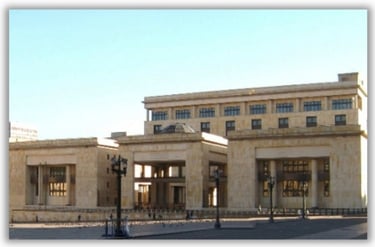

Council of State of Colombia
Regarding the excessive use of force and military violence, the Council of State indicated:
In 2007, the then-National Deputy Comptroller and son of Justice Manuel Gaona Cruz, J. Mauricio Gaona, met with the Attorney General of the Colombia, Mario Iguarán Arana, and the then-Fourth Deputy Prosecutor, Ángela María Buitrago, in order to clarify two things: (i) whether there was evidence confirming the rumors surrounding the Justice Gaona's exit from the Palace of Justice and subsequent execution by the Army, and (ii) whether there was evidence compromising the credibility of the witnesses who observed the homicide of Justice Gaona inside the Palace of Justice at the hands of the M-19. According to the Attorney General, there was no evidence compromising the credibility of the eyewitnesses to the crime of Justice Manuel Gaona Cruz inside the Palace of Justice, so the investigation was mainly focused on the actions of the public forces and establishing whether there were people who left the Palace of Justice alive. In turn, the Fourth Deputy Prosecutor stated that there was no witness to attest to the exit of Justice Gaona alive from the Palace of Justice or his execution by the Army. However, the Prosecutor added, we have established cases of other officials who, according to the evidence collected by the entity, did leave the Palace of Justice alive. The final list of disappeared persons from the Palace of Justice that served as the basis for formulating an indictment against the operational commanders in charge of the Palace of Justice retaking was 11 people. Manuel Gaona Cruz was not part of that list, and his name was not linked to the criminal case against the Army. Manuel Gaona Cruz did not leave the Palace of Justice alive.
On February 11, 2008, the Fourth Delegate Prosecutor Ángela María Buitrago issued an indictment against retired Generals Jesús Armando Arias Cabrales and Iván Ramírez Quintero, and against retired Colonels Edilberto Sánchez Rubiano and Alfonso Plazas Vega for the crimes of aggravated kidnapping and forced disappearance of 11 people (See Fourth Delegate Prosecutor, ATTORNEY GENERAL OFFICE, February 11, 2008, folio 330, C. 18). The Office of the Attorney General refrained from issuing an indictment for the homicide or forced disappearance of Justice Manuel Gaona Cruz.
In 2010, the Third Criminal Circuit Court of Bogotá's Specialized Jurisdiction sentenced Colonel (Ret.) Alfonso Plazas Vega as criminally responsible ("indirect perpetrator in organized power structures") for the forced disappearance of 11 people, acquitting him only in relation to the crime of aggravated kidnapping. On January 30, 2012, the Superior Court of Bogotá confirmed, in an appeals ruling, the conviction to 30 years in prison for the disappearance of two people. On December 16, 2015, the Criminal Cassation Chamber of the Supreme Court of Justice (CSJ, Reporting Judge Luis Guillermo Salazar Otero, File No. 38957, December 16, 2015) acquitted Colonel Plazas Vega. A case is currently underway against Plazas Vega before the U.S. Federal Court for the Southern District of Florida for the disappearance of the Assistant Counsel of the Council of State, Carlos Horacio Urán Rojas (See Bidegain et al v. Plazas Vega, UNITED STATES DISTRICT COURT OF THE SOUTHERN DISTRICT OF FLORIDA, Case No. 22-60338, https://www.govinfo.gov/app/details/USCOURTS-flsd-0_22-cv-60338).
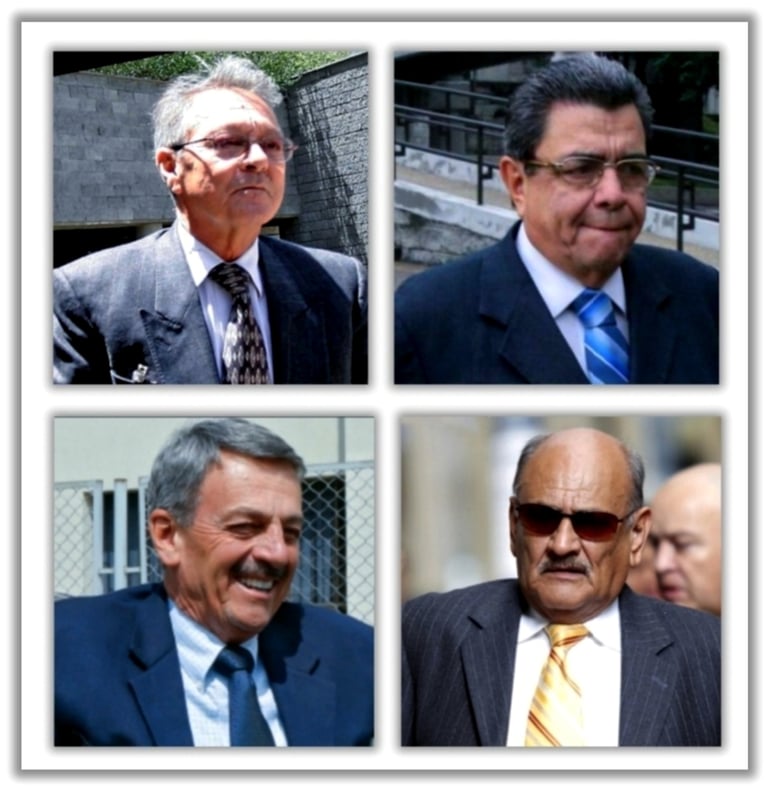

Military Operational Command for the Retaking of the Palace of Justice 1985
They appear in descending order, from left to right, Generals (Ret.) Jesús Armando Arias Cabrales and Iván Ramiro Quintero and Colonels (Ret.) Alfonso Plazas Vega and Edilberto Sánchez Rubiano.
In 2011, the 51st Criminal Circuit Judge of Bogotá sentenced General (Ret.) Jesús Armando Arias Cabrales to 35 years in prison for having ordered the disappearance of civilians. The Superior Court of Bogotá, in 2014, and the Supreme Court of Justice, in 2019, upheld the conviction.
In 2016, the 52nd Criminal Circuit Judge of Bogotá sentenced Colonel (Ret.) Edilberto Sánchez Rubiano to 40 years in prison for the crime of forced disappearance. In 2023, the Supreme Court of Justice upheld the sentence.
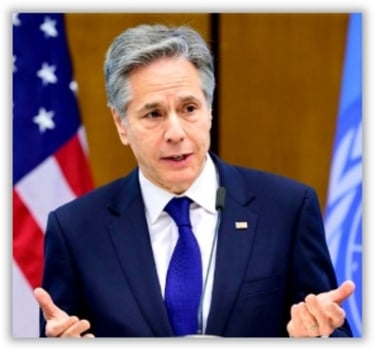

In 2014, the Inter-American Court of Human Rights declared the Colombian State internationally responsible for the cases of forced disappearance and extrajudicial execution that occurred during the retaking of the Palace of Justice in 1985. Justice Manuel Gaona Cruz was not part of the ruling, nor of the forced disappearance cases resolved therein, given that based on investigations carried out in Colombia (Attorney General's Office 1986, Special Court of Criminal Investigation 1986, 30th and 77th Criminal Investigation Courts of Bogotá 1986 and 1989) and the Final Report of the Truth Commission established by the Supreme Court of Justice of Colombia—which is part of the United Nations Inter-American human rights system and was considered by the Inter-American Court in its ruling—Justice Manuel Gaona Cruz was executed inside the Palace of Justice by the M-19 guerrilla group.
Former President of Colombia Belisario Betancur Cuartas, expressed in his posthumous publication his grief for the victims and his recognition of justice, the Supreme Court of Justice, the Armed Forces, and Colombian society, after his decision to explain, in a posthumous publication, his actions, omissions, and decisions in the 1985 seizure and retaking of the Palace of Justice became known in 2001 (See J. Mauricio Gaona, 16 Years Ago and Still No Answer, EL TIEMPO, Friday, August 17, 2001)."
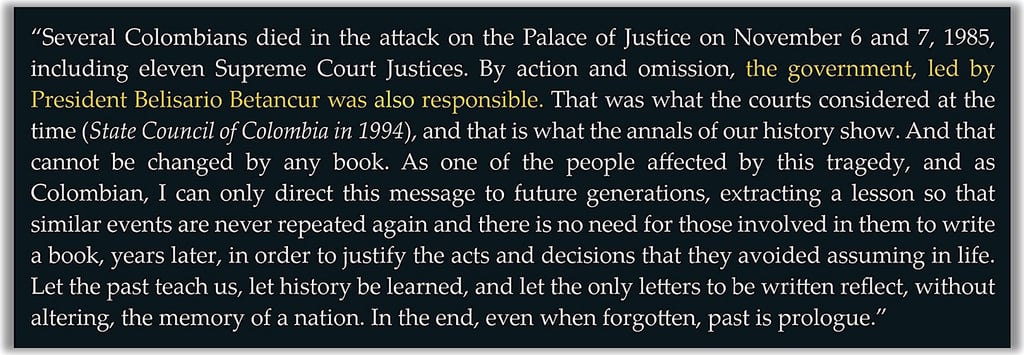

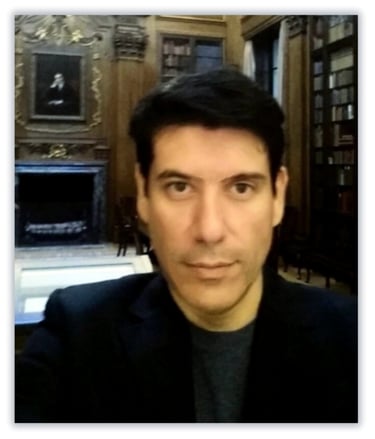

Last words of Supreme Court Justice Manuel Gaona Cruz to guerrilla leader Andrés Almarales, on Thursday, November 7, 1985, before being executed by M-19 guerrillas inside the Palace of Justice (See MGC Muerte – Pruebas Testimoniales [MGC Death – Testimonial Evidence]; see also Declaración de José Gabriel Salom Beltrán rendida el 12 de marzo de 1986, PROCURADURÍA DELEGADA PARA LA POLICÍA JUDICIAL; Informe, TRIBUNAL ESPECIAL DE INSTRUCCIÓN CRIMINAL, Diario Oficial No. 37509, Cuaderno Original de Anexos de Instrucción No. 24, folios 1, 8 y 10, 1986; Informe Final: Comisión de la Verdad Sobre los Hechos del Palacio de Justicia, CORTE SUPREMA DE JUSTICIA DE COLOMBIA, Ed. Universidad del Rosario 2010, page 166; Ramiro Castellanos A., Asalto Final del Ejército: Los Guerrilleros Se Volvieron Como Locos [Final Assault of the Army: The Guerrillas Went Crazy], EL TIEMPO, June 22, 1986, page 6-B).
Words of Justice Manuel Gaona Cruz to his wife and his children, Manuel and Mauricio, on Sunday, November 3, 1985, after finishing the writing of his opinion declaring the law approving the Extradition Treaty between Colombia and the United States to be constitutional (See José Alejandro Castaño, Así se Despidió de sus Hijos Magistrado Muerto en Toma del Palacio (This is How the Magistrate Killed in the Palace Takeover Said Goodbye to His Children), EL TIEMPO, November 19, 2006).
The power vacuum in which the incommensurable incompetence, indolence, indifference, and delegation of constitutional and international responsibilities by the president of the Republic and his ministers left the civilians and Supreme Court Justices in the middle of a war between the armed forces and the M-19 guerrillas, is revealed as the indelible mark of the Betancur Government's responsibility in the 1985 seizure and retaking of the Palace of Justice. At its most shameful, there lies the equidistant presidential admission of having acted expectantly as a counselor and not as the Head of State that Justice in Colombia needed in its final hour, to such an extent that, 20 years after such a holocaust, the President of the Republic recognized, unperturbed, that he did not even know how the representatives of justice in Colombia—whose institutional integrity he claimed to defend so many times—died; yet he ignored their fate, their anguish, and their end.
In light of applicable International and Constitutional Law, the President of the Republic not only had the constitutional obligation to preserve the institutions he so often claimed to be defending—with his indifference to the lives of the magistrates and hostages regarding his decision to “not grant a ceasefire”—but he also had a preceding and inescapable constitutional and international obligation to protect the life and integrity of the highest representatives of justice in a State and of citizens and civilians uninvolved in the conflict (See Velázquez Rodríguez vs. Honduras, INTER-AMERICAN COURT OF HUMAN RIGHTS (ICHR), Judgment of July 29, 1998, paras. 174 and 176), as an ineluctable corollary that justifies the very existence of the institutions he expressly claimed to be defending with his decisions. In this regard, due to both his decisions and his conduct, the President of the Republic Belisario Betancur Cuartas disregarded primary constitutional obligations by committing an extraordinary constitutional violation, the tragic vicissitude of which the victims and history refuse to forget. Pursuant to the 1886 Constitution of Colombia, applicable in 1985:

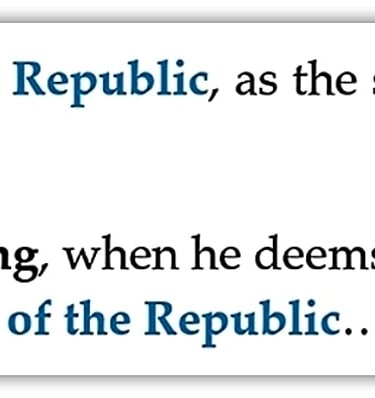

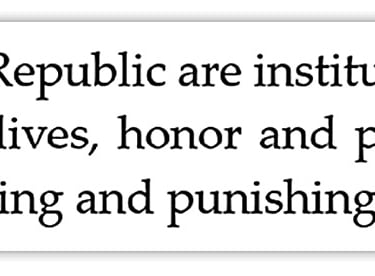
In its final provision on the responsibility of the president and his ministers, the Truth Commission established by the Supreme Court of Justice of Colombia concluded:
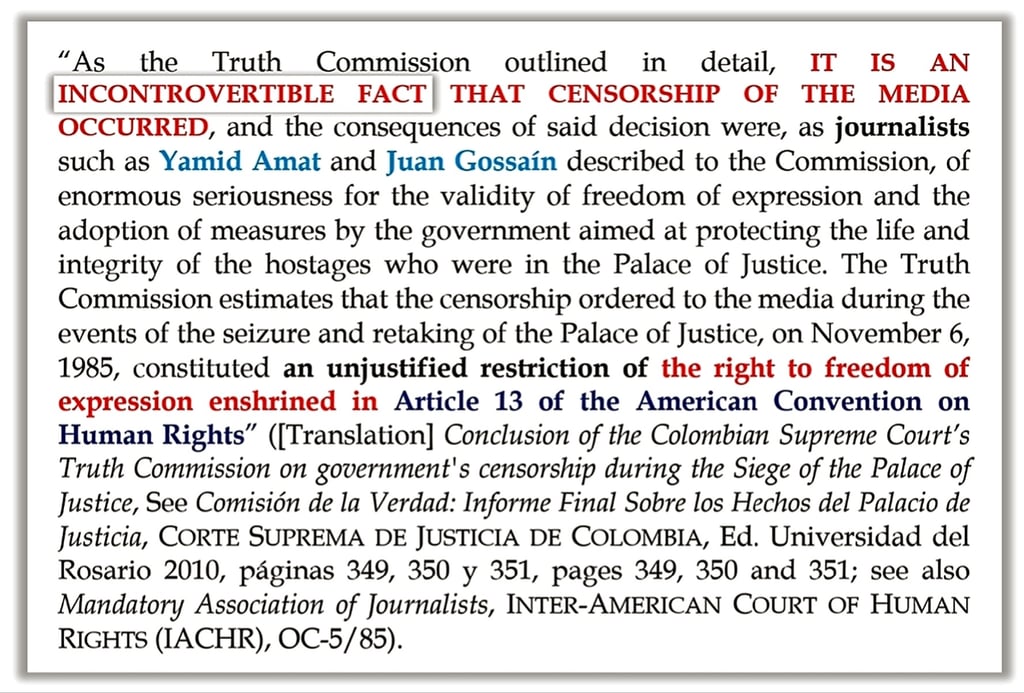

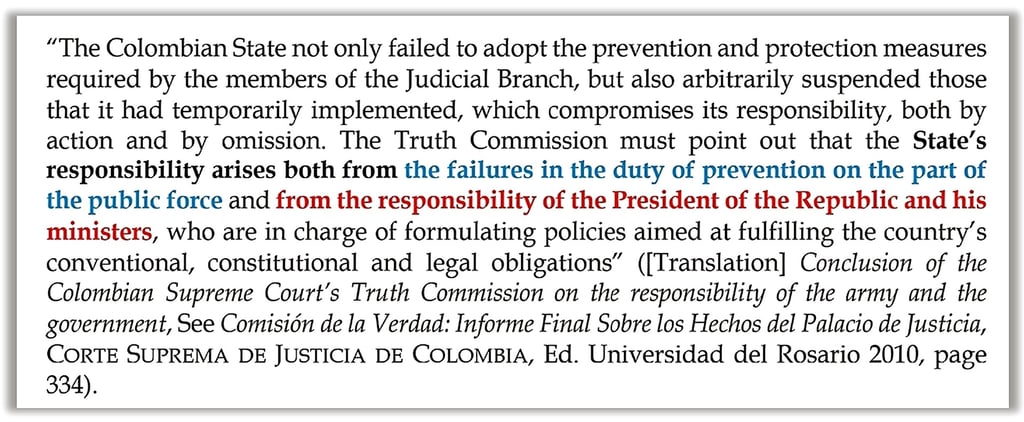

President Belisario Betancur Cuartas delegated, de facto, his constitutional and international responsibilities to a military command whose sole interest was the destruction of the M-19. Such delegation, de facto and de jure, is not protected by the risk of dialogue or the decision not to negotiate:
1. VIOLATION OF INTERNATIONAL AND CONSTITUTIONAL DUTIES
2. INSTITUTIONAL AND CONSTITUTIONAL POWER VACUUM
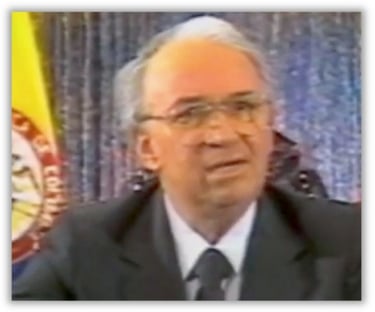


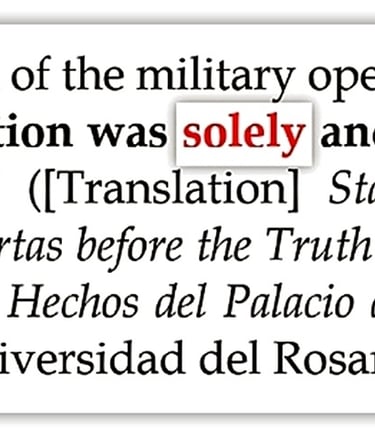
Belisario Betancur Cuartas President of Colombia 1982 - 1986
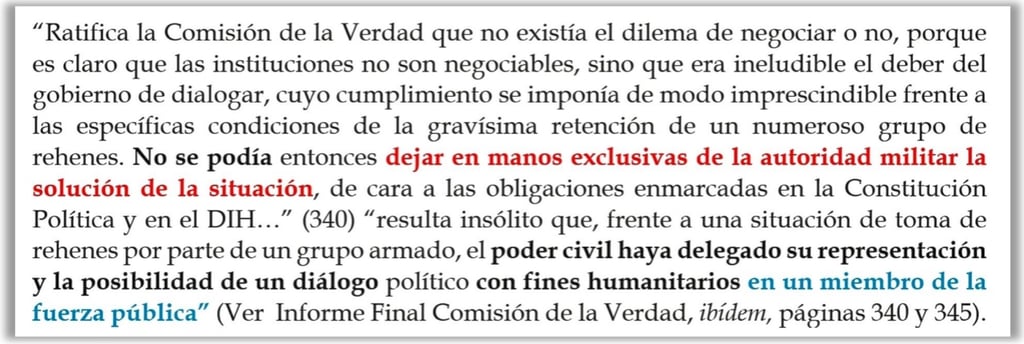


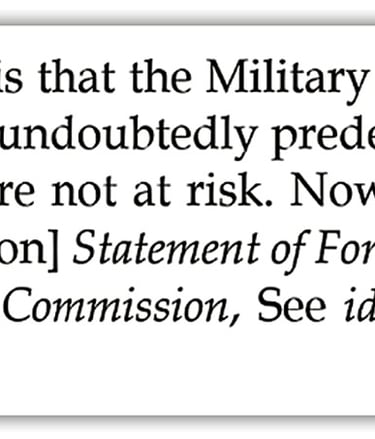
3. CENSURESHIP
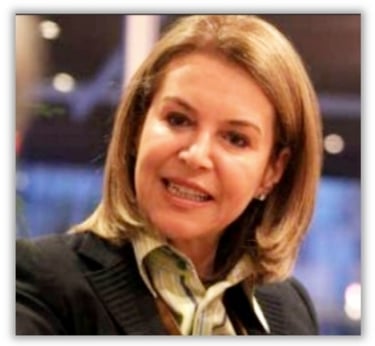

In the words of the Truth Commission established by the Supreme Court of Justice of Colombia:
Noemí Sanín de Rubio Communications Secretary 1983 – 1986
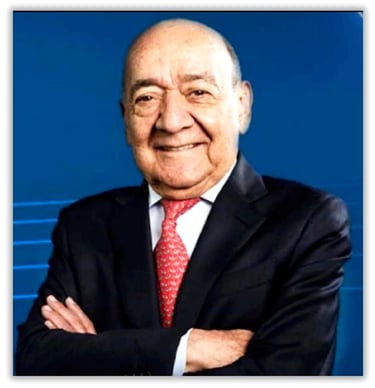




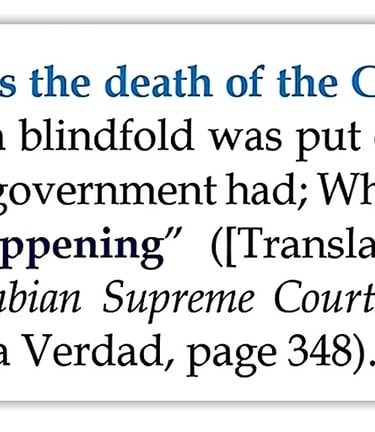

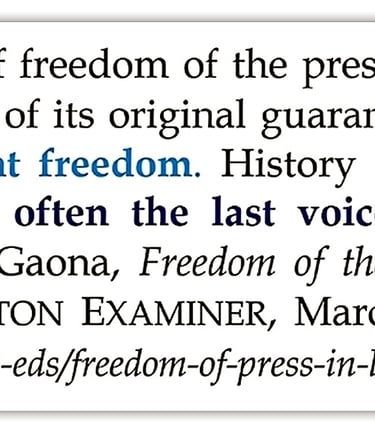
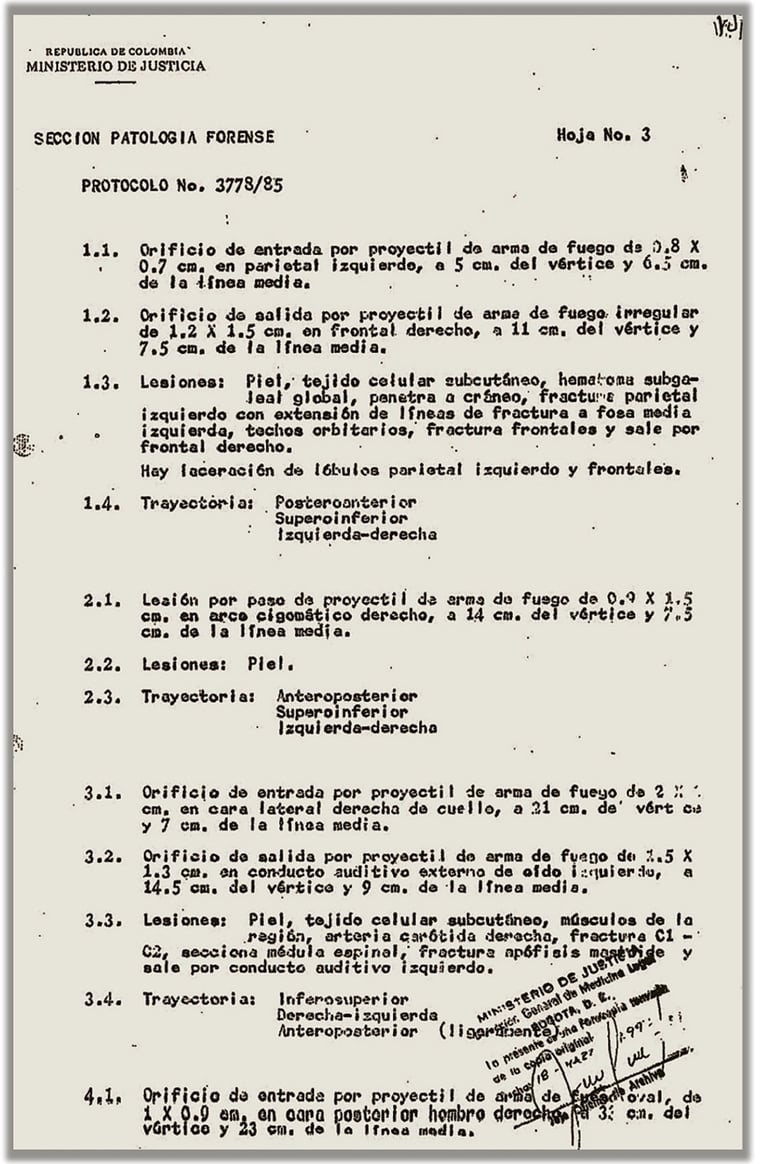

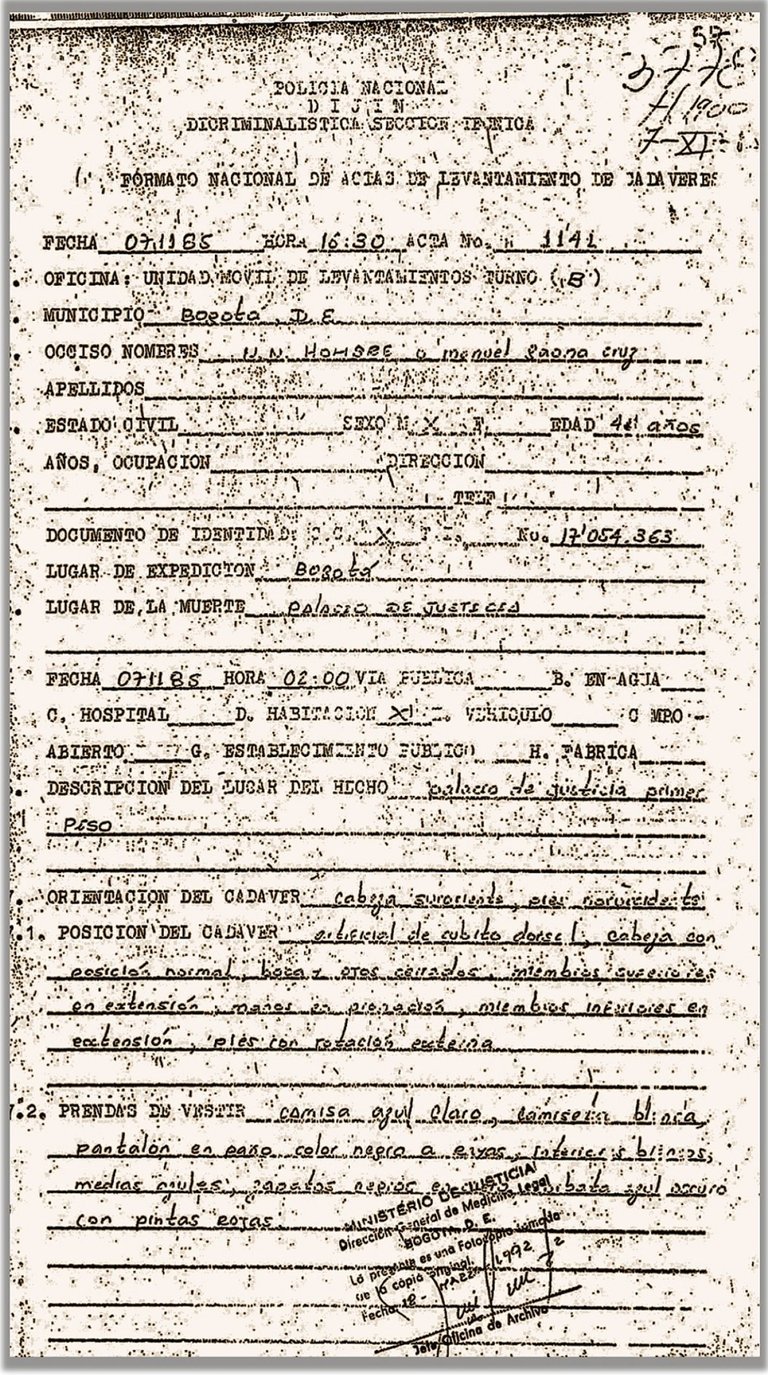

Indeed, during the retaking of the Palace of Justice by the Army and the National Police, the most fundamental norms of International Law were disregarded in four specific areas, namely: International Humanitarian Law, International Human Rights Law (international instruments and treaties on Human Rights), International Criminal Law, and Treaty Law (or Public International Law of Treaties).
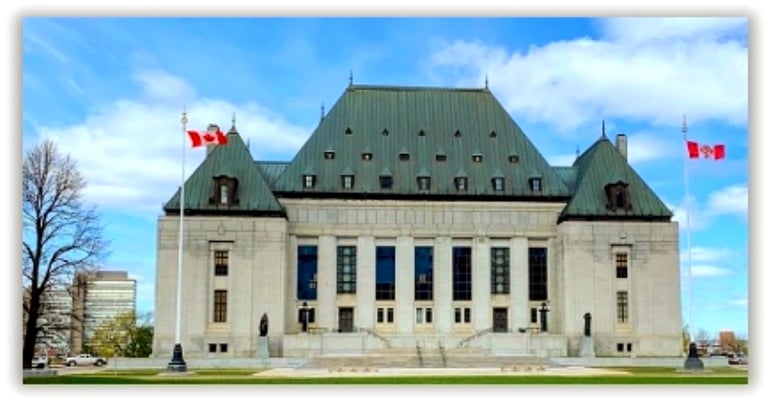


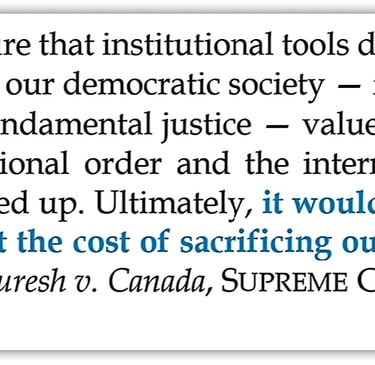
Supreme Court of Canada
In the pursuit of truth, the wife and children of Justice Manuel Gaona Cruz have listened to all kinds of stories, rumors, and accounts over the years. None of these, in truth, possessed sufficient legal strength to withstand the test of time and outweigh the probative value of the existing material evidence or the credibility of the eyewitnesses to Justice Gaona's crime inside the Palace of Justice at the hands of the M-19 guerrilla group. This, of course, does not diminish the direct responsibility of drug trafficking and the indirect responsibility of the Army and the Betancur Government. Some of these accounts came from acquaintances who, while seemingly having an appreciable and legitimate interest in finding the truth, were working on projects that ultimately revealed a very distinct economic, political, or judicial agenda. The limited evidence provided in such accounts was always speculative and, at best, circumstantial. For this reason, the family of Justice Manuel Gaona Cruz—specifically, the relatives who lived with the Justice, knew his work, and were the direct and exclusive targets of the threats from Pablo Escobar and Los Extraditables in the months and days leading up to the takeover—decided to make public some of the rumors they received. They shared these with the authorities and institutions that investigated the events of the Palace of Justice (Truth Commission and the Attorney General's Office), requesting that they investigate both the M-19 guerrilla and the military command that directed the Army's operationsin the retaking of the Palace of Justice. This latter request, in fact, led to the family receiving death threats.
U.S. Department of State Division of Diplomatic Affairs Ambassador to Colombia, Charles Anthony Gillespie Jr. 1985 – 1988.
After four decades, the credibility of the eyewitnesses to the crime of Justice Manuel Gaona Cruz (who were located behind, beside, beneath, and even holding hands with him) could not be discredited, neither by the Attorney General of Colombia which chose to investigate the Army exclusively, nor by the Truth Commission, whose investigation involved all conflicting parties and interests on the day of the takeover (e.g., M-19 guerrilla, armed forces, government, drug trafficking). As M-19 members gained greater political power, eventually reaching the Presidency of Colombia, rumors about Justice Gaona Cruz exiting the Palace of Justice alive increased. However, despite efforts to reconfigure the victims' accounts and erase the atrocious assassination of Justice Manuel Gaona Cruz by the M-19 guerrilla from the public memory of the Palace of Justice, the few authorities that did investigate the crime never hesitated to attribute its commission to the terrorist group (Attorney General's Office 1986, Special Tribunal for Criminal Instruction 1986, 77th Criminal Investigating Judge 1987, 30th Criminal Investigating Judge of Bogotá 1989, Public Order Judge 1992, Truth Commission established by the Supreme Court of Colombia 2010, see MGC Death – Investigations). The reports, testimonies, and conclusions regarding the human rights atrocities committed by the M-19 guerrilla during the Palace of Justice takeover were so compelling that the Government of President Virgilio Barco Vargas had to lobby the Congress of the Republic for an amnesty law to protect the M-19 members, thus promoting their eventual demobilization. As is historically accepted in Colombia, peace and truth were in conflict. This was further complicated by the legal position of both the judges who investigated the human rights violations committed by the M-19 during the takeover (e.g., the 30th Criminal Investigating Judge of Bogotá in 1989 and the Public Order Judge in 1992) and the Justices who reviewed them and ordered their investigation, qualifying them as crimes against humanity (e.g., the Criminal Chamber of the Superior Tribunal of Bogotá in 2010). They found that the crimes committed by the M-19 guerrilla were not covered by the political amnesty granted by the Barco Government (Law 77 of 1989), leading these judges to issue rulings and preemptive detention orders against the members and leaders of the M-19 guerrilla to establish their criminal responsibility for the homicides committed and their association with drug trafficking to attack the Palace of Justice in 1985 (See MGC Death – Investigations). The Congress of the Republic then decided to approve a second amnesty law (Law 7 of 1992) to grant judicial immunity to the members of the M-19 guerrilla for all crimes and atrocities committed in the Palace of Justice takeover. This, again, was seen as an overriding necessity to achieve peace.
(2) Half a Dozen Eyewitnesses to the Crime Did Appear and Testify Under Oath: There are half a dozen witnesses who declared under oath that they either witnessed the execution of Justice Manuel Gaona Cruz at the hands of the M-19 guerrilla or saw his fatal wounds and lifeless body inside the Palace of Justice before they themselves left the building. The number, the congruence of the accounts, and the quality of the crime's eyewitnesses is unquestionable; in fact, there are not one, but half a dozen eyewitnesses—people who directly witnessed the events and assert them to be true under oath, including M-19 guerrilla hostages who were beside, behind, beneath, and even holding hands with Justice Gaona before, during, and after his execution by the guerrilla. Some of these witnesses claimed to have seen the lifeless body of Justice Manuel Gaona Cruz on the staircase landing outside the third-floor bathroom before exiting the Palace of Justice (Alba Inés Rodríguez, Jorge Antonio Reina, José Gabriel Salom Beltrán, Humberto Murcia Ballén, Hernando Tapias Rocha). The graphic description of the mortal wound ("a shot to the head") inflicted on Justice Gaona by the M-19 guerrilla was even recounted in detail by two eyewitnesses minutes after the Palace of Justice takeover ended on November 7, 1985, while they were still in a state of shock (e.g., Jorge Antonio Reina to Radio Caracol and Humberto Murcia Ballén to the Los Angeles Times newspaper, see MGC Death – Documental Evidence: International and National Press). The Auxiliary Magistrate of the Council of State, José Gabriel Salom Beltrán, who was holding Justice Gaona's hand and was next to him at the moment of his execution, even described in detail the last words of Justice Manuel Gaona Cruz and the state of his body after the Magistrate fell onto him, and he remained beneath the body for nearly an hour following the order given by guerrilla leader Andrés Almarales Manga ("finish off these sons of bitches," see MGC Death – Testimonial Evidence; see also Forensic Reconstruction of the Crime Scene). The execution of Justice Gaona Cruz at the hands of the M-19 guerrilla (with shots to the head and nape) was also witnessed and declared under oath before the 77th Criminal Investigating Judge of Bogotá in 1986 and again before the media by Civil and Labor Chamber Justices Hernando Tapias Rocha and Nemesio Camacho Rodríguez, as well as by the Civil Chamber driver Jorge Antonio Reina Orjuela (See MGC Death – Testimonial Evidence) and by Justice Nemesio Camacho Rodríguez's secretary, Lucía Bermúdez de Sánchez, who confirmed Justice Camacho's words twenty years later before the Truth Commission.
(6) The List That Appeared in the Army Intelligence Vaults Does Not Eliminate the Probative Evidence of Justice Manuel Gaona Cruz's Crime: The presumption arises from a list found in the B-2 (military intelligence) vaults titled "guerrillas given low," which includes the names of Carlos Horacio Urán Rojas and Manuel Gaona Cruz added in pencil; while personal objects of Council of State Assistant Lawyer Carlos Horacio Urán Rojas (e.g., wallet, identification, family photos, military ID) were found in those vaults, no object related to the identity of Supreme Court Justice Manuel Gaona Cruz was found, only his name added in pencil to that list, which renowned columnist Daniel Coronell presented in his 2010 column, "Misterios Sin Resolver" (Unsolved Mysteries, Revista Semana, id.), as evidence to support the theory of Justice Manuel Gaona Cruz exiting alive. Certainly, as an element of analytical disquisition and journalistic value, Manuel Gaona Cruz's name on that list generates, at least, a reasonable suspicion. From a legal perspective, however, the mention of Manuel Gaona Cruz in that list is, at best and considering the existing material evidence in the Justice Gaona case, merely circumstantial. Nevertheless, in the case of Dr. Urán, the B-2 list acquires a special dimension as (i) it adheres to documentary evidence of singular importance like his personal identification, which was found alongside the list, and (ii) there is no material evidence or testimony to prove Dr. Urán's execution inside the Palace of Justice. Still, in the case of Justice Manuel Gaona Cruz, even assuming the authenticity and procedural relevance of the list to transcend the journalistic level to the legal world as full documentary evidence, a list containing a victim's name does not replace—and much less discredit (at least, not legally)—the probative value of testimonial evidence, documentary evidence, judicial inspections, and expert evidence that indicates not only the victim's name but also, and with plausible detail, the circumstances of the manner, time, and place in which the kidnapping and homicide of that victim occurred. Undeniably, a contrary proposition would be illegal since, to dissipate its probative entity, testimonial evidence must be discredited by procedural means aimed at directly impugning either the witness's credibility, the science of their testimony, the veracity of their account, or, in certain instances and circumstances, their moral and social character—particularly when there are several eyewitnesses to the crime whose accounts are cardinally consistent and whose moral and social integrity has been, for at least 40 years, unassailable, including, among them, three Supreme Court Justices of the highest professional and social prestige (Hernando Tapias Rocha, Nemesio Camacho Rodríguez, Humberto Murcia Ballén), an Auxiliary Magistrate of the Council of State (José Gabriel Salom Beltrán), and four Court officials (Jorge Antonio Reina Orjuela, Amanda Leal de Gallego, Lucía Bermúdez de Sánchez, Alba Inés Rodríguez). The declarations of the witnesses who were close to Justice Manuel Gaona Cruz (holding hands, next to, behind) are, moreover, conclusive: "I saw when they shot Gaona Cruz and killed him... a guerrilla came from behind and shot him in the nape" (Jorge Antonio Reina Orjuela); "They had a guerrilla who would kill anyone who left. Those shots were made with short-barreled weapons... Manuel Gaona came out here and they shot him here [pointing to the hall adjacent to the bathroom door]" (Hernando Tapias Rocha); "I saw when a guerrilla took out a revolver and shot him in the head" (Nemesio Camacho Rodríguez); "Almarales gave the order finish off these sons of bitches and they shot us" (José Gabriel Salom Beltrán). The witnesses who heard the final moments of Justice Gaona from inside the bathroom confirm these accounts: "he [Manuel Gaona Cruz] stepped out to ask the military to please stop shooting... he was asking that so he could go out to his daughter... Suddenly, the voice of Doctor Gaona stopped being heard, he stopped screaming and suddenly they said: 'they killed Doctor Gaona'. Doctor Nemesio Camacho was close to the door and he could see and control everything that was happening in the bathroom. Doctor Nemesio later said that he saw a guerrilla take out a revolver and shoot him in the head" (Lucía Bermúdez de Sánchez); "They were shooting as they were leaving the bathroom. Almarales walked around like this with his revolver [witness moves arm] and it was a short weapon, it was a revolver. And suddenly he turned into a beast and started saying: 'Where are the [Magistrates...]? I turned and didn't see but I heard perfectly that he Almarales and another one were shooting at the hostages" (Amanda Leal de Gallego). Furthermore, three exceptional witnesses saw, touched, and described in detail the fatal wounds on the body of Justice Manuel Gaona Cruz before they left the Palace of Justice; in the words of these witnesses: "Manuel Gaona died in the bathroom lobby. I saw him before leaving. His skull was broken. It was impressive" (Humberto Murcia Ballén); "[the guerrillas] shot at us and I felt a strong blow to my back that threw me into the corner and immediately Manuel Gaona's head fell heavily on me, bleeding profusely. In this position, that is, underneath Manuel Gaona, I stayed, I believe, for about an hour and I could perceive that he was bleeding out... [Later] they ordered the bodies to be removed and thrown next to the stairs, by order of the guerrillas, ending up this time in the opposite position to the one described earlier, that is, on top of Doctor Gaona who by that time was quite cold" (José Gabriel Salom Beltrán); "as I left the bathroom, I saw several bodies including Doctor Gaona's" (Alba Inés Rodríguez).
(7) Documentary Evidence Contradicts the Rumor, Including a Photograph That Does Show Justice Manuel Gaona Cruz Outside the Palace of Justice, But Deceased: The corpse removal procedure for Justice Manuel Gaona Cruz, conducted and dated at 2:30 p.m. on Thursday, November 7, 1985, on the first floor of the Palace of Justice, contains a detailed description of the clothing the Justice was wearing, which matched the clothes he wore on the morning of November 6 when he said goodbye to his wife and children before leaving his house for the Palace of Justice (e.g., "light blue shirt, white undershirt, black pinstripe suit pants... black shoes, dark blue tie with red dots," see Diligencia de levantamiento del cadáver del Magistrado Manuel Gaona Cruz, Record No. 1141, DIRECCIÓN GENERAL DE MEDICINA LEGAL, November 7, 1985 {below}); this means that the lifeless body of Justice Gaona Cruz was identified not only by the half-dozen witnesses who saw the circumstances of his crime but also by the Legal Medicine technician who performed the corpse removal procedure inside the Palace of Justice immediately after the takeover ended and before the Army ordered the removal of the bodies' clothing to transport them to Legal Medicine—a procedure that, besides being callous and barbaric, was denounced and disqualified in most investigations carried out. The rumor was based on a local publication (La Voz) directed by the Secretary of the Communist Party and leader of the Patriotic Union, José Manuel Cepeda, who at the time suggested that Justice Gaona exited alive, using a sequence of photos showing people in underwear being transported by the Army (one of them raising an arm) combined with photographs that do show the Justice, but deceased. Taking into account the testimonial evidence, the documentary evidence, and the judicial inspections performed, the photograph showing a person in underwear on a stretcher could not—as indeed it did not—depict the Justice leaving the Palace of Justice still alive, given that the only photograph in which Manuel Gaona Cruz's face truly appears (and which was recognized by his wife) shows the Justice being carried dead, not exiting alive. Additionally, the other photographs that show another person on a stretcher whose face cannot be seen do not correspond to Manuel Gaona Cruz. All photographs received over the years were analyzed in U.S. laboratories using the most advanced technology in 2025—that is, typographic resolutions in artificial intelligence and graphic refinement—and the results are incontrovertible: the only photograph corresponding to Manuel Gaona Cruz, and which his wife (the person who knew him best) recognized after its photographic restoration with artificial intelligence, is the one published here, and in it, Justice Manuel Gaona Cruz is seen dead, not leaving alive.


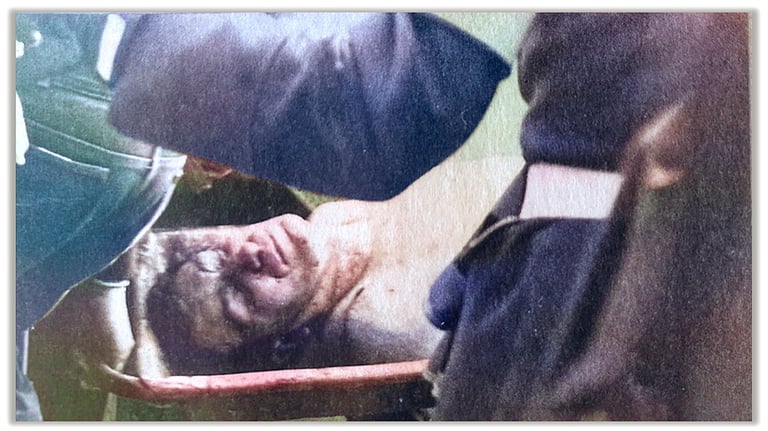



Interior of the Supreme Court of Justice of Colombia 1985: The Army used war tanks, rockets, and Claymore bombs inside the Palace of Justice to impact the walls near the location where the hostages were being held.
RUMOR 1: La Hipótesis de la Bala Mágica - Los disparos sufridos por el Magistrado Gaona Cruz fueron hechos por el Ejército a través del agujero del baño o desde la parte superior de la escalera adyacente al baño, ya que sus heridas mortales fueron causadas con armas cortas y la guerrilla no utilizó pistolas o armas cortas.
The rumor that reached the Justice Gaona's family was described in the following terms: "the bullet wounds suffered on Justice Gaona's head could not have been inflicted by the guerrilla, since they were short-barreled weapon wounds and—according to the rumor—the guerrilla did not use short-barreled weapons during the attacks to the Palace of Justice" The sons of Justice Gaona publicly reported the rumor and even requested that both the Truth Commission of the Supreme Court of Justice and the Attorney General's Office analyze its veracity; however, neither the Commission nor the Prosecutor's Office could prove the rumor, and in the flexible effect of time, four insurmountable pieces of evidence left the rumor unfounded, starting with:
(1) Declarations and Testimonies concerning the Weapons Used by the M-19: The material evidence analyzed to test the rumor's possibility included, besides the declarations of paramilitary leader Carlos Castaño and Pablo Escobar's lieutenant and head of security, John Jairo Velásquez Vásquez (alias "Popeye"), both related to the delivery of "short-barreled weapons" to the M-19 guerrilla, the long-standing testimony of Supreme Court Civil Chamber Justice Hernando Tapias Rocha, who was with Constitutional Chamber Justice Manuel Gaona Cruz until the end and who testified under oath (before the 77th Criminal Investigating Judge of Bogotá in 1986) to having seen M-19 guerrillas bring short-barreled weapons into the third-floor bathroom where they were held hostage, just before the Justice's execution; this testimony aligns with those given by Amanda Leal de Gallego (Secretary), who described in detail the revolver carried by guerrilla leader Andrés Almarales Manga, as well as the testimony of Lucía Bermúdez de Sánchez (Secretary of Labor Chamber Justice Nemesio Camacho Rodríguez), who reported the presence of short-barreled weapons among the guerrillas from the beginning of the takeover, and the testimony of Jorge Antonio Reina Orjuela, who, subsequently, witnessed Justice Manuel Gaona Cruz's execution.
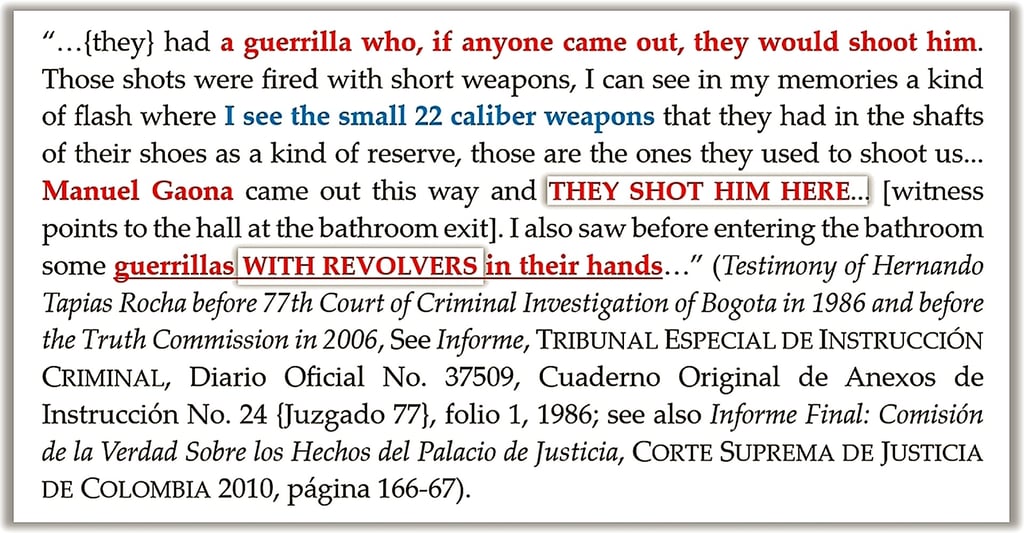



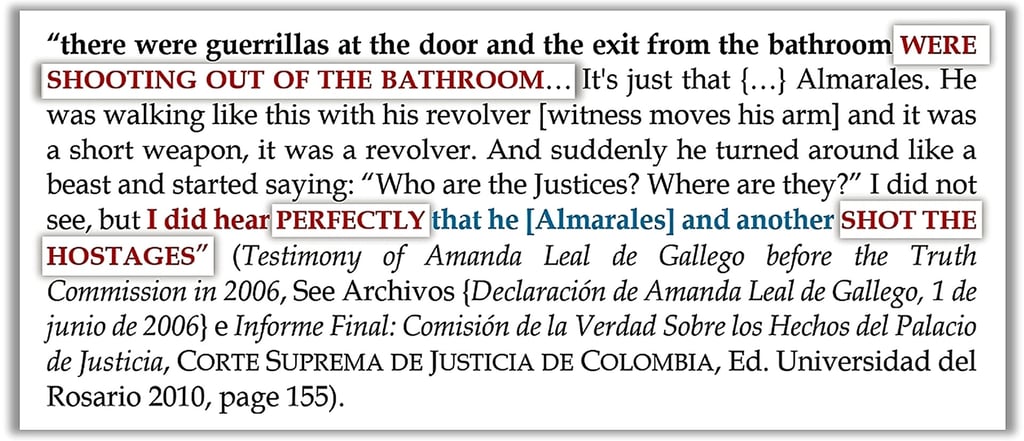



Amanda Leal de Gallego Secretary Supreme Court of Colombia




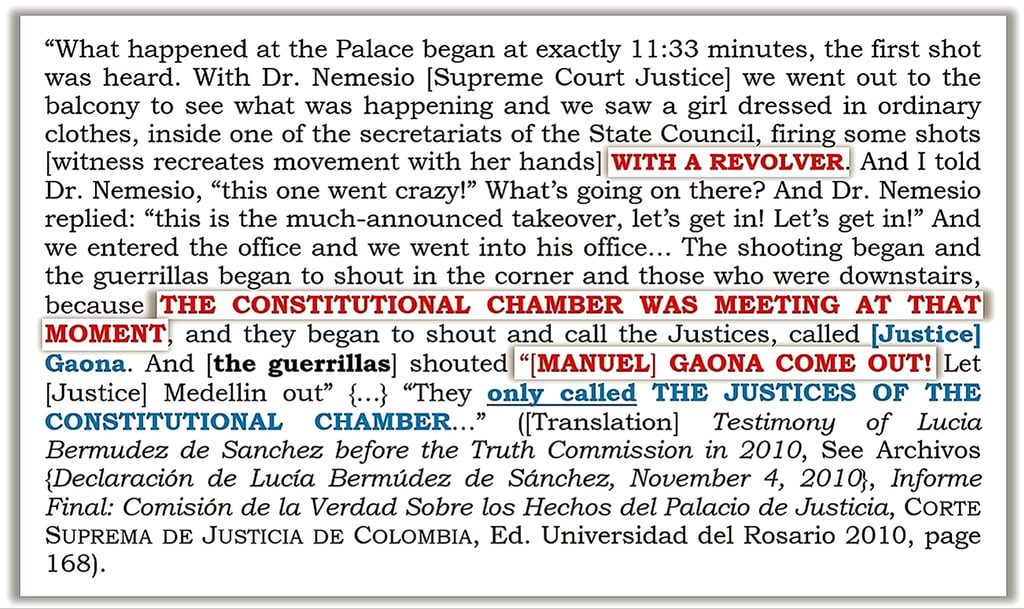

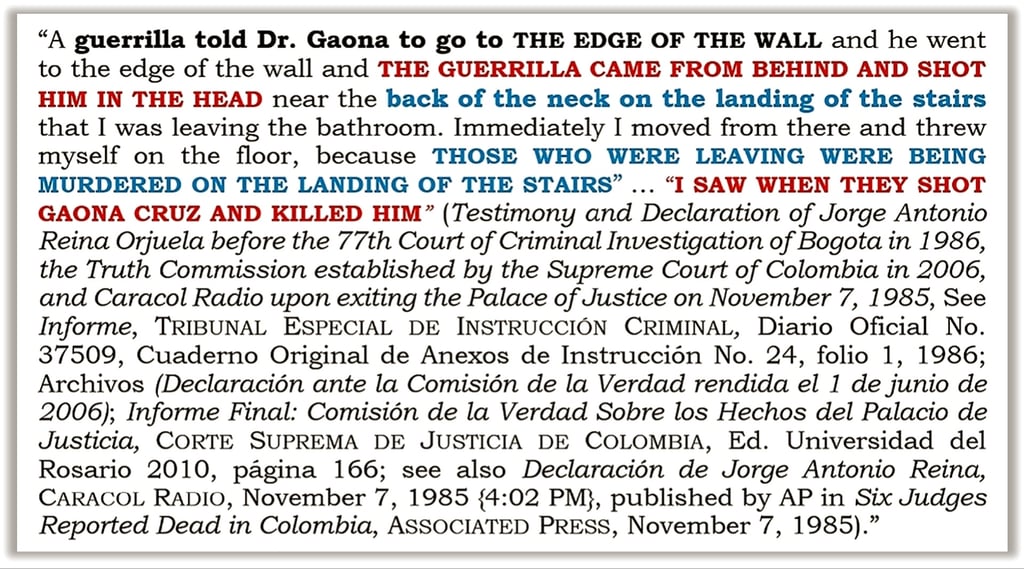

(2) Ballistic Expert Evidence and Ballistic Spatial Study: From a legal and scientific standpoint, bullets are not marked with the name or registration of their owner, and the bullets found in Justice Gaona's body lacked any record indicating ownership by the Army or the M-19 guerrilla; any plausible indication would have to be constructed from the circumstances of the manner, time, and place in which the crime was committed; the ballistic expert evidence unequivocally indicates that the shots received by Justice Manuel Gaona Cruz were made (i) with a short-barreled weapon and (ii) from 30 centimeters away, two technical findings confirmed by the autopsy (see below), the judicial inspection (77th Court), and the declarations of the eyewitnesses to the crime (See MGC Death – Testimonial Evidence). The "Magic Bullet Hypothesis" posits that the Army, using a pistol or revolver, would have shot either from outside the building through the bathroom hole or from the top of the stairs adjacent to the bathroom; besides its physical impossibility, this theory fails against the overwhelming ballistic and necropsy expert evidence, which places the assassin or assassins of Manuel Gaona Cruz at a distance of 30 centimeters, and determines the victim's position and the place of death: at the exit of the bathroom hall/lobby that leads to the stair landing between the second and third floors on the northwestern side of the Palace of Justice. The first proposition of the magic bullet hypothesis states that the shot to Manuel Gaona Cruz would have been made with a short-barreled weapon from outside the perimeter of the bathroom, with a trajectory entering through the hole in the towel rack wall to reach the nape of the neck, the left temple, and the right shoulder of Justice Gaona; however, as observed in the annexed ballistic spatial study (See Estudio Espacial Balístico en 3D No. X-3-2025 {bottom left}), combining all evidence (ballistics, judicial inspection, crime eyewitnesses), Manuel Gaona Cruz was (i) more than five meters away from the bathroom hole, (ii) leaving the bathroom, near the outer lobby door adjacent to the bathroom and the contiguous cleaning room door, (iii) protected by a concrete wall located on the opposite wall from the hole, and (iv) outside the crossfire area he refused to enter, or, in the victim's own words: "We are not going to serve as cannon fodder... We are not going out this way. No! I am not moving from here" (Manuel Gaona Cruz).
(4) Dying Declaration of the Victim:The victim's reluctance to leave the bathroom with his arms up and serve as a human shield for the guerrillas who were pointing at him from behind and the side is incontestable evidence, not only of the cowardice and atrocity of the crime committed by the M-19 guerrilla, but also of Justice Manuel Gaona Cruz's final fate; the equally distant and fundamental problem with the rumor of an alleged exit and subsequent execution of Justice Gaona at the hands of the Army, and not by his proven perpetrator, the M-19 guerrilla, is that neither the evidence collected, nor the investigations conducted, nor the victim's final declaration support its existence. Worse still, unlike the rumor about Justice Gaona's eventual exit, there are a dozen eyewitnesses whose declarations recount the moments preceding, concomitant with, and subsequent to his assassination at the hands of the M-19 guerrilla and inside the Palace of Justice (See Ultimas Palabras del Magistrado Manuel Gaona Cruz in MGC Muerte – Responsabilidades por el Asesinato del magistrado Manuel Gaona Cruz: Responsabilidad del M-19). In the end, the rumor loses its speculative pretense against the natural apprehension of the history of crimes against humanity: the victims remember, and the victim's final words constitute a differential and decisive piece of evidence in most of the world's procedural systems.




Eventually, the rumors regarding the alleged exit of Justice Manuel Gaona Cruz alive were summarized and articulated by recognized columnists in Colombia. The rumor about Justice Gaona's supposed exit from the Palace of Justice appeared in a column written by journalist Daniel Coronell (See Daniel Coronell, Misterios Sin Resolver, REVISTA SEMANA, January 15, 2010). However, the rumor was pre-existing and echoed among members of the M-19 guerrilla and the Communist Party in Colombia, who relied on the supposed existence of hearsay witnesses to lend credit to the rumor—that is, versions from people who did not witness the events but deduce their existence from the account of others who claim to have witnessed or heard them (e.g., "I was told that another person said, saw, or was told"). More specifically, the rumor originated from a photograph published by the Secretary of the Communist Party of Colombia and former leader of the Patriotic Union, José Manuel Cepeda Vargas, in the newspaper La Voz, with a note suggesting that Justice Gaona had left the Palace of Justice alive, even though in the only photograph where his face is actually visible, Manuel Gaona Cruz appears deceased. Nevertheless, while it may have seemed reasonable at some point, the rumor about Manuel Gaona Cruz exiting the Palace of Justice alive presents ten structural flaws:
The family of Justice Manuel Gaona Cruz—that is, his wife and children—never maintained as a fully proven fact that Justice Manuel Gaona Cruz had left the Palace of Justice alive only to be executed by the Army and have his body returned to the Palace, as they had no direct knowledge of such an event. What one of the Justice's sons (Manuel Gaona Bejarano) did was publicly report the existence of the rumor as a serious indication that needed to be investigated to the highest instances, even by international justice, not because the family was the original or direct source of the rumor, but because they wanted to reach the truth (See Familiares de Magistrado Muerto en el Palacio de Justicia Piden Que Asesinato Sea Considerado Delito de Lesa Humanidad, CARACOL RADIO, November 4, 2009). However, after 40 years of investigation, the rumor was never proven, and the family of Justice Manuel Gaona Cruz did not file any claim before the Inter-American Court of Human Rights because the necessary and sufficient evidence to do so did not exist. Despite the doubts some people expressed regarding Justice Manuel Gaona Cruz's crime ("it is said that he also left the Palace," "who allegedly left alive"), the evidence supporting the commission of his crime at the hands of the M-19 guerrilla and inside the Palace of Justice was never discredited by any national or foreign authority. Such evidence (not rumors) includes: (i) judicial inspections aimed at reconstructing the crime scene, (ii) more than half a dozen eyewitnesses who declared and described the crime in detail and under oath, (iii) expert evidence from necropsy and ballistic trajectory studies, (iv) documentary evidence related to the death threats Justice Gaona received from Los Extraditables (not the military), (v) seven investigations that detailed his death, (vi) letters and threats from Pablo Escobar and Los Extraditables against Justice Gaona and his children, (vii) a criminal complaint filed by Manuel Gaona Cruz himself three days before the Palace of Justice takeover against Los Extraditables, (viii) reports and sentences on the constitutionality of the law approving the Extradition Treaty by Justice Gaona, and (ix) the victim's declaration before dying.
Over the years and through different instances, languages, and media, the children of Justice Manuel Gaona Cruz have sought and demanded the investigation of not only the Army, but all actors in the conflict who participated in the events at the Palace of Justice, including the M-19 guerrilla, Pablo Escobar and Los Extraditables, as well as the Government of President Belisario Betancur Cuartas. In short, for the family, the crime of Justice Manuel Gaona Cruz was a crime against humanity. In the search for truth, the Justice's children and wife spoke with dozens of people, journalists, writers, producers, judges, magistrates, prosecutors, experts, and lawyers. Many versions reached the family which, for the most part, seemed contradictory and which, eventually, after detailed examination, turned out to be false or, at best, highly speculative.
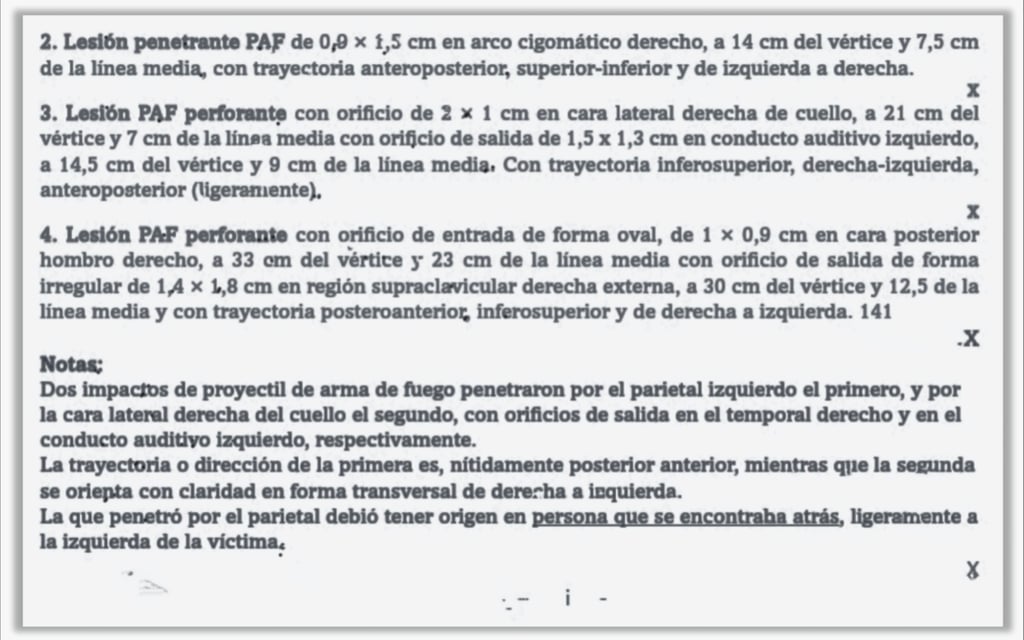

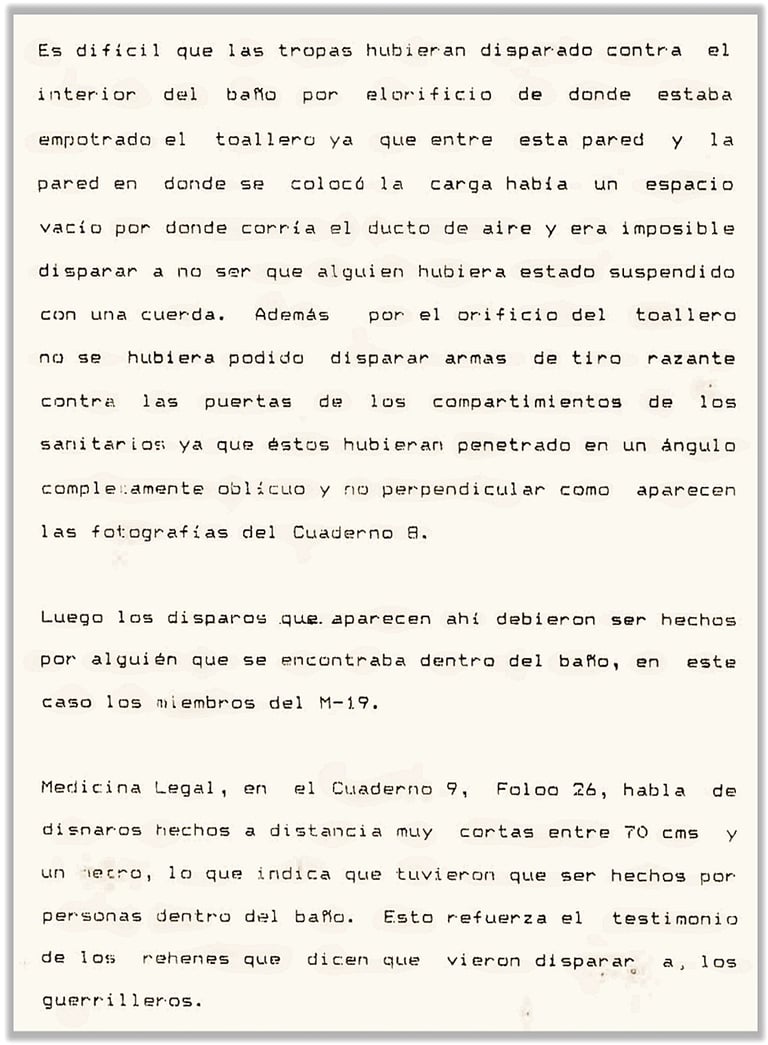

Justice Manuel Gaona Cruz is transported lifeless by Police and Legal Medicine agents through the main entrance of the Supreme Court of Colombia on November 7, 1985 (2:45 P.M.).
Corpse Removal Procedure - Manuel Gaona Cruz Official record of the corpse removal procedure (Acta No. 1141) for Justice Manuel Gaona Cruz was conducted by the General Directorate of Legal Medicine (Ministry of Justice) on the first floor of the Palace of Justice on November 7, 1985, at 2:00 P.M.
RUMOR 3:The Hypothesis of Investigations Against the Military by Justice Manuel Gaona Cruz - The rumor suggests that drug trafficking had nothing to do with the takeover, and that Justice Gaona Cruz was executed by the Army because he was conducting investigations against military personnel and because of his 1981 ruling on the 1978 Security Statute.
In an attempt to gain greater public exposure in the case of some persons disappeared by the Army, to erase from the public memory the criminal relationship between Pablo Escobar, Los Extraditables, and the M-19 guerrilla in the Palace of Justice takeover, and to reorient the motive of the attack around the Army to push the narrative that the M-19 guerrillas were victims just like their hostages, the rumor that reached the family of Constitutional Chamber Justice Manuel Gaona Cruz was that he had been assassinated by the Army for having carried out investigations against military personnel and for his position regarding the Security Statute issued in 1978 by the government of the then-President Julio César Turbay Ayala. Naturally, to be effective and credible, the narrative behind the rumor required—and inherently implied—that Justice Gaona had left the Palace of Justice alive, making it necessary, just like the previous rumors, to deny his assassination at the hands of the M-19 at all costs and to discredit the declarations of the eyewitnesses to his crime. In a final attempt to erase one of the most shameful facts of the Palace of Justice takeover, namely the atrocious assassination of Supreme Court Justice Manuel Gaona Cruz at the hands of the M-19 guerrilla amid the violence of the armed forces and the institutional, moral, and constitutional abandonment of the Betancur Government, a rumor has been woven that tends to replace the primary motive that is antecedent, concomitant, and subsequent to the Palace of Justice takeover (e.g., eliminating the Constitutional Chamber Justices who were preventing the fall of the Extradition Treaty between Colombia and the United States, destroying the evidence and case files against Pablo Escobar, the Medellín Cartel, and Los Extraditables, and preventing the declaration of constitutionality of the treaty-law on the day and time the fate of the world's richest and most powerful criminal organization was being decided in November 1985), a motive which has been referred to by M-19 guerrilla leaders as "the official version" (See Declaration of Gustavo Petro in Esa es una Mentira Oficial, SEMANA EN VIVO, June 18, 2020, http://www.youtube.com/watch?v=fAfmHNBgiA8).
In March 2024, the daughter of Dr. Carlos Horacio Urán Rojas, Helena Urán Bidegain, who worked as an advisor in the Colombian Foreign Ministry during the administration of the president and former M-19 guerrilla leader, Gustavo Petro Urrego, contacted one of Manuel Gaona Cruz's nine siblings, José Santiago Gaona Cruz, to ask him for an interview with Revista Cambio regarding Justice Manuel Gaona Cruz's exit from the Palace of Justice alive. It is noteworthy that there is currently a lawsuit by the Urán family against retired Army Colonel Alfonso Plazas Vega in the U.S. Federal Court for the Southern District of Florida (See Bidegain et al v. Plazas Vega, UNITED STATES DISTRICT COURT SOUTHERN DISTRICT OF FLORIDA, Case No. 22-60338, https://www.govinfo.gov/app/details/USCOURTS-flsd-0_22-cv-60338). It is equally noteworthy that in July 2024, the Attorney General's Office refrained from issuing an indictment in the case of Carlos Horacio Urán Rojas, considering that the Assistant Lawyer of the Council of State did not leave the Palace of Justice alive; this decision came despite the 2014 ruling by the Inter-American Court of Human Rights, which recognized the disappearance of Dr. Carlos Horacio Urán Rojas (See Ana Maria Cuesta, Polémica por el Holocausto del Palacio de Justicia: ¿La Fiscalía desconoce que el ex magistrado Carlos Horacio Urán salió con vida del Palacio?, EL TIEMPO, July 30, 2024).
In response to the announcement that students and journalists had allegedly seen Justice Manuel Gaona Cruz leave the Palace of Justice alive, the family even considered the possibility of filing an international lawsuit against the Colombian armed forces before the Inter-American Court of Human Rights. This intention was promoted and shared in the media by one of the Justice's sons, Manuel Gaona Bejarano. However, after examining the accounts of those believed to be potential witnesses and confirming that such accounts either did not exist, that in no case had these witnesses been fully identified, and, worse still, that none were prepared to testify under oath, the family abandoned the action—especially upon additionally verifying that Justice Manuel Gaona Cruz was not part of the list of disappeared persons that the Attorney General's Office had prepared and published, which had led to indictments against the military commanders who directed the operations to retake the Palace of Justice and had promoted legal actions before the Inter-American Court of Human Rights.
(1) "Family members of Justice Gaona say he left the Palace of Justice alive." IT IS NOT CORRECT. The interview was given by only one family member, José Santiago Gaona Cruz, who was one of the Justice's nine siblings, so his statement does not represent the entire family, as it does not align with the experience of the family members who lived with Manuel Gaona Cruz and who were the exclusive and direct target of death threats and telephone wiretaps by Pablo Escobar and Los Extraditables, namely his wife and children. While the children of Justice Manuel Gaona Cruz publicly reported the existence of a rumor regarding the alleged exit of Justice Gaona alive and subsequent execution by the Army and, given the seriousness of the rumor, asked the competent authorities to investigate the homicide of their father to the fullest extent in relation to all parties in conflict, it is also true that the Justice's son, J. Mauricio Gaona, has publicly and repeatedly stated that his father was murdered by the M-19 guerrilla inside the Palace of Justice and on the orders of Pablo Escobar. In 2006, in an interview with the Caracol network journalists Yolanda Ruiz, Judith Sarmiento, and César Augusto Londoño, J. Mauricio Gaona provided a detailed body of evidence regarding his father's assassination, while expressly asking the M-19 guerrilla leaders to assume and acknowledge their responsibility for the human rights violations perpetrated and for the crimes against humanity committed in the attack on Colombia's Palace of Justice (Listen to J. Mauricio Gaona's full statement in Exclusivo: Mauricio Gaona, Hijo del Ex Magistrado Manuel Gaona, Asesinado Hace 21 Años en el Palacio de Justicia, CARACOL RADIO, November 16, 2006 {Audio - below}). In 2023, the son of Justice Gaona, J. Mauricio Gaona, was invited by professors and students of the New York University School of Law to record an episode on human rights for the University's Podcast; at the event, Professor Gaona reiterated, once again, the criminal relationship and the responsibility of the M-19 guerrilla, Los Extraditables, and Pablo Escobar in the kidnapping and assassination of his father (Listen to podcast on SPOTIFY – Episodio 7 – Perceptional Gaps and Human Rights, UNIVERSIDAD DE NUEVA YORK, FACULTAD DE DERECHO, April 18, 2023 [minute 5:45 to 8:40]).
(2) "The Truth Commission washed its hands and never called the family of Justice Manuel Gaona Cruz." THIS IS NOT TRUE. The wife and eldest sons of Justice Manuel Gaona Cruz appeared before the Commission and, in fact, met with the three members of the Truth Commission for three and a half hours at the Supreme Court of Justice in 2006. During the meeting, Justice Gaona's family handed over the evidence they possessed regarding the threats and letters from Pablo Escobar and Los Extraditables against Manuel Gaona Cruz and his eldest sons; furthermore, the Justice's wife and eldest sons gave statements to the Commission and explicitly requested that all parties, all facts, and all rumors be investigated. The Truth Commission did not call Manuel Gaona Cruz's brother, José Santiago Gaona Cruz, to testify for five elemental reasons: (i) they didn't know him and couldn't be expected to interview all relatives and kin of every Palace of Justice victim, (ii) Manuel Gaona Cruz had not one, but nine siblings, (iii) José Santiago Gaona did not live with Manuel Gaona Cruz, as the latter had left his paternal home to live with his wife since 1966, (iv) José Santiago Gaona was not the target of the threats from the Medellín Cartel and Pablo Escobar that arrived at Justice Manuel Gaona Cruz's house, (v) Manuel Gaona's brother was unfamiliar with Justice Gaona Cruz's work, as he even stated in his interview with Revista Cambio that the threats were from the military because, according to him, "my brother was conducting investigations against the military," and (vi) because Manuel Gaona Cruz's wife did appear to identify her husband's body, since she knew him better than anyone.
(3) "The threats against Manuel Gaona Cruz were from the military because of investigations Justice Gaona was conducting against military personnel." THIS IS NOT TRUE. For the following reasons: (i) as has been widely documented (See MGC Death – Documental Evidence: Death Threats from Pablo Escobar and the Extraditables), Manuel Gaona Cruz, his wife, and his children were threatened solely and exclusively by Pablo Escobar and Los Extraditables due to the Justice's legal position (e.g., his intermediate thesis that prevented the declaration of unconstitutionality of the law approving the Extradition Treaty) and his institutional position in the Court (e.g., the Constitutional Chamber reporting Justice in charge of studying the constitutionality and enforceability of the treaty-law on the day and hour of the attack on the Palace of Justice), (ii) the Justices of the Supreme Court's Constitutional Chamber did not conduct investigations against military personnel; they decided lawsuits, (iii) cases against the military—including, incidentally, the case for human rights violations against General Zamudio—were not handled by the Supreme Court of Justice, but by the Third Section of the Council of State, whose decision was not even remotely reviewable by the Constitutional Chamber to which Justice Gaona belonged, and (iv) if the objective of the takeover had been to assassinate Justice Gaona due to investigations he never carried out, or due to the decision in which the Justice participated 3 years before the Palace of Justice takeover in 1982 (CSJ, Manuel Gaona Cruz, Sentence No. 57, Process No. 978/111E, 1982 {delivering the opinion of the Court}), whose report was related to the constitutionality of the new decree that eliminated the old Security Statute promulgated by the Turbay Government in 1978 (See Decreto Legislativo 1674 de 1982; see also Estatuto de Seguridad, Decreto 1923 de 1978, October 30, 1978), or due to his role as President of the Commission Drafting the National Police Code in 1977 and 1978 (when he was acting as Deputy Minister of Justice), the military or police had innumerable opportunities to assassinate him, whether during the years he had no escort (from January 1978 to July 1985) and taught constitutional law at the General Santander Military School, or through the Police agents who guarded his home as the first security ring during the months preceding the Palace of Justice takeover after he received death threats from Pablo Escobar, the Medellín Cartel, and Los Extraditables (from August to November 1985). In the virtue that exists for truth, however, it must be noted that Justice Manuel Gaona Cruz held a very defined and critical legal position regarding the pretended constitutional competence to allow the military to judge civilians using the 1978 Security Statute, as well as against the Turbay Government's decree that sought to alter the Constitutional Chamber's voting system on decisions related to the enforceability of the government's legislative decrees (See MGC Life – Manuel Gaona Cruz and the Fall of the 1979 Colombian Constitution); furthermore, it must be noted that the constitutional doctrine that originated his report before the Supreme Court's Plenary Session ("military justice is for the military") caused resentment among some members of the Colombian military establishment. Finally, it must be noted that neither Justice Gaona's report nor the Court's sentence were aimed at determining whether the Turbay Government's Security Statute was constitutional or not, but rather whether the decree issued four years later by the Betancur Government to lift the state of siege and reestablish public order was constitutional or not (See CSJ, Manuel Gaona Cruz, Sentence No. 57, 1982, id. {delivering the opinion of the Court}).
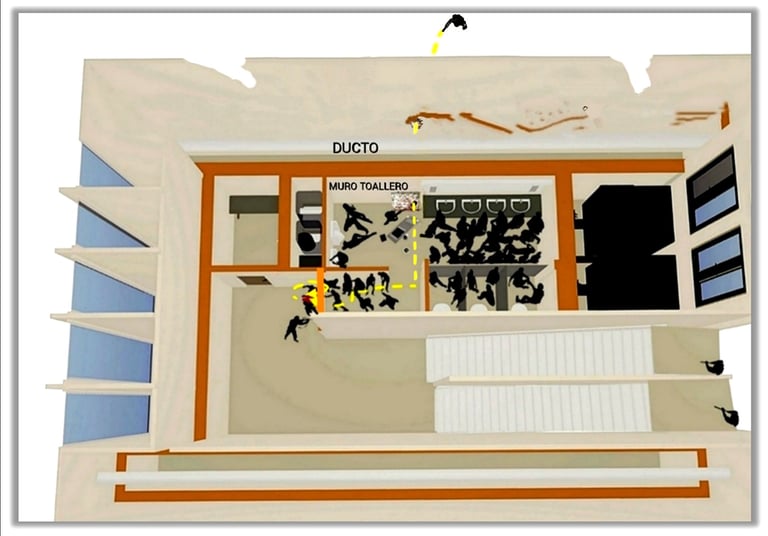

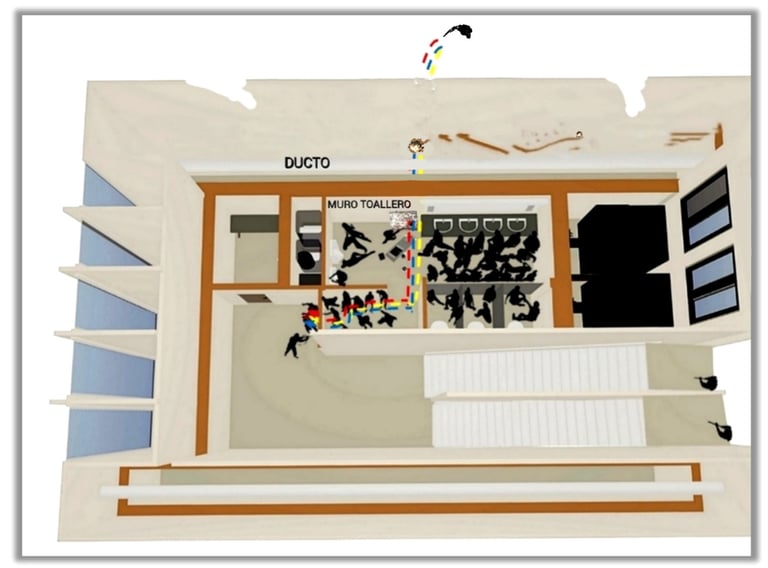

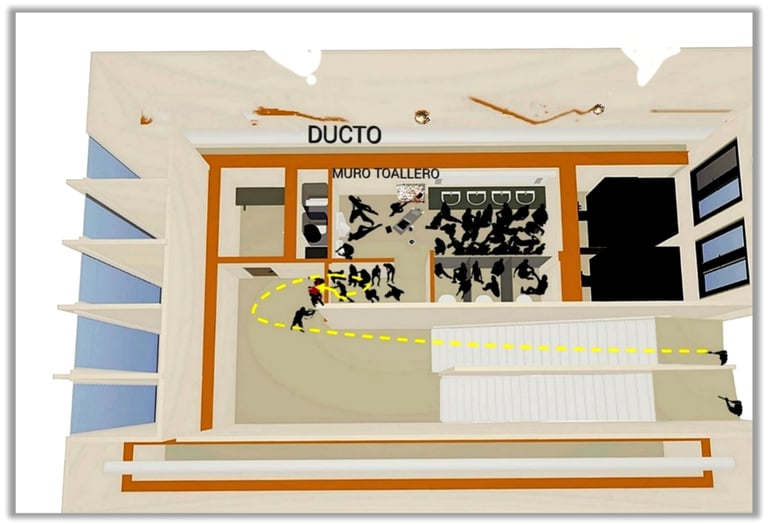

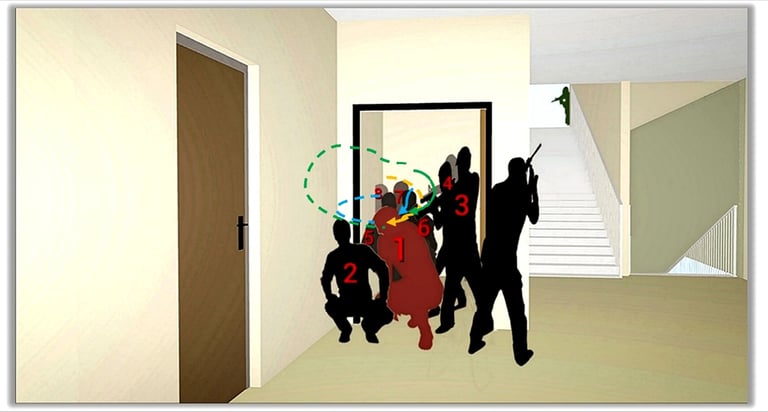

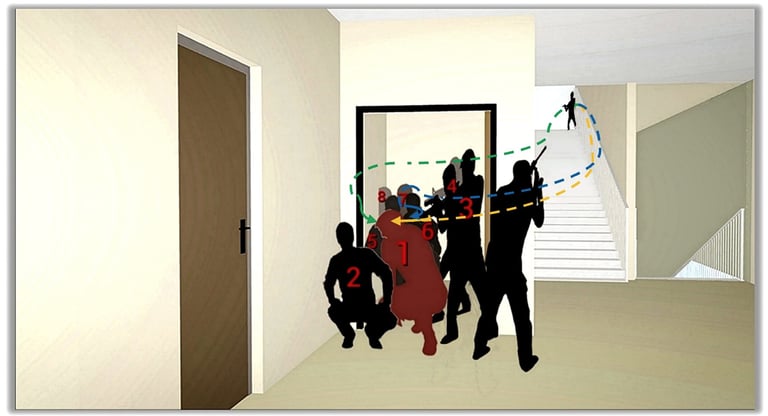

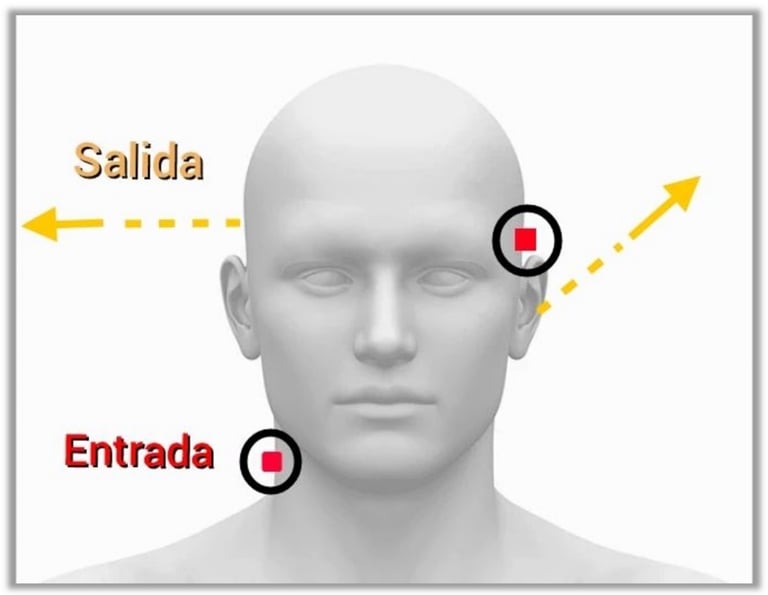

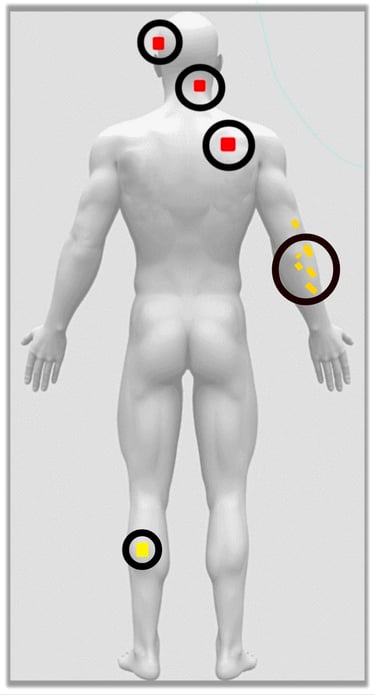


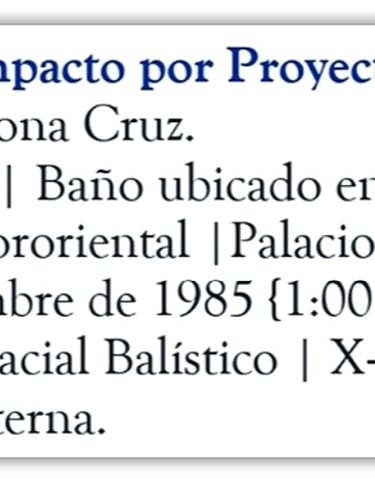

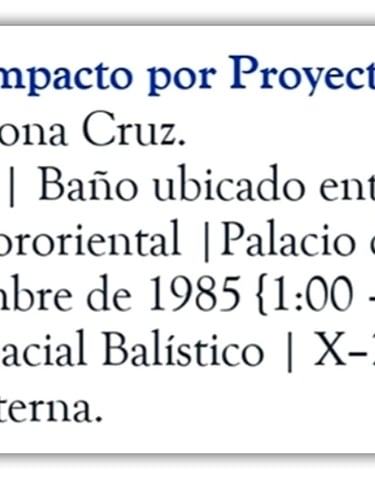
Following the end of the takeover and the retaking of the Palace of Justice around 2:10 p.m., the Army's operational command, in coordination with the national police, ordered all bodies from the upper floors to be moved to the first floor. The procedure for lifting the body of Justice Manuel Gaona Cruz took place as soon as the takeover was over. It was performed on Thursday, November 7, 1985, at 2:30 p.m. on the first floor of the Palace of Justice. At that time, Manuel Gaona Cruz was still wearing his clothes; the same ones his sons and wife saw him leaving home in on the morning of Wednesday, November 6. The description of the clothes worn by the Justice at the time of his death and documented in the official report is unequivocal: "light blue shirt, white t-shirt, black striped cloth pants, white underwear, blue socks, shoes, dark blue tie with red specks" (See Report on the Lifting of the Body of Manuel Gaona Cruz, Act No. 1141 of November 7, 1985, DIJIN/GENERAL DIRECTORATE OF LEGAL MEDICINE). For its part, the Necropsy Protocol of Justice Manuel Gaona Cruz reveals three bullet wounds with entry trajectories in the left parietal ("left temple"), the lateral side of the right neck ("back of the neck"), and the upper right shoulder blade ("right shoulder"), with exit trajectories in the right frontal midline, the left ear canal, and the right frontal clavicle, respectively. Additionally, the necropsy indicates minor wounds on the right arm ("shrapnel") and the lower third of the left leg ("hole") (See Necropsy Protocol of Manuel Gaona Cruz No. 3778/85, GENERAL DIRECTORATE OF LEGAL MEDICINE, Internal Ballistics Registration No. 974-85-DC-FLB).
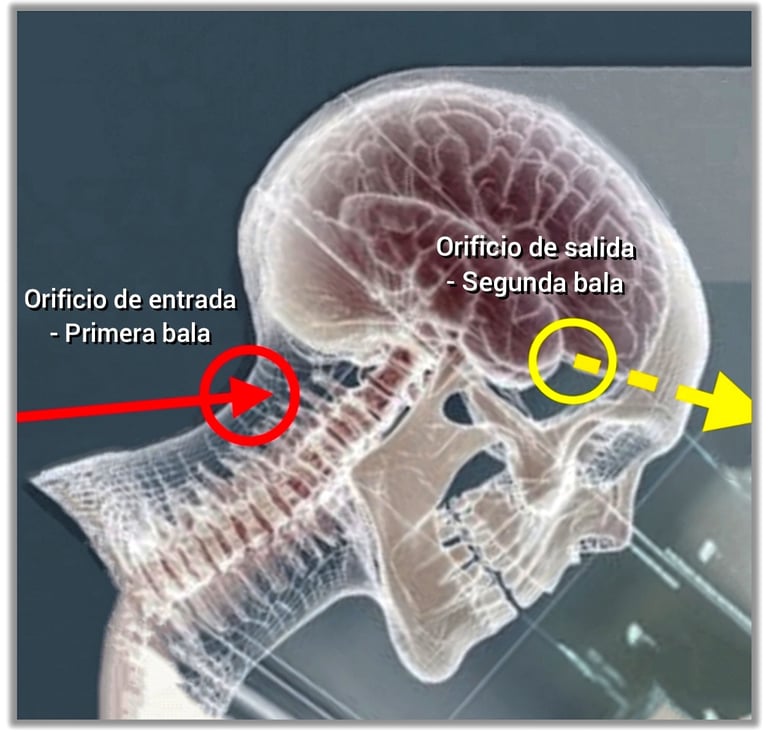

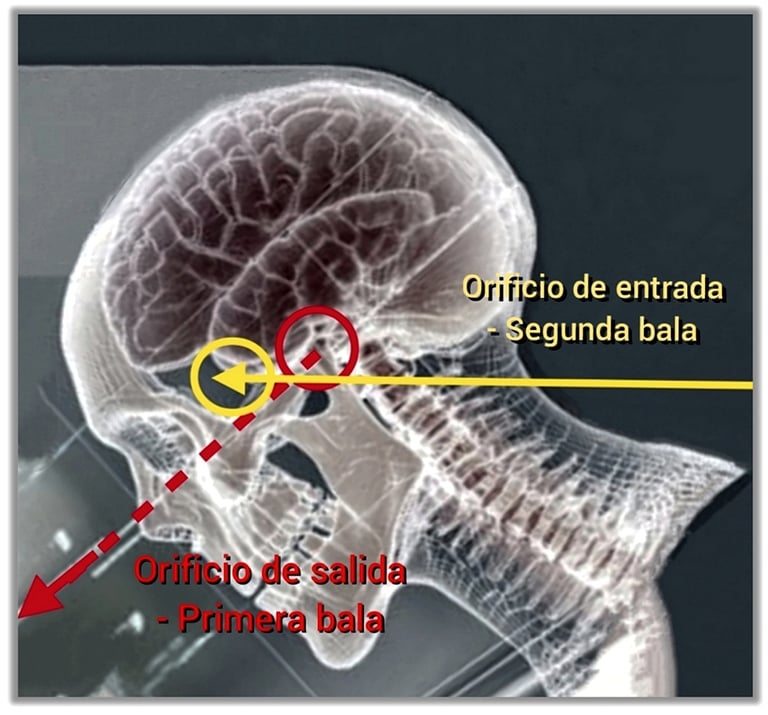


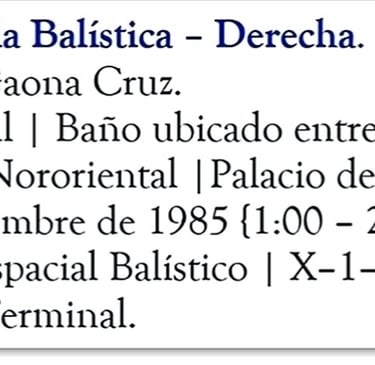

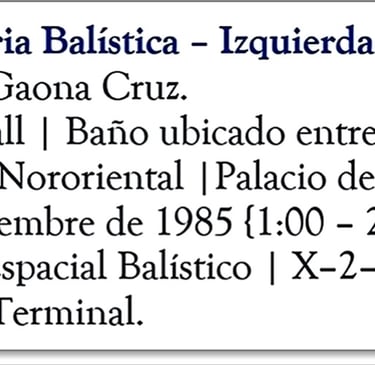

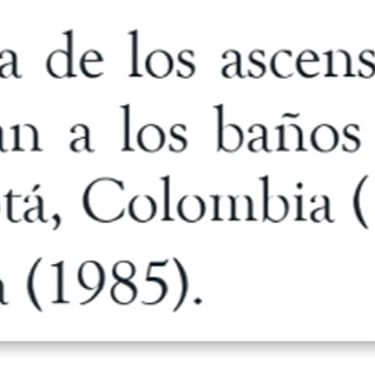

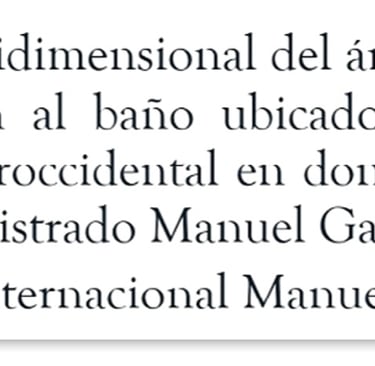

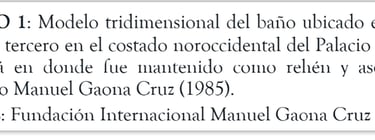

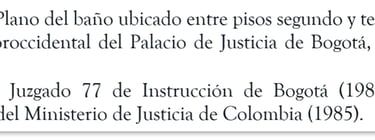

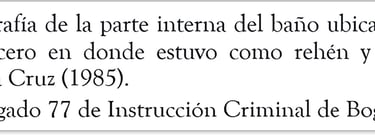

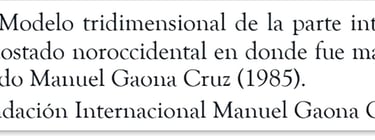
All rights reserved © J. Mauricio Gaona - Manuel Gaona Cruz Foundation - 2025.
FIRST SCENE: INICIAL DISTRIBUTION OF HOSTAGES AND GUERRILLEROS INSIDE THE RESTROOM
After shouting his name through the fourth-floor hallways and ordering him to come out with his hands up, M-19 guerrillas took Justice Manuel Gaona Cruz hostage, along with Constitutional Chamber Clerk Ricardo Correal Morillo and process server Héctor Darío Correa. The three had been taking shelter in Justice Ricardo Medina Moyano's office after the session of the Constitutional Chamber was abruptly interrupted by gunfire and shouting from the lower floors. Manuel Gaona Cruz was led to the offices on the opposite side of the fourth floor where the guerrillas had begun to gather the first hostages—including, among the detained justices, the President of the Court—under the command of guerrilla leader Luis Otero. Manuel Gaona Cruz was the only justice who managed to escape from that group of hostages. In fact, Nemesio Camacho Rodríguez (who was hiding in his fourth-floor office with his secretary, Lucía Bermúdez de Sánchez) and Manuel Gaona Cruz were the only justices who survived the guerrilla attack, the Army's counterattack, and the fourth-floor fire. Manuel Gaona Cruz was stopped by an M-19 guerrilla as he tried to escape down the northwestern stairwell on the second floor. Subsequently, Justice Gaona was led to the bathroom located between the third and second floors, where the group of guerrillas was commanded by Andrés Almarales Manga. Upon arriving at the bathroom and seeing his colleague, Labor Chamber Justice Nemesio Camacho Rodríguez, Manuel Gaona Cruz, emotional, hugged him and said, "I thought you were dead, I think it's just the two of us left" [referring to the justices from the fourth floor]. The hostages were placed on the floor and in the toilet stalls, while the guerrillas positioned themselves against the urinal wall, in the bathroom lobby, and at the door. According to the judicial inspection of the bathroom and the testimonies related to it, the guerrillas took turns lying down and resting on the sink cabinet. The guerrillas would turn the light on and off intermittently after each shift (See MGC Death – Testimonial Evidence; see also Final Report, SPECIAL CRIMINAL INSTRUCTION TRIBUNAL, Decree 1917 of 1986, Official Gazette CXXII, No. 37509, June 17, 1986).
FACTICAL RELATION
VISUAL RELATION
NUMERIC RELATION
1. Manuel Gaona Cruz (Justice).
2. Luz Estella Bernal Marín (Assistant Magustrate).
3. Andrés Almarales Manga (M-19 guerrilla).
4. José Gabriel Salom Beltrán (Auxiliary Magist.)
5. Guerrillero resting.
6. Humberto Murcia Ballén (Justice).
SECOND SCENE: EXPLOSION TOWAL RACK WALL
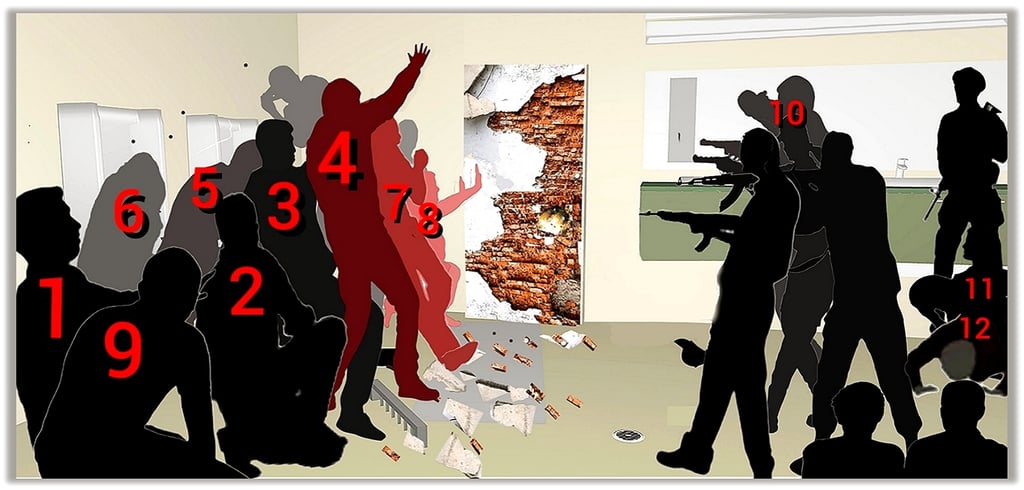

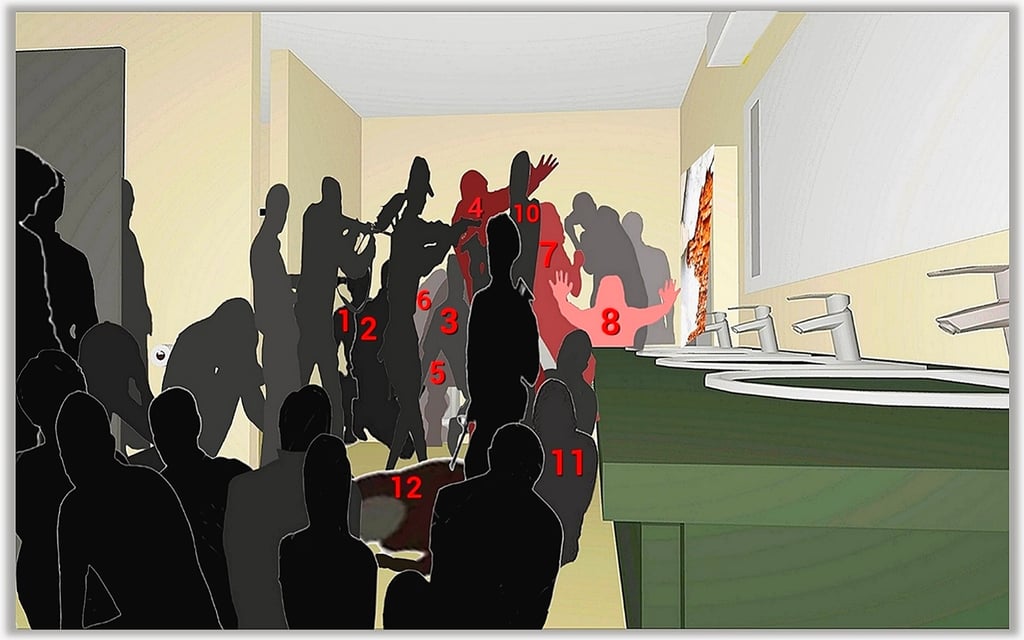

FACTICAL RELATION
The explosions outside the bathroom were felt getting closer. Between 12:45 p.m. and 1:00 p.m., a powerful explosion destroyed part of the outer wall protecting the adjacent duct, while also managing to create a hole in the bathroom's inner wall, specifically in the section that held the towel rack. The blast tore the towel rack from the wall and left an opening near the sink, measuring between 10 and 25 centimeters in radius. As the hostage who was closest to the towel rack wall, and while the explosion left minor injuries on his legs, Auxiliary Magistrate of the Council of State José Gabriel Salom Beltrán watched as the towel rack fell a few centimeters from his feet. Surprised and scared, the guerrillas fell back toward the urinal wall, while the hostages retreated to the opposite wall.
VISUAL PROGRESSION - FRONTAL ANGLE
NUMERIC RELATION
1. Manuel Gaona Cruz (Justice).
FOURTH SCENA: HOSTAGES LINE IN THE RESTROOM'S HALL
FACTICAL RELATION
VISUAL RELATION
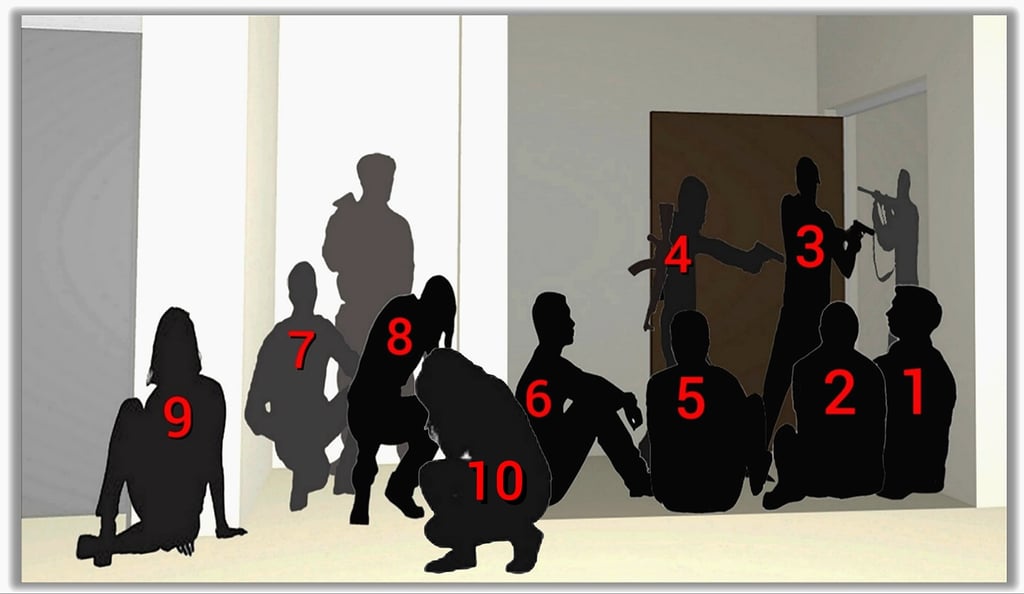

NUMERIC RELATION
1. Manuel Gaona Cruz (Justice).
FIFTH SCENE: EXECUTION OF JUSTICE MANUEL GAONA CRUZ BY THE M-19 GUERRILLAS
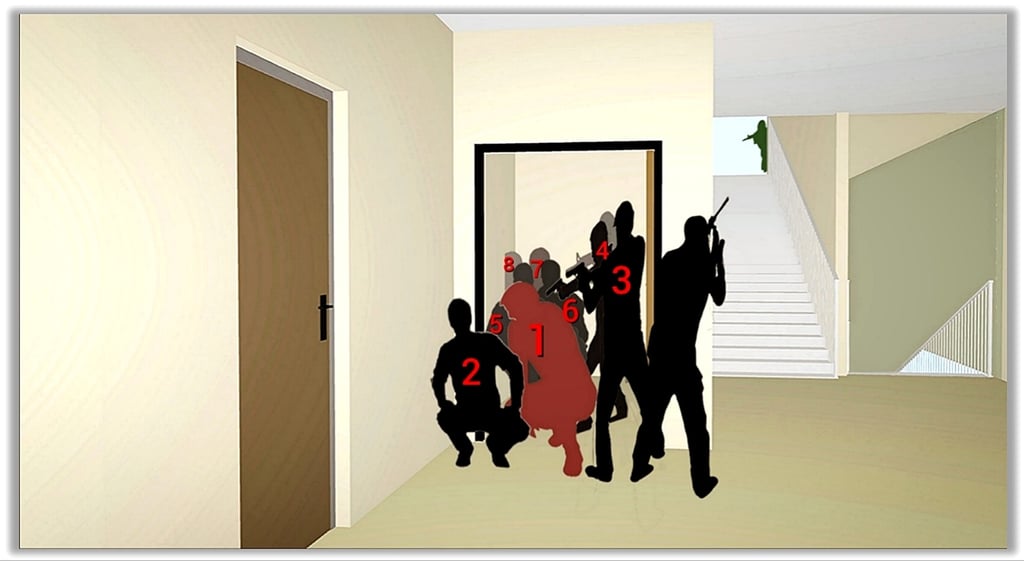

FACTICAL RELATION
After hearing Justice Manuel Gaona Cruz's pleas, and particularly after noticing that the Army was not ceasing its assault, the guerrilla leader Almarales told Justice Gaona: "!Get out! Keep holding hands and head toward the corridor. Don't worry, nothing will happen to you, since you are my last card." Justices Gaona and Salom managed to cross the door frame of the bathroom hall's exit, heading toward the cleaning closet door, when, upon realizing the intensity of the crossfire and the guerrillas' intention to use them as human shields, Manuel Gaona Cruz stopped and told the guerrillas: "This cannot be. We are not going to be cannon fodder; you are going to take us out into the crossfire. This cannot be because they will kill us anyway. You are going to commit a murder." Almarales replied: "We are not going to kill you, the Army will. We just need your corpses to throw out so the fire will stop! Keep walking, get out!" With his last breath, with composure and in a measured voice, Justice Manuel Gaona Cruz responded to the guerrilla leader: "No. We are not going out like this. I am not moving from here." Immediately afterward, Almarales gave the order to execute them, saying: "!Finish them off! Finish this sons of bitches!" In a final reflex, Justice Manuel Gaona Cruz leaned toward the wall where Justice José Gabriel Salom was. Another guerrilla approached from behind and, along with Almarales, they shot him. The shots, fired from 31 centimeters away, hit the back of Justice Gaona's neck, his left temple, and his right shoulder. For his part, José Gabriel Salom received bullet impacts to his legs and back, that is, in the parts not covered by Manuel Gaona Cruz's body, which fell on top of him after the shots. Justice Salom remained underneath Justice Gaona Cruz's lifeless body for almost an hour. Justice Luis Horacio Montoya Gil received a shot in the left eye but did not die at that moment.
VISUAL RELATION
NUMERIC RELATION
1. Manuel Gaona Cruz (Justice).
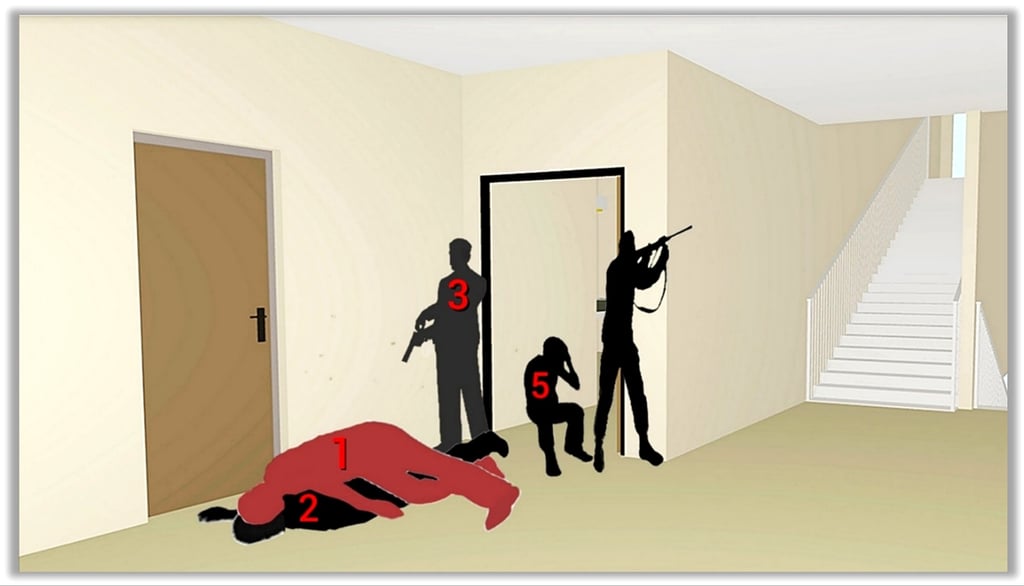

VISUAL PROGRESSION
8. Luz Estella Bernal Marín (Auxiliary Magistrate).
10. Andrés Almarales Manga (M-19 guerrilla).
9. José Gabriel Salom Beltrán (Auxiliary Magist.)
12. Humberto Murcia Ballén (Justice).
2. Nemesio Camacho Rodríguez (Justice).
4. Luis Humberto García (Driver).
3. Jorge Antonio Reina Orjuela (Driver).
5. Hernando Tapias Rocha (Justice).
6. Alba Inés Rodríguez (Law Clerk).
7. Aura Nieto de Navarrete (Law Clerk).
11. María Humbertina Hernández (Employee).
2. José Gabriel Salom Beltrán (Auxiliary Magist.)
3. Andrés Almarales Manga (First shooter M-19).
4. Guerrillero (Second shooter M-19).
5. Luis Horacio Montoya Gil (Justice).
6. Jorge Antonio Reina Orjuela (Driver).
7. Hernando Tapias Rocha (Justice).
8. Nemesio Camacho Rodríguez (Justice).
9. Amanda Leal de Gallego (Secretary).
2. José Gabriel Salom Beltrán (Auxiliary Magist.)
3. Andrés Almarales Manga (First shooter M-19).
4. Guerrillero (Second shooter M-19).
5. Luis Horacio Montoya Gil (Justice).
6. Jorge Antonio Reina Orjuela (Driver).
7. Hernando Tapias Rocha (Justice).
8. Nemesio Camacho Rodríguez (Justice).
The 3D model shown below corresponds to the bathroom located between the second and third floors on the northwestern side of the Palace of Justice in 1985. The forensic reconstruction of the crime scene was created with the assistance of architects, engineers, pathologists, anthropologists, criminalists, and specialized technicians (See Menu – Investigation). It was based on the original floor plans and blueprints of the Palace of Justice, as well as the notes ("sequence of events") and measurements ("bathroom floor plan") taken during the judicial inspection carried out on March 21, 1986, by order of the 77th Criminal Investigation Court of Bogotá (See Expert Report Bathroom 2/3 floors, 77th CRIMINAL INSTRUCTION COURT OF BOGOTÁ, March 21, 1986).
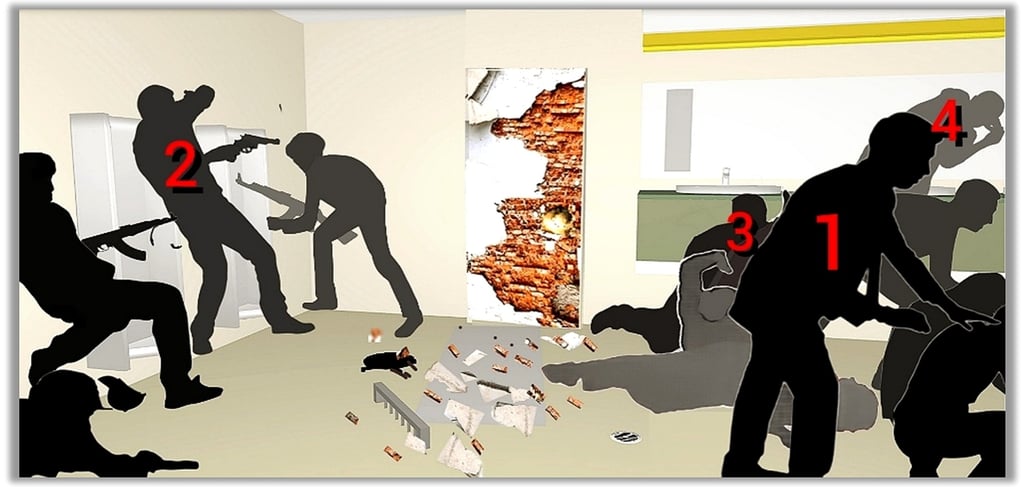

VISUAL RELATION
NUMERIC RELATION
1. Manuel Gaona Cruz (Justice).
2. Andrés Almarales Manga (M-19 guerrilla).
3. José Gabriel Salom Beltrán (Auxiliary Magist.)
4. Humberto Murcia Ballén (Justice).
THIRD SCENE: REDISTRIBUTION AND EXECUTION OF HOSTAGES BY FIRING SQUAD INSIDE THE RESTROOM
After the towel rack explosion in the bathroom, the guerrillas' attitude towards the hostages became more aggressive and violent. In the words of eyewitnesses who were near the guerrillas: "The guerrillas went crazy" (José Gabriel Salom Beltrán), "Almarales became like a beast" (Amanda Leal de Gallego). The guerrilla leader Almarales ordered the hostages to be redistributed in order of importance; the justices in one group and the other Palace of Justice officials in another. The justices were placed in the front row of hostages and positioned against the urinal wall while the guerrillas stood in front of them, as if it were—in the words of one of the witnesses—a "practical firing squad" (Nemesio Camacho Rodríguez). Believing that by joining the group of justices they would have a better chance of getting out, two court drivers, Luis Humberto García and Jorge Antonio Reina Orjuela, positioned themselves in that group of hostages in front of the urinals at the last minute. Sensing that the guerrillas were about to execute the hostages, Justice Hernando Tapias Rocha positioned himself between the two urinals, behind Jorge Antonio Reina and next to Alba Inés Rodríguez. Justice Manuel Gaona Cruz was positioned behind Justice Nemesio Camacho Rodríguez and next to Auxiliary Magistrate José Gabriel Salom Beltrán. These last three were at the end of the urinal wall, leaning against the wall adjacent to the bathroom's lobby/hallway.
VISUAL RELATION
FACTICAL RELATION








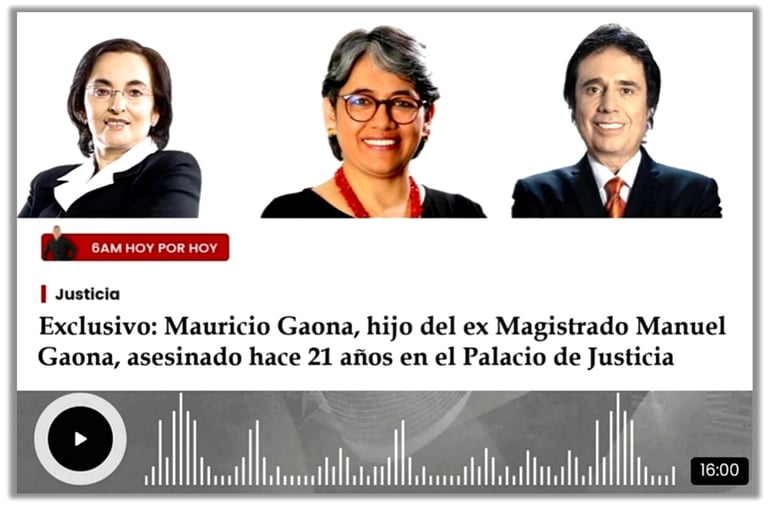

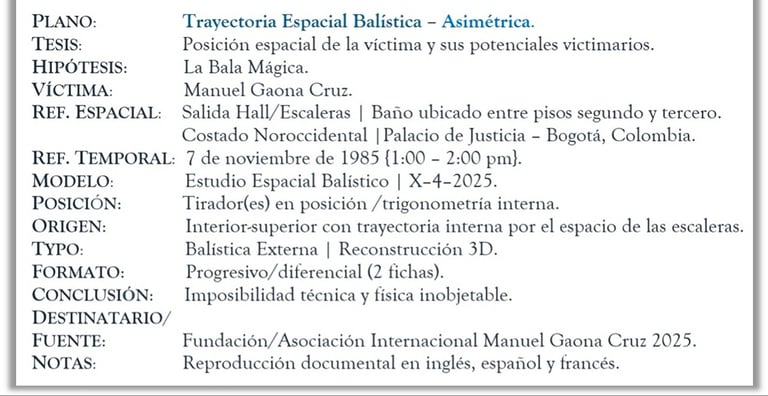

10. Alba Inés Rodríguez (Law Clerk).
Attorney at Law Supreme Court of Colombia
Attorney at Law
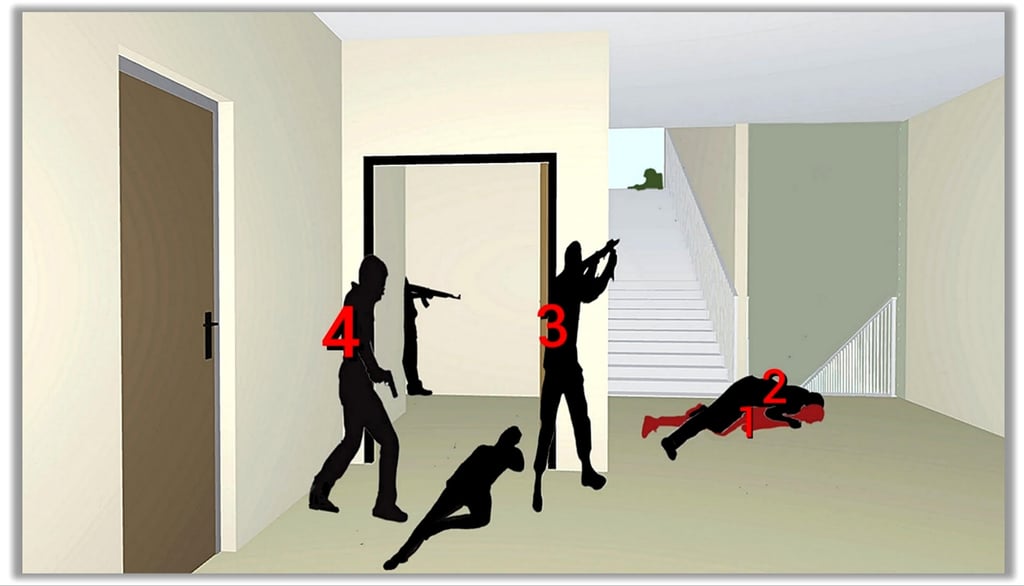

1. Manuel Gaona Cruz (Justice).
3. Andrés Almarales Manga (M-19 guerrilla).
2. José Gabriel Salom Beltrán (Auxiliary Magistrat.)
5. Luis Horacio Montoya Gil (Justice).
1. Manuel Gaona Cruz (Justice).
2. José Gabriel Salom Beltrán (Auxiliary Magist.)
3. M-19 guerrilla.
4. M-19 guerrilla.
VISUAL PROGRESSION

The Judge established a conspiracy to commit crimes and attack the Supreme Court of Colombia between the M-19 guerrilla group and drug trafficking (See En Toma del Palacio de Justicia Intervino el Narcotráfico: Ex Juez Sin Rostro [Drug Trafficking Intervened in the Palace of Justice Siege: Judge Says], W RADIO, November 4, 2004). Thanks to a new amnesty law urgently approved by Congress six weeks after the ruling was issued (Law 7 of 1992, approved on July 3, 1992), the M-19 achieved absolute impunity in Colombia for the crimes committed during the 1985 Palace of Justice siege (See El Último Intento para Juzgar al M-19 [The Last Attempt to Judge the M-19], EL ESPECTADOR, July 12, 2016; see also Informe Final, CSJ 2010, ibídem, page 280).
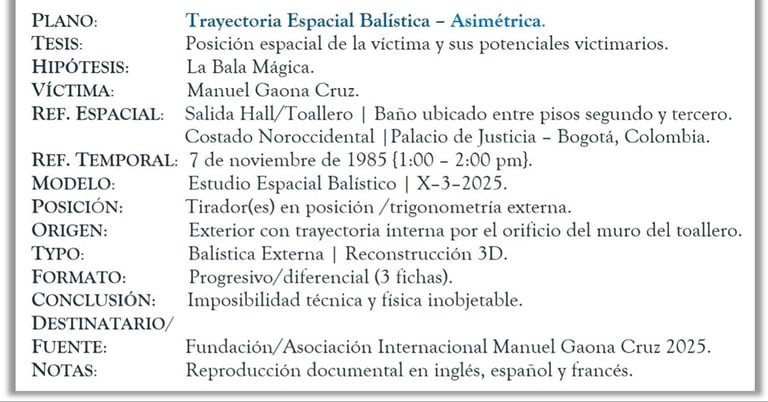


The second (equally implausible) proposition of the magic bullet hypothesis suggests that the Army, using a pistol or revolver, would have shot Manuel Gaona Cruz from the top of the stairs with a bullet that impacted the back of his neck, left temple, and right shoulder before he fell to the ground; or alternatively, three shots fired by different shooters at the same time (See Estudio Espacial Balístico en 3D No. X-4-2025 {bottom right}); the space and ballistic trajectory study demonstrates that such a proposition is physically and scientifically impossible, as the bullet(s) would have to make multiple turns of up to 360 degrees to impact the victim in the position he was in, which is again based on the existing evidence that is legally, physically, and scientifically appreciable: judicial inspection, testimonies, expert ballistic and necropsy evidence, and other documentary evidence detailed during this investigation (e.g., corpse removal, photographs, blueprints, technical studies, etc.)
In addition to the intellectual and material authorship of the crime against Justice Gaona, the rulings and investigations carried out to date, and particularly the evidence collected over four decades, indicate that the Army was indirectly responsible for his death by failing to prevent the Palace of Justice takeover on the day the fate of the most powerful criminal in Colombia was being decided, and most notably, by failing to respect the physical integrity and the right to life of the hostages remaining toward the end of the takeover despite pleas to cease fire, and by intentionally disregarding the most basic principles and protections of International Humanitarian Law (IHL), International Criminal Law, and the human rights treaties signed by the Colombian State through the use of war tanks, bombs, and localized explosions in the area where the civilians and hostages were being held by the M-19 guerrilla.
Eventually, the intermediate thesis introduced by Justice Manuel Gaona Cruz and supported by his colleagues in the Constitutional Chamber of the Supreme Court of Justice became the greatest risk for Pablo Escobar, The Extraditables, the Medellín Drug Cartel, and drug trafficking routes from Colombia to the United States of America; official estimates indicate that the drug trafficking business in Colombia generated more money than the Colombian State itself, and Justice Manuel Gaona Cruz, author of the thesis that prevented the declaration of unconstitutionality of the law approving the treaty between Colombia and the United States, which he defended along with his colleagues in the Constitutional Chamber (Carlos Medellín Forero, Alfonso Patiño Rosselli, Ricardo Medina Moyano) before the Plenary Chamber of the Court on the four occasions when its annulment was demanded before the Supreme Court of Justice (between 1982 and 1985), became the greatest risk for Pablo Escobar, The Extraditables, and the drug trafficking business, which controlled 80% of the cocaine entering the United States of America in November 1985 (See Report of the U.S. Drug Enforcement Administration DEA in The Rise of the Medellin Drug Cartel: 1980–1985, U.S. DRUG ENFORCEMENT ADMINISTRATION (DEA) [DEA History: Archives & Reports], https://www.dea.gov/sites/default/files/2021-04/1980-1985_p_49-58.pdf); consequently, the Justices of the Constitutional Chamber were the primary target of The Extraditables and the Medellín Cartel on the day of the Palace of Justice takeover, as the fate and future of the business of the world's richest and most powerful criminal organization was being decided in November 1985 (Id.; see also Declaration of U.S. Ambassador to Colombia Charles Anthony Gillespie Jr. about Pablo Escobar and the Palace of Justice takeover in Pablo Escobar and the Siege of Colombia's Palace of Justice, ASSOCIATION FOR DIPLOMATIC STUDIES AND TRAINING (ADST) 1995 [Archive: U.S. Diplomatic History, Kidnapping, Terrorism], {excerpts} Library of Congress, Interview with Ambassador Charles Anthony Jr., LIBRARY OF CONGRESS, page 600, https://www.loc.gov/item/mfdipbib000420).
Anthony John Blinken U.S. Secretary of State 2024
(3) Expert Evidence – Necropsy Protocol of Manuel Gaona Cruz: In the particular case of Justice Manuel Gaona Cruz, the necropsy indicates that he died towards the end of the Palace of Justice takeover (and retaking) on Thursday, November 7, 1985 (very possibly between 1:00 and 2:00 p.m.), which is when the third-floor hostages had not yet been released; the autopsy also indicates that the three shots Manuel Gaona Cruz received (to the head, nape, and right shoulder) were fired with a short-barreled weapon from a distance of 30 centimeters. The ballistic evidence and judicial inspection conducted by the 77th Criminal Investigating Court of Bogotá in March 1986, which were examined in detail by the Special Tribunal for Criminal Investigation in 1986, likewise indicate with clarity and specificity that: "the shot received by Justice Gaona Cruz was made from inside the third-floor bathroom... by a person who was behind, slightly to the victim's left" (See Descripción Técnica de las Heridas del Magistrado Gaona {technical data sheet, below}; see also MGC Muerte – Investigaciones).
The second group of fourth-floor hostages, who were under the command of guerrilla leader Luis Otero and included Chief Justice Alfonso Reyes Echandía, and the Justices of the Criminal and Labor Chambers, Fabio Calderón Botero, Pedro Elías Serrano Abadía, Darío Velázquez Gaviria, José Eduardo Gnecco Correa, and Fanny González Franco, as well as the Justices of the Constitutional Chamber Carlos Medellín Forero and Alfonso Patiño Rosselli, who had left Justice Ricardo Medina Moyano's chambers, were moved to another office on the northeastern side. With the exception of Justice Manuel Gaona Cruz, all the hostages in this group died despite the Chief Justice's humanitarian pleas to the Army and Police to stop shooting and his public request for the President Betancour to take his phone call (Listen to the "Ceasefire Plea" in MGC Death – M-19 Threats {Audio}"). Manuel Gaona managed to escape from the group of hostages in the fourth-floor bathroom around midnight after the fire in the Supreme Court's library consumed the fourth floor. Justice Manuel Gaona Cruz later was captured by M-19 guerrillas upon reaching the second floor while descending the northwestern stairs. The guerrillas took him to the bathroom located between the second and third floors. For the rest of the takeover, Manuel Gaona Cruz remained in the group of hostages that was under the command of guerrilla Andrés Almarales Manga. The Justice of the Civil Chamber who were in the third-floor offices, Hernando Tapias Rocha, Humberto Murcia Ballén, and Luis Horacio Montoya Gil, joined the group, as did Justice Nemesio Camacho Rodríguez who, after taking refuge in his office with his secretary, managed to escape the fourth-floor fire. Manuel Gaona Cruz and Nemesio Camacho Rodríguez were the only Justices who survived the attack on the fourth floor.
On Wednesday, November 6, 1985, while Colombians listened on the radio to the incessant gunfire between the armed forces and the M-19 guerrillas, and while the world watched in astonishment on live television the crimes against humanity—including military tanks firing at the Supreme Court of Justice of another country—Colombia's Minister of Communications, Noemí Sanín de Rubio, acting under the express authorization of the President of the Republic, ordered the censorship of news broadcasts related to the Palace of Justice, and instead arranged for a soccer match that took place that day between the Millonarios and Unión Magdalena teams to be broadcast (See Informe Final: Comisión de la Verdad Sobre los Hechos del Palacio de Justicia [Final Report: Truth Commission on the Events of the Palace of Justice], CORTE SUPREMA DE JUSTICIA DE COLOMBIA, Ed. Universidad del Rosario 2010,, pages 349 to 351).
In time, the wife and children of Justice Manuel Gaona Cruz decided to remain silent and await the outcome of the investigations. Based on the International Law that assists victims in preserving truth and public memory (See Sentence C-579/2013, Constitutional Court of Colombia; Updated Set of Principles for the Protection and Promotion of Human Rights through Action to Combat Impunity, UNITED NATIONS, E/CN.4/2005/102/ Add.1, February 8, 2005; also see Right to the Truth, UNITED NATIONS HUMAN RIGHTS COUNCIL, Resolution 9/11, A/HRC/ RES/9/11, September 24, 2008; Study on the Right to the Truth, OFFICE OF THE UNITED NATIONS HIGH COMMISSIONER FOR HUMAN RIGHTS, E/CN.4/2006/91, January 9, 2006; Right to the Truth in the Americas, INTER-AMERICAN COMMISSION ON HUMAN RIGHTS, OEA/Ser.L/V /II.152, August 13, 2014; Cárdenas/Peña vs. Bolivia, INTER-AMERICAN COURT OF HUMAN RIGHTS, Series C No. 217, Judgment of September 1, 2010)—and especially considering the political speculation and manipulation surrounding the truth of the crime—the Justice's son, J. Mauricio Gaona, undertook several years ago to lead the most complete and exhaustive investigation conducted to date on the life, assassination and legacy of Justice Manuel Gaona Cruz. This included a factual, legal, technical and scientific review of all existing investigations, evidence, versions, and rumors. After four decades, it can be concluded with undeniable certainty that, with the exception of the rulings and reports issued by the Attorney General's Office through the Deputy Prosecutor's Office for Judicial Police (1986), the Special Tribunal for Criminal Investigation (1986), the 77th and 30th Criminal Investigating Judges of Bogotá (1986 and 1989), the Public Order Judge (1992), the Truth Commission established by the Supreme Court of Colombia (2005-2010), and the Criminal Chamber of the Superior Tribunal of Bogotá (2010), no other Colombian authority truly investigated the assassination of Manuel Gaona Cruz. The majority—including the Attorney General of Colombia and the specialized criminal judges—refused to investigate the M-19 guerrilla due to the amnesty granted by the Governments of Presidents Virgilio Barco Vargas (Law 77 of 1989) and César Gaviria Trujillo (Law 7 of 1992), despite the crime being a crime against humanity (CAH) (See MGC Muerte – Investigaciones y Responsabilidades). It is inherently indisputable that, from the perspective of International Criminal Law (Crimes Against Humanity "CAH"), International Humanitarian Law (IHL) (Principles of Distinction, Humanity, Proportionality, and Necessity), applicable Human Rights Instruments (international treaties on the right to life, physical integrity, and human dignity signed by Colombia), the theory and practice of General Criminal Law (theory of the case, crime structure, and subjects of the crime), the most elemental Criminal Anthropology (observation and analysis of criminal behavior), the most basic Criminology standards (history and motivation of the crime), the most elemental Criminal Psychology (motivation, identity, and attitude of the perpetrators), Forensic Science (technical analysis of physical crime evidence), and Law of Evidence (legal analysis of the crime evidence), a criminal investigation cannot be conducted when the people who kidnapped the victim, placed him in a situation of defenselessness and danger, threatened him with death, mistreated him, and executed him before eyewitnesses are excluded. It is also inherently unquestionable that, unless unappealable judicial decisions impeach the credibility or character of the witnesses to a crime, the central evidence verifying its commission (testimonial, documentary, expert, judicial inspection) cannot be replaced with rumors ("I was told," "it is said that") unrelated to the material and procedural truth of the crime to assert that others were the perpetrators and other were the circumstances under which it took place. Such journalistic disquisition may seem interesting to the unwary reader, but it is deeply injurious to the victims of the crime, and particularly inadequate for the non-legal observer. In investigations of crimes against humanity conducted under internal jurisdiction or adjacent to the United Nations and under the rubric of Public International Law, such exclusion precludes international criminal action and violates the norms that govern its procedure. In countries governed by the Anglo-Saxon system of Common Law, such exclusion constitutes an axiological vice in the criminal process, as it fundamentally compromises any finding resulting from the purported "criminal" investigation from its very origin by violating, through the political selection of perpetrators, the most insurmountable constitutional prohibition of any conviction: the existence of a reasonable doubt that emerges incontestable when the people who held the victim captive at the time of the crime are not investigated—in the sub judice case, the M-19 guerrillas. Finally, in countries that follow the continental European system like Colombia (Civil Law), such exclusion—that is, investigating the crime without including the main suspects and eventual perpetrators, again, in the case of Manuel Gaona Cruz—constitutes an irremediable endemic failure and an irreparable lack concerning the constitutional need for procedural truth and legal certainty that subsumes the institutional guarantee of state intervention in the resolution of common, atrocious, and crimes against humanity subsequent to the social mandate that legitimizes its existence: that justice be done.
Besides the unsustainable fallacies of its own narrative ("the Army attacked the Palace of Justice to take revenge on the Constitutional Chamber Justices for investigations the Supreme Court of Justice was not carrying out in 1985 or to take revenge on the Constitutional Chamber Justices for their positions and decisions from 1980 and 1982 to exclude civilians from military jurisdiction") and the irreparable inconsistencies of its legal proposition ("pretending that the crime's eyewitnesses did not testify what they testified or that, simply, they did not exist"), the material substratum of the rumor faces an insurmountable factual impossibility, since its proposition collapses before the antecedent, concomitant, subsequent, and consequent facts of the Palace of Justice takeover, namely: (i) Manuel Gaona Cruz had been declared the primary target of the Medellín drug Cartel ("in extradition you are the most important person responsible"); (ii) Manuel Gaona Cruz was threatened ("we assume you have accepted our declaration of war") by Pablo Escobar, the Medellín Cartel, and Los Extraditables, not by the Army; (iii) Manuel Gaona Cruz was the author of the intermediate thesis that prevented the declaration of unconstitutionality of the law approving the Extradition Treaty between Colombia and the United States of America for several years; (iv) the Supreme Court's Constitutional Chamber was the only Chamber meeting on Wednesday, November 6, 1985, and the only case it was deciding and discussing that day was the constitutionality of the law approving the Treaty; (v) Manuel Gaona Cruz was presenting his report on the approving law at the exact moment the M-19 guerrilla entered; (vi) Manuel Gaona Cruz was the first Justice the M-19 guerrilla sought, called, and took hostage; (vii) Manuel Gaona Cruz was assassinated by the M-19 guerrilla towards the end of the takeover when all was lost and it was already known that neither the Army nor the government would negotiate; (viii) before his execution, the victim, Manuel Gaona Cruz, textually told the guerrillas that, "you are going to commit an assassination"; (ix) half a dozen witnesses observed his execution and described his fatal wounds before leaving the Palace of Justice; (x) on November 6, 1985, the fate of the world's most powerful and richest criminal organization at that time (the "Medellín Cartel") was being decided in the Constitutional Chamber of the Supreme Court of Justice; (xi) twelve months after the takeover, intimidated and threatened, the new Supreme Court of Justice declared the law approving the Extradition Treaty unconstitutional, arguing procedural defects; (xii) five years later, the M-19 publicly demanded the elimination of extradition and negotiation with the drug cartels "before signing peace"; and (xiii) six years later, the Alianza Democrática M-19 managed to approve a constitutional reform prohibiting the extradition of Colombian drug traffickers. In the final decalogue of its greatest infamy, using the narrative of military investigations, the rumor proposes that Colombians substitute from their memory the atrocious crimes committed by Pablo Escobar, the Medellín Cartel, and Los Extraditables to prevent their extradition, which include:
Secretary of Justice's Assassination - Rodrigo Lara Bonilla
Death Threats Against the Justices of the Supreme Court of Justice's Constitutional Chamber and the Assassination of All Its Members: Manuel Gaona Cruz, Carlos Medellín Forero, Alfonso Patiño Rosselli, Ricardo Medina Moyano
Assassination of Secretary of Justice Enrique Low Murtra
Assassination of Presidential Candidate Luis Carlos Galán Sarmiento
Public Ministry Chief's Assassination - Carlos Mauro Hoyos
El Espectador Editor-in-Chief's Assassination Guillermo Cano Isaza
Homicide of 107 people following the mid-air explosion of Avianca Flight 203.
The historical, structural, and amoral shortcoming of the rumor is insurmountable, as it seeks to make Colombians believe that on the day when extradition in Colombia was being decided, along with the fate of the world's most powerful and wealthiest criminal organization, the Army—and not The Extraditables (who committed all these crimes)—had carried out intelligence work on the families and issued death threats against the members of the Constitutional Chamber of the Court, including Justice Manuel Gaona Cruz, and that they [The Extraditables] had nothing to do with their crime or with the seizure of the Palace of Justice.
Manuel Gaona Cruz, in memoriam.
The story of Manuel Gaona Cruz is, in more than one way, the story of Colombia. His story and his atrocious assassination at the hands of the M-19 guerrilla are part of the nation's collective memory; a memory that many have sought to erase and others are trying to rewrite. In the end, time, like the truth, is implacable: rumors are exposed for what they are, and the facts, unwavering, show the history that could not be concealed. To exalt the kidnapping of innocent civilians as a bold act and the humanity of their captors to justify his murder is an outrage to history and to the human dignity of one who dedicated his life, until his last breath, to defending justice and the Rule of Law in Colombia. For the youth and for those who are still interested in the truth above those who seek to exploit this tragedy economically and politically, our message across time is simple: This was Manuel Gaona Cruz, and this is what truly happened to him.The story of Manuel Gaona Cruz is your story. Learn it, tell it, share it, protect it. It belongs to you.
Chronology of the Crimes Committed by Pablo Escobar and Los Extraditables to Prevent Their Extradition to the United States
Homicide of 57 people following a bomb in the DAS building in Bogotá.
Para los Jóvenes
April 30, 1991.
November 6 and 7, 1985.

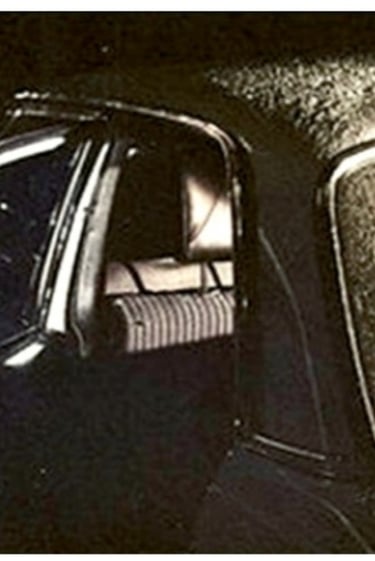
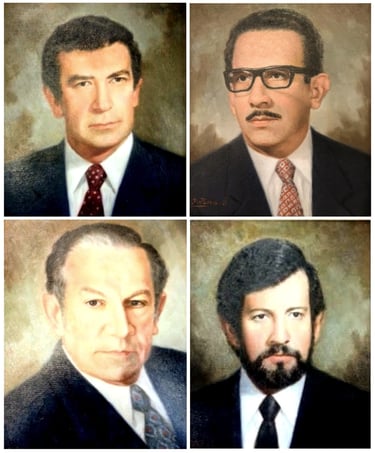

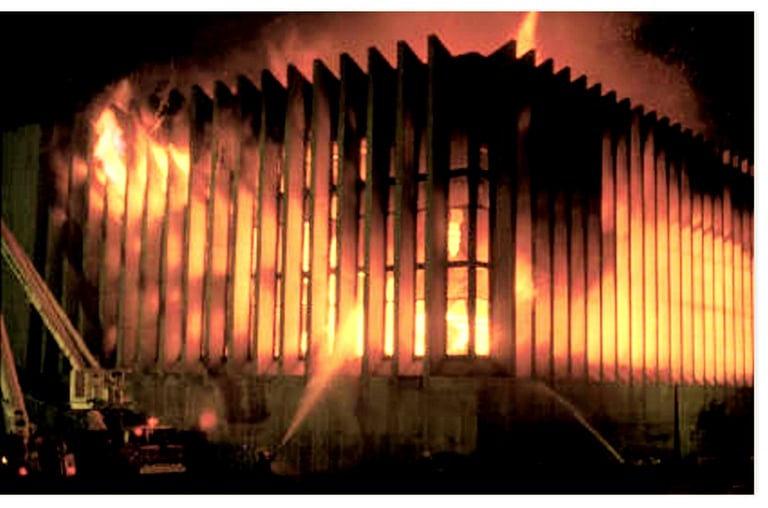

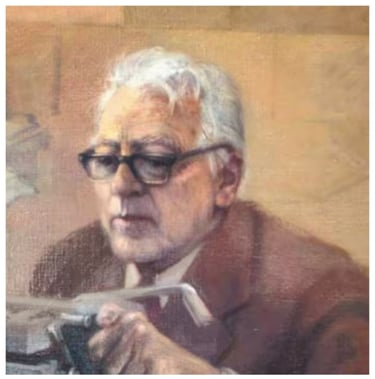

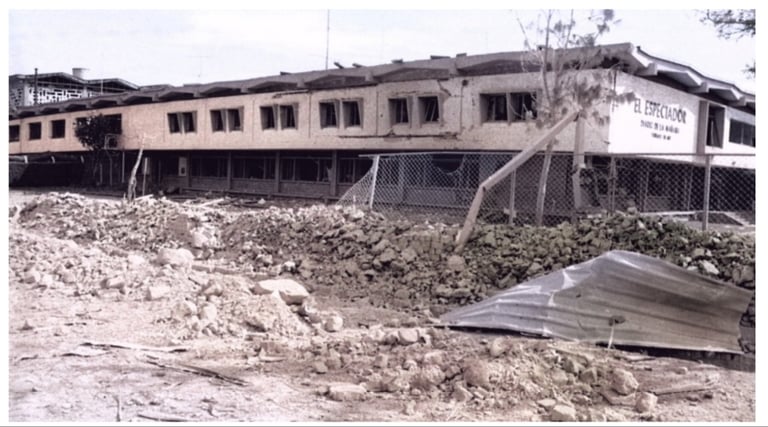

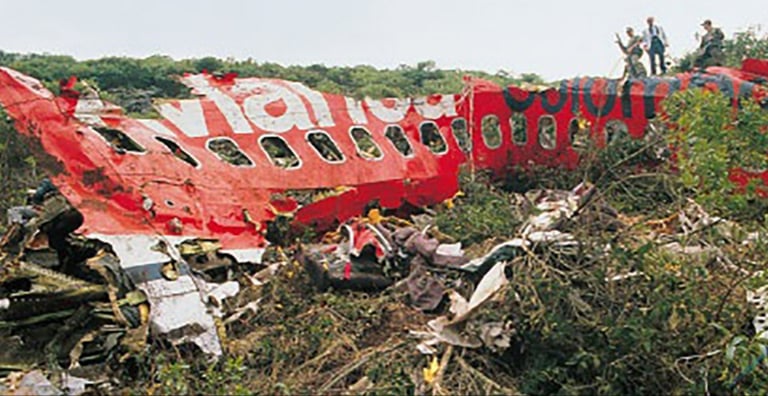

2 de septiembre de 1989.
January 25, 1988.
November 27, 1989.
6 de diciembre de 1989.
Kidnapping and Death of Journalist Diana Turbay
20 de agosto de 1990.
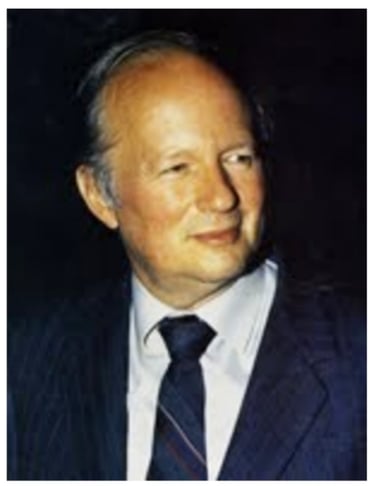

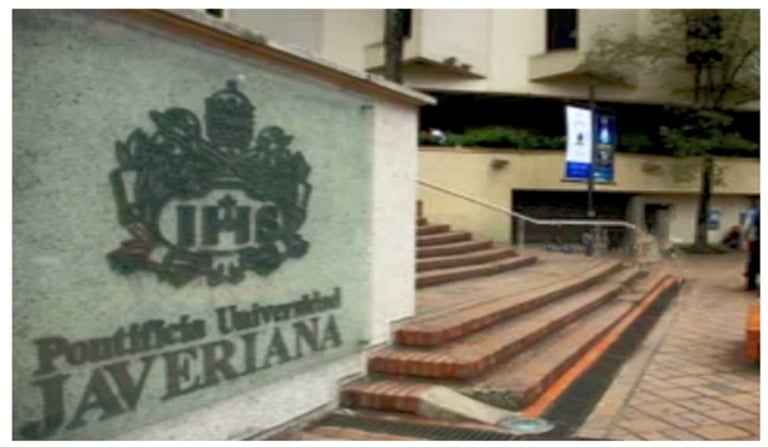

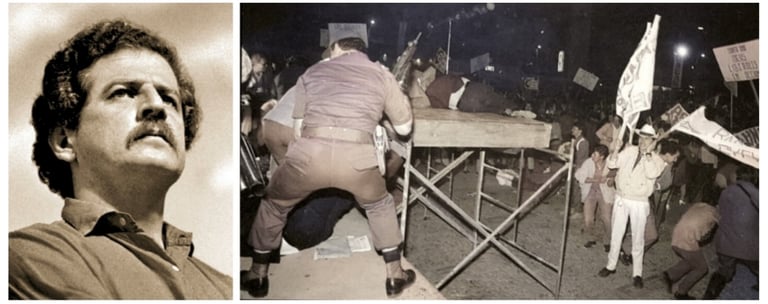

April 30, 1991.
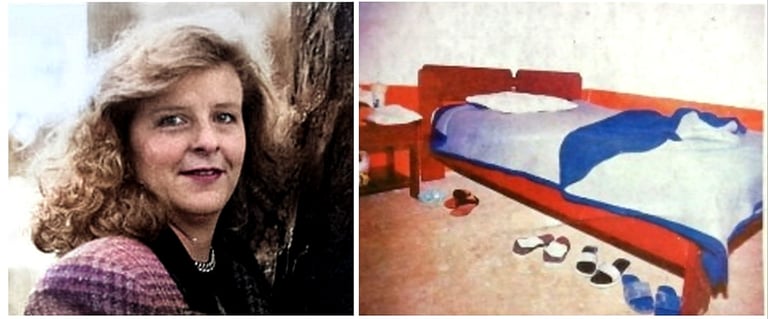

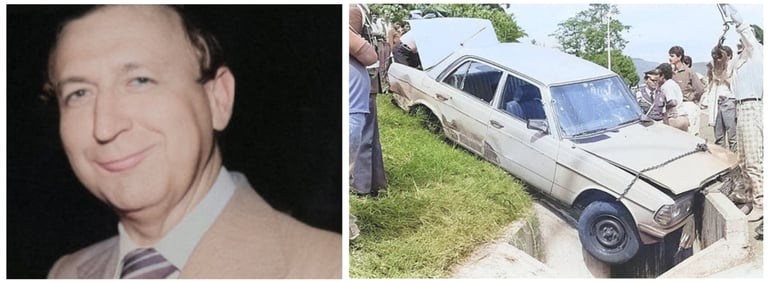

Justice Hernando Baquero Borda's Assassination
July 31, 1986.
April 30, 1984.
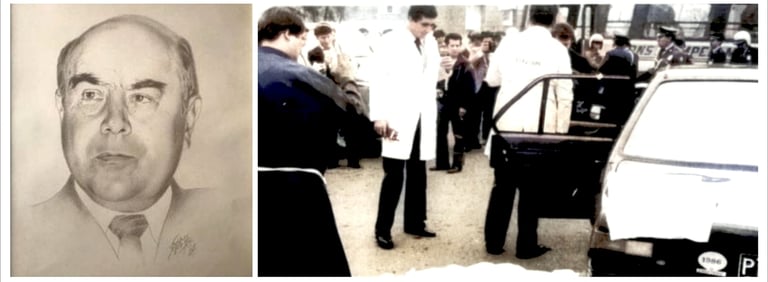

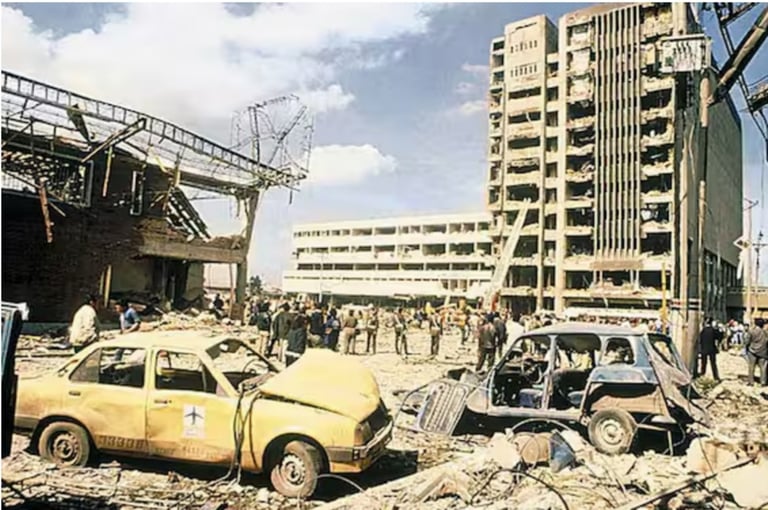

However, due to Justice Gaona's concern regarding reprisals from Pablo Escobar against his family following the declaration of constitutionality of the extradition treaty that the Court was about to issue, of the six bodyguards assigned to the Justice on the day of the takeover of the Palace of Justice, two were with his children Mauricio and Manuel at the Claustro Moderno High School, one was at his wife Marina's office, one was at the Justice's home with his son Gabriel and baby Juliana, and two were with Justice Manuel Gaona Cruz at the Court. The decision to keep only two bodyguards at the Court—including his driver, Plácido Barrera Rincón, who carried a weapon—was made because an additional security ring composed of 22 members of the National Police and Military Police ordinarily guarded all entrances to the Palace of Justice. This security detail had been arranged several weeks earlier due not only to the threats from Pablo Escobar but also to the rumor of a possible attack on the Palace of Justice by M-19 guerrillas in October during the visit of French President François Mitterrand to Colombia. In fact, when the threats, surveillance, and telephone interceptions by the Medellín Cartel against the Justice's family intensified, Justice Manuel Gaona Cruz himself, accompanied by his colleague and Constitutional Chamber Justice Carlos Medellín Forero and the Chief Justice Alfonso Reyes Echandía, met at the Military Club a week before the attack with the Secretary of Justice Enrique Parejo, the Secretary of Interior Jaime Castro, the Director of the National Police General Víctor Alberto Delgado Mallarino, and the Director of the National Security Department (DAS) General Miguel Maza Márquez to request that both the security for the Justices and the security ring guarding the Palace of Justice be reinforced. Mysteriously and without any written order or request, the joint guard of the National Police and Military Police that was protecting the Palace was suddenly and utterly removed on Monday, November 4 (a Holliday), which facilitated the entry of the M-19 guerrillas through the garage of the Palace of Justice two days later. Justice Gaona's bodyguards, including his driver Plácido Barrera Rincón, were murdered in the garage of the Palace of Justice after confronting and attempting to resist the entry of the guerrillas, along with security guards from the Cobasec security company, Eulogio Blanco and Gerardo Díaz Arbeláez. In 1995, the Council of State of Colombia (i.e., the head of the administrative jurisdiction) condemned the nation for serious security-service failures, including, among others, the sudden and surprising removal of the security ring guarding the Palace of Justice.
The M-19 guerrillas took the Palace of Justice by force, with gunfire, at the very moment that Justice Manuel Gaona Cruz was delivering the opinion of the Court before the Constitutional Chamber of the Supreme Court, once again declaring the constitutionality of the Law Approving the Extradition Treaty between Colombia and the United States of America (Law 27 of 1980). The Constitutional Chamber was the only chamber in session on November 6, 1985. Upon hearing gunshots at around 11:35 a.m., the four magistrates of the Constitutional Chamber (Manuel Gaona Cruz, Carlos Medellín Forero, Ricardo Medina Moyano, Alfonso Patiño Rosselli), along with the chamber's secretary and summons server, suspended their session, left the room, and took refuge in the adjacent office of Magistrate Ricardo Medina Moyano, where a visitor was also waiting for him. They remained there for a few minutes until Magistrates Alfonso Patiño Rosselli and Carlos Medellín Forero decided to leave in the company of their bodyguards (See Final Report: Truth Commission on the Events of the Palace of Justice in Informe Final: Comisión de la Verdad Sobre los Hechos del Palacio de Justicia, CORTE SUPREMA DE JUSTICIA DE COLOMBIA, Ed. Universidad del Rosario 2010, page 319).
After murdering the bodyguards and security guards who tried to repel the attack in the garage of the Palace of Justice, the guerrillas went up to the lobby, where they shot and killed the unarmed administrator of the Palace of Justice, Jorge Tadeo Mayo Castro, who was running to find refuge. The guerrillas, led by their commander, quickly ascended to the fourth floor where the Constitutional Chamber was in session and began calling out, one by one, the Justices of the Constitutional Chamber. Manuel Gaona Cruz was the first hostage the M-19 guerrillas sought and kidnapped during the takeover of the Palace of Justice (See Testimonies below). Upon reaching the fourth floor, the guerrillas shouted, "Justice Manuel Gaona Cruz, come out!" Manuel Gaona Cruz came out with his hands up and called to those hiding in Justice Medina Moyano's office, saying, "Come out, I'm okay. Do what they say." The Secretary of the Constitutional Chamber, Ricardo Correal Morillo, and the Chamber's Summons Server, Héctor Darío Correa Tamayo, came out and joined Justice Gaona. Immediately afterward, and despite Justice Gaona's plea for them not to shoot at the offices where there were civilians, the guerrillas began firing into the Justices' offices after noticing that no one else was coming out, while a female guerrilla shouted, "Come out, don't be cowards!" The first hostages who were with Justice Manuel Gaona Cruz were placed near the elevators and then moved to the men's bathroom on the fourth floor.
Héctor Darío Correa Process Server of the Constitutional Chambre Supreme Court of Colombia
Lucía Bermúdez de Sánchez Secretary of Justice Nemesio Camacho Rodríguez Supreme Court of Colombia
Lucía Bermúdez de Sánchez Secretary of Justice Nemesio Camacho Rodríguez Supreme Court of Colombia
Humberto Murcia Ballén Justice of the Civil Chamber Supreme Court of Colombia
Humberto Murcia Ballén Justice of the Civil Chamber Supreme Court of Colombia
Hernando Tapias Rocha Justice of the Civil Chamber Supreme Court of Colombia
The guerrillas formed a line in front, turned off the light, and fired at the group of justices. Justice Nemesio Camacho Rodríguez was wounded in the head, while Justice Hernando Tapias Rocha received bullet impacts to his back and leg after turning around at the last second. The driver Jorge Antonio Reina managed to survive the execution because he was almost sitting and positioned behind his colleague Luis Humberto García, who died instantly. Lawyer Luz Stella Bernal Marín and Judicial Assistant Aura Nieto de Navarrete (who were in the front row) also died instantly. The judicial inspection of the crime scene (See 77th CRIMINAL INSTRUCTION COURT OF BOGOTÁ, File 150, Folio 2, March 21, 1986), the victims' necropsies (See Necropsy Protocols No. 3776/85, 3783/85, 3785/85, corresponding to Luis Humberto García, Aura Nieto Navarrete, and Luz Stella Bernal Marín, respectively), and the declarations of eyewitnesses to these crimes are conclusive: "Almarales made us locate ourselves in the bathroom and distribute ourselves; the justices near the bathroom door. Then the other men who were not Justices, and finally the women to sit on the floor" (Carmen Elisa Mora); "There came a time when they were selecting where to place the hostages: justices on one side and employees on the other. [Then] we saw a rocket fired from outside toward the bathroom wall. At that moment the guerrillas got scared and decided to shoot at the hostages. Almarales told his comrades to all stand in front of where he was. They formed a line, and that's when they decided we had to sit in rows in the bathroom, they turned off the light, and they started shooting at us. In front of me was my colleague Luis García, who was one of the first they killed" (Jorge Antonio Reina Orjuela); "The M-19 had decided to execute the hostages... they formed a line against the urinal wall and ordered the Supreme Court Justices to stand in front of them, and I understood at that moment that the purpose was to execute us as hostages" (Hernando Tapias Rocha); "Almarales called the Justices and the councilors of state and made us sit in the first line and placed a practical firing squad in front of us" (Nemesio Camacho Rodríguez); "The guerrillas had placed us, the Justices, at the front of the group with the aim, as one of them stated, of starting to sacrifice us one by one" (Samuel Buitrago Hurtado); "They had made us form a line, the Justices at the bathroom door, from the outside in, then around one in the afternoon, approximately, the guerrillas began to fire inside the bathroom at the people who were in there" (José William Ortiz); "Suddenly they said for all the justices to come forward, that they were going to start killing them one by one" (Beatriz Quintero González); "I saw when they shot Dr. Luz Stella, a guerrilla shot her with a machine gun" (María Humbertina Hernández de Díaz); "About four guerrillas with machine guns took up positions in front of us. Suddenly they said for all the justices to come forward, that they were going to start killing them one by one" (Helena Gutiérrez Romero). A visual and numerical breakdown of the events, victims, and hostages follows. In red are the people who died at the scene, in blue those who were wounded, and in black those who survived that moment (the scene).
After the execution of several hostages inside the bathroom, guerrilla leader Almarales shouted: "Justices Gaona and Salom, get out of the bathroom!" The guerrilla leader ordered the surviving group of justices to line up in the lobby/hallway leading out of the bathroom. Almarales pointed his revolver at Justice Manuel Gaona Cruz and ordered him to shout to the Army that if they did not cease fire, they would be sacrificed one by one. The guerrilla leader warned Justice Gaona: "you are our last card, because for us to fall, you must fall first." Following Almarales's orders, Justice Manuel Gaona Cruz took Auxiliary Justice José Gabriel Salom Beltrán by the hand and they began to exit toward the bathroom hall. The guerrilla leader ordered the Justices to get on their knees and move toward the exit while seated. Due to the reduced space of the hall (1 meter wide by 2.58 meters long), three guerrillas (including Almarales) and six hostages positioned themselves there. Manuel Gaona Cruz led the group of hostages. Behind him were José Gabriel Salom Beltrán, Luis Horacio Montoya Gil, Jorge Antonio Reina Orjuela, and Hernando Tapias Rocha. The latter was followed closely by Nemesio Camacho Rodríguez and Alba Inés Rodríguez, who were positioned at the inner door of the bathroom that connected to the hall. Upon reaching the bathroom's outer door (i.e., the hall/lobby exit), exhausted and breathless, Manuel Gaona Cruz shouted with all his might for the last time: "Please do not shoot, we are Supreme Court justices, we are civilians, we are hostages, there are secretaries, drivers, and court employees here. Please do not shoot, ... please do not shoot because they are going to kill us!" In the words of the eyewitnesses: "They told those of us who were left to come out of the bathroom and I came out and stayed at the door, next to Doctor Gaona" (Jorge Antonio Reina Orjuela); "Manuel took me by the hand and I started to go out with him and with another Justice whose face I didn't see because I couldn't walk anymore. And he took us out sitting outside the bathroom, with him and other guerrillas pointing revolvers at us. He [Manuel Gaona] was the most important thing for them" (José Gabriel Salom Beltrán); "Mr. Almarales said: 'Justices Gaona and Salom, get out of the bathroom and kneel!'" (Humberto Murcia Ballén); "he told them: 'you are our last card, because for us to fall, you must fall first'" (Nemesio Camacho Rodríguez); "Almarales had told Justice Gaona Cruz to scream for a ceasefire and to warn the Army that if they didn't do it, they were going to kill them one by one" (Helena Gutiérrez Romero).
After witnessing the execution of Justice Gaona Cruz, Jorge Antonio Reina threw himself to the floor, while Justices Hernando Tapias Rocha and Nemesio Camacho Rodríguez momentarily retreated to the interior bathroom door. The declarations of the exceptional witnesses to the crime (both those who saw and those who heard the shots), as well as the report of the judicial inspection carried out by the 77th CRIMINAL INSTRUCTION COURT OF BOGOTÁ in 1986 are conclusive: "Upon reaching the corner [door frame {fourth scene}], they told us to continue in the same position toward the site of the crossfire, a circumstance that implied that Doctor Gaona once again begged that what was about to happen was a murder. They replied that they were not going to kill us but the Army would; that they [the M-19 guerrillas] needed our bodies to throw out to make the fire stop. I was crawling, and at the bathroom door, the commander [Almarales] told us: 'Don't worry, nothing will happen to you because you are my last card,' but when he told us to keep moving while seated and holding hands in the corridor, Doctor Gaona said that this could not be, that we were not going to be cannon fodder. That this could not be because they were going to take us out into the crossfire... and that they were going to kill us anyway... Doctor Gaona refused to move from the spot, and at that moment, following Almarales's order, they proceeded to shoot at us from about 30 centimeters away. Manuel told him: 'We are not going out like this. I am not moving from here.' Then Almarales gave the order and said: '!Finish them off...!' and they shot us" (José Gabriel Salom Beltrán); "A guerrilla told Doctor Gaona to move along the edge of the wall and another guerrilla came from behind and shot him in the head, near the back of the neck, on the landing of the staircase that led out of the bathroom. I immediately moved from there and threw myself to the floor, because anyone who was leaving was being murdered on the staircase landing... I saw when they shot Gaona Cruz and killed him" (Jorge Antonio Reina Orjuela); "They had a guerrilla who would kill anyone who went out. Those shots were fired with small arms... Manuel Gaona went out here and they shot him here [pointing to the hall adjacent to the bathroom door]" (Hernando Tapias Rocha); "The guerrillas shot Manuel Gaona. I saw when a guerrilla took out a revolver and shot him in the head" (Nemesio Camacho Rodríguez). The witnesses who heard the final moments of Justice Gaona from inside the bathroom confirm these accounts: "He [Manuel Gaona Cruz] went out to ask the military to please stop shooting... he was asking for that so he could go out to his little girl. He was screaming and screaming in that little hall that was there at the bathroom door. Suddenly, Doctor Gaona's voice could no longer be heard, he stopped shouting, and suddenly they said: 'They killed Doctor Gaona.' Doctor Nemesio Camacho was near the door and he could see and control everything that was happening in the bathroom. Doctor Nemesio later said that he saw a guerrilla take out a revolver and shoot him in the head" (Lucía Bermúdez de Sánchez); "At that moment there were guerrillas at the door and at the bathroom exit. They were shooting as they came out of the bathroom. Almarales was walking with his revolver like this [witness moves arm] and it was a short weapon, it was a revolver. And suddenly he became like a beast and began saying: where are the justices...?' I turned and didn't see but I heard perfectly that Almarales and another one were shooting at the hostages" (Amanda Leal de Gallego). The statements of the eyewitnesses to the crime match the spatial ballistics trajectory studies and the injuries described in Manuel Gaona Cruz's Necropsy Protocol (See Necropsy Protocol of Manuel Gaona Cruz No. 3778/85, GENERAL DIRECTORATE OF LEGAL MEDICINE, Internal Ballistics Registration No. 974-85-DC-FLB). After the murder of Justice Manuel Gaona Cruz, the hostages who were in the lobby/hallway threw themselves to the floor and retreated back into the bathroom. Between 45 and 50 minutes later, the guerrilla leader Almarales ordered his men to throw the bodies of Justices Gaona and Salom outward toward the stairs so the Army would see them. Justice José Gabriel Salom, who had been under Manuel Gaona Cruz's lifeless body for almost an hour, heard the order, played dead, and was thrown out along with Justice Gaona to the point that divides the ascending and descending stairs between the second and third floors. Because he was on top, Justice Manuel Gaona Cruz's body was thrown first, and on top of it fell the body of Justice Salom, leaving the latter now on top of Justice Gaona. Justice Salom remained on top of Justice Gaona for 15 minutes and then descended the stairs that led to the second floor where he was detained by members of the Army (See Declaration of José Gabriel Salom Beltrán before the Delegated Prosecutor's Office for Judicial Police, PRCURADURIA DELEGADA PARA LA POLICIA JUDICIAL NATIONAL, March 12, 1986; see also Declaration of José Gabriel Salom Beltrán before the Truth Commission, Informe Final: Comisión de la Verdad Sobre los Hechos del Palacio de Justicia, CORTE SUPREMA DE JUSTICIA DE COLOMBIA, Ed. Universidad del Rosario 2010, page 166). After crawling to the exit and playing dead for several minutes, Supreme Court Justice Humberto Murcia Ballén received the same treatment from the guerrillas and was kicked toward the stairs. On his way to freedom, Justice Murcia Ballén crossed paths several times with Justice Gaona's lifeless body, which allowed him to observe his colleague's fatal wounds in detail. After reaching the stairs, Justice Humberto Murcia Ballén also found his colleague Justice Luis Horacio Montoya Gil wounded in the eye, who apparently died minutes later as a result of an explosion (See MGC Death – Testimonial Evidence; see also Judicial Inspection of the Bathroom on the Second and Third Floors (northwestern side) of the Palace of Justice, 77th CRIMINAL INSTRUCTION COURT OF BOGOTÁ, File 150, Folio 4, March 21, 1986; Necropsy Protocol of Luis Horacio Montoya Gil No. 3774/85, GENERAL DIRECTORATE OF LEGAL MEDICINE, Internal Ballistics Registration No. 964-85-DC-FLB).
J. Mauricio Gaona Justice Gaona's Son
Ricardo Martín Lázaro commanded the group of M-19 guerrillas who did not manage to enter the Palace of Justice on November 6, 1985.
Uriel Alberto Amaya Olaya Judge 30th Court of Criminal Instruction of Bogotá
M-19 Guerrillas' Death Threats Audio
Fabio Castillo is the only Colombian journalist who survived the threats of Pablo Escobar. Castillo carried out the most detailed investigation of the eighties on drug trafficking, politics, and guerrillas in Colombia.
In 2015, the Criminal Chamber of the Supreme Court of Justice acquitted Colonel (Ret.) Alfonso Plazas Vega in relation to the crimes of forced disappearance, but ordered copies to be sent to the Attorney General's Office (Fiscalía General de la Nación) so that excesses committed during the retaking of the Palace of Justice could be investigated.
In 2019, the Supreme Court of Justice upheld the 25-year prison sentence against General (Ret.) Jesús Armando Arias Cabrales for the crime of forced disappearance.
In 2023, the Supreme Court of Justice upheld the 40-year prison sentence against General (Ret.) Edilberto Sánchez Rubiano and Captain Oscar William Vasquez Rodríguez for the crime of forced disappearance. On May 3 of that year, the United States Secretary of State, Anthony J. Blinken, issued a press release, on the one hand, condemning the gross human rights violations committed (among others) by General (Ret.) Iván Ramírez Quintero and, on the other hand, designating him as a citizen ineligible for a visa to the United States (See Antony J. Blinken, U.S. SECRETARY OF STATE, Designation of Three Former Colombian Officials Due to Involvement in Gross Violations of Human Rights in Colombia, May 3, 2023, https://www.state.gov/designation-of-three-former-colombian-officials-due-to-involvement-in-gross-violations-of-human-rights/). In June 2024, the Plenary Chamber of the Superior Court of Bogotá sentenced General (Ret.) Iván Ramírez Quintero to 31 years in prison for the crime of forced disappearance.
En 2024, la Sala Penal del Tribunal Superior de Bogotá confirmó la condena a 31 años de prisión del general (r) Iván Ramirez Quintero y el coronel (r) Fernando Blanco Gómez por el delito de desaparición forzada.
Yamid Amat Journalist and Director of Caracol News Radio 1985
J. Mauricio Gaona Justice Manuel Gaona Cruz' Son
Hernando Tapias Rocha Justice of the Civil Chamber Supreme Court of Colombia
Lucía Bermúdez de Sánchez Secretary of Justice Nemesio Camacho Rodríguez Supreme Court of Colombia
Jorge Antonio Reina Orjuela Official Driver Supreme Court of Justice





LEGACY
The Judge, Natural and Irreplaceable Guardian of the Constitutional Order:
Before being a professor or a magistrate, Manuel Gaona Cruz trained as a constitutionalist. His lectures, his writings, and his rulings are imbued with the inevitable influence of the republican values that inspired the advent of the French Revolution and the rise of the Rule of Law: liberty, equality, fraternity, pluralism. His most famous papers include, among others: respect for the freedom of the press and its sources, respect for individual liberties and human rights in Colombia, the independence of the judiciary, constitutional limitations on police power, the immutability of judicial rulings, the control and reform of the Constitution, the scope of the public action of unconstitutionality, the constitutionality of economic emergency decrees, and the constitutional limits on the state of siege and other states of exception in peacetime.
The ideological north of his thought was structured upon the unequivocal conception that the Judicial Branch was the cornerstone upon which the constitutional order rests. The reminiscence of his ideas is indubitable. For Manuel Gaona Cruz, the Judge is the natural guardian of the constitutional order and the eventual protector of the Political Constitution. 'The Court guards the Charter, not the Charter the Court,' maintained the scholar and magistrate. In the intellectual disquisition of his life, Manuel Gaona Cruz considered that the preservation of the Rule of Law begins and ends with the preservation or elimination of judicial independence and the protection of the pillar upon which it develops: the Separation of Public Powers. Without them, the magistrate argued, the Rule of Law simply does not exist. Without them, he added, human rights, our primary liberties, and the constitutional guarantees that demonstrate the existence of a democracy cannot be protected. Without them, he insisted, the corollary division between the will of the ruler and the will of the governed is lost.
The Doctrine of Power:
For Manuel Gaona Cruz, the conception of the theory of the State that underlies most world constitutions is preceded by an inevitable and necessary phenomenon: the "doctrine of power." In its genesis and doctrinal assertion, Professor Gaona Cruz described this doctrine's development through three constitutional forms: the Ideological Constitution, the Political Constitution, and the Juridical Constitution. He believed the archetypal division of these forms stems from the historical, comparative, philosophical, sociological, and juridical study that materializes the function and preservation of the constitutional order, building the concept of the Constitution on factual valuations (rationalizations of social and circumstantial reality), juridical-formal valuations (normative rationalizations of constitutionality), and cultural valuations (philosophical and cultural rationalizations of incompatibility). The final architecture of his assertion recognized an inescapable relationship between the Constitution and the institutional order that supports it and that it's called upon to protect in times of crisis. This historical disquisition is characteristic of his thought; based on it, the professor attributed the preservation of the Rule of Law to the Juridical Constitution, the reason for being of the Rule of Law to the Ideological Constitution, and the organization of the Rule of Law to the Political Constitution. Consequently, the Judge's ultimate role as its guardian is to ensure that the circumstances of their time respect the ideological, juridical, and political marks that define and give life to the Constitution.
The Fall of the 1979 Constitution:
The predicate of his legacy also reminds us that the Constitution cannot be imposed by the government through decrees nor approved by Congress in violation of the constitutional rules that guarantee the representation of all citizens, including its minorities. This was the legal guiding principle with which the young jurist led the group of lawyers who sued the Legislative Act No. 1 of 1979 before the Supreme Court of Justice of Colombia, and whose decision led to the Fall of the 1979 Constitution (See Marisol Peña Torres, "La Caída de la Reforma Constitucional de 1979," REVISTA CHILENA DE DERECHO, Pontificia Universidad Católica de Chile, Vol. 10, 1983, pages 231-242). In the vicissitude of his time, the constitutional lawyer identified two pillars that, henceforth, no government could challenge: the Constitution cannot be imposed or reformed by decree; nor can it be approved without the consent and participation of constitutionally represented minorities. The Constitution cannot be authoritarian.
The landmark rulings and concurring opinions of Magistrate Manuel Gaona Cruz regarding respect for Public International Law in Colombia and the constitutional powers of the Court that broke with nearly a century of Supreme Court of Justice jurisprudence (1886-1985) are today constitutional doctrine and norm (Article 241, numeral 10, "Powers of the Constitutional Court," 1991 Political Constitution). According to his ruling (CSJ, Manuel Gaona Cruz, Judgment No. 19, File No. 1252, 1985 {delivering the opinion of the Court}), the Supreme Court of Justice could exercise prior constitutional control over the enforceability of international treaties signed by the Colombian Government, provided it did so within the inherent limits of its function and the inherent deadlines of its mission. However—the magistrate considered—once the treaty was perfected (e.g., after the exchange of diplomatic notes and internal legislative reception via an approving law), the jurisdictional window for its constitutional review closed, leaving the Court with the sole option of abstaining from judgment. According to the magistrate's intermediate thesis, the treaty had transcended to the impregnable category of Public International Law after its denationalization. The treaty is now a treaty-law and, therefore, fully constitutional.
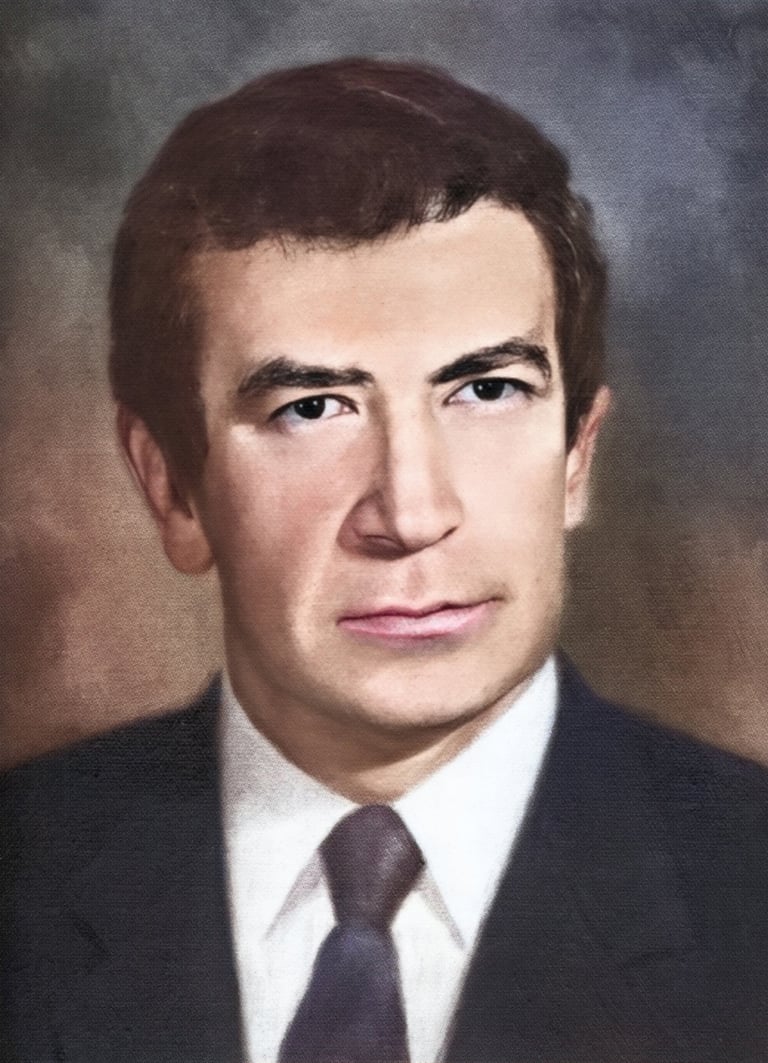

The Constitutionality of the Extradition Treaty between Colombia and the United States of America:
The constitutional doctrine that resulted from the rule of law articulated by the magistrate as rapporteur in his 1985 decision (CSJ, Reporting Magistrate Manuel Gaona Cruz, Judgment No. 39, File No. 1125, 1982) has been studied by various courts and generations of Colombian and Latin American jurists. The lessons that Professor Gaona Cruz imparted to thousands of law students on the constitutional limits of the State of siege in peacetime, as well as his doctrinal elaboration on comprehensive constitutional control—which Professor Gaona categorized as "the most complete in the West and, therefore, in the world" (Manuel Gaona Cruz, Control y Reforma de la Constitución en Colombia, MINISTRY OF JUSTICE 1988, Volume II, page 72)—are now referents in Comparative Constitutional Law (See Julio Cesar Ortiz, "El Control Constitucional en Colombia," BOLETÍN MEXICANO DE DERECHO COMPARADO, Universidad Autónoma de México UNAM, No. 71, 1991, pages 481-516; Allan R. Brewer-Carias, "El Sistema Mixto o Integral de Control de Constitucionalidad en Colombia y Venezuela," REVISTA TACHIRENSE DE DERECHO, Universidad Católica del Táchira, No. 5-6, 1994, pages 111-164; Jorge Alejandro Amaya, EL CONTROL DE CONSTITUCIONALIDAD, Astrea Argentina, 2015).
The Constitution and the Law Are Not Subject to the Mandates of Decree-Laws:
Human Rights and Liberties Are Not Subject to the Will of the Government:
In his jurisprudential elaboration, Manuel Gaona Cruz considered that the extraordinary powers granted by the Constitution and the law to the President of the Republic to confront internal turmoil, grave public order situations, or circumstances of economic or international calamity did not entail the unlimited attribution to eliminate the human rights or the most primary liberties that the Constitution itself grants to citizens. In two memorable rulings, the magistrate reminded the other branches of public power that police activity is subject to the power and function of the police, and thus—the magistrate noted—it is not regulatory of liberty (CSJ, Manuel Gaona Cruz, Judgment No. 9, File 893, 1982 {delivering the opinion of the Court}). In a similar vein, one of his famous opinions dictates: "military justice is for the military" (CSJ, Manuel Gaona Cruz, Judgment No. 59, 1984 {concurring}).
The Impartiality, Probity (or Integrity), and Suitability of Public Officials Is a Constitutional Duty:
According to the position defended by the magistrate before the full Supreme Court of Justice, the impartiality, decorum, dignity, probity (integrity), capacity, and suitability of public officials are not merely individual attributes that the government expects to observe in the officials it appoints and promotes, but a constitutional guarantee and duty that the State owes to its governed citizens (CSJ, Manuel Gaona Cruz, Judgment No. 61, File No. 42, 1982 {delivering the opinion of the Court). Such a legal elaboration implies that the disregard of any of these attributes is the disregard of a constitutional duty.
Todos los derechos reservados © J. Mauricio Gaona Fundación Manuel Gaona Cruz - 2025.





